
MAP OF EGYPT.
Title: A guide to the Egyptian collections in the British Museum
Creator: British Museum. Department of Egyptian and Assyrian Antiquities
Author of introduction, etc.: Sir E. A. Wallis Budge
Release date: May 2, 2025 [eBook #76000]
Language: English
Original publication: London: Harrison & Sons, 1909
Credits: Richard Hulse, Bryan Ness and the Online Distributed Proofreading Team at https://www.pgdp.net, with special thanks to Stephen Rowland for transcribing the hieroglyphics. (This file was produced from images generously made available by The Internet Archive/Canadian Libraries)
Transcriber’s Note: This book contains text in Greek (στήλη), Coptic (ⲛⲁⲛ) and Egyptian hieroglyphs (𓏟𓈖𓊹𓌃𓏪). You may need to install additional fonts to properly render those languages. Noto Sans Egyptian Hieroglyphs is recommended.
Egyptian names may be rendered into English in many different ways, and in this book frequently are (e.g. Teḥutimes, Teḥuti-mes, Thothmes). Some minor changes were made (especially in the Index) to achieve consistency of capitalization and accents, but otherwise these differences have been preserved as printed.
BRITISH MUSEUM.
A GUIDE
TO THE
EGYPTIAN COLLECTIONS
IN THE
BRITISH MUSEUM.
WITH 53 PLATES AND 180 ILLUSTRATIONS IN THE TEXT.
PRINTED BY ORDER OF THE TRUSTEES.
1909.
PRICE HALF-A-CROWN.
[All Rights Reserved.]
HARRISON AND SONS, LTD.,
PRINTERS IN ORDINARY TO HIS MAJESTY,
ST. MARTIN’S LANE, LONDON, W.C. 2.
PRINTED IN ENGLAND.
The Collection of Egyptian Antiquities in the British Museum comprises nearly fifty thousand objects, and many of its sections are unrivalled in completeness. It illustrates, in a more or less comprehensive manner, the history and civilization of the Egyptians from the time when their country was passing out of the Predynastic Period under a settled form of government, about B.C. 4500, to the time of the downfall of the power of the Queens Candace at Meroë, in the Egyptian Sûdân, in the second or third century after Christ. The monuments of Christian Egypt also form a very important series, and illustrate Coptic funerary sculpture and art between the sixth and eleventh centuries A.D.
The present Guide has been prepared with the view of providing the visitor to the British Museum with information of a more general character than can be conveniently given in the Guides to the several Galleries and Rooms of the Department. An attempt has here been made to present a sketch of the origin, the manners and customs, the language, the writing, the literature, the religion, and the burial rites of the peoples of Egypt, and of their history under the successive dynasties; embodying references to the several objects of the Collection which illustrate the different branches of the subject. The text is supplemented by an abundant selection of cuts and plates of the most important of the antiquities.
E. A. WALLIS BUDGE.
Department of Egyptian and Assyrian
Antiquities, British Museum,
September 29, 1908.
| PAGE | |||
| PREFACE | v | ||
| LIST OF PLATES | ix | ||
| LIST OF ILLUSTRATIONS IN THE TEXT | xi | ||
| CHAPTER | I.— | THE COUNTRY OF EGYPT | 1 |
| ” | II.— | ETHNOGRAPHY. LANGUAGE. FORMS OF WRITING. DECIPHERMENT OF EGYPTIAN HIEROGLYPHICS, ALPHABET, AND WRITING. NATIONAL CHARACTER | 20 |
| ” | III.— | EGYPTIAN LITERATURE, SACRED AND PROFANE | 58 |
| ” | IV.— | MANNERS AND CUSTOMS. MARRIAGE. EDUCATION. DRESS. FOOD. AMUSEMENTS. CATTLE BREEDING. TRADE. HANDICRAFTS | 76 |
| ” | V.— | ARCHITECTURE. PAINTING. SCULPTURE | 103 |
| ” | VI.— | THE KING AND HIS SUBJECTS. MILITARY SERVICE | 116 |
| ” | VII.— | EGYPTIAN RELIGION | 122 |
| ” | VIII.— | EMBALMING. THE EGYPTIAN TOMB | 158 |
| ” | IX.— | NUMBERS. DIVISIONS OF TIME. CHRONOLOGY | 180 |
| ” | X.— | HISTORY OF EGYPT. ANCIENT EMPIRE | 188 |
| ” | XI.— | HISTORY OF EGYPT. MIDDLE EMPIRE | 213 |
| ” | XII.— | HISTORY OF EGYPT. NEW EMPIRE | 228 |
| ” | XIII.— | HISTORY OF EGYPT. PTOLEMAÏC PERIOD | 268 |
| HISTORY OF EGYPT. ROMAN PERIOD | 275 | ||
| HISTORY OF EGYPT. ARAB PERIOD | 282 | ||
| A LIST OF THE PRINCIPAL KINGS OF EGYPT | 286 | ||
| CARTOUCHES OF THE PRINCIPAL KINGS OF EGYPT | 290 | ||
| INDEX | 303 | ||
| SEE PAGE | |||
| Plate | I. | Vignette from the papyrus of Queen Netchemet | 61 |
| ” | II. | Text and vignettes from the sarcophagus of King Nekht-Ḥeru-ḥebt | 66 |
| ” | III. | False door from the tomb of Sheshȧ | 68 |
| ” | IV. | Sepulchral tablet of Thethȧ | 68 |
| ” | V. | Sepulchral tablet of Sebek-ḥetep | 68 |
| ” | VI. | Sepulchral tablet of Pai-neḥsi | 68 |
| ” | VII. | Sepulchral tablet of Bak-en-Ȧmen | 68 |
| ” | VIII. | Sepulchral tablet of Nes-Ḥeru | 68 |
| ” | IX. | Painted relief from the tomb of Ur-ȧri-en-Ptaḥ | 81 |
| ” | X. | Painted sepulchral tablet of Kaḥu | 81 |
| ” | XI. | Columns in the temple of Seti I | 107 |
| ” | XII. | Head of a priestess | 115 |
| ” | XIII. | Seated figures of Khā-em-Uast and his wife | 115 |
| ” | XIV. | False door from the tomb of Ȧsȧ-ānkh | 167 |
| ” | XV. | View of a painted chamber in the tomb of Nekht | 175 |
| ” | XVI. | Wall painting from a tomb | 175 |
| ” | XVII. | General view of the sarcophagus of Nekht-Ḥeru-ḥebt | 177 |
| ” | XVIII. | General view of the sarcophagus of Nes-Qeṭiu | 177 |
| ” | XIX. | Sepulchral tablet of Ban-āa | 177 |
| ” | XX. | The Great Pyramid and Sphinx | 196 |
| ” | XXI. | The “Shêkh al-Balad” | 203 |
| ” | XXII. | Tablet of Ȧntef | 210 |
| ” | XXIII. | Tablet of Sebek-āa | 211 |
| ” | XXIV. | Tablet and figure of Sa-Hathor | 215[x] |
| ” | XXV. | Statue of Usertsen III | 217 |
| ” | XXVI. | Head of Ȧmen-em-ḥāt III | 218 |
| ” | XXVII. | Statue of Sekhem-uatch-taui-Rā | 223 |
| ” | XXVIII. | Stele of the reign of Sekhem-ka-Rā | 223 |
| ” | XXIX. | Memorial cone of Sebek-ḥetep | 223 |
| ” | XXX. | The Hall of Columns at Karnak | 231 |
| ” | XXXI. | Head of a colossal statue of Thothmes III | 231 |
| ” | XXXII. | Statue of Ȧmen-ḥetep III | 234 |
| ” | XXXIII. | The Colossi of Ȧmen-ḥetep III | 234 |
| ” | XXXIV. | Letter of Ȧmen-ḥetep III | 236 |
| ” | XXXV. | Letter of Tushratta, king of Mitani, to Ȧmen-ḥetep III | 236 |
| ” | XXXVI. | Lion of Tut-ānkh-Ȧmen | 238 |
| ” | XXXVII. | Statues of a priest and his wife | 239 |
| ” | XXXVIII. | The temple of Abû Simbel | 242 |
| ” | XXXIX. | Head of a colossal statue of Rameses II | 245 |
| ” | XL. | Sepulchral stele of Qaḥa | 248 |
| ” | XLI. | Vignettes from the papyrus of Queen Netchemet | 252 |
| ” | XLII. | Hathor-headed capital | 254 |
| ” | XLIII. | Relief of Queen Ānkhnes-neferȧb-Rā | 261 |
| ” | XLIV. | The goddess Nut | 261 |
| ” | XLV. | Statue of Uaḥ-ȧb-Rā | 261 |
| ” | XLVI. | Obelisk dedicated to Thoth, Twice-great | 265 |
| ” | XLVII. | Vignettes and text from the sarcophagus of Nekht-Ḥeru-ḥebt | 265 |
| ” | XLVIII. | Relief of Ptolemy II | 269 |
| ” | XLIX. | The temple of Edfû | 270 |
| ” | L. | Granite shrine from Philae | 271 |
| ” | LI. | Tablet of Tiberius | 277 |
| ” | LII. | Tablet of Tiberius | 277 |
| ” | LIII. | Tablet of Apa Paḥomo | 283 |
| PAGE | |
| Map of Egypt | 2, 3 |
| The Delta of Egypt | 5 |
| The Entrance to the Valley of the Tombs of the Kings at Thebes | 6 |
| The Nile-gods and their cavern | 8 |
| The Nile-god in his cavern | 8 |
| The Nile-god bearing offerings | 9 |
| The Nile-gods of the South and North | 9 |
| The Nile from sea to source | 11 |
| Statue of Ḥāpi the Nile-god | 12 |
| Egyptian hunters of the Archaïc Period, Nos. 1-6 | 23 |
| Ivory figure of a king | 24 |
| Bone figure of a dwarf | 24 |
| Bone figure of a woman carrying a child | 25 |
| Bone figure of a woman with inlaid eyes | 25 |
| Figure of Betchmes | 26 |
| Figure of Nefer-hi | 26 |
| Fox playing the double pipes | 27 |
| Mouse seated on a chair | 28 |
| Cat herding geese | 29 |
| Lion and unicorn playing draughts | 30 |
| The spearing of Āpep | 31 |
| A page of writing from the Great Harris Papyrus | 36 |
| Demotic writing | 38 |
| Coptic inscription | 41 |
| The Rosetta Stone | 42, 43 |
| Two wooden writing palettes | 54 |
| Slab of limestone inscribed in hieratic | 56[xii] |
| Vignette and text from the papyrus of Ani | 60 |
| Vignette and text from the papyrus of Nu | 60 |
| Vignette and text from the papyrus of Ḥeru-em-ḥeb | 61 |
| Text from the Book “May my name flourish” | 63 |
| The ceremony of “Opening the mouth” | 64 |
| Marble sun-dial | 72 |
| Head of a priestess | 80 |
| Relief, with a hippopotamus | 84 |
| Green schist bear | 86 |
| Egyptian house | 88 |
| Egyptian hut | 90 |
| Ivory head-rest | 91 |
| The Bull Apis | 93 |
| The Bull Mnevis | 94 |
| Flint cow’s head | 95 |
| Jewellers drilling and polishing beads | 99 |
| Pylon and court of the temple of Edfû | 104 |
| Gateway to the temple of Rameses III | 105 |
| Gateway of Ptolemy IX at Karnak | 106 |
| Granite obelisks at Karnak | 107 |
| Pillars at Philae | 108 |
| Statue of Ȧn-kheft-ka | 109 |
| Figure of a priest | 110 |
| Head of a statue of Neb-ḥap-Rā | 110 |
| Statue of Sebek-nekht | 111 |
| Figure of a king | 112 |
| Queen Tetȧ-Kharṭ | 113 |
| Head of Ȧmen-ḥetep III | 114 |
| Statue of Isis | 115 |
| Figure of Qen-nefer | 118 |
| Statues of Māḥu and Sebta | 119 |
| The principal gods and goddesses of Egypt (57 figures) | 123-126 |
| Khnemu fashioning a man on a potter’s wheel | 135 |
| Osiris rising from the sarcophagus | 138 |
| Osiris in his shrine | 140 |
| Thoth weighing the heart | 140[xiii] |
| Maāt weighing the heart | 140 |
| Osiris on his Judgment Throne | 141 |
| Rā at sunrise | 143 |
| Rā at sunset | 143 |
| Flint amulets (4 figures) | 148 |
| The step pyramid at Ṣaḳḳârah | 166 |
| A group of maṣṭaba tombs | 167 |
| Tablet for offerings | 168 |
| An Egyptian tomb | 168 |
| The soul visiting the body | 168 |
| Section of the Second Pyramid | 171 |
| Entrance to the tomb of Khnemu-ḥetep | 172 |
| Entrance to a royal tomb | 173 |
| Plan and section of the tomb of Seti I (2 cuts) | 174 |
| Wall painting from a tomb | 175 |
| Coffin of Ḥes-Peṭān-Ȧst | 176 |
| Figures of Ka-ṭep and Ḥetep-ḥeres | 177 |
| King Semti dancing before a god | 190 |
| Relief from the tomb of Sherȧ | 192 |
| Relief from the tomb of Suten-ȧbu | 194 |
| King Khufu | 196 |
| Section of the Great Pyramid | 197 |
| King Khāf-Rā | 199 |
| King Menkau-Rā | 200 |
| Section of the Third Pyramid | 202 |
| King Usr-en-Rā Ȧn | 204 |
| Shrine of Pa-suten-sa | 219 |
| Stele of Tatiankef | 220 |
| Lion of Khian | 225 |
| Statue of Ȧmen-ḥetep I | 229 |
| The Temple of Luxor | 233 |
| Scarabs of Ȧmen-ḥetep III (2 cuts) | 235 |
| Kneeling statue of Rameses II | 241 |
| Façade of the Ramesseum | 243 |
| Statues of Rameses II (2 cuts) | 244 |
| Statue of Khā-em-Uast | 246[xiv] |
| Statue of Seti II | 247 |
| Statue of Ānkh-renp-nefer | 254 |
| Head of Psammetichus II | 259 |
| Stele of Ptolemy II | 269 |
| Head of a statue of a Ptolemy | 271 |
| Limestone window | 273 |
| “Pharaoh’s Bed” | 276 |
| Coptic sepulchral tablet | 279 |
| Tablet of Plêïnôs | 281 |
| Tablet of David | 281 |
| Tablet of Abraam | 284 |
| Tablet of Rachel | 284 |
The Country of Egypt and its Limits. The Delta. Oases. Lakes. The Nile. Inundation. Nile Festivals. Famines. Ancient and Modern Divisions of Egypt and the Sûdân.
The Land of Egypt is situated in the north-east shoulder of the continent of Africa, and in the earliest times it consisted of that portion of the Nile Valley which lay between the Mediterranean Sea and the northern end of the First Cataract; the Island of Ābu, or Elephantine, and the town of Sunnu, or Sunt, the Syene of classical writers and the Sewênêh of the Bible (Ezekiel xxix, 10), forming the southern boundary of the country. The northern limit of Egypt has, in historic times, always been the Mediterranean Sea, but its southern limit varied considerably at different periods. Under the Vth dynasty, about B.C. 3600, it was marked by Elephantine and Syene. Under the XIIth dynasty, about B.C. 2500, it was extended to Semnah and Kummah, about 250 miles to the south of Syene. Under the XVIIIth dynasty, about B.C. 1600, the southern frontier town was probably Napata, the modern Merawi, about 600 miles, by river, from Syene. A century later the Egyptians took possession of the Island of Meroë, and they appear to have built a town at a place about 930 miles from Syene, by river, to mark their southern frontier. Between B.C. 1200 and 600 the frontier was withdrawn to Syene, where it remained practically for several centuries. Under the Arabs, the southern frontier was fixed at Dongola (A.D. 1275), the old Nubian capital, which lay about 570 miles from Syene. In 1873, Sir Samuel Baker extended it to Gondókoro, about 2,823 miles, by river, from Cairo. In 1895, the frontier town of Egypt in the south was Wâdî Ḥalfah, and it continued to be so until the capture of Umm Darmân (Omdurmân) in 1898. At the present time, the southern limit of Egypt is marked by the 22nd parallel of N. latitude, which crosses the Nile at Gebel Sahaba, about eight miles north of the Camp at Wâdî Ḥalfah, and its northern limit is the northernmost point of the Delta. The distance, by river, from the Camp to the Mediterranean Sea, is about 960 miles. The boundary of Egypt on the east is marked by a line drawn from Ar-Rafah, which lies a little to the east of Al-Arîsh, the Rhinocolura of classical writers, to Tabah, at the head of the Gulf of Akabah, by the eastern coast of the Peninsula of Sinai,[1] and by the Red Sea. On the west, the boundary is marked by a line drawn from the Gulf of Solum due south to a point a little to the south-west of the Oasis of Sîwah, and then proceeding in a south-easterly direction to the 22nd parallel of N. latitude, near Wâdî Ḥalfah.

MAP OF EGYPT.
The name “Egypt,” which has come to us through the Latin “Aegyptus” and the Greek “Aiguptos,” is derived from one of the ancient Egyptian names of Memphis, viz., “Ḥet-ka-Ptaḥ,” meaning “Temple of the Ka, or Double, of Ptaḥ” 𓉗𓏏𓉐𓂓𓏤𓊪𓏏𓎛𓀭 or 𓉘𓂓𓏤𓊪𓏏𓎛𓀭𓉜. The common name for Egypt among the Egyptians was “Qem,” or “Qemt,” i.e., the “Black Land,” 𓆎𓏏𓊖, in allusion to the brownish-black mud of which the soil chiefly consists. Another name of frequent occurrence in the literature is “Ta-Merȧ,” the “Land of the Inundation,” 𓇾𓏤𓈇𓌻𓇋𓆳𓊖.
The soil of Egypt is formed of a layer of sedimentary deposits, which has been laid down by the Nile, and varies in depth from about 40 to 110 feet; the rate at which this layer is being added to at the present time in the bed of the river is said to be about four inches in a century. In prehistoric times the sea ran up as far as Esna, and deposited thick layers of sand and gravel; upon these the rivers and streams flowing from the south spread the mud and stony matter[5] which they brought down with them, and thus the soil of Egypt was gradually built up. Near Esna begins the layer of sandstone, which extends southward, and covers nearly the whole of Nubia, and rests ultimately on crystalline rock.

The Delta of Egypt.
The part of Egypt which lies to the north of the point where the Nile divides itself into two branches resembles in shape a lotus flower, or a triangle standing on its apex, and because of its similarity to the fourth letter of their alphabet, the Greeks called it Delta, Δ.
The Delta is formed of a deep layer of mud and sand, which rests upon the yellow quartz sands, and gravels and stiff clay, which were laid down by the sea in prehistoric times. The area of the Delta is about 14,500 square miles.
The Oases of Egypt are seven in number, and all are situated in the Western Desert. Their names are: 1. Oasis of Sîwah or Jupiter Ammon; 2. Oasis of Baḥarîyah, i.e., the Northern Oasis; 3. The Oasis of Farâfrah, the Ta-ȧḥet of the Egyptians; 4. The Oasis of Dâkhlah, i.e., the “Inner” Oasis, the Tchesti of the Egyptians; 5. The Oasis of Khârgah, i.e., the “Outer Oasis,” the Uaḥt-rest or “Southern Oasis” of the Egyptians; 6. The Oasis of Dailah, to the west of Farâfrah; 7. The Oasis of Kûrkûr, to the west of Aswân.
The principal Lakes of Egypt are: 1. Birkat al-Ḳurûn, a long, narrow lake lying to the north-west of the Province of the Fayyûm, and formerly believed to be a part of the Lake Moeris described by Herodotus; 2. The Natron Lakes, which lie in the Natron Valley, to the north-west of Cairo; from these the Egyptians obtained salt and various forms of soda, which were used for making incense, and in embalming the dead; 3. Lake Menzâlah, Lake Bûrlûs, Lake Edkû, Lake Abukîr, now almost reclaimed, and Lake Mareotis; all these are in the Delta. Lake Timsaḥ (i.e., Crocodile Lake) and the Bitter Lakes, which were originally mere swamps, came into existence with the making of the Suez Canal.
The Fayyûm which was in ancient times regarded as one of the Oases, is nothing more than a deep depression scooped out of the limestone, on which are layers of loams and marls covered over by Nile mud. The district was called by the Egyptians “Ta-she,” or “Land of the Lake”; at the present time it has an area of about 850 square miles, and is watered by a branch of the Nile called the “Baḥr Yûsuf,” which flows into it through an opening in the mountains on the west bank of the Nile. The Baḥr Yûsuf, or “River of Joseph,” is not called after the name of the patriarch Joseph, but that of some Muḥammadan ruler. It is not a canal as was once supposed, but an arm of the Nile, which, however, needs clearing out periodically. In the Fayyûm lay the large body of water to which Herodotus gave the name of Lake Moeris. He believed that this Lake had been constructed artificially, but modern irrigation authorities in Egypt have come to the conclusion that the mass of water which he saw and thought was a lake was merely the result of the Nile flood, or inundation, and that there never was a Lake Moeris.
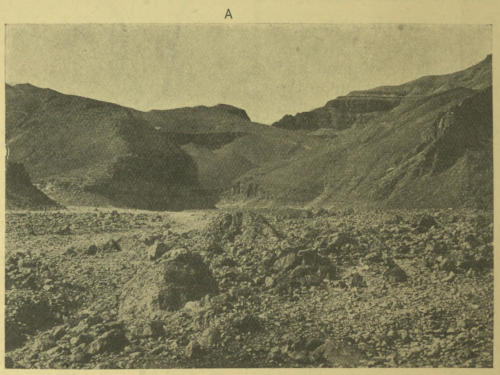
The Entrance to the Valley of the Tombs of the Kings at Thebes.
Deserts. On each side of the Valley of the Nile lies a vast desert. That on the east is called the Arabian Desert,[7] or Red Sea Desert, and that on the west the Libyan Desert. The influence of the latter on the climate of Egypt is very great, as for six months of the year the prevailing wind blows from the west. At many places in the Eastern and Western Deserts there are long stretches of sand scores of miles in length, and immense tracts covered with layers of loose pebbles and stone, and the general effect is desolate in the extreme. The hills which skirt the deserts along the Valley of the Nile are usually quite low, but at certain points they rise to the height of a few hundred feet. Nothing grows on them, and more bare and inhospitable places cannot be imagined. The accompanying illustration gives a good idea of the general appearance of the stone hills on the Nile. In the fore-ground are masses of broken stone, sand, rocks, etc., and these stretch back to a gap in the range of hills just below the letter A, whence, between steep rocks, a rough road winds in and out along the dreary valley which contains the sepulchres of the great kings of the XVIIIth, XIXth and later dynasties. Under the light of a full moon the Valley is full of weird beauty, but in the day-time the heat in it resembles that of a furnace.
The chief characteristic of Egypt is the great river Nile, which has in all ages been the source of the life and prosperity of its inhabitants, and the principal highway of the country. The Egyptians of the early Dynastic Period had no exact knowledge about the true source of the river. In their hymns to the Nile-god they described him as the “hidden one,” and “unseen,” and his “secret places” are said to be “unknown.” The river over which he presided formed a part of the great celestial river, or ocean, upon which sailed the boats of the Sun-god daily. This river surrounded the whole earth, from which, however, it was separated by a range of mountains. On one portion of this river was placed the throne of Osiris, according to a legend, and close by was the opening in the range of mountains through which an arm of the celestial river flowed into the earth. The place where the Nile appeared on earth was believed to be situated in the First Cataract, and in late times the Nile was said to rise there, between two mountains which were near the Island of Elephantine and the Island of Philae. Herodotus gives the names of these mountains as “Krôphi” and “Môphi,” and their originals have probably been found in the old Egyptian “Qer-Ḥāpi” and “Mu-Ḥāpi”; these names mean “Cavern of Ḥāpi” and “Water of Ḥāpi” respectively.
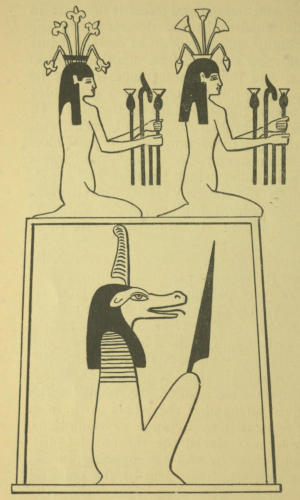
The two Nile-gods and their Cavern, and the hippopotamus goddess, who is armed with a huge knife, their protectress.
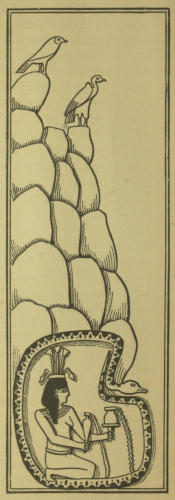
The Nile-god in his cavern, under the rocks at Philae, pouring out the waters which formed the two Niles.
The underground caverns, or “storehouses of the Nile,”[8] from which the river welled up, are depicted in the illustrations here given. In the first the cavern is guarded by a hippopotamus-headed goddess, who is armed with a large knife and wears a feather on her head. Above are seated two gods, one wearing a cluster of papyrus plants on his head, and the other a cluster of lotus flowers; the former represents the Nile of the South, and the other the Nile of the North. Each god holds water-plants in one hand. In the second illustration the god is depicted kneeling in his cavern, which[9] is enclosed by the body of a serpent; he wears a cluster of water-plants on his head, and is pouring out from two vases the streams of water which became the South and North Niles.
The Egyptians called both their river and the river-god “Ḥāp” or “Ḥāpi” 𓎛𓂝𓊪, 𓎛𓂝𓊪𓏭𓈘𓈗𓀭, a name of which the meaning is unknown; in very early dynastic times the god was called “Ḥep-ur” 𓎛𓊪𓈘𓅨, i.e., the “great Ḥep.” The name “Nile,” by which the “River of Egypt” is generally known, is not of Egyptian origin, but is probably derived from the Semitic word nakhal “river”; this the Greeks turned into “Neilos,” and the Latins into “Nilus,” whence comes the common form “Nile.” The river appears in the form of a man wearing a cluster of water-plants on his head, and his fertility is indicated by a large pendent breast. In the accompanying illustration the gods of the South and North Niles are seen tying stems of the lotus and papyrus plants round the symbol of “union”; the scene represents the union of Upper and Lower Egypt.

The Nile-god bearing offerings of bread, wine, fruit, flowers, etc.
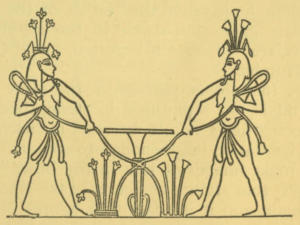
The Nile-gods of the South and North tying the stems of a lily and a papyrus plant round the symbol of “union,” symbolizing the union of Upper and Lower Egypt.
The ideas held by the Egyptians concerning the power of the Nile-god are well illustrated by a lengthy Hymn to the Nile preserved on papyrus in the British Museum (Sallier II, No. 10,182). “Homage to thee, O Ḥāpi, thou appearest in this land, and thou comest in peace to make Egypt to live. Thou waterest the fields which Rā hath created, thou givest life[10] unto all animals, and as thou descendest on thy way from heaven thou makest the land to drink without ceasing. Thou art the friend of bread and drink, thou givest strength to the grain and makest it to increase, and thou fillest every place of work with work.... Thou art the lord of fish ... thou art the creator of barley, and thou makest the temples to endure for millions of years.... Thou art the lord of the poor and needy. If thou wert overthrown in the heavens, the gods would fall upon their faces, and men would perish. When thou appearest upon the earth, shouts of joy rise up and all people are glad; every man of might receiveth food, and every tooth is provided with meat.... Thou fillest the storehouses, thou makest the granaries to overflow and thou hast regard to the condition of the poor and needy. Thou makest herbs and grain to grow that the desires of all may be satisfied, and thou art not impoverished thereby. Thou makest thy strength to be a shield for man.” Elsewhere he is called the “father of the gods of the company of the gods who dwell in the celestial ocean,” and he was declared to be self-begotten, and “One,” and in nature inscrutable.
In another passage of the same hymn it is said that the god is not sculptured in stone, that images of him are not seen, “he is not to be seen in inscribed shrines, there is no habitation large enough to contain him, and thou canst not make images of him in thy heart.” These statements suggest that statues or figures of the Nile-god were not commonly made, and it is a fact that figures of the god, large or small, are rare. In the fine collection of figures of Egyptian gods exhibited in the Third Egyptian Room, which is certainly one of the largest in the world, there is only one figure of Ḥāpi (No. 108, Wall-case 125). In this the god wears on his head a cluster of papyrus plants 𓇇, before which is the Utchat, or Eye of Horus, 𓂀, and he holds an altar from which he pours out water. The only other figure of the god in the British Museum collection is the fine quartzite sandstone statue (Southern Egyptian Gallery, No. 766) which was dedicated to Ȧmen-Rā by Shashanq, the son of Uasarken and his queen Maāt-ka-Rā. Here the god bears on his out-stretched hands an altar, from which hang down bunches of grain, green herbs, flowers, waterfowl, etc. The statue was dedicated to Ȧmen-Rā, who included the attributes of Ḥāp among his own.

The NILE from SEA to SOURCE
The true source of the Nile is Victoria Nyanza, or Lake Victoria, which lies between the parallels of latitude 0° 20′ N. and 3° S., and the meridians of 31° 40′ and 35° E. of Greenwich; the lake is 250 miles in length and 200 in breadth, and was discovered in modern times by Speke, on August 3rd, 1858. Other contributory sources are Albert Nyanza, or Lake Albert, discovered by Sir Samuel Baker on March 16th, 1864, and Lake Albert Edward, discovered by Sir H. M. Stanley in 1875; the connecting channel between these lakes is the Semliki River. The portion of the Nile between Lake Victoria and Lake Albert is called the “Victoria Nile” (or the “Somerset River”); that between Lake Albert and Lake Nô is called the “Baḥr al-Gebel” or “Upper Nile”; and that between Lake Nô and Kharṭûm is called “Baḥr al-Abyaḍ,” or “White Nile.” The total length of these three portions of the Nile is about 1,560 miles. At Kharṭûm the White Nile is joined by the “Blue Nile” (or Abâî, the Astapos of Strabo, which rises in Lake Ṣânâ and is about 1,000 miles long), and their united streams form that portion of the river which is commonly known as the “Nile.” The distance from Kharṭûm to the Mediterranean Sea is about 1,913 miles, and thus the total length of the Niles is about 3,473 miles. Between Kharṭûm and the sea the Nile receives but one tributary, viz., the[12] Atbara, the Astaboras of Strabo, a torrential stream which brings into the Nile an immense quantity of dirty red water containing valuable deposits of mud. The Cataracts, or series of rapids, on the Nile are six in number: the first is between Aswân and Philae, the second is a little to the south of Wâdî Ḥalfah, the third is at Ḥannek, the fourth is at Adramîya, the fifth is at Wâdî al-Ḥamâr, and the sixth is at Shablûkah. On the White Nile is a series of cataracts known as the “Fôla Falls,” and on the Blue Nile there are cataracts from Rusêres southwards for a distance of 40 miles.
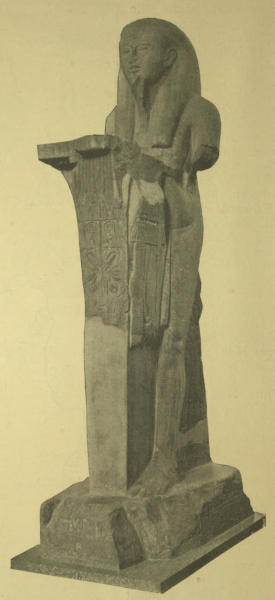
Statue of Ḥāpi the Nile-god.
[No. 766.]
The most important characteristic of the Nile is its annual flooding or Inundation. By the end of May, in Egypt, the river is at its lowest level. During the month of June the Nile, between Cairo and Aswân, begins to rise, and a quantity of “green water” appears at this time. The cause of the colour is said to be myriads of minute algae, which subsequently putrefy and disappear. During August the river rises rapidly, and its waters assume a red, muddy colour, which is due to the presence of the rich red earth which is brought into the Nile by the Blue Nile and the Atbara. The rising of the waters continues until the middle of September, when they remain stationary for about a fortnight or three weeks. In October a further slight rise occurs, and then they begin to fall; the fall continues gradually until, in the May following, they are at their lowest level once more. The cause of the Inundation is, as Aristotle (who lived in the fourth century B.C.) first showed, the spring and early summer rains in the mountains of Ethiopia and the Southern Sûdân; these are brought down in torrents by the great tributaries of the Nile, viz., the Gazelle River, the Sobat (the Astasobas of Strabo), the Giraffe River, the Blue Nile, and the Atbara. The Sobat rises about April 15, the Gazelle River and the Giraffe River about the 15th of May, the Blue Nile at the end of May, and the Atbara a little later. The united waters of these tributaries, with the water of the Upper Nile, reach Egypt about the end of August, and cause the Inundation to reach its highest level. The Nile rises from 21 feet to 28 feet, and deposits a thin layer of fertilizing mud over every part of the country reached by its waters. Formerly, when the rise was about 26 feet, there was sufficient water to cover the whole country; when it was less, scarcity prevailed; and when it was more, ruin and misery appeared through over-flooding. In recent years, the British irrigation engineers in Egypt have regulated, by means of the Aswân Dam, the Barrage at Asyûṭ, and the Barrage near Al-Manâshî,[14] a little to the north of Cairo,[2] the supply of water during the winter, or dry season, with such success, that, in spite of “low” Niles, the principal crops have been saved, and the people protected from want.
In connection with the adoration of the Nile, two important festivals were observed. The first of these took place in June and was called the “Night of the Tear,” 𓈖𓇉𓄿𓏏𓏲𓏭𓇌𓁻, Qerḥ en Ḥatui, because it was believed that at this time of the year the goddess Isis shed tears in commemoration of her first great lamentation over the dead body of her husband Osiris. Her tears fell into the river, and as they fell they multiplied and filled the river, and in this way caused the Inundation. This belief exists in Egypt, in a modified form, at the present time, and, up to the middle of last century the Muḥammadans celebrated, with great solemnity, a festival on the 11th day of Paoni (June 17th), which was called the “Night of the Drop,” Lêlat al-Nuḳtah. On the night of this day a miraculous drop of water was supposed to fall into the Nile and cause it to rise. The second ancient Nile-festival was observed about the middle of August, and has its equivalent in the modern Muḥammadan festival of the “Cutting of the Dam.” A dam of earth about 23 feet high was built in the Khalîg Canal, and when the level of the Nile nearly reached this height, a party of workmen thinned the upper portion of the dam at sunrise on the day following the “completion of the Nile,” and immediately afterwards a boat was rowed against it, and, breaking the dam, passed through it with the current.
The history of Egypt shows that in all periods the country has suffered from severe famines, which have been caused by successions of “low” Niles. Thus a terrible seven years’ famine began in A.D. 1066, and lasted till 1072. Dogs, cats, horses, mules, vermin fetched extravagant prices, and the people of Cairo killed and ate each other, and human flesh was sold in the public markets. In Genesis xli, we have another example of a seven years’ famine, and still an older one is mentioned in an inscription cut upon a rock on the Island of Sâḥal in the First Cataract. According to the text, this famine took place in the reign of Tcheser, a king of the IIIrd dynasty, about B.C. 4000, because there had been no satisfactory inundation of the Nile for seven years. The king says that by reason of this, grain was very scarce, vegetables[15] and garden produce of every description could not be obtained, the people had nothing to eat, and men were everywhere robbing their neighbours. Children wailed for food, young men had no strength to move, strong men collapsed for want of sustenance, and the aged lay in despair on the ground waiting for death. The king wrote to Matar, the Governor of the First Cataract, where the Nile was believed to rise, and asked him to enquire of Khnemu, the god of the Cataract, why such calamities were allowed to fall on the country. Subsequently the king visited Elephantine, and was received by Khnemu, the god of the Cataract, who told him that the Nile had failed to rise because the worship of the gods of the Cataract had been neglected. The king promised to dedicate offerings regularly to their temples in future, and, having kept his promise, the Nile rose and covered the land, and filled the country with prosperity.
Egyptian Geography.—From time immemorial Egypt has been divided into two parts, viz., the Land of the South, Ta-Resu, 𓇾𓏤𓈇𓇖𓊖, and the Land of the North, Ta-Meḥt, 𓇾𓏤𓈇𓇉𓏏𓊖. The Land of the South is Upper Egypt, and its northern limit in modern times is Cairo; the Land of the North is Lower Egypt, i.e., the Delta, and its southern limit is Cairo. The ancient Egyptians divided the Land of the South into twenty-two parts, and the Land of the North into twenty parts; each such part was called Ḥesp 𓎛𓊃𓊪𓈈, a word which the Greeks rendered by nome. Each nome was to all intents and purposes a little complete kingdom. It was governed by a ḥeq, 𓋾𓈎, or chief man, and it contained a capital town in which was the seat of the god of the nome and the priesthood, and every ḥeq administered his ḥesp as he pleased. The number of the nomes given by Greek and Roman writers varies between thirty-six and forty-four. In late times Egypt was divided into three parts, Upper, Central, and Lower Egypt; Central Egypt consisted of seven nomes, and was therefore called Heptanomis. The nomes were:
| UPPER EGYPT. | |||
|---|---|---|---|
| Nome. | Capital. | God or Goddess. | |
| 1. | Ta-Kens. | Ābu.[3] Elephantine. Aswân. | Khnemu. |
| 2. | Tes-Ḥeru. | Ṭeb. Apollinopolis Magna. Edfû. | Ḥeru-Beḥuṭet. |
| 3. | Ten. | Nekheb. Eileithyiaspolis. Al-Kâb. | Nekhebit. |
| 4. | Uast. | Uast. Thebes (or Hermonthis). Luxor, Karnak | Ȧmen-Rā. |
| 5. | Ḥerui. | Ḳebti. Coptos. Ḳuft. | Ȧmsu, or Menu. |
| 6. | Ȧati. | Taenterert. Tentyris. Denderah. | Hathor. |
| 7. | Seshesh. | Ḥa. Diospolis Parva. Ḥau. | Hathor. |
| 8. | Ȧbt. | Teni. This. | Ȧn-Ḥer. |
| 9. | ... | Ȧpu. Panopolis. Ahkmîm. | Ȧmsu or Menu. |
| 10. | Uatchet. | Ṭebu. Aphroditopolis. | Hathor. |
| 11. | Set. | Shas-ḥetep. Hypselis. Shutb. | Khnemu. |
| 12. | Ṭu-... | Nut-ent-bȧk. Hierakonpolis. | Horus. |
| 13. | Ȧm-f-khent. | Saut. Lykopolis. Asyûṭ. | Ȧp-uat. |
| 14. | Ȧm-f-peḥ. | Kesi. Kusae. Al-Kusîyah. | Hathor. |
| 15. | Unt. | Khemennu. Hermopolis. Ashmnûnên. | Thoth. |
| 16. | Maḥetch. | Ḥebennu. | Horus. |
| 17. | Ȧnpu(?). | Kasa. Kynonpolis. Al-Kês. | Anubis. |
| 18. | Sepṭ. | Ḥet-suten. Al-Hîbah. | Anubis. |
| 19. | Bu-tchamui. | Pa-Mātchet. Oxyrrhynchus. Bahnassâ. | Set. |
| 20. | Ȧm-Khent. | Suten-ḥenen. Herakleopolis Magna. Ahnâs. (The Hânês of the Bible.) | Ḥeru-shefit. |
| 21. | Ȧm-peḥ. | Smen-Ḥeru. | Khnemu. |
| 22. | Maten. | Ṭep-Ȧḥet. Aphroditopolis. Atfîḥ. | Hathor.[17] |
| LOWER EGYPT. | |||
| Nome. | Capital. | God or Goddess. | |
| 1. | Ȧneb-ḥetch. | Men-nefert. Memphis. Mît-Rahînah. | Ptaḥ. |
| 2. | Ȧa. | Sekhem. Letopolis. | Ḥeru-ur. |
| 3. | Ȧment. | Pa-neb-Ȧmt. Apis. | Hathor. |
| 4. | Sȧpi-Rest. | Tchekā. | Ȧmen-Rā. |
| 5. | Sȧpi-Meḥt. | Saut. Saïs. Ṣâ. | Neith. |
| 6. | Ka-semt. | Khasut. Xoïs. | Ȧmen-Rā. |
| 7. | Nefer-Ȧment. | Pa-Aḥu-neb-Ȧment. Metelis (?). | Ḥu. |
| 8. | Nefer-Ȧbt. | Thekaut (Succoth), Pa-Tem (Pithom). Patumos. Tall al-Maskhûṭah. | Atem, or Temu. |
| 9. | Ȧthi(?). | Pa-Ȧsȧr. Busiris. Abû-Ṣîr. | Osiris. |
| 10. | Ka-Qam. | Ḥet-ta-ḥer-ȧbt. Athribis. | Ḥeru-Khenti-Khati. |
| 11. | Ka-ḥeseb. | Ḥesbet(?), Ka-Ḥebset(?). Kabasos. | Isis, or Sebek. |
| 12. | Theb-... | Theb-neter(?). Sebennytos. Sammanûd. | Ȧn-Ḥer. |
| 13. | Ḥeq-āṭ. | Ȧnnu (The On of the Bible). Heliopolis. Maṭarîyah. | Temu. |
| 14. | Khent-ȧbt. | Tchal. Tanis. Ṣân. | Horus. |
| 15. | Teḥuti. | Pa-Teḥuti. Hermopolis Minor. | Thoth. |
| 16. | Ḥātmeḥit. | Pa-Ba-neb Ṭeṭ. Mendes. Tmai al-Amdîd. | Osiris. |
| 17. | Sam-Beḥuṭet. | Pa-Khen-en-Ȧmen. Diospolis. | Ȧmen-Rā. |
| 18. | Ȧm-Khent. | Pa-Bast. Pibeseth Bubastis. Tall Basṭah. | Bast. |
| 19. | Ȧm-peḥ. | Pa-Uatchet. Buto. | Uatchet. |
| 20. | Sepṭ. | Kesem. Phakussa. Fakûs. | Sepṭ. |
The Sûdân was divided into 13 nomes:
Under the Ptolemies, the district between Elephantine and Philae was called Dodekaschoinos, because it contained twelve schoinoi, or measures of land, but later this term was applied to the whole region between Elephantine and Hiera Sykaminos.
Under the late Roman emperors many of the nomes were subdivided, probably for convenience in levying taxes, and in still later times the governor of a nome, or province, bore the title of Duke (Δουξ).
Modern Egypt is divided into 14 provinces:
| LOWER EGYPT. | ||
|---|---|---|
| Province. | Capital. | |
| 1. | Baḥêrah. | Damanhûr. |
| 2. | Ḳalyûbîyah. | Benha. |
| 3. | Sharkîyah. | Zaḳâzîḳ. |
| 4. | Dakhâlîyah. | Manṣûrah. |
| 5. | Manûfîyah. | Menûf. |
| 6. | Gharbîyah. | Ṭanṭa. |
| UPPER EGYPT. | ||
| Province. | Capital. | |
| 1. | Gîzah. | Gîzah. |
| 2. | Beni-Suwêf. | Beni-Suwêf. |
| 3. | Minyah. | Minyah. |
| 4. | Asyûṭ. | Asyûṭ. |
| 5. | Girgah. | Ṣûhâḳ. |
| 6. | Ḳena. | Ḳena. |
| 7. | Nûba. | Aswân. |
| 8. | Fayyûm. | Madînat al-Fayyûm. |
The towns of Cairo, Alexandria, Port Sa’îd, Suez, Damietta, etc., are generally governed each by a native ruler.
The provinces of the Sûdân are as follows:
1. Baḥr al-Ghazâl. 2. Berber. 3. Blue Nile Province. 4. Dongola. 5. Ḥalfah. 6. Kassala. 7. Kharṭûm Province. 8. Kordofân. 9. Mongalla. 10. Red Sea Province. 11. Sennaar. 12. Upper Nile Province. 13. White Nile Province.
Ethnography. The Land of Punt. National Character. Population. Language. Forms Of Writing. Decipherment of Egyptian Hieroglyphics. Young and Champollion. Hieroglyphic Alphabet and Writing. Writing Materials.
The Egyptians.—The evidence of the monuments and the literature of Egypt proves that the Egyptians were of African origin, and that they were akin to the light-skinned peoples who inhabited the north-east portion of the African Continent. Further evidence of this fact is supplied by the “table of nations” preserved in the tenth chapter of Genesis, where it is stated that Cush and Mizraim were the sons of Ham. Now this Cush, or Ethiopia, is not the country which we call Abyssinia, but the Northern Sûdân, or Nubia; therefore the Nubians (Cush) and the Egyptians (Mizraim) were brethren, and they were Hamites, or Africans. The relationship between the Nubians and the Egyptians is also asserted by Diodorus, who declared that the Egyptians were descended from a colony of Ethiopians, i.e., Nubians, who had settled in Egypt. And there is no doubt that from the earliest to the latest times a very close bond existed between the Northern Nubians and the Egyptians, which manifested itself in the religion and religious ceremonies of both peoples. The Cushites were dark in colour, sometimes actually black, but there is no evidence which proves they were negroes; and the Egyptians were red, or brown-red, or reddish yellow in colour. On the west of the Nile Valley lived the fair-skinned Libyans; on the east the remote ancestors of the Blemmyes and the modern Bîshârî tribes, who were of a light brownish colour, and on the south, near the Equator, were negro tribes, which formed part of the great belt of black peoples that extended right across Africa, from sea to sea.
The dynastic Egyptians appear to have regarded a country, or district, called Pun 𓊪𓃹𓈖𓏏𓈉 as their original home, and they certainly preserved down to the latest times[21] some of the peculiarities in dress of the primitive inhabitants of that region. That Punt was situated a considerable distance to the south of Egypt is certain, and that it could be reached by land, and also by water by way of the Red Sea, is clear from the inscriptions, but there is no evidence available which enables the exact limits of the country to be defined. The despatch of several expeditions to Punt by the Egyptians is recorded, for the purpose of bringing back ānti spice, 𓂝𓈖𓅂𓏊𓏧, or myrrh, which was used freely for embalming purposes. They started from some point on the Red Sea near the modern town of Ḳuṣêr, and sailed southwards until they reached the river of the port of Punt which was situated on the east coast of Africa, probably in Somaliland. The expedition despatched by Queen Ḥātshepset about B.C. 1550 brought back boomerangs, a huge pile of myrrh, logs of ebony, elephants’ tusks, sweet-smelling woods, eye-paint, various kinds of spices, dog-headed apes, monkeys, leopard (or panther) skins, “green” (i.e., pale) gold, and gold rings which are to this day used as currency in East Africa and are known as “ring money.” Now, all these things are products of the region which lies between the southern end of the Red Sea, the Indian Ocean, and the Valley of the Nile, and it is impossible not to conclude that Punt was situated somewhere in it. The Egyptian expeditions probably sailed up a river for a considerable distance, to a point where the products of Punt were brought by trading caravans for export, and there the Egyptians bartered for the myrrh, etc., which they required. The market place must have been inland, for the huts of the natives are represented in the bas-reliefs as standing close to the river.
The men of Punt wore a pointed beard and a loin cloth, which was kept in position by a kind of belt, from which hung down behind the tail of an animal. The beard of the Egyptian was also pointed, and gods, kings, and priestly officials on solemn, ceremonial occasions, wore tails. Thus in the Papyrus of Ani (Judgment Scene) the gods Thoth and Anubis wear tails, and the priestly official in the same scene wears the leopard’s skin, the tail of which is supposed to be hanging behind him. In two statues of Ȧmen-ḥetep III (Northern Egyptian Gallery, Nos. 412, 413), the tail is supposed to be brought forward under the body of the king, and its end is carefully sculptured on the space between his legs. The custom of wearing tails is common in Central Africa[22] at the present day, even the women, in some places, wearing long tails of bast (Schweinfurth, Heart of Africa, I, p. 295); and a recent traveller reports that the Gazum people wear tails, about six inches long, for which they dig holes in the ground when they sit down (Boyd Alexander, From the Niger, I, p. 78). Many other points of comparison between the Egyptians and the peoples of Central Africa could be mentioned in proof of the views that the indigenous dynastic Egyptians were connected with the people of Punt, and that Punt was situated in the South-Eastern Sûdân.
As to the succession of peoples in the Nile Valley, or rather of that portion of it which is called Egypt, many theories have been formulated in recent years. Some of the most competent authorities think that the earliest dwellers in Egypt were black folk, who were driven out or killed off by a race of people who possessed many of the characteristics of the Libyans, and who came from the west, or south-west, and took possession of Egypt. It is thought that the next invasions of the country were made by peoples who came from the east, or south-east, and, having settled down on the Nile, mingled with the inhabitants. After these it seems very probable that Egypt was invaded by tribes whose home was some part of Western Asia, probably the country now called Southern Babylonia. Some think that they entered Egypt by the Isthmus of Suez, and others that they crossed from Arabia to Africa by the straits of Bâb al-Mandib at the southern end of the Red Sea. Another view is that the invaders entered Egypt by the Wâdî Ḥammâmât, and that they arrived on the Nile at some place near the modern town of Ḳena. Little by little the invaders conquered the country, and introduced into it the arts of agriculture, brick-making, writing, working in metals, etc. Wheat, barley, and the domestic sheep seem to have been brought into Egypt about this time. The manners and customs of the new comers were very different from those of the men they conquered, and their civilization was of a much higher character than that of the primitive Egyptians; but, among the great bulk of the population, the beliefs, religion, and habits continued to preserve unchanged their characteristic African nature.
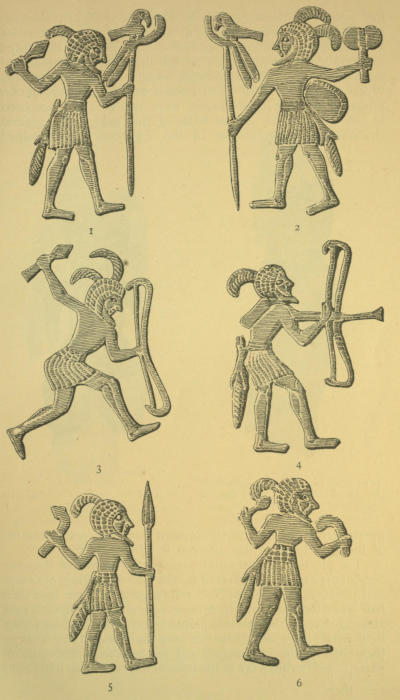
1 2 3 4 5 6
What the physical form of the primitive, pre-dynastic Egyptian was cannot be said, but it is probable that he resembled the dynastic Egyptians whose pictures are seen by hundreds in the tombs. If this be so, he was tall, slender of body, with long thin legs, small hands, and long feet. His hair was black and curly, but must not be confounded with the “wool” of the negro, his eyes black and slightly almond-shaped, his cheek-bones high and often prominent, his nose straight—sometimes aquiline—and inclined to be fleshy; his mouth wide, with somewhat full lips, his teeth small and regular and his chin prominent, because his under jaw was thrust slightly forward. The women were yellowish in colour, probably because their bodies were not so much exposed to the rays of the sun as those of the men. The general character of the physique of the Egyptian has remained practically unchanged to the present day, and no admixture of foreign elements has affected it permanently.
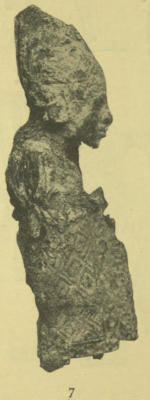
7
Ivory figure of a king.
1st dynasty (?)
[No. 197, Table-case L, Third Egyptian Room.]

8
Bone figure of a dwarf.
Archaïc Period.
[No. 42, Table-case L, Third Egyptian Room.]
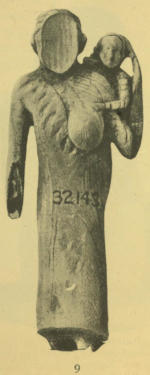
9
Bone figure of a woman carrying a child on her shoulder.
Archaïc Period.
[No. 41, Table-case L, Third Egyptian Room.]

10
Bone figure of a woman, with inlaid lapis-lazuli eyes.
Archaïc Period.
[No. 40, Table-case L, Third Egyptian Room.]
The physical features and dress of the primitive dynastic Egyptians are well illustrated by the accompanying drawings and photographs. From Nos. 1-6 (page 23) we see that their hair was short and curly, their noses long and pointed, their eyes almond-shaped, their beards pointed, their arms and legs long, their hands large, and their feet long and flat. They wear in their hair feathers, probably red feathers from the tails of parrots, such as are worn at the present day, and their loin cloths[25] are fastened round their bodies by belts, from which hang short, bushy tails of jackals(?). No. 1 bears a hawk-standard, the symbol of the god of the tribe, and is armed with a mace having a diamond-shaped head. No. 2 bears a hawk-standard and wields a double-headed stone axe. No. 3 is armed with a mace and a bow. No. 4 is shooting a flint-tipped arrow from a bow. No. 5 is armed with a boomerang and a spear, and No. 6 with a mace and a boomerang. The above illustrations are drawn from the green slate shield exhibited in Table-case L in the Third Egyptian Room.
To about the same period belongs the ivory figure of a king here reproduced (No. 7). He wears the Crown of the South, and a garment worked with an elaborate diamond pattern. The[26] nose is flatter and more fleshy than in the drawings from the slate shield, and the lips are fuller and firmer. In figures 8-10 we have representations of the women of the Archaïc Period, about B.C. 4200. No. 8 is a female dwarf, or perhaps a woman who belonged to one of the pygmy tribes that lived near the Equator. No. 9 is a most interesting figure, for it illustrates the hair-dressing and dress of the period. The features of the child, who is carried partly on the back and partly on the left shoulder, as at the present day, are well preserved. No. 10 represents a woman of slim build, with blue eyes, and wearing an elaborate head-dress, which falls over her shoulders.
Portrait Figures of Officials of the IIIrd or IVth Dynasty. About B.C. 3700.
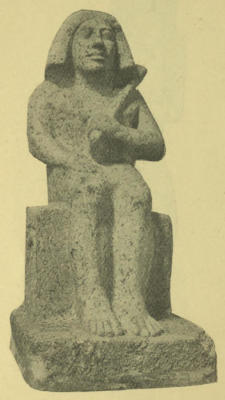
Figure of Betchmes, a royal kinsman.
[Vestibule, South Wall, No. 3.]
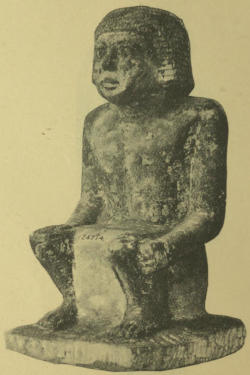
Painted limestone figure of Nefer-hi.
[No. 150, Wall-case 99, Third Egyptian Room.]
National Character.—Herodotus, who was an acute observer of the manners and customs of the Egyptians, states (ii, 64) that the Egyptians were “beyond measure scrupulous in all matters appertaining to religion,” and the monuments prove him to be absolutely correct. The Egyptian worshipped his God, whose chief symbol to him was the sun, daily and[27] regularly, and prayed to him morning and evening. His attitude towards his Maker was one of absolute resignation. The power of God, as displayed by the Sun, and the River Nile, and other forces of nature filled him with awe, and made him to realize his helplessness. His views as to the dependence of men on the sun are well illustrated by the following extract from a hymn to Ȧten, the god of the Solar Disk: “When thou settest in the western horizon of heaven, the earth becometh dark with the darkness of the dead. Men sleep in their houses, their heads are covered up, their nostrils are closed, and no man can see his neighbour; everything which they possess could be stolen from under their heads without their knowing it. All the lions come forth from their dens, every creeping thing biteth, the smithy is in blackness, and all the earth is silent because he who made them (i.e., all creatures) resteth in his horizon. When the dawn cometh, and thou risest and shinest from the Disk, darkness flieth away, thou givest forth thy rays, and the Two Lands (i.e., Egypt) are in festival. Men rise up, they stand upon their feet—it is thou who hast raised them—they wash their bodies, and dress themselves in their clothes, and they [stretch out] their hands to thee in thanksgiving for thy rising.” To the god of the city, or local deity, he also paid due reverence. He worshipped Osiris, the type and symbol of the resurrection, most truly, for on his help and succour depended his hope of eternal life. The Egyptians, who were men of means, spent largely during their lifetime in making preparations for their death, and they spared neither money[28] nor pains in their endeavours to secure for themselves life in the Other World. They observed the Religious and Civil Laws most carefully, and any breach they might make in either they thought could be amply atoned for by making offerings or payment.
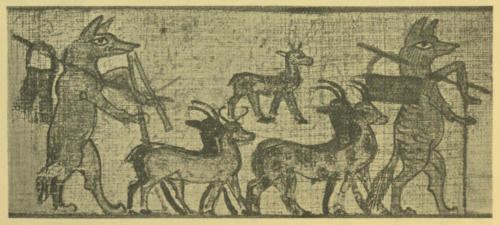
The fox playing the double pipes for a flock of goats to march to.
[From a papyrus in the British Museum, No. 10,016.]
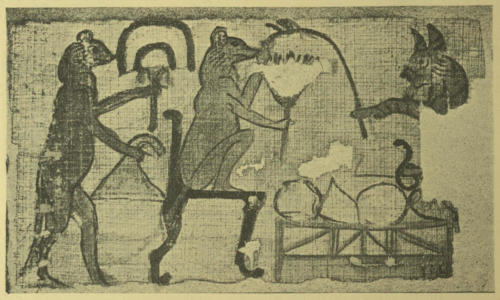
A mouse seated on a chair, with a table of food before it. A cat is presenting to it a palm branch, and behind it is a mouse bearing a fan, etc.
[From a papyrus in the British Museum, No. 10,016.]
The Egyptian was easy and simple in disposition, and fond of pleasure and of the good things of this world. He loved eating and drinking, and he lost no opportunity of enjoying himself. The literature of all periods is filled with passages in which the living are exhorted to be happy; and we may note that in the famous Dialogue between a man who is weary of life and his soul, the latter tells the man that to remember the grave only brings sorrow to the heart and fills the eyes with tears. And after several observations of the same import, the soul says: “Hearken unto me, for, behold, it is good for men to hearken; follow after pleasure and forget care.”[4] In the Song of the Harper we read: “Bodies (i.e., men) have come into being in order to pass away since the time of Rā, and young men come in their[29] places. Rā placeth himself in the sky in the morning, and Temu setteth in the Mountain of Sunset. Men beget children and women bring forth, and every nostril snuffeth the wind of dawn from the time of their birth to the day when they go to the place which is assigned to them. Make [thy] day happy! Let there be perfumes and sweet odours for thy nostrils, and let there be wreaths of flowers and lilies for the neck and shoulders of thy beloved sister who shall be seated by thy side. Let there be songs and the music of the harp before thee, and setting behind thy back unpleasant things of every kind, remember only pleasure, until the day cometh wherein thou must travel to the land which loveth silence.”
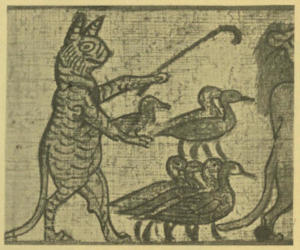
A cat herding geese.
[From a papyrus in the British Museum, No. 10,016.]
The advice to eat, drink, and be happy, is also given to a high-priest of Memphis by his dead wife That-I-em-ḥetep on her sepulchral tablet (Southern Egyptian Gallery, Bay 29, No. 1027). She says: “Hail, my brother, husband, friend, ... let[5] not thy heart cease to drink water, to eat bread, to[30] drink wine, to love women, to make a happy day, and to seek thy heart’s desire by day and by night. And set no care whatsoever in thy heart: are the years which [we pass] upon the earth so many [that we need do this]?”
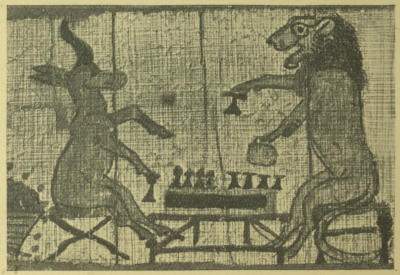
The lion and the unicorn playing a game of draughts.
[From a papyrus in the British Museum, No. 10,016.]
The morality of the Egyptians was of a high character, and certainly higher than that of Oriental nations in general. Many of the Precepts of Ptaḥ-ḥetep, Kaqemna, and Khensu-ḥetep bear comparison with the moral maxims of the Books of Proverbs and Ecclesiasticus. The view of the Egyptian as to his duty towards his neighbour is well summed up by Pepi-Nekht, an old feudal lord of Elephantine, who flourished under the VIth dynasty, and said: “I am one who spoke good and repeated what was liked. Never did I say an evil word of any kind to a chief against anyone, for I wished it to be well with me before the great god. I gave bread to the hungry man, and clothes to the naked man. I never gave judgment in a case between two brothers whereby a son was deprived of his father’s goods. I was loved by my father, favoured by my mother, and beloved by my brothers and sisters.” Love of parents and home was a strong trait in the character of the Egyptian; and it was one cause of his hatred of military service and of any occupation which would take him away from his town or village. He prayed, too, that in the Other World he might have his parents, wife, children, and relatives, with him on his farm in[31] the Fields of Peace, and that when his spirit was on the way thither, the spirits of his kinsfolk would come to meet him, armed with their staves and weapons, so that they might protect him from the attack of hostile spirits. Like all African people he loved music, singing, and dancing, and was attracted by ceremonials, processions, and display of every kind; the satirical papyri (see the illustrations on pages 27-30), and even the wall-paintings in the tombs, show that he possessed a keen sense of humour. The peasant was then, as now, a laborious toiler, and as he was literally the slave of Pharaoh for thousands of years, the ideas of freedom and national independence, as we understand them, were wholly unknown to him.
All classes were intensely superstitious, and they believed firmly in the existence of spirits, good and bad, witches, and fiends and devils, which they tried to cajole, or wheedle, or placate with gifts, or to vanquish by means of spells, magical names, words of power, amulets of all kinds, etc. The magician was the real priest, to the lower classes at least, as he is to this day in Central Africa, for by the use of magical figures he assured his clients that he could procure for them the death, or sickness, of an enemy, riches, the love of women, dreams wherein the future would be revealed to them, and above all, the assistance of the gods. We find that about B.C. 312 a service was regularly performed in the temple of Ȧmen-Rā at Thebes to make the sun rise. In the course of it a figure of the monster Āpep, who was supposed to be lying in wait to swallow the Sun-god, was made of wax, then wrapped in new papyrus on which the “accursed name” of the fiend was written in green ink, and solemnly burned in a fire fed by a special kind of herb, whilst the priest spurned it with his left foot and poured out curses on each of the thirty “accursed names” of the evil one. As the wax melted and was consumed, together with the papyrus and the green ink with which his name was written, so the body of Āpep was believed to be consumed in the flames of the rising sun in the eastern sky.
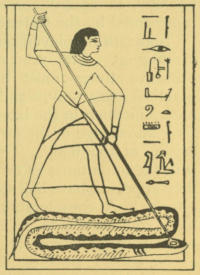
The spearing of Āpep.
From the evidence given at Thebes about B.C. 1200 against certain officials who were implicated in a case of conspiracy against Rameses III, it appeared that a certain man had stolen a book of magic from the temple library. From this he obtained instructions how to make the wax figures which caused the sickness, quakings of the limbs, and death of those in whose forms they were made. An example of the wax figures which were used in the Ptolemaïc period is exhibited in Table-case C in the Third Egyptian Room, No. 198. The core is made of inscribed papyrus, and in front, in the centre, is a piece of hair, presumably that of the person on whom the magician who made the figure sought to exert his influence. Every act of daily life had some magical or religious observance associated with it, and every day, either in whole or in part, was declared to be lucky or unlucky, in accordance with a series of events which were represented by the Calendar of lucky and unlucky days.
Superstition played as prominent a part in medicine as in religion. The practice of dismembering the dead in primitive times must have taught the Egyptians some practical anatomy, and the operations connected with mummification in the later period must have added largely to their knowledge of the arrangement of the principal internal organs of the body. The Egyptians were well acquainted with the importance of the heart in the human economy, and they appear to have had some knowledge of the functions of the arteries. A considerable number of medical prescriptions have come down to us, e.g., those which are inscribed on a papyrus in the British Museum (No. 10,059) and are said to be as old as the time of Khufu (Cheops), a king of the IVth dynasty, and those of the Ebers Papyrus, of the XVIIIth dynasty; from these it is easy to see that they closely resemble in many particulars the prescriptions given in English medical books printed two or three hundred years ago. Powders and decoctions made from plants and seeds were largely used, and the piths of certain trees, dates, sycamore-figs, and other fruits, salt, magnesia, oil, honey, sweet beer, formed the principal ingredients of many prescriptions. With these were often mixed substances of an unpleasant nature, e.g., bone dust, rancid fat, the droppings of animals, etc. In order that certain drugs might have the desired effect it was necessary for the physician to recite a magical formula four times (Ebers Papyrus CVIII). Other medicines again owed their efficacy to the belief that they had been actually taken by one or other of the gods whilst[33] they reigned upon earth, and the authorship of certain prescriptions was ascribed to Rā. Thus according to the Ebers Papyrus (XLVI) Rā suffered from attacks of boils of a most malignant kind, and he made up a salve, containing sixteen ingredients, which gave him instant relief, and which was therefore certain to cure ordinary mortals. The following is a characteristic example of a prescription which, as is evident, contains a number of substances which are well known to be good for inflamed eyes, and also some others the special value of which is not clear:—
| 𓎡𓏏𓈖𓏏𓂧𓂋𓂡𓇉𓄿𓍘𓏭𓅓𓁹𓏏𓏤 | “Another [prescription] for driving inflammation from the eye. | |
| 𓂝𓈖𓅂𓈒𓏦 | Myrrh | 1 |
| 𓎃𓏤𓏜𓏪𓅨𓂋𓈒𓏦 | ‘Great Protectors’ seed | 1 |
| 𓍱𓊃𓇌𓏏𓈒 | Oxide of copper | 1 |
| 𓍑𓄿𓂋𓏏𓈒𓏦 | Citron pips | 1 |
| 𓎼𓄿𓇌𓏏𓆰𓎖𓏲𓏰 | Northern cypress flowers | 1 |
| 𓇅𓏲𓈒𓏪 | Antimony | 1 |
| 𓈎𓄿𓇌𓏏𓐎𓏪𓈖𓏏𓎼𓎛𓋴𓄛 | Gazelle droppings | 1 |
| 𓏶𓅓𓏭𓈖𓈎𓄿𓂧𓇌𓏏𓄛 | Oryx offal | 1 |
| 𓌻𓂋𓎛𓏏𓏊𓏪𓌉𓆓𓏏𓇳 | White oil | 1[34] |
| [Directions for use.] | ||
| 𓂞𓁷𓏤𓈗𓁀 𓂜𓐎𓂝 𓁷𓂋𓋴𓂋𓇳𓏽𓎡𓇌𓆓𓂧 𓎘𓎛𓏲𓂡𓐍𓂋𓎡𓋴𓏏𓅓 𓆄𓆃𓈖𓏏𓈖𓂋𓏏𓅬 |
“Place in water, let stand for one night, strain through a cloth, and smear over [the eye] for four days; or, according to another prescription, paint it on [the eye] with a goose-feather.”[6] | |
The Egyptian physician was called upon not only to heal his patients, but to beautify them, and we find prescriptions for removing scurf from the skin, for changing the colour of the skin, for making the skin smooth, and the following for removing wrinkles from the face:—
| 𓎡𓏏𓈖𓏏𓂧𓂋𓂡𓈎𓂋𓆑𓏲𓏼𓏌𓏤𓁷𓏤 | “Another [prescription] for driving away wrinkles of the face.” | |
| 𓅮𓇌𓏏𓈒𓏼𓈖𓏏𓊹𓌣𓏏𓂋𓈒𓏼 | Ball of incense | 1 |
| 𓏠𓈖𓎛𓈒𓏼 | Wax | 1 |
| 𓆮𓏊𓏼𓇅𓆓𓏛 | Fresh oil | 1 |
| 𓎼𓇋𓏲𓆰𓏥 | Cypress berries | 1 |
| [Directions for use.] | ||
| 𓏌𓂡𓏟𓏜𓂋𓂞𓁷𓏤 𓎛𓋴𓐠𓄿𓈗𓏊𓏼𓂋𓂞 𓂋𓁷𓏤𓇳𓏤𓏿𓁹𓌴𓁹𓄿𓄿𓎡 |
“Crush, and rub down and put in new milk and apply it to the face for six days. Take good heed [to this].”[7] | |
The population of Egypt was, in 1897, 9,734,405 persons, of whom 8,978,775 were Muḥammadans, 25,200 Jews, and 730,162 Christians. The last census was taken on the 29th April, 1907, and the entire population of the country consisted of 11,272,000 persons, or nearly 16 per cent. more than in 1897.
The Egyptian Language is not Semitic, although it possesses many characteristics which resemble those of the Semitic languages, but in a less developed form. Of all the views on the subject which have been held in recent years, the most plausible one is that which makes Egyptian belong to the group of Proto-Semitic languages. The Egyptian and the Semitic languages appear to have sprung from a common stock, from which they separated before their grammars and vocabularies were consolidated. The Egyptian language developed rapidly under circumstances of which nothing is known, and then, apparently, became crystallized; the Semitic language developed less rapidly, but continued to develope for centuries after the growth of the Egyptian language was arrested. To the period when Egyptian separated itself from the parent stock no date can be assigned, but it must have taken place some thousands of years before Christ. Later, under the XVIIIth and XIXth dynasties, B.C. 1550 to 1300, a large number of Semitic words were introduced into the language, and in such compositions as the “Travels of an Egyptian” (see page 70) a great many are transcribed into Egyptian characters.
The Egyptian language as known to us appears in four divisions, viz.:—
1. The Egyptian of the Early Empire, which was studied and employed for literary purposes from about B.C. 4400 to about A.D. 200.
2. The Egyptian used in the ordinary business of life and for conversation, from about B.C. 2600 to 650.
3. The popular speech of the country, from about 600 or 500 B.C. to the end of the Roman Period.
4. The ordinary language of the country, after Christianity was introduced into it; this is called Coptic. It ceased to be used in Egypt as a spoken language, probably about the twelfth century, but the Holy Scriptures and the Services are in several places in Egypt read in Coptic on Sundays and Festivals, although very few people understand what is being read. Four dialects of Coptic are distinguished: (1) That of Upper Egypt, called “Sahidic.” (2) That of Lower Egypt, called “Boheiric.” (3) The dialect of Ṣûhâḳ and its neighbourhood. (4) The[36] dialect of the district of the Fayyûm. It is a noteworthy fact that, from the beginning of the second century of our era to the twelfth, the language of ancient Egypt was preserved, in a modified form, chiefly through the translations of the Holy Scriptures, which were made from Greek into Coptic.
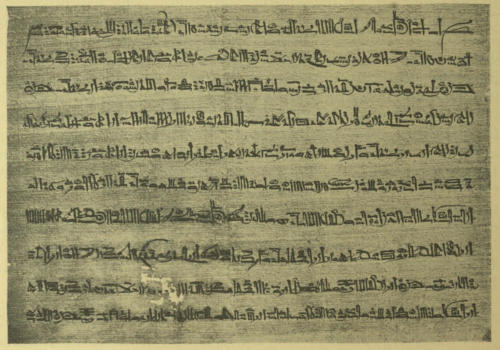
A page of hieratic writing from the Great Harris Papyrus.
Egyptian Writing was of three kinds, which are called “Hieroglyphic,” “Hieratic,” and “Demotic.” The oldest form is the hieroglyphic (i.e., sacred engraved writing), or purely pictorial, which was employed in inscriptions upon temples, tombs, statues, sepulchral tablets, etc., and for monumental purposes generally. At a very early period it was found that the hieroglyphic form of writing was cumbrous, and that in cases where it was important to write quickly on papyrus, the pictorial characters were inconvenient. The scribes, therefore, began first to modify, and secondly to abbreviate the pictorial characters, and at length the form of writing called hieratic (i.e., the priests’ writing) was developed. Hieratic was a style of cursive writing much used by the priests in copying literary compositions on papyrus from the IVth or Vth dynasty to the XXVIth dynasty. This form of writing is well illustrated by the above reproduction of[37] a page from the Great Harris Papyrus in the British Museum (No. 9999), which was written about B.C. 1200. The text is read from right to left, and the following is a transcript into hieroglyphic characters of the first two lines:—
1. 𓆓𓂧𓇋𓈖𓇓𓏏𓈖𓀭𓍹𓇳𓄊𓌷𓏏𓆄𓌻𓇋𓏠𓈖𓀭𓍺𓀭𓋹𓍑𓋴𓅮𓄿𓊹𓀭𓉻𓏛𓐍𓂋𓀙𓏲𓀀𓏪𓄂𓏏𓏲𓏭𓏴𓂻𓀀𓏪𓏌𓏤𓇾𓏤𓈇𓀎𓀀𓏪𓈖𓏏𓎛𓏏𓂋𓇋𓆳𓄛𓏦𓆷𓄿𓏭𓂋𓂧𓏤𓄿𓈖𓄿𓌙𓀀𓏪𓌔𓏏𓏤𓀀𓏪𓆈𓏏𓏦
2. 𓋹𓈖𓐍𓏲𓀀𓏥𓎟𓏌𓏤𓇾𓏤𓈇𓈖𓇾𓏤𓈇𓌻𓇋𓆳𓊖𓊖𓄔𓅓𓏜𓏲𓈖𓏦𓂞𓏲𓀭𓂝𓌴𓄿𓅓𓏲𓁻𓏏𓈖𓏦𓅓𓈖𓄿𓇌𓏪𓀭𓅜𓐍𓏲𓏜𓏪𓇋𓀁𓁹𓂋𓏲𓀭𓇋𓏲𓀭𓅓𓇓𓏏𓈖𓀭𓈖𓂋𓐍𓇌𓅛𓀀𓁐𓏪𓃹𓈖𓅮𓄿𓇾𓏤𓈇𓈖
Between the end of the XXIInd and the beginning of the XXVIth dynasty the scribes, wishing to simplify hieratic still further, constructed from it a purely conventional system of signs from which most of the prominent characteristics of the hieroglyphic, or pictures, that had been preserved in the hieratic characters, disappeared. This new form of writing was called demotic (i.e., the people’s writing), but it was known among some of the early Egyptologists as enchorial (i.e., native writing, or writing of the country). On the Rosetta Stone (Egyptian Gallery, No. 960) the visitor will see an example of the hieroglyphic and demotic forms of writing placed one above the other, and in the text we find that the hieroglyphic portion is called “the writing of the divine words,” or letters, 𓏟𓈖𓊹𓌃𓏪, and the demotic “the writing of books,” i.e., rolls of papyrus, 𓏟𓋔𓈚𓂝𓇌𓍽. The invention of the art of writing was assigned to the god Thoth, who was the great scribe of the gods, and who is frequently represented holding a writing palette and a reed pen, and the hieroglyphics, or picture signs, were, therefore, called “divine, sacred, or holy.” Hieroglyphics were used for monumental purposes until about the end of the third century A.D., but it is tolerably certain that very few people could read them or understand them.
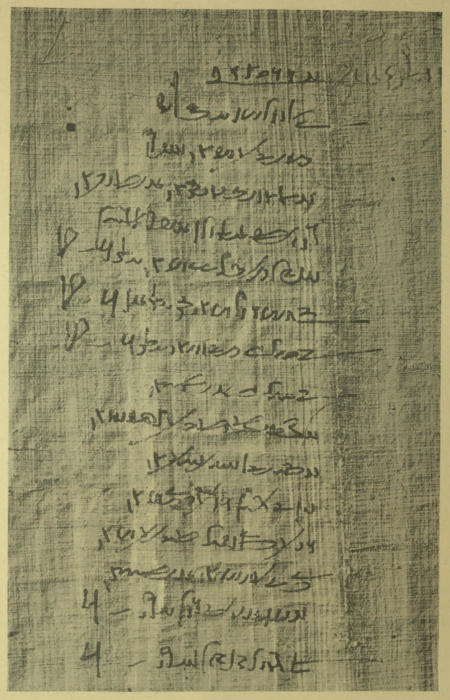
Demotic Writing.
During the Ptolemaïc Period, though Greek was the language of the kings and the upper classes of the country, the temples were covered with inscriptions in hieroglyphics, and the Ptolemies and the Romans adopted old Egyptian titles, and had their names transcribed into hieroglyphics and cut in cartouches like the Pharaohs. In the reigns of Euergetes I (B.C. 267 to 222) and Epiphanes (B.C. 205 to 181) the priests promulgated decrees in honour of their kings which were cut on slabs of basalt in the hieroglyphic, demotic, and Greek characters, but on the sepulchral tablets of the period the inscriptions are usually in hieroglyphics alone, because the natives throughout the country clung to these characters, which had, from time immemorial, been associated with their religious beliefs and ceremonies. In the Southern Egyptian Gallery, however, are exhibited several tablets which are inscribed in demotic as well as in hieroglyphics, and of these may be noted the tablet of Tut-i-em-ḥetep (No. 1028, Bay 25), who died B.C. 118; the tablet of Khā-em-ḥrȧ (No. 997, Bay 25); and the tablet of Peṭā Bast (No. 1030, Bay 27). In the Roman Period we find that the use of demotic sometimes superseded that of hieroglyphics in public documents, and as an example of this may be mentioned the fine sandstone tablet inscribed, wholly in demotic, with a decree recording the dedication of certain properties to the gods who were worshipped at Karnak (Thebes) in the first century of our era (No. 993, Bay 27). This tablet was found at Karnak, in the Hall of Columns, where, no doubt, it was set up originally, and its inscription was cut in demotic, because, at that period, that form of writing was better understood than hieroglyphics. In the Roman Period hieroglyphic inscriptions were sometimes accompanied by renderings into Greek and Latin, e.g., No. 257, Third Egyptian Room, Wall-case No. 109. This is a portion of a statue of a priest bearing a shrine of Osiris. On the back of the plinth is an inscription in hieroglyphics containing an address to Osiris by a priest of the “fourth order,” and on one side of the plinth are cut in Latin and Greek “priest bearing Osiris.”
Coptic is written with the letters of the Greek alphabet, and seven signs (ϣ, ϥ, ϧ, ϩ, ϫ, ϭ, ϯ), derived from demotic characters, the phonetic values of which could not be expressed by Greek letters. A fine collection of sepulchral tablets inscribed in Coptic is exhibited in the Southern Egyptian Gallery (Bay 32), and a long and most instructive[40] series of drafts of documents on potsherds and slices of limestone will be found in Table-case M in the Fourth Egyptian Room. In the copy of the Lord’s Prayer (St. Matthew vi, 9) here appended the reader will find all the signs which are peculiar to Coptic save one (ϭ). The dialect is that of Lower Egypt. The two words marked by asterisks are Greek, not Egyptian.
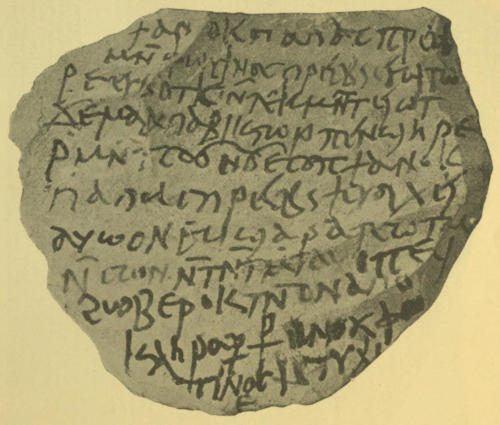
Coptic inscription on a slice of limestone.
[No. 10, Table-case M, Third Egyptian Room.]
Decipherment of Egyptian Hieroglyphics.—Before the close of the period of Roman rule in Egypt, the hieroglyphic system of writing fell into disuse, and its place was gradually taken by demotic, i.e., a conventional form of the hieratic, or cursive writing. When the Egyptians became converted to Christianity, they adopted the Greek alphabet, adding to it seven signs derived from demotic, to express the sounds peculiar to their language. The priests appear to have prosecuted some study of hieroglyphics until the end of the fifth century A.D., but soon after this the power to read and understand them was lost, and until the beginning of the nineteenth century, no Oriental or European could read or understand a hieroglyphic inscription. During the seventeenth and eighteenth centuries many attempts were made by scholars to read and translate the Egyptian inscriptions, but no real progress was made until after the discovery of the Rosetta Stone. This “Stone” is a portion of a large black basalt stele measuring 3 feet 9 inches by 2 feet 4½ inches, and is inscribed with fourteen lines of hieroglyphics, thirty-two lines of demotic, and fifty-four lines of Greek. (See Southern Egyptian Gallery, No. 960.) It was found in 1798 by a French officer of artillery named Boussard, among the ruins of Fort Saint Julien, near the Rosetta mouth of the Nile, and was removed, in 1799, to the Institut National at Cairo, to be examined by the learned; and Napoleon ordered the inscription to be engraved and copies of it to be submitted to the scholars and learned societies of Europe. In 1801 it passed into the possession of the British, and it was sent to England in February, 1802. It was exhibited for a few months in the rooms of the Society of Antiquaries, and then was finally deposited in the British Museum.
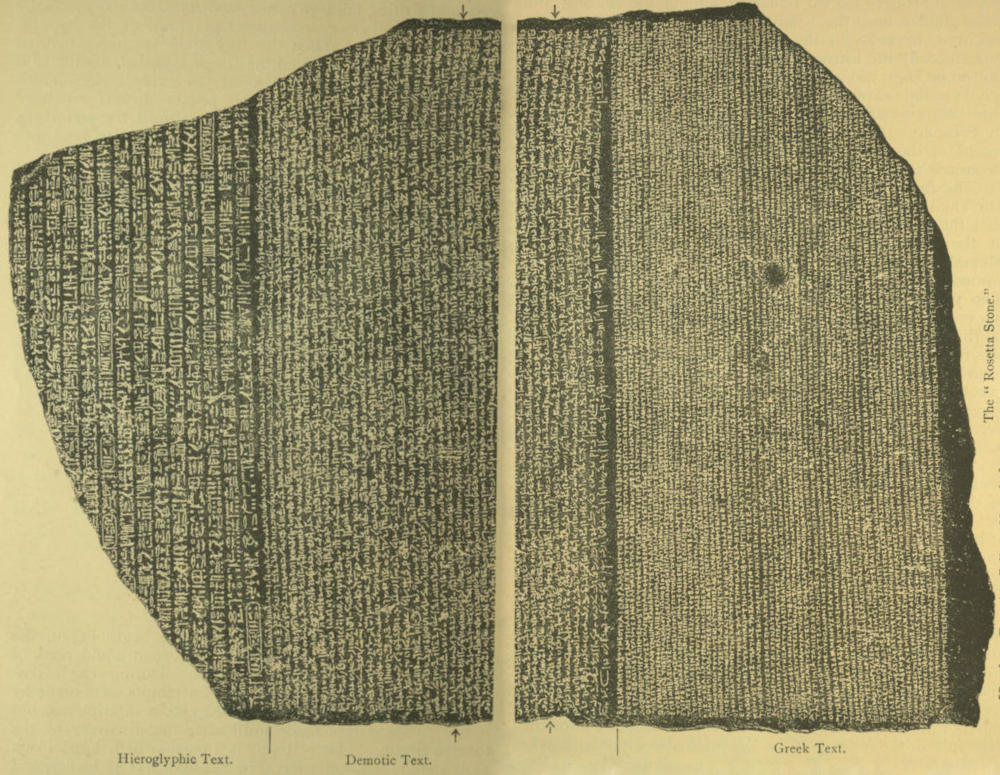
The “Rosetta Stone.”
[Southern Egyptian Gallery, No. 960.]
The first translation of the Greek text was made by Du Theil and Weston, in 1801-02, and they rightly declared that the stone was set up as the result of a Decree passed at the General Council of Egyptian priests assembled at Memphis to celebrate the first commemoration of the coronation of Ptolemy V, Epiphanes, king of all Egypt. The young king had been crowned in the eighth year of his reign, therefore the first commemoration took place in the ninth year, in the spring of the year, B.C. 196. The Decree sets forth that, because the king had given corn and money from his private resources to the temples, and had remitted taxes and released prisoners, and had abolished the press-gang and restored the worship of the gods, etc., the priests decreed that: Additional honours be paid to the king and his ancestors; an image of the king be set up in every temple; a statue and shrine be set up in every temple; a monthly festival be established on the birthday and coronation day of the king; this Decree be engraved upon a hard stone stele in the writing of the priests (hieroglyphic), in the writing of books (demotic), and in the writing of the Greeks (Greek), and set up in every temple of the first, second, and third class, by the side of the image of the king.
In 1802 Åkerblad succeeded in making out the general meaning of several lines of the demotic text, and in identifying the equivalents of the names Alexander, Alexandria, Ptolemy, etc. In 1819 Thomas Young published in the Encyclopaedia Britannica, vol. IV, the results of his studies of the texts, and among them was a list of several alphabetic Egyptian characters to which, in most cases, he had assigned correct values. He was the first to grasp the idea of a phonetic principle in the reading of the Egyptian hieroglyphics, and he was the first to apply it to their decipherment. Warburton, De Guignes, Barthélemy and Zoëga all suspected the existence[45] of alphabetic hieroglyphics, and the three last-named scholars believed that the oval, or cartouche 𓍷, contained a royal name; but it was Young who first proved both points and successfully deciphered the name of Ptolemy on the Rosetta Stone, and that of Berenice on another monument, and it was Bankes who first identified the name of Cleopatra. The list of alphabetic characters was much enlarged in 1822 by the eminent scholar Champollion, who not only correctly deciphered the names and titles of most of the Roman Emperors, but drew up classified lists of the hieroglyphics, and formulated a system of grammar and general decipherment which is the foundation upon which all subsequent Egyptologists have worked. The discovery of the correct alphabetic values of Egyptian signs was most useful for reading names, but, for translating the language, a competent knowledge of Coptic was required. Now Coptic is only another name for Egyptian. The Egyptian Christians are called “Copts,” and the Holy Scriptures, Liturgies, etc., which they translated from Greek soon after their conversion to Christianity, are said to be written in “Coptic.” The knowledge of Coptic has never been lost, and a comparatively large sacred literature has always been available for study by scholars. Champollion, quite early in the nineteenth century, realized the great importance of Coptic for the purpose of Egyptian decipherment, and he made himself the greatest Coptic scholar of his time. His knowledge of Coptic was deep and wide, and to this important qualification much of his success is due. Having once obtained a correct value of many alphabetic and syllabic characters, his knowledge of Coptic helped him to deduce the values of others, and to assign meanings to Egyptian words with marvellous accuracy.
The method by which the greater part of the Egyptian alphabet was recovered is this: It was assumed correctly that the cartouche always contained a royal name. The only cartouche on the Rosetta Stone was assumed to contain the name Ptolemy. An obelisk brought from Philae about that time contained a hieroglyphic inscription, and a translation of it in Greek, which mentioned two names, Ptolemy and Cleopatra, and one of the cartouches was filled with hieroglyphic characters which were identical with those in the cartouche on the Rosetta Stone. Thus there was good reason to believe that the cartouche on the Rosetta Stone contained the name of Ptolemy written in hieroglyphic characters. Here is the cartouche which was assumed to[46] represent the name Ptolemaios, or Ptolemy, the hieroglyphics being numbered (A)—

A 𓍹𓊪𓏏𓍯𓃭𓐝𓇌𓋴𓍺
and here is the cartouche which was assumed to represent the name Cleopatra (B)—

B 𓍹𓈎𓃭𓇋𓍯𓊪𓄿𓂧𓂋𓄿𓏏𓆇𓍺
Now in B, the first sign, 𓈎, must represent K; it is not found in A. No. 2 sign, 𓃭, is identical with No. 4 sign in A. This was assumed to be L. No. 3 sign, 𓇋, represents a vowel, and doubled, 𓇌, is found in A, No. 6. No. 4 sign, 𓍯, is identical with No. 3 in A, and it must have the value of O in both A and B. No. 5 sign, 𓊪, is identical with No. 1 in A, and as A contains the name Ptolemy, the first sign, 𓊪, must be P. No. 6 sign, 𓄿, is wanting in A, but its value must be A, because it is the same sign as No. 9, which ends the name Kleopatra. No. 7, 𓂧, does not occur in A, but we see it in other cartouches taking the place of 𓏏 the second letter in the name of Ptolemaios, and it must therefore be some kind of T. No. 8, 𓂋, we assume is R, because it is the last letter but one in the name of Kleopatra. Nos. 10 and 11 signs, 𓏏𓆇, we find after the names of goddesses; the first of them is T; and the second is a “determinative.” We now insert the alphabetic values in the two cartouches and obtain the following results:

A 𓍹PTOL𓐝𓇌𓋴𓍺

B 𓍹KL(?) OPATR(?)A𓏏𓆇𓍺
In the case of A it is quite clear that Ptol is the first part of the name of Ptolemaios, therefore 𓐝𓇌𓋴 must represent the second part of the name, or Maios. We may then say that 𓐝 is M, and the last sign 𓋴 is S, and that 𓇌 represents[47] some i-sound, or e-sound; in the case of B we are certain of the values of all the signs except 𓈎, 𓂋 and 𓆇, but it is clear from their positions in the name that the first two must represent K and R. We have seen that the signs 𓏏𓆇 are added to the names of goddesses, and as Kleopatra was regarded as a goddess, they are added to her name. They do not affect the name itself. The two royal names may now be taken out of the cartouches, and the values written under the characters thus:

A 𓊪 𓏏 𓍯 𓃭 𓐝 𓇌 𓋴 P T O L M (I or E) S

B 𓈎 𓃭 𓇋 𓍯 𓊪 𓄿 𓂧 𓂋 𓄿 𓏏𓆇 K L E(?) O P A T R A ...
Taking another cartouche 𓍹𓄿𓃭𓎡𓋴𓇋𓈖𓂧𓂋𓊃𓍺 we already know the signs, 𓄿𓃭𓋴𓇋𓂧𓂋, which represent A, L, S, E(?), T, and R. The only Greek name which contains these letters in this order is Alexandros, or Alexander, and we therefore conclude that the last sign, 𓊃, is S, that 𓎡 is K, that 𓇋 is A, and that 𓈖 is N.
A common title of the Roman Emperors was 𓎡𓇌𓋴𓂋𓊃, and as we know all the signs but one (𓇌) with certainty we write down K-𓇌-S-R-S, which can only be “Kaisaros,” or “Caesar.” From this we again see that 𓇌 represents the αι in Καισαρος and Πτολεμαιος, or ae in Caesar.
In this way the Egyptian alphabet was recovered.
Now if we look at the last line of the Egyptian text on the Rosetta Stone we shall find that in the cartouche 𓍹𓊪𓏏𓍯𓃭𓐝𓇌𓋴𓋹𓆓𓏏𓇾𓊪𓏏𓎛𓌻𓇌𓍺 there are several signs which have not been explained above, viz., 𓋹𓆓𓏏𓇾𓊪𓏏𓎛𓌻𓇌.[48] These signs, it is clear, form no part of the name of Ptolemy, and the position in which they are found suggests that they represent titles. A reference to the Greek version (line 49) shows that Ptolemy is there called “everliving, beloved of Phtha,” and it now remains to see if the hieroglyphics mean anything like these words. The sound and meaning of the first sign, 𓋹, were well known from the statements of Greek writers who said that it was pronounced anch, and that it meant “living,” or “life.” Two of the three characters in the group, 𓊪𓏏𓎛, we know to be P and T, and we are justified in assuming that 𓊪𓏏𓎛 represents the name of the god Phtha, or as it is now read Ptaḥ. Now, if 𓋹 means “living” or “life,” and 𓊪𓏏𓎛 means “Ptaḥ,” 𓆓𓏏𓇾 must mean “for ever,” and 𓌻𓇌 must mean “beloved.” Of the first group, 𓆓𓏏𓇾, we already know the value of the second sign 𓏏, T, and of the second group we know that 𓇌 has the value of I. Recourse must now be had to Coptic, so that the Coptic (i.e., Egyptian) words for “for ever” and “beloved” may be compared with the hieroglyphic originals. The common word for “for ever,” “eternity,” etc., is eneḥ, but there is no n in 𓆓𓏏𓇾, so this will not suit. We do, however, find the word ϭⲉⲧ, djet, which means “an age,” “a long undefined period of time,” and this agrees well with the sound of 𓆓𓏏𓇾, and shows that the sound of 𓆓 was something like DJ, and that 𓇾 must have a T sound. The common word in Coptic for “to love” is ⲙⲉⲣ, mer, and we may therefore transcribe 𓌻𓇌 by meri, and assume that it means something like “beloved.” As the meanings here deduced for 𓋹𓆓𓏏𓇾𓊪𓏏𓎛𓌻𓇌 make good sense in every text in which they occur we are justified in assuming them to be correct.
The Egyptian alphabetic characters are as follow:—
Hieroglyphic writing.—The hieroglyph is a picture of an object, animate or inanimate, e.g., 𓁹 an eye, 𓃝 a ram, 𓃹 a hare, 𓅐 a vulture, 𓅧 a duck, 𓇼 a star, 𓉶 an obelisk, 𓁷 a face, 𓂾 a leg.
Now pictures may also represent ideas, e.g., 𓊊, a wall leaning on one side represents “falling”; 𓄤, a musical instrument, symbolizes “joy, happiness, pleasure,” etc.; 𓋩, a seal, represents something of which great care is taken, i.e., “treasure”; 𓀋, a man holding a vessel placed on his head, symbolizes “to bear, to carry”; , the sky with a star hanging from it, suggests “night”; and so on. Hieroglyphs used in this way are called ideographs. Every object had a name, therefore each picture, or hieroglyph, was a word-sign, and a list of these would have made a dictionary in the earliest times. At one time all hieroglyphs were syllabic, and the Egyptians had no alphabetic hieroglyphs; and if scribes had needed to write down letter by letter the name of some foreign product, or the name of a foreign king, supposing they did not possess syllables suitable in sound, they would have been unable to do so. In fact the Egyptians needed an alphabet, and the oldest inscriptions of any length show that they already possessed one.
About the origin of alphabetic hieroglyphs opinions differ. They probably arose in this way. The sounds of the first letters of the names of certain objects were given to the pictures of such objects, and henceforward the pictures, or hieroglyphs, bore those phonetic values, and so became the letters of an alphabet. Each name chosen for this purpose appears to have consisted of a syllable containing an initial[51] consonant, and one or more vowels. The vowel, or vowels, was dropped, and the name of the object, or the syllable, passed into a purely alphabetic value. Thus 𓃀 is an alphabetic hieroglyph with the phonetic value of B, and it may well represent the consonant of some word like Bu “a place,” or Bȧa “iron.” Similarly 𓂋, which has the phonetic value of R, probably represents the consonant of some word like Ru “mouth,” in Coptic Rô; and 𓆑 with the phonetic value of F probably represents the consonant of some word like fa “to carry.” Thus we have a series of alphabetic characters or letters. Signs having alphabetic values are used to form words without any reference to their pictorial or ideographic meanings. One of the words for “knife” is sfnṭ, which is thus spelt 𓋴𓆑𓈖𓂧. Now 𓋴 s is a picture of a chair-back; 𓆑 f is a picture of a snail(?); 𓈖 n is a picture of the wavy surface of water; and 𓂧 ṭ is a picture of a human hand stretched out flat; in the word sfnṭ the picture meanings of the characters play no part, and the signs are used to express alphabetic sounds only.
As long as the Egyptians used picture writing pure and simple its meaning was easily understood, but, when they began to spell their words with alphabetic signs and syllabic values of picture signs which had no reference whatever to the original meaning of the signs, it was found necessary to indicate in some way the meaning and even the sounds of many of the words so written. This they did by adding to them signs which are called determinatives. Thus the word āḥa 𓊢𓂝 means both “to stand” and “boat,” but when the writer wished the reader to give it the former meaning he added to the word a pair of legs 𓂻, thus 𓊢𓂝𓂻, and when the latter he added the picture of a boat 𓊛, thus 𓊢𓂝𓊛. Similarly men 𓏠𓈖 means “to abide, be stable,” and also “to be ill,” and the meanings are distinguished by the use of the determinatives 𓏛 and 𓅪, the former signifying “an abstract idea,” and the latter “discomfort,” or “evil.” The following words show the use of the determinatives; 𓀭 a god, 𓀁 actions performed with the mouth, 𓁐 a woman, 𓈉 a[52] country, 𓄛 the skin of an animal, 𓈗 water, 𓌪 actions performed with a knife, and 𓏊 a pot of unguent or liquid.
| The god Khnemu | 𓎸𓅓𓅱𓀭 |
| Meṭu “to speak” | 𓌃𓂧𓅱𓀁 |
| Sat “daughter” | 𓅭𓏏𓁐 |
| Kesh “Nubia” | 𓎡𓈚𓈉 |
| Pennu “mouse” | 𓊪𓈖𓏌𓅱𓄛 |
| Mȧu “cat” | 𓏇𓇋𓅱𓄛 or 𓏇𓇋𓅱𓃠 |
| Qebḥ “libation” | 𓈎𓃀𓎛𓈗 |
| Sma “to slay” | 𓋴𓌳𓌪 |
| Merḥet “oil” | 𓌻𓂋𓎛𓏏𓏊 |
| Ḥeqt “beer” | 𓎛𓈎𓏏𓏊 |
Hieroglyphs are written in perpendicular or horizontal lines as in A and B. In these examples the words are to be read in the direction in which the birds face, i.e., from left to right.
A.
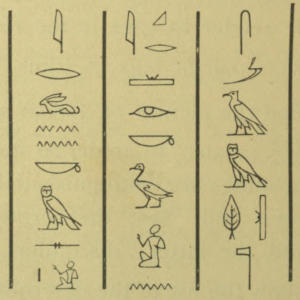
𓇋𓂋𓃹𓈖𓈖𓎡𓅓𓊃𓏤𓀀
𓇋𓈎𓂋𓏛𓁹𓎡𓅭𓀀𓈖
𓋴𓌳𓄿𓅓𓆭𓏜𓊹[8]
B.

𓇋𓅱𓂋𓂞𓈖𓀀𓏏𓏐𓏥𓈖𓎛𓈎𓏏𓅪𓏥𓈗𓋔𓇋𓃀𓃚𓏭𓈗𓀁𓀀𓎛𓃀𓋴𓅱𓋳𓏥𓈖𓇉𓄿𓏭𓅱𓋳𓀀𓅖𓄚𓈖𓊛𓃛𓏲𓏭𓊛𓀀[9]
The writing materials consisted of papyrus, palette, reed-pens, ink and ink-pot. Papyrus was made from the stem of the papyrus plant (Cyperus Papyrus), which grew in the marshes and pools near the Nile; it is no longer cultivated in Egypt, but is found in the Sûdân, where it grows to a height of from 20 to 25 ft., and has very thick stems. The exact meaning and derivation of “papyrus” are unknown, but the word is probably of Egyptian origin.[10] A sheet of papyrus was made in the following way: The stem was cut into thin strips, which were laid side by side perpendicularly, and upon these another series of strips was laid horizontally; a thin solution of gum, or paste, was run in between them, after which the sheet was pressed and dried. By joining a number of such sheets together rolls of almost any length could be made. The longest papyrus in the Egyptian Collection in the British Museum, No. 9999, is 135 ft. long and 1 ft. 5 in. wide; the Papyrus of Ani measures 78 ft. by 1 ft. 3 in.; the Papyrus of Nebseni, 76 ft. by 8¾ in.; the Papyrus of Nu, 65 ft. 6 in. by 1 ft. 1½ in.; the Papyrus of Nekht, 46 ft. 7 in. by 1 ft. 1½ in.
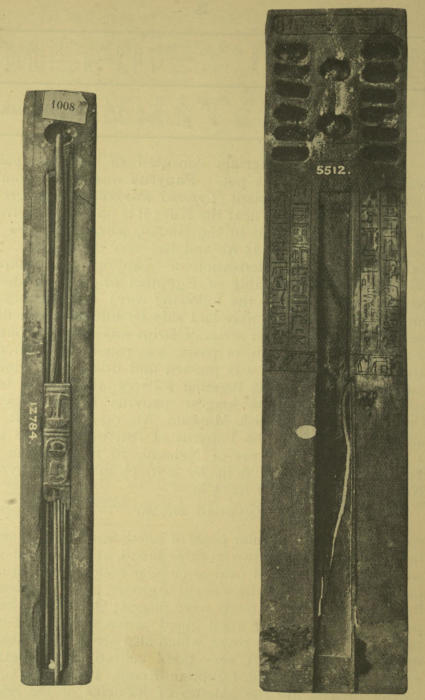
Wooden palette inscribed with the name of Ȧāḥmes I, B.C. 1600.
[No. 2, Table-case C, Third Egyptian Room.]
Wooden palette of Rāmeri, an official of Thothmes IV, B.C. 1470.
[No. 3, Table-case C, Third Egyptian Room.]
The palette, in Egyptian mesthȧ 𓐝𓊃𓍘𓇋𓆱, usually consisted of a rectangular piece of wood, from eight to sixteen inches long, and from two to three broad, at one end of which were sunk a number of oval or circular hollows to hold ink or paint. Down the middle was cut a groove, sloping at one end, in which the writing reeds were placed; these were kept in position by a piece of wood glued across the middle of the palette, or by a sliding cover, which also served to protect the reeds from injury. A very good collection of palettes is exhibited in the Third Egyptian Room, Table-case C. Of special interest are the palettes of Ba-nefer, of the reign of[55] Pepi II, B.C. 3200 (No. 12,782); the palette of Ȧāḥmes I, the first king of the XVIIIth dynasty, about B.C. 1600 (No. 12,784); the palette of the scribe Pa-mer-ȧḥau, who lived in the reign of Ȧmen-ḥetep III, about B.C. 1450 (No. 5513); and the palettes of Ȧmen-mes (No. 12,778) and a scribe (No. 5514), who lived in the reign of Seti I and Rameses II respectively. The hollows for the ink, or paint, generally black and red, are usually two in number, but some palettes have a dozen. The inscriptions on palettes usually contain prayers to the great gods of the Other World for sepulchral offerings; but sometimes they are dedications to the god Teḥuti, or Thoth 𓅝𓏏𓏭𓀭, to whom the invention of the art of writing is attributed. The writing reed, in Egyptian qesh 𓈎𓈚𓌟𓆭, which served as a pen, was about 10 inches long, and from ⅟₁₆th to ⅛th of an inch in diameter; the end used for writing was bruised and not cut. After the XXVIth dynasty, an ordinary reed, similar to that used in the East at the present day, was employed, and the end was cut like a quill, or steel pen. The ordinary palette will hold about ten writing reeds easily. The ink was made of mineral or vegetable substances mixed with gum and water. The earths, or ochres, or preparations of copper, were rubbed down on slabs with little mullers, several of which may be seen in the Third Egyptian Room, Table-case C. The ink-pot was called pes 𓊪𓊃𓎺, and was usually made of faïence or porcelain. The hieroglyph 𓏟 represents the palette, an ink pot, and a reed, united by a cord; the whole stands for “scribe” and “writing.”
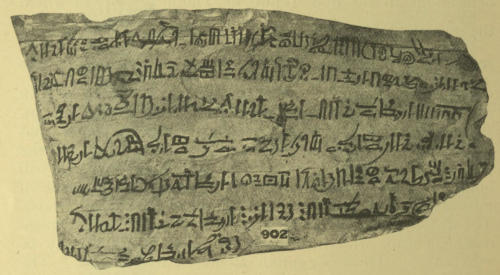
Slab of limestone inscribed with a draft of a deed. Dated in the reign of Ḥeru-em-ḥeb, about B.C. 1400.
[No. 22, Table-case C, Third Egyptian Room.]
Besides papyrus, scribes frequently used slices of white limestone of a fine texture, or boards plastered with lime, for writing purposes. On these they wrote drafts of literary compositions, hymns, school exercises, and sketches in outline of the figures of kings, gods, etc., made to scale. As examples may be mentioned No. 22, inscribed with the draft of a legal document which was drawn up in connection with a robbery of weapons from the Royal Arsenal by the Chief of the Treasury, about B.C. 1100, and No. 41, inscribed in the hieratic character with a draft of a part of a famous work called the “Instructions of Ȧmen-em-ḥāt I,” king of Egypt, about B.C. 2500 (Third Egyptian Room, Table-case C). In the Ptolemaïc Period pieces of broken earthenware vessels, or potsherds,[56] commonly known as ostraka, were much used for writing purposes. The inscriptions on these are chiefly of a business character, receipts or acquittances, etc.; but certain of them contain extracts from literary works, e.g., a school exercise consisting of lines 105-117 and 128-139 of the Phoenissae of Euripides (No. 88, Third Egyptian Room, Table-case C). After the introduction of Christianity into Egypt, the Copts, or Christian Egyptians, imitated their pagan ancestors, and wrote letters, lists of objects, prayers, extracts from the Scriptures, etc., on slices of white limestone. A fine collection of such Coptic inscriptions is exhibited in the Fourth Egyptian Room, Table-case M; and of special interest are: No. 3. Liturgical fragment. No. 5. An undertaking by Abraham to take charge of a camel. No. 8. Religious exercise, Coptic and Greek hymns. No. 17. Extract from Psalm xcviii, “Sing unto the Lord a new Song,” etc. No. 19. Part of the Alexandrian Canon of the Mass, written in corrupt Greek by Apa Eiḥannes. No. 20. Fragment containing part of a Greek hymn and a letter in Coptic, conveying the salutations of Dioskoros to his brother Ounaref and his mother Tnouba. No. 26. Letter from the priest Victor and Matthaios, to Germanos and Isak (Isaac), authorizing them to sow their share of a field, and specifying the rent. No. 28. Document referring to the sale of a camel. It is dated on the second of the month Pashans, and witnessed by three persons:—Dioskle and[57] Ouanafre[11] of Pallas, and Gergorios of Remmosh. No. 41. Part of a letter requesting some monks to bless the writers, and to send holy water to them that they might sprinkle their sick beasts with it. No. 53. List of measurements of land, in which Greek arithmetical signs, etc., are employed. No. 57. Receipt for a ḥolokotinos (solidus) paid as tax or rent by Zaêl for the “camels’ field” for the ninth year. No. 60. School exercise in Greek and Coptic grammar; on the obverse is a portion of a letter addressed to the authorities of a monastery. No. 61. Reading exercise. No. 62. Fragment of a school exercise, with rough drawings of animals. No. 65. Acquittance of Mizael Konstantinos for the first instalment of taxes for the year, signed by Severus. No. 66. Writing exercise for the formation of letters. The Copts sometimes covered the outside of an unbroken jar with lists, etc., e.g., the amphora, No. 166F, Fourth Egyptian Room, Wall-case No. 163. On this are written six lists of names of men, with those of their fathers and mothers, and it is probable that the inscriptions were written not later than the eighth century.
Egyptian Literature.—The literature of Ancient Egypt, written in the hieroglyphic, hieratic, and demotic characters, is large, and the contents of the principal divisions of it may be thus summarized:—
Religious literature: first and foremost is the great compilation of texts, partly magical and partly religious, to which was given the name “Per-em-hru,” i.e., the “Book of Coming Forth by Day,” or, as it is now generally called, the Book of the Dead. This work is extant in three great Recensions, viz., the Heliopolitan, Theban, and Saïte. The Heliopolitan Recension consists of a series of formulas of a semi-magical character, written in hieroglyphics, which were collected by the priests of Ȧn, or Heliopolis, about B.C. 3300. A large number of these formulas were in existence long before this period. The oldest copies of texts of this Recension are found in the Pyramids of kings Unȧs, Tetȧ, Pepi I, Meḥti-em-sa-f, and Pepi II at Ṣaḳḳârah, but series of the formulas from it were copied on coffins and sarcophagi down to about B.C. 200. Among such is the coffin of Āmamu in the British Museum (First Egyptian Room, No. 6654). On this magnificent coffin are written some hundreds of lines of text in black ink, and a list of canonical offerings, according to the Liturgy of Funerary Offerings, is appended. The coffin itself was intended to represent the chamber of a maṣṭaba tomb, and on the inside are painted pictures of doors and panels, similar to those which are found in the tombs about B.C. 3500. It is one of the finest of its class, and it was probably made before the XIth dynasty (B.C. 2600). In connection with this must be mentioned the portion of a wooden coffin of Menthuḥetep, a king of the XIth dynasty, on which is inscribed a version of a part of the XVIIth Chapter of the Book of the Dead (Second Egyptian Room, Wall-cases 86-88).
The Theban Recension was generally written upon papyri in hieroglyphics, and was divided into sections, or chapters, each of which had its distinct title, but no definite place in the series. It was much used during the XVIIIth, XIXth, and XXth dynasties. In the first half of the XVIIIth dynasty the custom grew up of adding vignettes to certain chapters of this Recension, and before another century had passed so[59] many coloured illustrations were added to the papyri that frequently chapters had to be abbreviated, and the scribes were obliged to omit some of them altogether. This Recension contained about 180 chapters, but no extant papyrus contains them all. The chapters represent the theological opinions of the colleges of On (Memphis), Herakleopolis, Abydos, and Thebes, and are of the first importance for the study of the Egyptian Religion. In the Rubric to the LXIVth Chapter are mentioned two traditions which are very valuable for the history of the Recension. In the one it is stated that the chapter was “found” in the reign of Semti, a king of the Ist dynasty, and in the other that it was “found” in the reign of Menkaurā (Mycerinus), a king of the IVth dynasty, by Ḥeru-ṭāṭā-f, a prince, the son of King Khufu, or Cheops. Thus it is certain that in the XVIIIth dynasty it was believed that the chapter was in existence in the earliest dynasties. Now we find from the Papyrus of Nu that there were two forms of this chapter extant, and that one of these was twice as long as the other. The longer one is entitled “Chapter of Coming Forth by Day,” and the shorter, “Chapter of Knowing the ‘Chapters of Coming Forth by Day’ in a Single Chapter.” The rubric to the latter attributes the chapter to the Ist dynasty, and thus it seems that even at this remote period the “Chapters of Coming Forth by Day” were widely known, and that the priests found it necessary to produce for general use a chapter which contained the essence of them all.
The British Museum possesses the finest collection in the world of papyri containing the Theban Recension, and of these may be specially mentioned: The Papyrus of Nebseni,[12] with vignettes in black outline (No. 9900); the Papyrus of Ani, a magnificently coloured papyrus containing texts and vignettes not found elsewhere[13] (No. 10,470); the Papyrus of Nu, with coloured vignettes, rubrics, etc., containing a good text throughout, and a large number of chapters not found elsewhere[14] (No. 10,477); the Papyrus of Hu-nefer, a scribe who flourished in the reign of Seti I, with a fine series of brilliantly painted vignettes[14] (No. 9901); and the Papyrus of Mut-ḥetep, most valuable because it contains correct copies of early texts (No. 10,010).
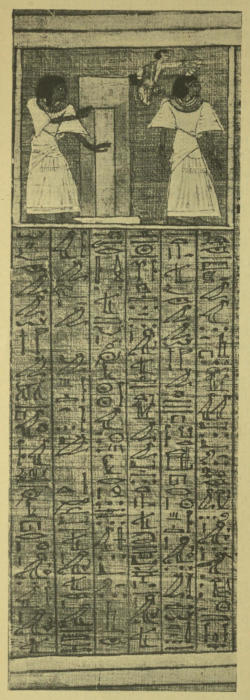
Vignette and text of the Theban Book of the Dead from the Papyrus of Ani.
XVIIIth dynasty.
[Brit. Mus., No. 10,470.]
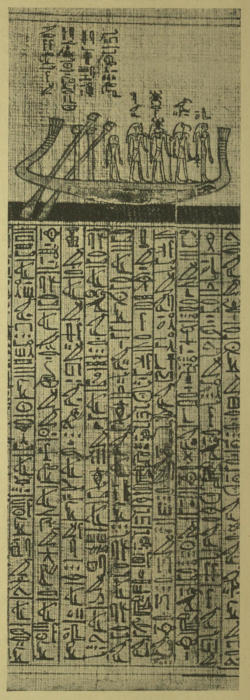
Vignette and text of the Theban Book of the Dead from the Papyrus of Nu.
XVIIIth dynasty.
[Brit. Mus., No. 10,477.]

Plate I.
Ḥer-Ḥeru, the first priest-king, and Queen Netchemet standing in the Hall of Osiris and praying to the god whilst the heart of the Queen is being weighed in the Balance.
XXIst dynasty, about B.C. 1050.
[Southern Egyptian Gallery, No. 758.]
Presented by His Majesty the King, 1903.

Vignette and Chapter of the Book of the Dead written in hieratic for Ḥeru-em-ḥeb.
XXVIth dynasty, or later.
[Brit. Mus., No. 10,257.]
Out of the Theban Recension grew another Recension, to which no special name has been given. It was written on papyrus both in hieroglyphics and hieratic, and its Chapters have no fixed order. It came into existence in the XXth dynasty, probably under the growing influence of the priests of Ȧmen. Fine examples of the papyri of this Recension are the Papyrus of Queen Netchemet (see Plate I), the wife of Ḥer-Ḥeru, the first high priest-king of the XXIst dynasty (exhibited in the Southern Egyptian Gallery), and the Papyrus of Ȧnhai, a priestess of Ȧmen.[15] In the latter an entirely new style of decoration is employed, and gold is used in decorating the disk of Rā Harmachis for the first time.
Of the history of the Book of the Dead between B.C. 1000 and 650 little is known. Under the influence of the great renaissance, which took place in the XXVIth dynasty, another Recension came into use, called the Saïte. In this the chapters had a fixed order, many new ones being inserted. The text was written both in hieroglyphics and hieratic, and it was decorated with a series of vignettes, in which all the figures were drawn in black outline. The appearance of papyri of this Recension is monotonous and dull, and both the drawings and the hieroglyphics[62] are stiff and spiritless. Good examples of papyri of this Recension are the Papyrus of Ḥeru-em-ḥeb, written in hieratic (No. 10,257), and the Papyrus of Ḥeru, written in hieroglyphics (No. 10,479). The vignettes usually occupy small spaces at the top of the columns of text. The Recension in use in the Ptolemaïc Period was the Saïte, but before the Roman Period it was customary to write other and newer funerary works on papyri, and little by little the Book of the Dead, as a whole, became obsolete. It seems as if an attempt was made to extract from the old work the texts which were regarded as absolutely necessary for salvation, and as if the older mythology was unknown to the Egyptians of the period. It is quite certain that many of the scribes copied texts without understanding them, and that the meanings of many vignettes were lost.
About the beginning of the Ptolemaïc Period the following works came into general use: 1. The Shāit en Sensen 𓈚𓂝𓇌𓏏𓏤𓍼𓈖𓊃𓈖𓊃𓈖𓊡𓏪, or Book of Breathings. Like the great Book of the Dead, this work was declared to have been written by Thoth, the scribe of the gods, the “Heart of Rā.” It contains a number of prayers for offerings, a series of declarations that the deceased has not committed certain specified sins, a statement that he has neither sin nor evil in him, and a demand that his soul be admitted into the heaven because “he gave food to the hungry, water to the thirsty, clothes to the naked, and offerings to the Gods, and to the Khu (beatified spirits).” A fine copy of this work is that written in the hieratic character for Kerasher on a papyrus in the British Museum (No. 9995). In the first part are copies of vignettes from the Book of the Dead, but the details are modified to suit the religious beliefs of the period. Thus Thoth and not Horus introduces the deceased to Osiris, and Anubis and Hathor lead him into the Judgment Hall instead of Maāt.
2. The Lamentations of Isis and Nephthys, a work in which these goddesses lamented the sufferings and death of Osiris, and proclaimed his resurrection, and glorified him in the heavens. It was recited by two priestesses, who were ceremonially pure, on the 25th day of the month Choiak (December), and the words in the book were believed to be those which Isis and Nephthys actually said at their first mourning for their brother Osiris. Copies of them were written on papyrus and buried with the dead to ensure their resurrection and future happiness and glory.
3. The Festival Songs of the Two Tcherti, i.e., of the Two Weepers, Isis and Nephthys, a work similar in character to the preceding. It was recited on five days of the month Choiak (December), during which the great annual festival of Osiris was celebrated. The priestesses who sang the verses of the work wore lambs’-wool crowns on their heads, carried tambourines which they beat from time to time, and bore on their arms bandlets with the names of Isis and Nephthys written upon them. The recital of the work was preceded by an address by the Kher ḥeb, or “Lector,” and then the two priestesses sang the rhythmic sections of the compositions alternately.
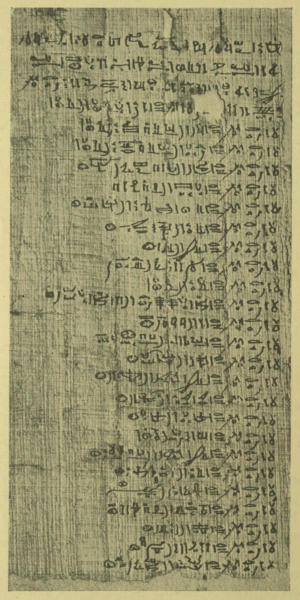
A copy of a Book of the Dead entitled “May my name flourish!”
Roman Period.
[Brit. Mus., No. 10,304.]
4. The Litanies of Seker, a short composition of about 100 lines, containing two series of addresses to Seker, the god of the Other World. Fine copies of this and the preceding work are given in the Rhind Papyrus (No. 10,188).
5. The Book of traversing Eternity (Shāti en sebebi ḥeḥ 𓏛𓏏𓏭𓏤𓍼𓅂𓈖𓊃𓃀𓃀𓏭𓂻𓎛𓎛𓇳), a work in which the happiness of the blessed dead is described, and an account given of a journey through the Other World by the deceased, who visits the shrines of the gods, and takes part in the services of praise which are performed there by the spirits and souls,[64] of the righteous, and enjoys the offerings which are made to them by the faithful on earth (Papyrus No. 29, at Vienna).
6. The Book of May my Name Flourish,[16] a work which was very popular in the Roman Period. It is, in reality, a development of a long prayer which is found in the Pyramid Texts of the VIth dynasty. Its object was to make the name of the deceased permanent in heaven and on earth, for it was a common belief, from the earliest to the latest times, that the man whose name was blotted out had no portion or existence in the other world. A nameless soul possessed no identity, and could not be introduced to Rā and the company of the gods. The British Museum possesses several copies of this work, written generally on narrow strips of papyrus, in a kind of hieratic, containing many demotic characters. (Nos. 10,108, 10,111, 10,112, 10,109, etc.)
7. Another work which obtained some popularity in the late period is the so-called Ritual of Embalmment. In this composition is given a large number of the formulas that were recited over the unguents, spices, and swathings during the process of embalming the body.

The ceremonies of “Opening the Mouth.”
8. In all periods the burial of the dead was accompanied by the presentation of series of offerings. Up to the end of the Vth dynasty a comparatively small number of names of offerings was inscribed on the walls of the tombs, and in the presentation of such offerings consisted the ceremony of Opening the Mouth of the dead. Under the VIth dynasty a new and enlarged list of offerings was drawn up, and a series of formulas was added to it for recital by the priest as object after object was presented to the mummy. In many of these formulas there were plays of words upon the names of the offerings, each of which was symbolical of some divine being, or object, or act. Several new ceremonies connected[65] with the purification and censing of the mummy, and the use of instruments in “opening the mouth and eyes” of the mummy were introduced at this time. To this List of Offerings, with its rubrics, the name of Liturgy of Funerary Offerings may be given. Under the XVIIIth dynasty a further development of the List of Offerings took place, and new ceremonies were added, and the work was henceforth known as the Book of Opening the Mouth. The visitor will see on the west wall of the Second Egyptian Room a large coloured drawing in which the performance of ceremonies connected with the opening of the mouth is represented. One priest is supposed to be touching the mouth of the mummy with the Ur-ḥeka instrument, and is holding other instruments; the other priest is presenting vases of water. Behind them is the Kher ḥeb, or Lector, who is pouring out water from a libation vase and burning incense. The object of the Book of Opening the Mouth was: 1. To give the deceased a new body in the Other World, and to make him to be divine. 2. To establish communion between the living and the dead. In later days a statue of the deceased took the place of his mummy in the ceremonies, and then the chief object of the ceremonies, formulas, and offerings, was to provide a dwelling place for the Ka or “double” of the deceased, and to make his soul to take up its abode in the statue. The Book of Opening the Mouth was in general use from the Vth dynasty to the first or second century of our era, that is, for a period of 4,000 years, and copies of it made in the Roman Period are almost identical with those found in the Pyramids of Ṣaḳḳârah of the VIth dynasty.
9. An important section of the Religious Literature of Egypt is formed by works which were intended to be used as Guides to the Other World. The oldest of these is a work in which pictures are given of portions of Restau, in the kingdom of the god Seker, and of several parts of the Sekhet-ḥetep, or Elysian Fields, and their positions in respect of the celestial Nile are shown. The descriptions of these places and the formulas which were to be recited by the deceased are written in hieratic, and these were to be learned by men on earth so that their souls might recognize the various regions as they came to them, and repeat the sacred words at the right moments. This “Guide” may be called the Book of enabling a man to travel over the ways of the Other World, but recent writers have named it the Book of the Two Ways. The finest and fullest copies of the work,[66] with illustrations in full colour, are found in the coffins of Ḳua-ṭep and Sen, or Senȧ, the “chief physician,” in the British Museum (Nos. 30,841, 30,839).
A second work of this kind is the Book of what is in the Ṭuat, or Other World, or Shāt ȧm Ṭuat, 𓏛𓏤𓏏𓍼𓇋𓏶𓅓𓇼𓏏𓉐. In this the Other World is divided into Twelve Sections corresponding to the Twelve Hours of the Night, and pictures are given of the various gods, demons, and fiends who were supposed to obstruct the way of those who were passing from this world to the kingdoms of Osiris and Rā. The texts contain the speeches of the Sun-god of night, called Ȧfu-Rā, and describe the conditions of the beatified, or the damned, in each section, and give the names of the principal gods. The work is very lengthy, and complete copies of it must have been cumbrous, as well as costly. The priests therefore prepared a Summary of the Book of Ȧm-Ṭuat, which was supposed to contain all that was absolutely essential for the soul to know that had to travel from this world to the next. The most complete copy of the larger work is given on the walls of the chambers in the tomb of Seti I, at Thebes, but one half of it is cut on the outside of the magnificent sarcophagus of Nekht-Ḥeru-ḥebt, king of Egypt about B.C. 378 (Southern Egyptian Gallery, No. 923). (See Plate II.) Of portions of the “Summary” there are several copies in the British Museum, both with and without illustrations (Nos. 9975, 9979, 9981-9985, etc.). The pictures of this work were believed to be endowed with the same magical powers as the texts.
In the Book of Gates, a somewhat similar work, the road from earth to heaven is marked by a series of Gates through which the deceased hoped to pass. The texts, which are fully illustrated, describe the progress of the Boat of the Sun-god to the Kingdom of Osiris, the Judgment in the Hall of Osiris, the life of the beatified in the Elysian Fields, and the punishment of the wicked and of the foes of the Sun-god by dismemberment and burning. Following these comes a set of magical texts and pictures which describe and illustrate the ceremonies which were performed daily to make the sun to rise. They show that the Egyptians used to make a model of the sun, and place it in a boat, and then bring to it arrows to represent rays, and disks to represent the hours; fire was next kindled with the fire-stick and applied to the model, and appropriate formulas having been recited, the body of the sun was believed to be reconstituted.
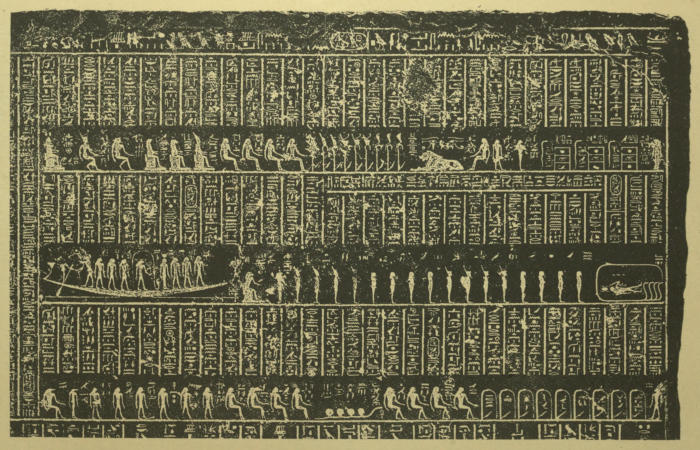
Plate II.
Scenes and texts from the Sixth Section of the Book of What is in the Other World. From the sarcophagus of King Nekht-Ḥeru-ḥebt, B.C. 378.
[Southern Egyptian Gallery, Bay 25, No. 923.]
10. As an example of Rituals may be mentioned the famous Daily Ritual of the Divine Cult, the texts of which were inscribed upon papyrus and cut on the walls of temples, e.g., Abydos. From this we learn that the king was supposed to perform daily a series of elaborate ceremonies in connection with the statue of Ȧmen, and to present to it unguents, wine, incense, articles of sacred apparel, etc. By means of these he entered into communion with the god, who bestowed upon him his vital power, strength, and spiritual qualities.
11. Hymnology is well represented by the hymns to the gods Rā, Rā-Harmachis, Temu and Osiris, which are found in the great Papyrus of Ani in the British Museum (No. 10,470), and by the fine Hymn to the Nile, of which two copies are preserved in the British Museum (Sallier II, No. 10,182, and Anastasi VII, No. 10,222). Of somewhat different character, though equally interesting, are the Hymns to Ȧmen contained in the Anastasi Papyrus II (No. 10,243). Under this head may be grouped the Litany of Osiris in the Papyrus of Ani, and the Addresses of Horus to his father Osiris in the Papyrus of Nebseni (No. 9900).
12. Service books are represented by the Book of Overthrowing Āpepi, a work which contains a series of spells and incantations that were recited in the great temple of Ȧmen-Rā at Karnak (Thebes) on certain days of the month. These were directed against Āpepi, the great foe of the Sun-god, and enemy of all goodness and truth, who took the form of a monster serpent, and waged war against all the gods daily. The rubrics contained directions for ceremonies, in which wax-figures were burned in the temple fires, whilst the priests recited the spells in the Book. There is a complete copy of the work in the British Museum (No. 10,188), which also contains a list of the accursed names of Āpepi, and the text of the hymn of praise which was sung when the arch-fiend was overthrown.
13. Exegesis is represented by two valuable copies of a work which forms the XVIIth Chapter of the Book of the Dead in the Papyrus of Ani (No. 10,470), and the Papyrus of Nebseni (No. 9900). In it a text treating of the origin of the gods and their relation to Rā, and of the doctrine of the union of Rā and Osiris, etc., is dissected, and each sentence of the work is followed by a statement of the opinions of the various great religious Colleges of Egypt.
14. An example of a rare class of work is found cut on a black stone slab in the Southern Egyptian Gallery (No. 797). The text states that it was copied from an inscribed board[68] which had become worm-eaten in the reign of Shabaka, king of Egypt, about B.C. 700. From what is legible on the slab we are justified in assuming that the work contained a sort of philosophical statement of the religious beliefs of a priest who was trying to systematize certain of the old traditions of the country, and to evolve a system of belief which should be consonant with the special traditions current at Memphis at that time concerning the god Ptaḥ.
15. Another most important section of religious literature consists of the funerary inscriptions cut on sepulchral tablets, or grave-stones, which form so large a portion of the Egyptian collections of the British Museum. In the vestibule and galleries is exhibited a splendid series of such monuments, the oldest dating from the IVth dynasty, about B.C. 3800, and the most recent from the first century A.D.; thus the series represents a period of about four thousand years. The value of these monuments is very great, for they not only give the various forms of the prayer to the gods for sepulchral offerings in the different periods of Egyptian history, but they afford a great deal of information about the attributes of the gods, and they illustrate the growth and decay of many forms of belief, details of ritual, etc. On Plates III-VIII are reproduced good typical examples of sepulchral tablets of the IVth, XIth, XIIth, XVIIIth, XIXth, and XXXth dynasties.
The number of the religious works of the Egyptians was very large, and in each great temple a small chamber was set apart as a library; here the papyrus rolls, or books, were kept in boxes, and, in some cases, the names of the works were inscribed on the walls of the chamber. The number of the rolls in a temple library seems to have been comparatively small, for the list of books which is cut on the wall of the “House of Books,” of the temple of Edfû, only contains the names of thirty-seven works.
Profane Literature.—Among works of a didactic and moral character may be mentioned the Precepts of Kaqemna and the Precepts of Ptaḥ-ḥetep. The first of these contains a short series of admonitions as to general behaviour, which were written towards the end of the IIIrd dynasty, about B.C. 3900, and the second a group of aphorisms of high moral worth, by a high official who flourished in the reign of Ȧssȧ, a king of the Vth dynasty, about B.C. 3360. A late copy of the latter work is preserved in the British Museum. Other works of this class are The Instructions of Ȧmen-em-ḥāt I, a complete copy of which is given in the First Sallier Papyrus (No. 10,185), and the Maxims of Ani, preserved in the Egyptian Museum in Cairo. The latter work inculcates the highest standard of practical morality, and contains a lofty idea of the duty of the Egyptian to his god and his neighbour; many of the counsels embody shrewd common sense and experience, and are similar to portions of the Book of Proverbs and the Book of Ecclesiasticus. The language in which the maxims are written is sometimes very difficult, for many of them are in the form of short, pithy proverbs.
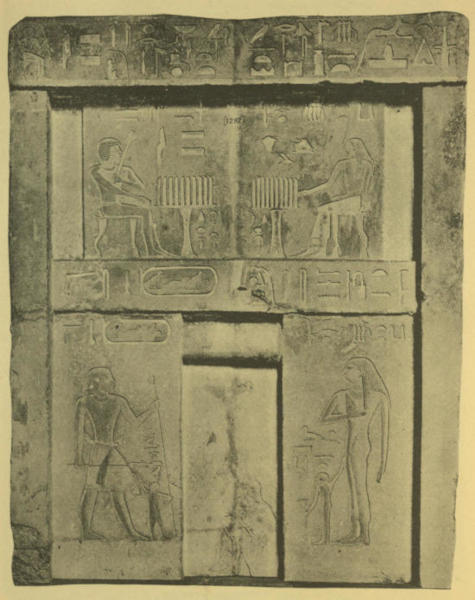
Plate III.
False door from the tomb of Sheshȧ, a royal scribe, who flourished in the reign of Khufu (Cheops), about B.C. 3700.
[Vestibule, North Wall, No. 18.]
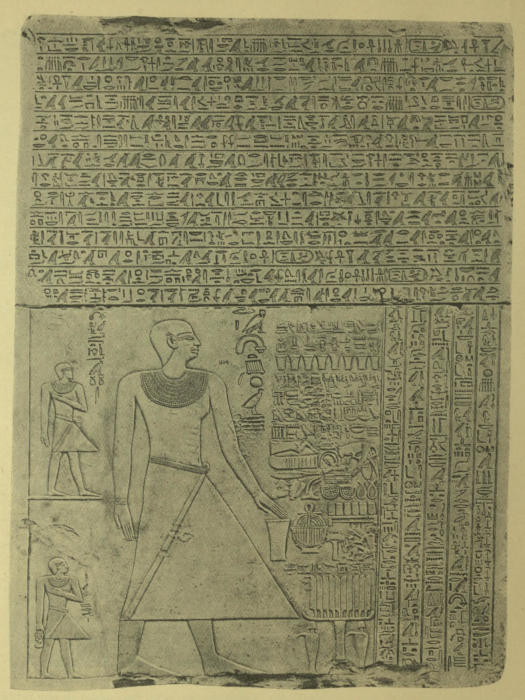
Plate IV.
Sepulchral tablet of Thethȧ, an official who flourished in the reign of Ȧntef-uaḥ-ānkh, a king of the XIth dynasty, B.C. 2600.
[Northern Egyptian Gallery, Bay 4, No. 100.]
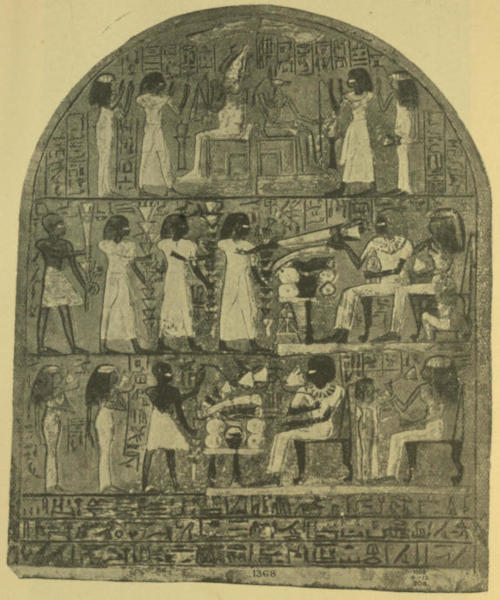
Plate V.
Painted sepulchral tablet of Sebek-ḥetep, scribe of the wine-cellar.
XVIIIth dynasty.
[Northern Egyptian Gallery, Bay 12, No. 513.]

Plate VI.
Sepulchral tablet of Pai-neḥsi, the overseer of the storehouse of gold from the Sûdân.
XIIth dynasty.
[Southern Egyptian Gallery, Bay 7, No. 299.]
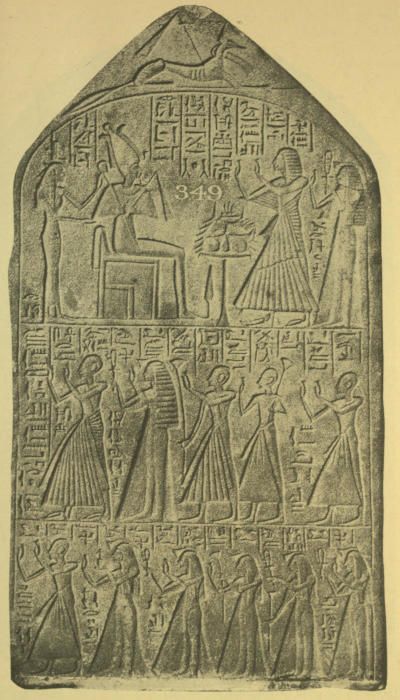
Plate VII.
Sepulchral tablet of Bak-en-Ȧmen, a scribe of the table and wine-cellar.
XIXth or XXth dynasty.
[Southern Egyptian Gallery, Bay 22, No. 751.]
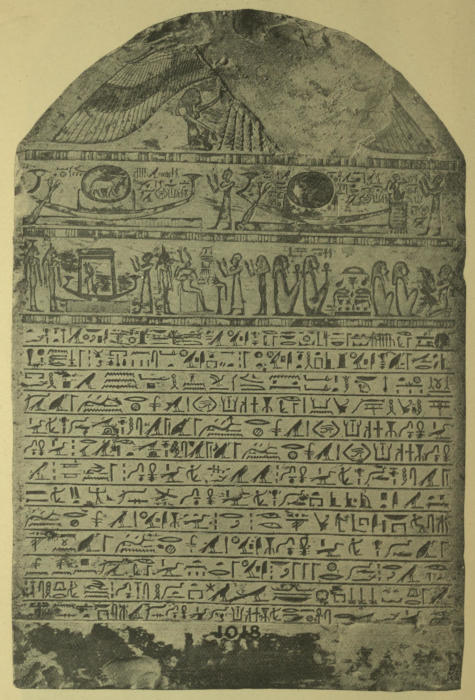
Plate VIII.
Sepulchral tablet of Nes-Ḥeru, a priest.
About B.C. 350.
[Southern Egyptian Gallery, Bay 26, No. 941.]
A work of a somewhat similar character is the very interesting set of “Instructions” given by a high official to his son Pepi, which we know from the Second Sallier Papyrus and the Seventh Anastasi Papyrus in the British Museum (Nos. 10,182, 10,222). The writer entreats his son to adopt the profession of letters, which he points out leads to rich emoluments, ease, comfort, and dignity, and he begs him to “love letters as thy mother.” He then compares the toil and unpleasantness of the life of the blacksmith, carpenter, stone-cutter, barber, waterman, fisherman, farm-labourer, gardener, fish-seller, sandal-maker, laundryman, etc., and urges him to devote himself to his books. This work is commonly known as the Hymn in Praise of Learning; it was very popular in schools under the XIXth and following dynasties, and portions of it, written on slices of limestone, were set as “copies” for school-boys.
The Egyptians greatly loved works of Fiction and Travel, and the copies of such which have come down to us show that they were full of marvellous incidents, and that they greatly resembled some of the sections of the “Arabian Nights” of a later period. The Tale of the Two Brothers, in the British Museum (No. 10,183), is one of the best examples of Egyptian Fiction. In the first part of the story we have a faithful description of the life of the peasant farmer in Egypt. Ȧnpu, the elder brother, lives with his wife on a small farm, and Batau, his younger brother, acts as his companion, steward, and servant. The wife of Ȧnpu conceived great affection for Batau. One day, when he returned to the farm on an errand, she told him of her love; Batau rejected her overtures, left the house, and went about his ordinary work in the fields. When Ȧnpu returned to his house in the evening, he found the rooms in darkness, and, going inside, he discovered his wife lying sick upon the floor and in a state which suggested she had been ill-treated and beaten. In answer to his questions she told him that Batau had attacked her and beaten her, and that she was sure when he next came back to the farm he would kill her; she did not tell him that she had made herself sick by eating rancid[70] grease, and Ȧnpu did not suspect her untruth. Ȧnpu then took a large grass-cutting knife and went out to kill his brother when he arrived. As Batau came to the byre to lead his cattle into their stalls, the oxen told him that his brother was waiting behind the door to kill him; looking under the door he saw Ȧnpu’s feet, and then, setting his load on the ground, he fled from the barn as fast as he could, pursued by his brother. Whilst they were running, the Sun-god Shu looked on, and, seeing that Ȧnpu was gaining on Batau, caused a river full of crocodiles to spring up between them, so that Ȧnpu was on one bank and Batau was on the other. When Batau had explained the truth of the matter to Ȧnpu, he departed to the Valley of the Acacia, and the elder brother went home, murdered his wife, and threw her body to the dogs.
The second part of the story is not so easy to follow. Batau went to the Acacia Valley, and placed his heart on the top of the flower of a tree, and passed some years in hunting the wild animals of the desert. Whilst there the gods made for him a wife, who was, however, subsequently carried off to be the queen of Egypt. By her orders the tree on which was the heart of Batau was cut down, and the heart fell to the ground, where, after some time, it was found by Ȧnpu, who went in search of it. Batau having recovered his life, took the form of a bull, and, after a series of marvellous transformations, became the father of a king of Egypt. The papyrus containing this story was written by the scribe Anna, and it was one of the rolls in the library of Seti II Menephthah.
The Story of the Doomed Prince is another good example of Egyptian Fiction, though the unique copy in the British Museum (Harris, No. 500) is incomplete at the end. In the story of the Possessed Princess of Bekhten we have a short but interesting account of the driving out of a violent devil from the body of one of the sisters-in-law of the king of Egypt, by means of a statue of the god Khensu. The stele containing the text is in Paris. Travel is well represented by the Adventures of Sa-Nehat (papyrus at Berlin); the Story of a Shipwrecked Sailor, who was cast up on an enchanted island, and conversed with a serpent of fabulous length (papyrus at St. Petersburg); the Journey of Unu-Ȧmen, who went to Bêrût to buy cedar wood for the Boat of Ȧmen-Rā at Thebes, but was robbed on his way there, and shipwrecked on his way back, being cast up on the Island of Cyprus (papyrus at St. Petersburg); and the Travels of an Egyptian, in a[71] papyrus in the British Museum (No. 10,247). In the last work we have an account of the journey of an official who travelled in Syria and Palestine, and of the misfortunes which overtook him. He was robbed, his servants ran away, the pole of his chariot was smashed, and he suffered from heat by day, cold by night, and want of food and drink. For stealing fruit from a garden near the road he was haled before the local magistrate and fined heavily.
Stories of Magicians were as popular as books of travel, and of these may be mentioned the group contained in the Westcar Papyrus in Berlin. In one of them we are told of a famous magician who made a figure of a crocodile in wax which, when thrown into the river, became a huge, living crocodile, and devoured the man who had done the magician an injury. In another the magician cut off a goose’s head, and placed it in one part of the room, and the body of the bird in another; he then recited certain words of power, and the head and body approached each other little by little, and at length the head sprang up on the neck, and the goose cackled. In another story we are told how one of the maidens who was rowing the royal barge on a lake dropped one of her ornaments into the water. A magician having been brought, stood up and recited words of power, whereupon the half of the lake on which was the boat transferred itself above the other half, and remained there whilst the maiden stepped out of the boat and picked up her ornament which was seen lying on a shard. This done, the magician repeated words of power, and the water, which had been standing up like a wall, flowed back into its place.
Under the head of Science must be included the inscriptions which deal with Astronomy, and contain lists of the Planets, the thirty-six Dekans, the Signs of the Zodiac (see the coffin of Ḥeru-netch-tef-f, First Egyptian Room, No. 6678), etc.; Calendars (Papyrus No. 10,474); Geometry illustrated by the famous Rhind Papyrus in the British Museum (No. 10,057); Geography and Cartography, illustrated by the papyrus at Cairo in which the religious divisions of the Fayyûm are described, and by the famous map of the district of the gold mines preserved in the Museum of Turin; Chronology, as represented by the Turin Papyrus, which, when complete, contained the names of about 300 kings of Egypt, and the lengths of their reigns in years and months, or days. In connection with this branch may be mentioned the King List of Thunurei, found at Ṣaḳḳârah, and the King Lists of Seti I and Rameses II found at Abydos (Tablets of Abydos,[72] 1 and 2); the remains of the List made for Rameses II are preserved in the British Museum (Southern Egyptian Gallery, Bay 6, No. 592).
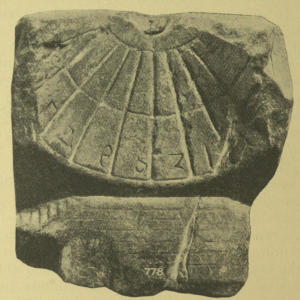
Marble Sundial.
Ptolemaïc Period.
[Southern Egyptian Gallery, Bay 29, No. 976.]
A number of valuable books dealing with Medicine have come down to us, and of these one of the most interesting is the papyrus in the British Museum, No. 10,059. It contains copies of a number of prescriptions which date from the reign of Khufu, the builder of the Great Pyramid, about B.C. 3730, and several of the time of Ȧmen-ḥetep III (B.C. 1450). The largest work on medicine is contained in the Ebers Papyrus at Leipzig, and there are medical papyri in the Museums of Paris, Leyden, Berlin, and California (Hearst Medical Papyrus). In all these we find that magic was considered to be as efficacious as drugs; many of the prescriptions are to all intents and purposes magical formulas, and several suggest charlatanism. Oil, honey, and tinctures or decoctions of simple herbs were largely used, and the long list of names of plants, herbs, seeds, etc., in the Ebers Papyrus proves that, though the Egyptians had little idea of scientific Botany, they had a very wide knowledge of the properties of plants, etc. Anatomy was studied in a practical manner, especially for the purposes of embalming and bone-setting, but as no treatises on the subject have come down to us, it is impossible to say[73] whether the Egyptians deserved the great reputations which they enjoyed as physicians. It is tolerably certain that they made no experiments in dissection, for the body was sacred to Osiris, and might not be dismembered, at all events in the later times. The commonest diseases among the Egyptians seem to have been ophthalmia, fever, maladies of the stomach, ulcers, “Nile boils,” epilepsy and anaemia.
Biographical inscriptions form a very important section of the Literature, and they throw much light, not only on the social condition of the people, but also on the history of the country. Thus, the inscription of the official Ptaḥ-shepses, who was born under the IVth dynasty, besides enumerating the various high offices which he held, proves that he lived through the reigns of eight or nine kings, and thus fixes the order of the succession of several of them (see Egyptian Vestibule, No. 32). The official Ȧntef lived under three kings, whose names he gives, and thus fixes the order of their succession (Bay 4, No. 99). (Plate XXII.) The stele[17] of Erṭā-Ȧntef-Ṭāṭāu says that the deceased was “Governor of the South” in the reign of Usertsen I, and thus we know that an Egyptian viceroy governed the Sûdân as early as B.C. 2433 (Bay 4, No. 196). The stele of Sa-Menthu describes how he went to the Sûdân to bring back gold for the king of Egypt, and tells us that he made men, women, and children to work in digging out the quartz, and in crushing the ore and washing the gold from it (Bay 6, No. 145). From the biographies of the great Egyptian officials much of the history of Egypt can be pieced together.
The Egyptians did not write history in the modern sense of the word. Some of the kings, e.g., Thothmes III, inscribed annals on the walls of their temples, and many others set up inscriptions to commemorate great events. Thus Usertsen III set up at Semnah in the sixteenth year of his reign a stele to mark the frontier of Egypt on the south, and to proclaim his conquest of the Northern Sûdân. Ȧmen-ḥetep III, B.C. 1450, set up a stele at Semnah to record his conquest of the country of Abhat, and the slaughter of a number of Blacks (Bay 6, No. 411). Rameses II caused copies of his account of his fight against the Kheta, or Hittites, to be cut on stelae, and set up in various places throughout the kingdom, e.g., at Amârah and Abû-Simbel. Some of the Nubian kings also[74] caused good detailed accounts of their wars to be cut upon stelae, which were set up in their capital, and in many cases these are the sole authorities for the history of the period. Thus Piānkhi (B.C. 740) gives a really fine account of his invasion and conquest of Egypt, even taking the trouble to describe the military operations connected with the siege of great cities like Memphis, his love for horses, and his devotions at Thebes and Heliopolis. Ḥeru-sa-ȧtef, another Nubian king, gives on his stele a careful summary of his expeditions to various parts of the Sûdân, and lists of the tribute which he received. Casts of both monuments are exhibited in the Southern Egyptian Gallery, Bay 18, No. 815, and Central Saloon, No. 793. The Stele of Nȧstasen (B.C. 525) at Berlin is another good example of this class of monument, and the text, which seems to mention Cambyses, is of great interest. Finally may be mentioned the stele of the Decree of Ptolemy I (B.C. 325), granting certain properties to the temple of Buto (see the Cast in Bay 28, No. 950). The finest general account of the reign of a king is that given by Rameses III (B.C. 1200) in the Harris Papyrus No. 1, in the British Museum (No. 9999); but even in this more care is devoted to the glorification of the king than to the facts of history. The inscription of Menephthah (B.C. 1250), which is cut on the back of a stele of Ȧmen-ḥetep III in the Egyptian Museum in Cairo, though containing useful historical indications and mentioning the name of the Israelites 𓇌𓊃𓏮𓂋𓇋𓄿𓂋𓏤𓌙𓀀𓁐𓏪 (line 27), cannot be regarded as a serious statement of fact, and must be classed with the panegyric written by the court scribe Penta-urt on the exploits of Rameses II.
The Historical Romances of the Egyptians are represented by the narrative of the Capture of the town of Joppa (Harris Papyrus, No. 500), and by the Dispute between Seqenen-Rā, King of Thebes, and Āpepi, King of Avaris (Sallier Papyrus, I, No. 10,185). Books of Magic are numerous, and of these may be mentioned Papyrus Salt, No. 825, and Harris Papyrus, No. 10,051. Several Mythological Legends are extant, viz., of the Resurrection of Osiris and the birth of Horus (on a stele in Paris); of the Creation of the World, Gods, and Men (British Museum Papyrus, No. 10,188); of the Wars of Ḥeru-Beḥuṭet, or Horus, the War-god of Edfû (on the temple of Edfû); of the Destruction of Mankind (in the tomb of Seti I); of how Unȧs killed and ate the Gods (in the Pyramid of Unȧs); of the Poisoning of Rā the Sun-god[75] (papyrus at Turin); of the Death of Horus by a scorpion’s sting, and his resurrection through Thoth (text on the Metternich Stele); and of the Wanderings of Isis, with her son Horus and the Seven Scorpion-goddesses, in the Delta (text on the Metternich Stele). The History of Osiris, and of his murder by Set, has not yet been found in Egyptian texts in a complete form, but there are frequent allusions to this history in the inscriptions of all periods, and it is clear that we have a tolerably accurate version of it in the narrative written by Plutarch (De Iside et Osiride).
Among the Legal Documents in the British Museum may be mentioned the papyri containing accounts of the prosecution of the robbers who broke into and plundered the royal tombs under the XXth dynasty (Papyri Abbott, Nos. 10,221 and 10,052), and the process against a man who was charged with stealing a quantity of silver (Nos. 10,053, 10,054). Songs and Poetry are represented by the Love Songs contained in the Harris Papyrus, No. 500; the Song of Ȧntuf, which was sung to the accompaniment of the harp (Harris Papyrus, No. 500); and the Song of the Harper, written on the wall of a tomb at Thebes, in which the hearers are enjoined to be happy, to anoint and scent themselves, and to rejoice with music and song, until the day cometh when they must depart to the land “which loveth silence.” The mutability of things, and the fleetingness of the world are also dwelt upon. The works enumerated in the above paragraphs are written in hieroglyphics and hieratic. The literature written in demotic is considerable, and it consists of books of magic, tales and stories, collections of moral aphorisms, legal documents, marriage contracts, etc.
Manners and Customs. Marriage. Polygamy. Honour paid to the Mother. The Child and its Name. Toys. Education. Dress. Food. Amusements. Dwelling Houses and Furniture. Agriculture and Cattle Breeding. Trade. Handicrafts.
Manners and Customs.—The views of the Egyptians about marriage closely resemble those held by many African tribes, for they married their sisters and nieces, and sometimes indulged in polygamy. It is probable that the views as to marriage which obtained generally in Egypt were less rigid than those of Western nations. According to an ancient legend Osiris married his sister Isis, who became by him the mother of Horus, and he was also the father of Anubis by his other sister Nephthys. Generally speaking, the Egyptian was the husband of one wife, who was the mistress of his house and the mother of his children, whether she was his sister, or his niece, or a stranger. Kings and noblemen married several wives, and became fathers of children by many of the women of their households. The Ptolemies, curiously enough, seeing that they were Greeks, married their sisters and nieces, like the Egyptians. Marriage in Egypt was, no doubt, arranged in the way common to the East, i.e., it was practically a business transaction, great care being taken to provide for the maintenance of the woman in the event of misbehaviour either on her part or that of her husband. Whether any religious ceremony was performed at the marriage is unknown. Girls were married before they were fourteen years of age. The legitimate wife of a man is called “Nebt pa,” 𓎟𓏏𓉐𓏤, i.e., “lady of the house,”[18] and she might of course, be “his beloved sister”; frequently, however, the latter title is a euphemism for “mistress,” or “concubine.” To divorce or eject the “lady of the house” was a very[77] difficult matter, and it was probably the fear of possible pecuniary complications which caused the Egyptian in so many cases to marry his sister or the woman whom he called by that name. Moreover, it was thus easier to keep the property in the husband’s family.
The legal wife was one of the freest women in the world. She went about the house, and outside it, at will, and, unlike the modern Egyptian women, she wore no veil. If she pleased, she held converse with men in the village or market, and she suffered from none of the restrictions which are placed upon women in the East in modern times. When the wife became a mother her power and influence were greatly increased, and the literature of ancient Egypt contains many passages which illustrate the honour and esteem in which the “mistress of the house” was held by her children, and on scores of stelae in the Egyptian Galleries the name of the mother of the deceased is given, whilst that of his father is not mentioned. The Egyptians, like many African tribes, traced their descent through their mothers, and the views which they held concerning the affection due to the wife from her husband, and the love which a son should give to his mother, are well illustrated by two passages. In the Precepts of Ptaḥ-ḥetep (B.C. 3200): “If thou wouldst be a wise man, rule thy house and love thy wife wholly and constantly. Feed her and clothe her, love her tenderly, and fulfil her desires as long as thou livest, for she is an estate which conferreth great reward upon her lord. Be not hard to her, for she will be more easily moved by persuasion than by force. Observe what she wisheth, and that on which her mind runneth; thereby shalt thou make her to stay in thy house. If thou resistest her will it is ruin.” In the Precepts of Khensu-ḥetep (B.C. 1500) we read: “When thou art grown up, and art married, and hast a house, never forget the pains which thou didst cost thy mother, nor the care which she bestowed upon thee. Never give her cause to complain of thee, lest she lift up her hands to God in heaven, and He hearken to her cry [and punish thee].”
The life of the woman in the lower classes was a hard one. She cooked the food for her husband and children, she wove the flax into linen, attended to all matters in the house, and usually managed to have a large family. She was a mother at the age of fifteen, or earlier, and a grandmother at thirty, by which time her body was bent, her forehead wrinkled, and her face withered. Among the upper classes the process of[78] physical deterioration was, of course, slower, but the results were the same.
Soon after a child was born a name was given to it, which usually had reference to some physical characteristic; thus a boy might be called “Nekht” 𓈖𓆱𓐍𓏏𓂡 “Strong,” and a girl “Nefert” 𓄤𓏏 “Beautiful,” or “Netchemet” 𓇛𓏏 “Sweet.” Pious folk introduced the name of some god or goddess into the child’s name, e.g., “Rā-ḥetep” 𓂋𓂝𓇳𓏤𓊵𓏏𓊪𓀀 “Rā is satisfied,” and loyal folk the name of the reigning king, e.g., “Pepi-nekht” 𓊪𓊪𓇌𓈖𓆱𓐍𓏏𓂡 “Pepi the strong one.” Several members of a family often bore the same name, but in these cases each was distinguished by some “little name” (i.e., pet-name). As a pet-name may be mentioned “Mȧi-sherȧui,” i.e., “Little Cat,” or “Pussy,” 𓏇𓇌𓈚𓂋𓇋𓏲𓏭𓅪𓁐. In well-to-do families a special day was set apart for naming a child and this name-day was usually celebrated with rejoicings.
For the first three years of its life a child was wholly in its mother’s care, and she carried it about on her back or left shoulder (see the ivory figure No. 41 in Table-case L in the Third Egyptian Room). For the next three or four years of its life it went about naked, whether boy or girl, gentle or simple; indeed a grandson of Khufu, the builder of the Great Pyramid, went to school unclothed. The heads of children were clean-shaven, with the exception of a lock of hair on the right side of the head. Little girls sometimes wore an amulet on their breast or body in order to avert the “evil eye,” and perhaps a cheap bracelet or necklace. They played with dolls, numerous examples of which have come down to us (see Standard-case C in the Fourth Egyptian Room). Like all children, Egyptian children loved toys of all kinds. As examples of these may be mentioned the cat with a movable lower jaw, the elephant and his rider, each having movable limbs, the negro being pursued by an animal, the ape drawing a chariot, the cat-headed dwarf, the lion killing its prey, the toy dog, hippopotamus, etc. The balls they played with were made of porcelain, papyrus, leather stuffed with chopped straw, etc. (See Standard-case C.)
Education.—It is doubtful if the children of peasants and of the lowest classes went to school, or received any education at all; both boys and girls were probably sent to herd the[79] geese, to drive the sheep and goats to pasture or to the canal or river to drink, to look after the cows, to collect fuel for the fire, etc. It is unlikely that girls or women generally were taught to read and to write, but little is known about this matter. The boys of the professional and upper classes undoubtedly received a certain amount of instruction, for learning was highly esteemed throughout Egypt; but speaking generally, the learning of the country was in the hands of the scribes. The profession of the scribe was one of great dignity and importance, and the highest offices in the land were open to him. The temples and certain offices of the Government maintained schools in which scribes were trained, and pupils were, of course, promoted according to their proficiency and ability. In the temple-schools boys were trained to copy religious texts both in the hieroglyphic and hieratic characters, and they studied religious literature, exegesis, the legends of the gods, funerary texts, etc. In the schools of the Government Departments the teaching was devised to suit the requirements of the Treasury, the Public Granaries, the Crown Lands’ Department, etc., and the pupils studied arithmetic, the keeping of accounts, geometry, mensuration, the writing of reports, etc. In all schools boys were taught to be clean, diligent, obedient, respectful and well-behaved. Lessons began early in the morning and lasted till noon, when, as a papyrus in the British Museum says: “the pupils left the school with cries of joy.” The daily allowance of food for a boy was three bread-cakes and two jugs of beer, which were brought to the school-house by his mother every day. Corporal punishment was administered freely, and the back of the lazy boy who would not get up early, and that of the inattentive boy, received many stripes; in one case a very bad boy was locked up for three whole months in a strong room in one of the temples.
School exercises were written on small whitewashed boards, slices of white limestone, and papyrus with a reed, and they usually consisted of extracts from ancient texts, religious or poetical, the contents of which were intended to improve the mind and form the morals and manners of the reader and copyist. (See Standard-case C in the Third Egyptian Room.) The education given in the colleges of the Priests was of a different character. There the young men studied magical and religious texts, several Books of the Dead, the doctrines of the cosmogony, and the histories and legends of the gods. They read the ancient writings with the priests whose duty it was to instruct them,[80] and learned by heart their expositions of the traditions accepted in the temples. One would expect the colleges to have possessed glossaries, or dictionaries, and grammars, but it is doubtful if they did, for nothing of the kind has hitherto been discovered. History in the modern sense of the word was unknown, though some of the great kings caused Annals of their reigns to be written; and recent excavations have shown that even the King Lists which were drawn up under the XVIIIth and XIXth dynasties are incomplete, and that they contain the names of some kings wrongly spelt. Astronomy was studied with some success by the priests, and the maps of stars which were compiled by them were undoubtedly used for practical purposes in connexion with the agriculture of the country.
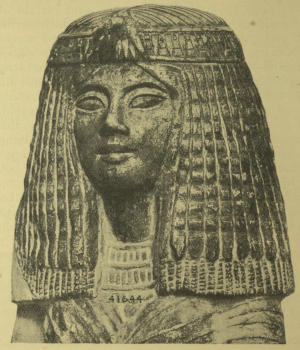
Head of a seated figure of a priestess wearing a full-plaited wig, bandlet, etc.
XVIIIth dynasty.
[Wall-case 103, Third Egyptian Room.]
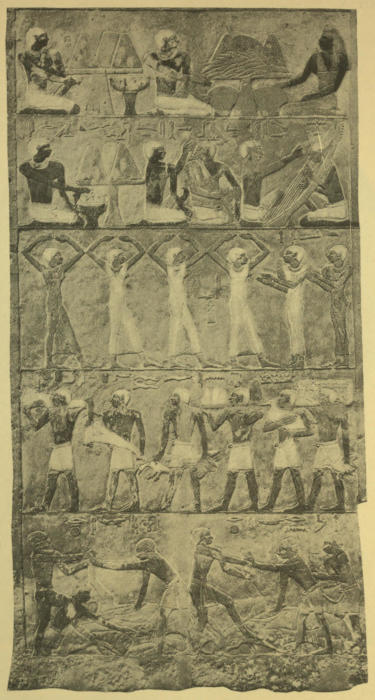
Plate IX.
Painted relief with scenes representing dancing, the slaughter of cattle, preparations for a feast, etc. From the tomb of Ur-ȧri-en-Ptaḥ.
VIth dynasty.
[Assyrian Basement, No. 80.]
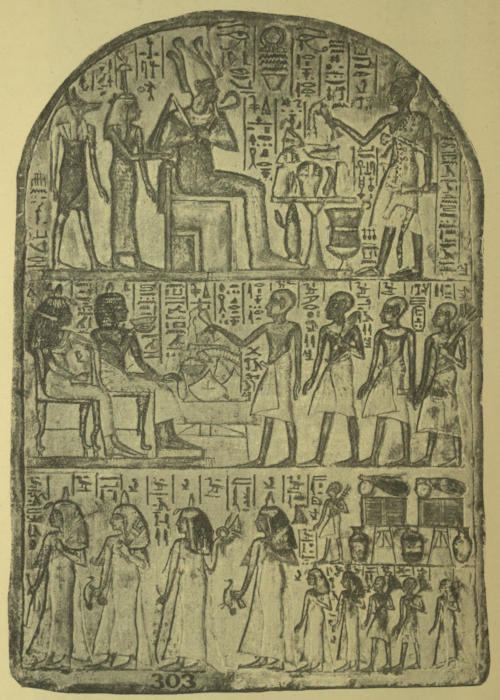
Plate X.
Painted sepulchral tablet of Kaḥu, a scribe of a storehouse of Ȧmen.
XVIIIth dynasty.
[Northern Egyptian Gallery, Bay 12, No. 514.]
Dress and ornaments.—The garments worn by the Egyptians were made of linen, for wool was regarded as[81] unclean. The earliest masculine garment was the loin-cloth, the primitive form of which was preserved for ceremonial purposes until a late period. Above it a girdle, or belt, was usually added, and to this a tail, either that of some animal, or an imitation made of leather, was fastened. The tail is worn by many African peoples to this day. As time went on and fashion changed the loin-cloth developed into a sort of skirt, which varied in length, fulness, and folds, or a short kilt projecting in a peak just above the knees. Later both men and women wore a sort of shirt, and over this a loose flowing garment which reached from the neck to the feet. The linen worn by women of the upper classes was of very fine texture, and in the luxurious period of the XVIIIth and XIXth dynasties their apparel was often very voluminous. The dress of men and women under the VIth dynasty is well illustrated by the scenes from a maṣṭaba tomb (see the Assyrian Saloon) reproduced on Plate IX, and under the XVIIIth dynasty by the figures on the stele of Kaḥu (Bay 12, No. 514) (Plate X). Both men and women wore wigs, which were sometimes very full and heavy, but women plaited their natural hair. Sandals were made of papyrus and palm-fibre, neatly woven or plaited, and sometimes of goat skin, or gazelle skin, well tanned and stained a pink colour. (See Table-case A in the Third Egyptian Room and Standard-case L in the Fourth Egyptian Room.) The “cone” was worn on the head by men and women, sometimes with a lotus flower or lily attached to it. According to some it contained a ball saturated with oil or pomade of some kind, which ran slowly into the hair, and so spread over the head and shoulders, causing pleasing sensations to him on whose head the ball was. The headdresses of the king and queen were very elaborate, whilst those of ordinary folk consisted of a bandlet, more or less decorated. Men of position always carried a staff or walking stick as a sign of authority, and those whom the king had honoured by the gift of a gold collar wore it on every important occasion. Both men and women wore rings, anklets, bracelets, armlets, necklaces, elaborately ornamented collars, pectorals, pendants, amulets, and earrings, just as they do in Egypt and the Sûdân at the present time. Egyptian women stained the nails of their fingers and toes a yellowish red with the juice of the ḥenna plant; they painted their faces with a sort of rouge, and their eyelids and eyebrows with a preparation of antimony (stibium, or koḥl), and they added under the eyes thick lines of paint to make them appear large and full. Both men and women sometimes decorated[82] their bodies with tattoo markings, which originally probably had a religious, or tribal, import. The burning winds and heat made the use of unguents an absolute necessity, and oils and pomades were very largely used in all periods. Strong scented woods and herbs were pounded and mixed with oil, and rubbed into the body, and scents were in ancient days, as now, in great demand. Often women carried a fan and a mirror. A fine collection of mirrors is exhibited in Wall-cases Nos. 182-187 in the Fourth Egyptian Room.
Food.—The food of the lower classes consisted chiefly of
bread and vegetables. The bread was made of a kind of
millet, like the modern dhurra, barley, and rarely of wheat.
The grains were rolled and crushed on a stone and then both
the flour and the bran were mixed with water into a stiff
paste; from this pieces were broken off and flattened out by
the hand into cakes of various degrees of thickness, which
were baked on hot stones, or in mud-lined ovens. (See the
examples in Table-case H in the Third Egyptian Room.)
Bread-cakes were made in a variety of shapes, e.g., 𓏏, 𓏙, 𓏐,
, 𓊔, , ![[glyph not in Unicode]](images/glyph09.jpg) , 𓏖, 𓏑, etc. Among vegetables may be
mentioned onions, cucumbers of various kinds, beans, peas,
lentils, radishes, pumpkins, water-melons, leeks, garlic,
roots of the turnip and carrot class, and vegetables belonging
to the class of the modern bâmia, bâdingân (egg-plant),
melûkhîyah (spinach), etc. All these grew in great abundance,
and, in growing, needed little attention, and formed
very important items in the food of all classes. (Compare
Numbers xi, 4, 5: “And the children of Israel also wept
again, and said, Who shall give us flesh to eat? We
remember the fish, which we did eat in Egypt freely; the
cucumbers, and the melons, and the leeks, and the onions,
and the garlick.”) Milk was drunk in large quantities by
the living and was offered to the dead, and cheese was
everywhere a common article of food. Among fruits may
be mentioned figs, dates, mulberries, grapes, and probably
pomegranates. From both figs and dates syrups and
sweetmeats must have been made. Fish was largely eaten
by the poorer classes, but from various passages in the texts
we learn that the “eaters of fish” were unclean ceremonially.
The animal food eaten consisted of the flesh of the sheep, goat,
ox, gazelle, ariel, the antelope and other animals of that
class, etc.; domestic animals intended for human food
were often fattened artificially. Groups of swine are represented
on the monuments occasionally, but the pig must have[83]
been regarded as an unclean animal. Among the birds eaten
were the goose, duck, pigeon, dove, and the several kinds of
birds which were found in the marshes all over Egypt in
ancient days. Geese also were fattened artificially, and the
trade in them must have been very large. (See the wall
painting in Standard-case I in the Third Egyptian Room,
where the inspection and counting of geese are represented.)
Salt was obtained from the lakes on the sea-coast, and rock-salt
from several places in the Western Desert. With cooked
meats, stews, etc., various kinds of seeds of the spice class were
probably eaten, as modern nations eat mustard and pepper.
, 𓏖, 𓏑, etc. Among vegetables may be
mentioned onions, cucumbers of various kinds, beans, peas,
lentils, radishes, pumpkins, water-melons, leeks, garlic,
roots of the turnip and carrot class, and vegetables belonging
to the class of the modern bâmia, bâdingân (egg-plant),
melûkhîyah (spinach), etc. All these grew in great abundance,
and, in growing, needed little attention, and formed
very important items in the food of all classes. (Compare
Numbers xi, 4, 5: “And the children of Israel also wept
again, and said, Who shall give us flesh to eat? We
remember the fish, which we did eat in Egypt freely; the
cucumbers, and the melons, and the leeks, and the onions,
and the garlick.”) Milk was drunk in large quantities by
the living and was offered to the dead, and cheese was
everywhere a common article of food. Among fruits may
be mentioned figs, dates, mulberries, grapes, and probably
pomegranates. From both figs and dates syrups and
sweetmeats must have been made. Fish was largely eaten
by the poorer classes, but from various passages in the texts
we learn that the “eaters of fish” were unclean ceremonially.
The animal food eaten consisted of the flesh of the sheep, goat,
ox, gazelle, ariel, the antelope and other animals of that
class, etc.; domestic animals intended for human food
were often fattened artificially. Groups of swine are represented
on the monuments occasionally, but the pig must have[83]
been regarded as an unclean animal. Among the birds eaten
were the goose, duck, pigeon, dove, and the several kinds of
birds which were found in the marshes all over Egypt in
ancient days. Geese also were fattened artificially, and the
trade in them must have been very large. (See the wall
painting in Standard-case I in the Third Egyptian Room,
where the inspection and counting of geese are represented.)
Salt was obtained from the lakes on the sea-coast, and rock-salt
from several places in the Western Desert. With cooked
meats, stews, etc., various kinds of seeds of the spice class were
probably eaten, as modern nations eat mustard and pepper.
The common drink of the country was beer, ḥeqt 𓎛𓈎𓏏𓏊, made from barley, and probably flavoured with plants of various kinds which took the place of hops; in the earliest Liturgy of Funerary Offerings mention is made of three or four kinds of beer. A sweet beer was made from honey. Wine made from grapes was drunk by the upper classes, and the lower classes drank date wine. This was, and still is, made by pouring water on ripe, fleshy dates, and letting it stand for a number of days, according to the strength of the wine required; after standing for a week or so the liquor becomes an exceedingly strong intoxicant.
Mode of eating.—The peasant sat, or squatted, on the ground and dipped his bread-cake into the mess of lentils or boiled vegetables which was in a bowl resting either on the ground or on a poor wooden stand. Well-to-do folk either sat on low stools, or lay on reed mats or cushions, and dipped their hands into the various bowls of boiled grain, meat, and vegetables which were placed on the small low stand that served as a table, round which they were grouped. Water was drunk from earthenware vessels, which were probably like the modern ḳula, or water-bottle, and wine and beer from bowls. The joint was roughly cut or broken into small pieces, probably before it was brought into the eating-chamber, but birds were pulled to pieces by the head of the house and his family or guests as they sat at meat. Fingers were wiped on the thin, flat bread-cakes, but after the meal a member of the household brought a jug and basin and poured water over the hands of those who had eaten. The chief meal of the day was eaten about the time of sunset. The Egyptians were careful to inculcate moderation in eating and drinking. Kaqemna, the sage, said: “If thou art sitting in company hate the food which thou likest; restrain thy appetite, for greediness savoureth of the beasts. Since one cup of water[84] will quench the thirst, and a mouthful of vegetables stablish the heart, and one kind of good food is as satisfying as another, and a small quantity [of food] is as good as a large quantity, the man who permitteth his appetite to guide him is an abomination.” On the other hand, the guest must take what his host gives him, and must eat it, for to leave it uneaten is indeed an unmannerly act. And Ptaḥ-ḥetep said: “When thou art seated among the guests of a great man, accept what he giveth thee gracefully. Look before thee, nor stare [at the food], nor look at it often; he who departeth from this rule is a boorish fellow. And speak not to the great man more than is necessary, for one knoweth not what word will displease him. Speak when he speaketh, and thy word shall give pleasure.”
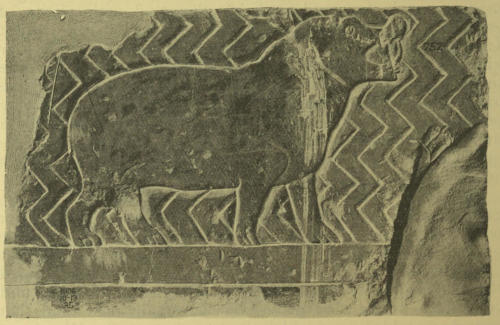
Relief with a hippopotamus. From the temple of Neb-ḥap-Rā Menthu-ḥetep.
XIth dynasty.
[Northern Egyptian Gallery, Bay 3, No. 110.]
Amusements.—The children of the poor were employed as soon as possible in tending the animals in the field, and they had few toys to play with; the children of well-to-do folk had painted wooden dolls, with hair made of strings of mud or porcelain beads, and movable joints, models of animals, etc. The chief amusement of men was hunting, and fishing, and fowling. Fish and water-fowl were usually caught in nets, but as bronze fish hooks have been found (see Table-cases B and J in the Third Egyptian Room) the[85] rod and line must also have been used. The Egyptian sportsman set out on the marshes in a shallow boat with low bows and stern, taking with him his short fishing spears, harpoons, boomerangs (see Table-case E in the Third Egyptian Room), nets, his hunting-cat (see the wall-painting in Case I in the Third Egyptian Room), servants, and sometimes a favourite wife or daughter. Nets were cast for fish in certain parts of the marshes, and the boat was poled in among the high reeds and bulrushes where the birds congregated. The skilled boomerang thrower soon brought down many birds, and his efforts were ably seconded by his hunting-cat. Among the birds may be mentioned the vulture, eagle, hawk, falcon, buzzard, kite, crow, lark, linnet, sparrow, quail, pelican, ibis, swallow, heron, goose, pigeon, etc. Occasionally the hippopotamus was attacked among the dense papyrus growths, and the animal was usually harpooned to death, as was the custom in the Sûdân until recently, for the sake of the flesh. The crocodile was also sometimes caught. No hippopotamus has been seen living in Egypt in a natural state for very many generations, and the crocodile retreated south of Kharṭûm soon after paddle steamers were placed on the Nile. The crocodile was considered to be a sacred animal for thousands of years, and a sacred crocodile was kept and worshipped as the God of the Nile at Kharṭûm so recently as the year 1829. The numerous ivory objects found in Predynastic graves prove that the primitive Egyptians hunted and killed the elephant (see Table-case L in the Third Egyptian Room), and it seems as if a considerable amount of ivory passed into Egypt proper by way of the First Cataract, for the ancient Egyptian name of the old frontier city was Ābu 𓍋𓃀𓅱𓃰𓅱𓄣𓈉, i.e., “Elephant City” (hence “Elephantine”). At a very early period, however, the elephant must have retreated far to the south, for he plays no part in Egyptian mythology, and figures of the animal are rare. (See the carnelian elephant in Table-case F, in the Fourth Egyptian Room.) The bear also seems to have been hunted. (See page 86.)
The deserts on each side of the Nile were hunted in all periods, and if we may trust the paintings in the tombs excellent sport was always to be had. The animals most commonly hunted were the lion, lynx, leopard, panther, wolf, jackal, wild-dog, fox, hyaena, hare, gazelle, oryx, ibex, ariel, and many other animals of that class. In primitive times the[86] Egyptians caught many animals with the lasso (see the green slate shield exhibited in Table-case L in the Third Egyptian Room). The rope was thrown over the horns, or round the legs, of the animal, which was then easily pulled down. The weapons used in hunting were clubs, bows, flint-tipped arrows, boomerangs, and doubled-headed axes, all of which are shown in the illustrations on page 23. The indigenous ancestors of the dynastic Egyptians probably hunted the elephant, rhinoceros, and giraffe, but it is unlikely that many of these creatures remained in Egypt in the Historical Period. Dogs were employed largely in hunting, and several species are known. The most useful and valuable was the large dog, something like the greyhound, with prick ears and a long curling tail, of the same species which is used in Mesopotamia and Persia and the Sûdân at the present day, and is called Salûḳî. The boldness of this kind of dog, called in Egyptian thesem 𓍿𓊃𓅓𓃡, is marvellous, for he will attack panthers and lions, and his fleetness is almost incredible. His speed is compared with that of a flash of light in the Book of the Dead (Chapter XXIV). The kings of the XVIIIth dynasty were great hunters, and Ȧmen-ḥetep III, who hunted from the Euphrates in the North to the Blue Nile in the South, states on his scarabs that he killed with his own hand 110 fierce lions during the first ten years of his reign. (See Table-case D, Fourth Egyptian Room, Nos. 925-929.)
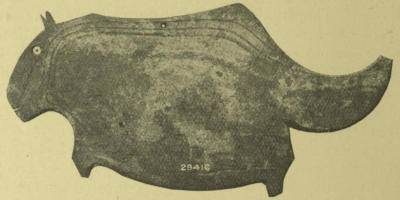
Green schist bear.
Archaïc Period.
[No. 10, Table-case L, Third Egyptian Room.]
Next to hunting dancing was perhaps the most favourite amusement of the Egyptians, and from Pyramid times the Egyptians delighted in watching men and women perform.[87] The dances were accompanied sometimes by youths who played a reed pipe or flute, single or double, or twanged the strings of an instrument of the harp, 𓏢, or lute class. (See the fine examples in Table-case A in the Fourth Egyptian Room.) The kings of the Ancient Empire loved a dance called the “dance of the god” which was danced by the Pygmies in Central Africa; and two of them, Ȧssȧ and Pepi, caused a Pygmy to be brought from his remote country to Memphis to dance before them. Dancing women danced and sang to the accompaniment of the tambourine, which was also used, together with the sistrum 𓏣, cymbals, and bells, in musical services in the temples. The drum, both the large drum which was beaten with tabs of leather, and the small hand drum, was a very favourite instrument of music, and was largely used in festivities by every class. Tumblers, acrobats, and buffoons afforded amusement to the spectators, and the drawings found on the walls of some of the tombs at Beni Hasan (B.C. 2300) show that many of the tricks exhibited at the present day were performed at that time. The well-to-do Egyptian hired dancers, singers, gymnasts, and musicians, and entertained his guests, both during and after feasts, with their performances.
The Egyptian loved to play draughts on earth, in Egyptian sent 𓊃𓈖𓏏𓏠, and he earnestly hoped that he would do the same in heaven. (See Standard-case F in the Third Egyptian Room, where the scribe Ani and his wife are represented playing draughts in the Other World.) How the game was played is not known, but there must have been several kinds of games, for the draughtboards are not all arranged in the same way. (For examples of them see Standard-cases C and H in the Fourth Egyptian Room.) The top of the box which held the draughtsmen formed the board on which the game was played. The Egyptians played a number of games with counters, but the methods are unknown. Numbers of dice have been found in the tombs, but it is doubtful if the die was known among the Egyptians of the Early Empire. Many of their games were, no doubt, games of chance. The modern equivalent of the draughts and counters of the ancient Egyptians is dominoes. The poor man, it seems from the texts, sometimes betook himself to “the house for swilling beer” 𓋴𓅨𓂋𓇋𓈗𓏊𓎛𓈎𓏏𓏊𓉐𓏤,[88] where he got drunk, and babbled about his affairs, and fell about and hurt himself, and was then cast out of the door by his fellow drinkers who said: “out with this swiller,” 𓁷𓂋𓇋𓅱𓈐𓅮𓄿𓏭𓋴𓅨𓂋𓇋𓈗𓏊𓂡𓏪. When his friends came to seek him and upbraid him, they found him lying on the ground as helpless as a child (Maxims of Khensu-ḥetep, XIII). During the dark, moonless nights, after long weary days spent in hauling up water from the river, the peasant villager had little to amuse him, except games played with counters and draughts, and the converse of his companions in the “beer-house.”
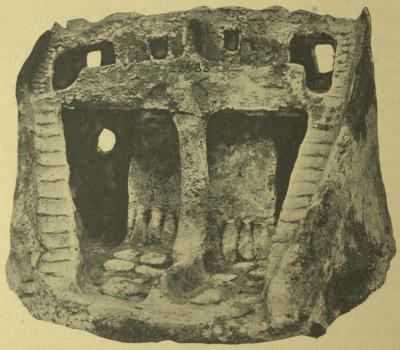
Egyptian house, with inner chamber and two flights of steps leading to the roof.
About B.C. 4000.
[No. 292, Wall-case 107, Third Egyptian Room.]
Dwelling Houses.—The king usually lived in a palace or large building within the precincts of some temple, or at a very little distance from one. His palace was probably like the large houses of modern times in Egypt, i.e., it had a courtyard with trees in the middle of it, and a large garden round about it. In the garden were fish-ponds and groves of fruit[89] trees, palms, acacias, flowering shrubs with scented blossoms, and a limited number of flowers. There were arbours, too, covered with creepers and vines, and the gardeners watered the ground daily by means of small channels into which water was poured from the shâdûf, or the water wheel. The courtyards were paved, or tiled, or covered with floors made of inlaid painted porcelain work. The walls and ceilings of the rooms were painted with rich and intricate designs, and in a few of the rooms there were openings near the roof which served as windows. The royal furniture was probably richly painted and inlaid with ebony, ivory, porcelain, and, under the New Empire, metal vases of all shapes and sizes would be seen everywhere in the dwelling rooms. Certain large rooms were set apart for receptions and entertainments, and these probably contained large raised benches placed along the walls for the guests. The kitchen, pantry, stables, and general servants’ quarters were outside the house, but the personal attendants on the king and queen, the steward, the master of the chambers, etc., had their apartments in the palace. The storeys were rarely more than two in number, and the roof, which was flat, was approached by a flight of steps, either from the courtyard or from the roof of the storey on the ground floor.
The houses of nobles were built on the same lines as the palace, but with less magnificence, and they seldom consisted of more than two storeys. There was a courtyard, with sets of small rooms built on three sides of it, and a portico on the fourth. On the flat roof were wind shafts by which the north wind was brought into the rooms, and a small amount of light was also admitted into them through openings in the upper parts of the walls, close to the ceiling. Then as now, at certain seasons of the year, some of the members of the family slept on the roof or in the courtyard, the remainder on the upper floor. Near the house were the wine-press, beer-house, stable, byres for cattle, bins for various kinds of grain, etc., and chambers for storing the fruit and vegetables from the estate. The garden contained a small lake, and in the ground round about, which was divided into oblong beds, were fruit trees and flowering shrubs with scented blossoms, vines, etc. The whole was enclosed within a thick mud wall built probably of crude brick. The farmhouse of one storey usually contained one living-room, one bed-room, and a number of small chambers in which grain was stored. On the roof was a small chamber to which the master retired in the cool of the evening; this was approached by means of a flight[90] of solid mud steps. The corn was ground and the bread baked in the courtyard, where also were kept the large porous earthenware jars, like the modern zîr, containing the supply of water which was brought to the house from the Nile each morning and evening. The house and yard were enclosed by a strong mud wall, with one door in it; in times of danger the cattle of the farm were driven from the fields into the yard. A good model of this kind of house is exhibited in Standard-case C, in the Fourth Egyptian Room. Here are seen the master sitting in the chamber on the wall, or roof, with a plate of food before him, and the wife rolling the dough for the bread-cakes of the evening meal. The house of the peasant labourer was a mere hut made of mud, the roof of which was formed of layers of palm branches or straw. Small huts were made of reeds or palm trees bound together with twigs, and perhaps daubed with mud in the cold weather, and in the northern districts of mud; in the summer a shelter of reed mats probably sufficed.
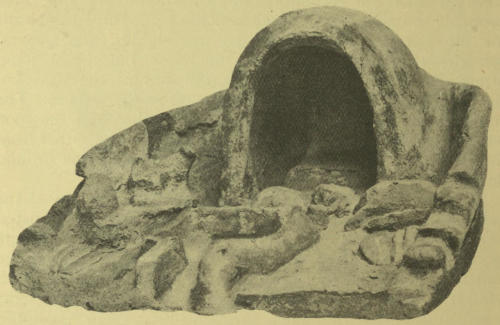
Egyptian hut.
About B.C. 4000.
[No. 293, Wall-case 108, Third Egyptian Room.]
Furniture.—The Egyptians did not fill their houses with furniture like Western Nations. Their bedsteads were made of wood, which usually came from the Sûdân, and consisted of a strong rectangular framework, about 15 or 20 inches high, across which was stretched plaited palm fibre, or rope; the ankarîb of the Sûdân is the modern equivalent. The covering of such beds was formed of thick padded linen sheets, and the[91] pillow was a support made of wood, or ivory, more or less ornamented, with a curved top for the neck to fit into. (See Wall-cases Nos. 97, 98, in the Third Egyptian Room.) Carpets were unknown, but plaited palm leaf or straw mats took their place. Chairs (see Standard-case H in the Fourth Egyptian Room) and tables were found in the houses of the wealthy, but only low stools were known in poor abodes. (For examples of a painted table, chairs inlaid with ivory and ebony, a couch-frame, stools, inlaid box, etc., see Standard-case L in the Fourth Egyptian Room.) Men, women, and children squatted or sat on the floor, or reclined upon mats, and in later days upon cushions made of padded linen. In houses of moderate size there was probably a raised mud bench, covered with mats in the receiving or eating room, for the use of the male members of the house, or their guests. There was also, probably, a raised mud bench built against the outside of one of the walls of the house for the use of friends who sat there in the cool of the evening and for the men of the house to sleep on during hot nights. Niches, or square cavities cut in the walls, served as cupboards, and in one of these the lamp (see Wall-case No. 176 in the Fourth Egyptian Room), usually made of earthenware, stood.
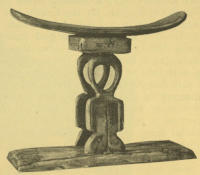
Ivory head-rest, or pillow, of Ḳua-ṭep.
XIIth dynasty.
[No. 69, Wall-case 98, Third Egyptian Room.]
The stores of clothing, etc., were kept in a very small room provided with a stout wooden door with a bolt-lock and key of simple pattern. (For examples of bolts and keys, see Wall-cases Nos. 180, 181, in the Fourth Egyptian Room.) The mistress of the house usually possessed a small strong box in which she kept jewellery, ornaments, and amulets, and perhaps also her toilet requisites; in some cases the latter were kept in a special toilet box, which held eye-paint (stibium, or antimony, koḥl), comb, hair-tweezers, pumice-stone, unguents and pomades, both scented and plain. (See Standard-case L in the Fourth Egyptian Room.)[92] Kitchen utensils were comparatively few in number. Fresh and sour milk (or curds), soft cheese, sheep-fat, etc., were kept in earthenware pots, some of which were undoubtedly glazed; bowls made of earthenware or gourds were common, as were large open saucers. The cooking pots were usually of earthenware, or, among well-to-do people, of metal. Knives made of flint, stone, or metal, were common, and rough flesh forks; in the later period spoons were used. Plates, in the modern sense of the word, were unknown; the thick bread-cake served as a plate for those who squatted round the bowl of cooked vegetables with pieces of meat on the top, and the thin flat cake was frequently used as a napkin. A stone corn-grinder and a kneading-stone were found in every house. The stock of grain for the family was kept in large earthenware jars, or in a kind of bin made of mud. Every house contained a figure of the god under whose protection the family lived, and to this adoration was offered at regular intervals; it took part in the family-councils, its lot was bound up with that of the family, and it prevented wandering spirits of evil disposition from entering the house. There being no chimney to the house, the fire was lit wherever it was most convenient, and the smoke went out through the roof and the aperture in the wall which served as a window. The fuel was animal dung, and such refuse from the straw as could not be eaten by the cow or goat of the house, and, occasionally, pieces of wood. As matches were unknown, care was taken to keep a small amount of fuel smouldering under the ashes, so that whenever it was necessary to boil lentils, etc., the fire could be revived; if the fire was out, recourse was had to the striking of flints, or to some neighbour, or to the temple fire. In primitive times the Egyptians seem to have used a fire-stick, like some of the tribes of Central Africa.
Agriculture and Cattle-breeding.—By far the larger part of the population of Egypt and the Egyptian Sûdân has been for many thousands of years past connected with the cultivation of the soil and the rearing of cattle, and on the success of the farmer and the cattle-breeder the prosperity of the whole country has always depended. In remote ages, before the estuary of the Nile was filled up by the mud which came down in flood-time from the mountains of Ethiopia and Nubia, and while still the sea flowed up the Nile as far as Esna, the primitive Egyptians were shepherds and herdsmen. The great cattle-breeding district was situated in the neighbourhood of the country now called Dâr Fûr, or the “Home of the Fûrs,” and even to the[93] present day the exportation of the beautiful cattle of the district forms a very important item of Sûdân trade. The natives who lived by breeding cattle were called by the Egyptians “Menti,” i.e., “cattle-men,” and their modern descendants are called “Baḳḳârah,” which also means “cattle-men.” In all times they have been a wild and lawless folk, ferocious, blood-thirsty, and cruel. The early cattle-men worshipped the bull, and this animal played a prominent part in later Egyptian mythology. Several kinds of bulls were worshipped in Egypt: Apis at Memphis, Mnevis at Heliopolis, and Bachis at Hermonthis, and one of the greatest of the titles of Osiris was “Bull of Ȧmentet,” or “Bull of the[94] Other World.” The cow also was worshipped under the name of Hathor, and a flint cow-head in the British Museum (Table-case M in the Third Egyptian Room) proves that her cult dates from the latter part of the Neolithic Period. The paintings on the walls of early tombs show that several kinds of cattle were known to the Egyptians, and the inscriptions make it clear that the old feudal lords and gentry of Egypt devoted much attention to cattle-breeding, and that they made a regular trade of it. (See the models of cows in the Wall-cases on the Landing of the North-West Staircase, No. 140, and the wall painting in Standard-case I in the Third Egyptian Room.) Oxen and cows were fattened like the smaller animals and geese, and, before they were turned out for the season into the deserts to browse upon the growth which followed the rains, they were branded, or marked in some way with their owner’s name.
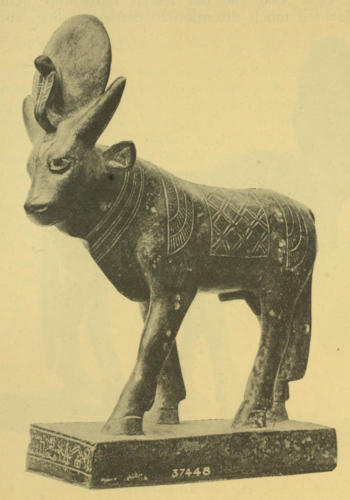
The bull Ḥāp (Apis), with the triangular blaze on his forehead, and the scarabs, etc., on his back.
[Table-case H, Third Egyptian Room.]
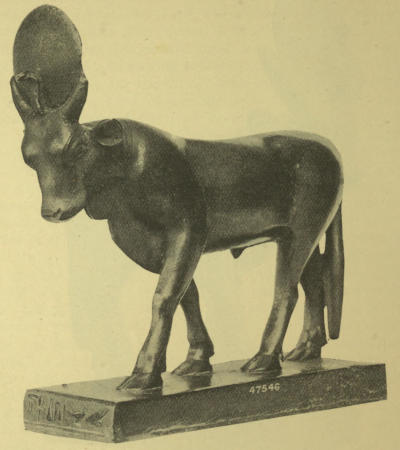
The bull Mer-ur (Mnevis).
[Table-case H, Third Egyptian Room.]
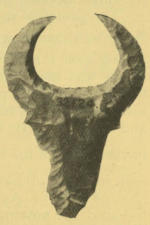
Flint Cow’s head.
[No. 86, Table-case M, Third Egyptian Room.]
The camel was certainly known in the Predynastic Period, for the head of an earthenware figure of one was found at Abydos a few years ago; but this animal cannot have been used for transport purposes, or bred by the early Dynastic Egyptians, for otherwise we should find pictures of him on the walls of the tombs. One of the earliest mentions of the camel is contained in the “Travels of an Egyptian” (Brit. Mus. Papyrus No. 10,247), where we find the Semitic word for camel under the form kamāȧl 𓎡𓄿𓅖𓇋𓄿𓏭𓂋𓏤𓄛. The camel plays no part in Egyptian mythology. The commonest beast of burden was the ass, which was bred in large numbers, and was employed like oxen for treading out the corn and for riding. One of the desert caravans of Ḥer-Khuf, an old feudal lord of Elephantine under the VIth dynasty, contained 300 asses. The ass was admired for his strength, endurance, and virility, and he appears in Egyptian mythology as a form of the Sun-god. Sheep and goats were always bred in large numbers. The horse may have been known in Egypt in the XIIth dynasty, but he was not bred there until the experience gained by the Egyptians in their Asiatic campaigns showed them his value in military operations. Horses must have been plentiful in Egypt under the XXIInd dynasty, “for Solomon had horses brought out of Egypt,” and “a chariot came up and went out of Egypt, for six hundred shekels of silver, and an horse for an hundred and fifty” (1 Kings x, 28, 29). Excellent representations of horses are seen in the wall-painting in Standard-case D in the Third Egyptian Room, and in the battle-scene of Rameses II on the South Wall of the Fourth Egyptian Room, above the cases.
The pig is not often represented on the monuments, but a painting in a tomb at Thebes shows that swine were used on farms for treading out the corn. From a very early period the god of evil, Set, was believed to have appeared in the form of a “black pig” 𓂋𓂋𓃟𓆎𓅓𓏜 when he smote the Eye of Horus (i.e., the Sun). The gods then decreed that pigs[96] should be sacrificed to Horus, with bulls, sheep, and goats. In one form of the Judgment Scene the pig is the emblem of evil, and also in the Book of the Dead (see Chapters XXXVI and CXII). On the other hand, the sow was an animal sacred to Isis, and small figures of sows were worn as amulets attached to necklaces. (See the figures of sacred animals in Wall-case No. 121 in the Third Egyptian Room.) Under the early dynasties a species of ram, which became the symbol of the god Khnemu 𓁠, with flat horns projecting at right angles from the sides of his head 𓃝, was common in Nubia, but it appears to have died out before the end of the XIIth dynasty. Another kind of ram apparently indigenous to Nubia, became the symbol of the god Ȧmen of the Sûdân.
The principal instrument used in farming was the plough 𓍁, the share of which was made of a piece of wood tied to a long pole; at the other end of the pole was fixed a bar, which was made fast to the horns of the cows which drew the plough. This primitive instrument was little more than a stout stake tied to a pole which was drawn over the ground, and made a very shallow furrow. The stiff Nile mud was further broken up by the hoe 𓌸, of which examples may be seen in the Wall-case No. 102 in the Third Egyptian Room (No. 281, etc.). As soon as the fields were ready to receive the seed, the sowing took place, and when the seed had been cast into the furrows it was trodden in by the animals on the farm being driven over it. The sowing was done by hand, and no drill appears to have been used. The fields were watered either by allowing the water to flow from a large basin or reservoir on to them, or by machines which lifted the water from the canal to their level, or from the Nile itself. The commonest water-raising machine resembled the modern shâdûf, which was worked by one or two men. Two stout stakes were driven firmly into the ground at the edge of the stream, and between them was tied a long pole, heavily weighted with a mass of mud or stone at one end. To the end of the longer half of the pole a rope and a leather bucket were tied. The labourer drew the pole down until the bucket entered the stream, and the weight of the counterpoise at the other end helped him to raise the water to the surface of the field, where he poured it into the channel leading to the growing crop.
At the harvest the crops were cut with the small sickle 𓌳
(see Table-case K in Third Egyptian Room, Nos. 1-4), which
in primitive times was made of flint or a series of flints set in a
wooden frame ![[glyph not in Unicode]](images/glyph10.jpg) , and in later times of iron or bronze. The
wheat or barley was tied up into small bundles by the
reapers, and carried to the threshing floor, where the grain
was trodden out by animals—donkeys, swine, etc. The threshing
floor, as we may see from the wall paintings and pictures
on papyri, was circular in form, and its edges were raised,
, thus preventing the animals, as they ran round and
round in it, from scattering the grain with their feet. The
operations of ploughing, reaping, and treading out the corn
are well illustrated by the Vignette No. 35, from the Ani
Papyrus. (See Standard-case G in the Third Egyptian Room.)
When the grain had been trodden out, it was thrown up
by hand into heaps, the wind blowing away the chaff
whilst it was in the air. It was next carried in baskets, or
bags, to the store or granary, which was usually near the
house. Here it was either piled up in heaps on mud stands
with raised edges 𓊚, or poured into large bins built in
the walls along a rectangular courtyard. (See the models of
granaries in Standard-case C in the Fourth Egyptian Room.)
, and in later times of iron or bronze. The
wheat or barley was tied up into small bundles by the
reapers, and carried to the threshing floor, where the grain
was trodden out by animals—donkeys, swine, etc. The threshing
floor, as we may see from the wall paintings and pictures
on papyri, was circular in form, and its edges were raised,
, thus preventing the animals, as they ran round and
round in it, from scattering the grain with their feet. The
operations of ploughing, reaping, and treading out the corn
are well illustrated by the Vignette No. 35, from the Ani
Papyrus. (See Standard-case G in the Third Egyptian Room.)
When the grain had been trodden out, it was thrown up
by hand into heaps, the wind blowing away the chaff
whilst it was in the air. It was next carried in baskets, or
bags, to the store or granary, which was usually near the
house. Here it was either piled up in heaps on mud stands
with raised edges 𓊚, or poured into large bins built in
the walls along a rectangular courtyard. (See the models of
granaries in Standard-case C in the Fourth Egyptian Room.)
Trade.—The trade of Egypt appears to have been chiefly in the hands of the seafaring folk of the Delta, who probably worked the imports and exports of the country in connection with the Semitic merchants who traded in the seaports of Phoenicia and the Mediterranean generally. The chief export of Egypt was corn, which was carried all over the Mediterranean, and we know from Genesis xii, xli-xliii, that when grain was scarce in other countries, the merchants were in the habit of going to Egypt to supply their wants. At intervals, however, serious famines came upon Egypt (Genesis xli, 55, 56), and when corn could not be imported, the mortality among the people was very great. In the reign of Ptolemy III (B.C. 247) there was a famine in Egypt, and the King expended much gold in purchasing grain at a high price to save the lives of the people of Egypt, and he caused corn to be brought to Egypt from Eastern Syria, and Phoenicia, and Cyprus. Next in importance came the linen of Egypt, which, in the form of byssus, was famous throughout Western Asia. Under the XVIIIth dynasty considerable quantities of gold were exported from Egypt to Northern Syria, Assyria and Babylonia. The gold came[98] from the Eastern Sûdân and Punt, where at that time (B.C. 1500) it was produced in such large quantities that Tushratta writing to Ȧmen-ḥetep III says: “Send me so much gold that it cannot be measured, more gold than that thou didst send to my father; for in my brother’s land (i.e., Egypt), gold is as common as dust”! (Tell al-Amarna tablet, No. 8.) According to Diodorus (ed. Didot, p. 41) Rameses II received from his gold and silver mines in one year metal to the value of 32,000,000 minas, or £80,000,000 sterling. Another article of export was paper manufactured from papyrus.
Among the imports may be mentioned copper and tin from Cyprus and Northern Syria, cedar wood from the Lebanon Mountains, lapis-lazuli paste from Babylonia, myrrh and spices for embalming, skins, cattle, ebony, ostrich feathers, bows, pillows, chairs, couches, fans, mats, shields, etc., from the Sûdân; and a number of the products of India and Arabia must have found their way into Egypt by means of the caravans which crossed the desert to some place near the modern Suez or Ḳanṭarah, and some sea-borne goods entered Egypt by the route from the Red Sea to the Nile, viâ Ḳuṣêr and Ḳena. The importance of Egypt as a trading centre, and as the natural market half-way between the East and the West, was not fully recognized until the Ptolemaïc Period, about B.C. 250. Business was carried on chiefly by barter, so much wheat, barley, or millet being the value of a sheep, bull, cow, or goat, linen, etc. The Egyptians used weights and measures, e.g., the royal cubit of 7 palms or 28 fingers, the little cubit of 6 palms or 24 fingers, the palm of 4 fingers, the hand of 5 fingers, the fist of 6 fingers, and the finger; of dry measure, the hen, the ṭenȧt, the ȧpt, etc.; of weight, the ṭeben (= 3⅕ ounces), the ḳeṭ = ⅟₁₀th of a ṭeben, etc. The use of the scales was well known, but there is no evidence that the steelyard was employed before the Roman Period. Stamped money was unknown among the Egyptians, but they appear to have used a currency which consisted of pieces of wire made of copper, iron, or gold, and gold-dust. Ring-money, made of gold, is represented in the painting on the south wall of the Fourth Egyptian Room; and also the little bags containing gold dust. Ring-money in gold is in use at the present day along the east coast of Africa, and in certain parts of the Sûdân copper wire still possesses great purchasing powers.
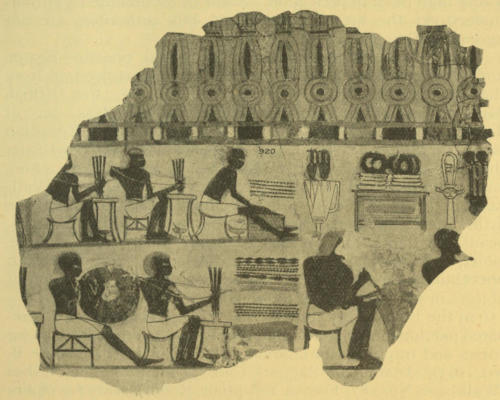
Jewellers drilling and polishing beads, etc.
XVIIIth dynasty.
[Northern Egyptian Gallery, Bay 12, No. 518.]
Handicrafts.—The Egyptian of all periods was a skilled potter. In the earliest times the potter’s wheel was unknown, and every vessel was shaped by the potter’s hand or foot.[99] Vessels of all sorts, shapes, and sizes were made with great skill, and in later periods were decorated with linear and other designs. The art of the potter throve until the advent of the conquerors from Asia, when it began to languish; and in a few centuries earthenware vessels were superseded by stone. Good examples of Predynastic and Archaïc pottery will be found in the cases on the Landing of the North-West Staircase, and of the pottery of the later periods in the Fourth Egyptian Room. The Basket-weaver wove rush matting, plaited mats and sandals, and made ropes and baskets of all kinds. Specimens of his work will be seen in Table-case A in the Third Egyptian Room, and in Wall-cases 182-187 in the Fourth Egyptian Room. Owing to the abundance of flax in Egypt the trade of the linen-weaver was in all periods most flourishing, and the “fine linen of Egypt” was famous throughout Western Asia and the seaports of the Mediterranean. A staff of linen weavers appears to have been attached to each temple, and the sale of their work produced a large revenue; a portion was paid to the king, and the rest was kept by the priests. The city of Ȧpu[100] (Panopolis, the modern Akhmîm) was one of the chief seats of the linen industry, and to this day the dyed curtains of Akhmîm are used throughout Egypt. The craft of the jeweller was very important, for, in addition to the rings, bracelets, necklaces, pendants, earrings, etc., which he made in gold and silver, he cut the amulets and ornaments in amethyst, garnet, agate, onyx, chalcedony, carnelian, jasper, mother-of-emerald, lapis-lazuli, turquoise, rock-crystal, basalt, porphyry, haematite, obsidian, coral, mother-of-pearl, etc. (See Table-cases F, J.) The finest work of the jeweller belongs to the XIIth dynasty, and the workmen of that period brought the art of inlaying precious stones and metals to a very high pitch of perfection. Some think that the Egyptians understood the art of enamelling, but authorities are not agreed on this point.
The glass-maker’s craft is a very old one in Egypt, and it is probable that the Phoenicians borrowed it from that country. Fine specimens of it in the British Museum are the turquoise-blue opaque glass jar of Thothmes III (Table-case H, No. 50, Third Egyptian Room), a blue glass bowl, and a variegated glass bowl from the tomb of Ȧmen-ḥetep II (Nos. 57, 59, in the same case), and an opaque glass stibium pot with a gold rim (Wall-cases 182-187, No. 29). The porcelain maker produced the little figures, amulets, bowls, vases, ushabtiu-figures, tiles, beads, pendants, etc., in the beautiful blue, green, purple, violet, and brown glazed ware to which the name Egyptian porcelain is usually given. An exceedingly fine collection of objects in this material is exhibited in Wall-cases Nos. 151-156 in the Fourth Egyptian Room. The leather worker prepared parchments for writing materials, and made the harness for horses and trappings for chariots, soldiers’ belts (Table-case B, No. 193), sheaths for daggers (No. 37), nets of fine meshes (Wall-case No. 187, Fourth Egyptian Room), seats for chairs (No. 5 Standard-case L, same room), bags in which barbers carried their razors, etc. (Wall-case No. 184, Fourth Egyptian Room.) Examples of the tools of the carpenter, blacksmith and coppersmith, stonemason, house-painter and decorator, etc., will be found in Table-case K and Wall-case 103 in the Third Egyptian Room.
Of the brickmaker’s work specimens belonging to the reigns of Ȧmen-ḥetep III, Thothmes I, Thothmes III, and Rameses II are exhibited in Wall-case 175, Fourth Egyptian Room. Examples of the craft of the furniture maker in the form of tables, chairs, stools, couches, toilet[101] boxes, altar-stands, etc., are seen in Standard-case L and Wall-case No. 190 in the Fourth Egyptian Room. The work of the ivory carver went hand in hand with that of the carpenter as regards the inlaying of chair frames, jewel-boxes, etc. (see Nos. 13 and 16 in Standard-case L). Specimens of the highest form of his skill are seen in the chair-legs, human figures, spoons, etc., in Table-case A in the Fourth Egyptian Room. The caster-in-metal produced the splendid series of figures of the gods in Wall-cases 119-132 and Table-case H in the Third Egyptian Room; fine examples are the silver figure of Ȧmen-Rā (No. 42), gold figures of Thoth, Ptaḥ and Rā, (Nos. 21, 25, 26), and the gold figure of Osiris (No. 34). The wood-carver made the models of men, boats, animals, etc., which were placed in the tombs (see Wall-case Nos. 192, 193, Fourth Egyptian Room), and dolls and children’s toys (see Standard-case C, Fourth Egyptian Room). The dyer produced the salmon-coloured linen coverings for mummies (see Case L, First Egyptian Room), the brown mummy-swathings (see Wall-cases 93-96, Third Egyptian Room), and coloured wearing apparel (see Table-case E, Third Egyptian Room), etc.
The baker and confectioner found constant employment in every town and village in Egypt, for the Egyptians loved cakes made with honey, and fruit of all kinds, and bread and buns made into fanciful shapes. A great business was done in bread and pastry which were intended to serve as funerary offerings. Specimens of the bread and the stands on which the flat loaves were placed, will be found in Table-case H, Third Egyptian Room. The terra-cotta cones 𓏙 which are exhibited in large numbers in Wall-cases 110, 111, are supposed by some to represent the loaves, of a pyramidal shape, seen in the hands of kings and others who are represented offering to the gods. The barber also found constant employment, for many had their whole heads and bodies shaved every two or three days. He also dressed the hair of ladies on ceremonial occasions, and made wigs (see the fine example in Wall-case H, Third Egyptian Room). The barber often united to his trade the profession of physician, just as was the case in Europe in the Middle Ages. The craft of the boat-builder was very important in a country where a river was the chief highway. Flat-bottomed boats and punts used in fishing in the canals, or fowling on the marshes, were made of bundles of[102] reeds, or papyrus, tied together, like the modern tôf in the Sûdân. Boats for carrying merchandize on the river were made of planks of wood pegged together, which were sometimes kept in position by being nailed on to ribs, and others were merely tied round with ropes made of papyrus. One of the earliest known pictures of an Egyptian boat is seen on vase No. 160, in Wall-case No. 5, on the landing of the North-West Staircase. Models of funeral boats, and barges and war boats are exhibited on the upper shelf of Wall-cases Nos. 99-110, in the Third Egyptian Room. The Egyptians were skilful boat builders, and they made rafts capable of carrying enormous blocks of stone, e.g., the obelisks which Queen Ḥātshepset set up at Karnak. They had equivalents of the modern broad ferry-boat, barge, lighter, etc., which they worked with oars or “sweeps” and sails, or towed, when going upstream, and when there was no wind.
Architecture.—The history of the earliest form of Egyptian architecture cannot be written because, with the exception of the ruined tombs of the Archaïc Period, all the remains of the earliest temples have been destroyed or have perished. The oldest form of the house was, no doubt, a hut built of reeds, the roof of which was supported by a pole, i.e., a tree trunk, or poles; its shape was round or oblong. The cold winds of winter prompted the Egyptian to make the walls of his abode of Nile mud; this he mixed with water until it acquired the consistence of stiff paste, and then piled it up with his hands until the walls were as thick and high as he wanted them to be. All the walls inclined inwards, and so each helped to support the other; the roof was made of a layer of mud which rested on a number of pieces of palm trunks or small trees. The door probably faced the south, and an aperture, which served as a window, was cut high up in the north wall. (See the model of an early house, No. 174, North-West Staircase Landing.) Before the house was a small yard enclosed by thick walls made of mud, which inclined inwards, and a flight of solid mud steps led up to the roof. (See the models of early houses in Wall-cases Nos. 105-108 in the Third Egyptian Room.) Walls made of mud in this way are unsatisfactory, for they sag or bulge, and soon fall down. The invention of the brick marked a great improvement in the stability of buildings; and its use in the construction of houses, granaries, government buildings, forts, etc., became universal. A theory has been recently put forward that brickmaking was introduced into Egypt from Mesopotamia, but there is no reason why, in a land where all the soil is mud, which when well sun-dried becomes exceedingly hard, the idea of making bricks should not have been indigenous. Few things in the East last as long as a well-made brick, especially if it has been carefully baked; and buildings, even when made of crude bricks, last for several hundreds of years, unless they are destroyed by the hand of man. The invention of the brick permitted the Egyptians to build the elliptical arch,[104] which is frequently found in brick-built buildings; the knowledge of the arch is of ancient standing in Egypt. The early mud or brick house of the man of means was provided with a portico (the modern rakûbah), which was supported on palm trunks; this portico suggested the colonnade of later days, and the palm trunks the stone pillars with palm-leaf capitals.
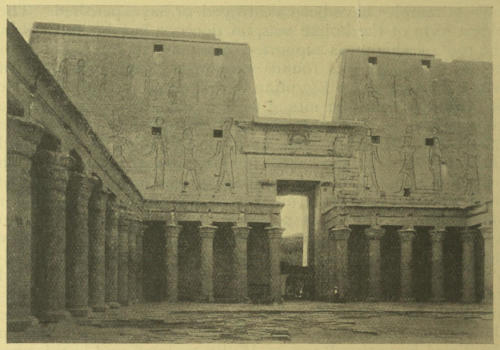
Pylon and court of the Temple of Edfû.
Ptolemaïc Period.
The “house of the god,” or temple, was at first built of mud, but what such a building was like is not known. Under the Ancient Empire the Egyptians built their temples of stone, and the oldest known example is that called the “Temple of the Sphinx” at Gîzah. It is built on a simple plan, and consists practically of a large hall, in the form , containing 16 pillars, each about 16 feet high; the materials used were granite and limestone. It had neither formal door, nor windows, and such light as entered must have made its way in through oblique slits in the roof. It has no inscriptions, or bas-reliefs, or paintings, and even in its present state its massiveness, dignity, and solidity greatly impress the beholder.
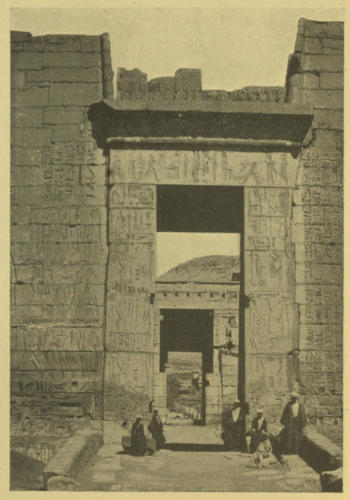
Gateway in the Temple of Rameses III, at Madînat Habû, in Western Thebes.
About B.C. 1200.
Of the temples of the XIIth dynasty nothing is known, but of the New Empire several temples exist, and their general characteristics may be thus summarized. A broad path brought the worshipper to the gateway in the wall which[105] enclosed the temple precincts; on each side of the path was a row of sphinxes, or rams, which symbolized the guardian spirits of the place. Passing through the gateway he soon reached the main pylon, which consisted of a massive doorway and two towers. During festivals long painted poles, flying coloured streamers, were attached to the face of the pylon at regular intervals. On each side of the gateway was a colossal statue of the king, and statues of the king were often arranged at intervals along the front of the pylon. Before the pylon stood a pair of obelisks, and sometimes a pair of sphinxes, or sacred animals. The original signification of the obelisks is unknown; it is probable that they were connected with a solar, or even phallic cult, but as the texts afford no explanation of their meaning it is useless to theorize. Beyond the great pylon was an open court, with a colonnade,[106] which was used as a sort of bazaar where holy objects, amulets, and things for offerings could be bought by the public. Here, too, the sick were laid that alms might be given to them, and here beggars of all kinds congregated, as they do in a modern mosque. Passing through a second pylon, the hypostyle hall, or hall of columns, was entered, and here the priests made their processions, and received the offerings of the faithful. Beyond the hall, or halls of columns, the laity were not permitted to penetrate. The other chambers of the temple formed the sanctuary of the god, and contained his shrine. The little rooms round about the shrine contained the temple library, and the dresses, jewellery, and other sacred properties of the god, or gods, worshipped in the temple. At the extreme end of the temple was the shrine of the god, which was entered by no one except the king and the priests; in it were kept a sacred boat, or ark, and a figure, or symbol, of the god, or animal sacred to him.
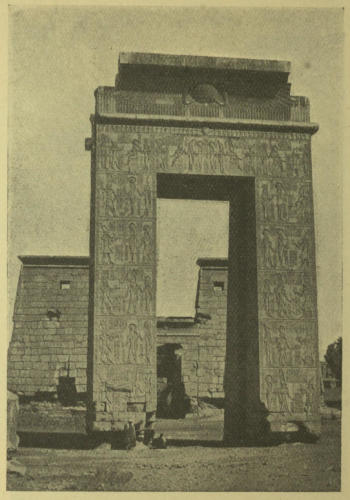
Gateway of Ptolemy IX at Karnak.
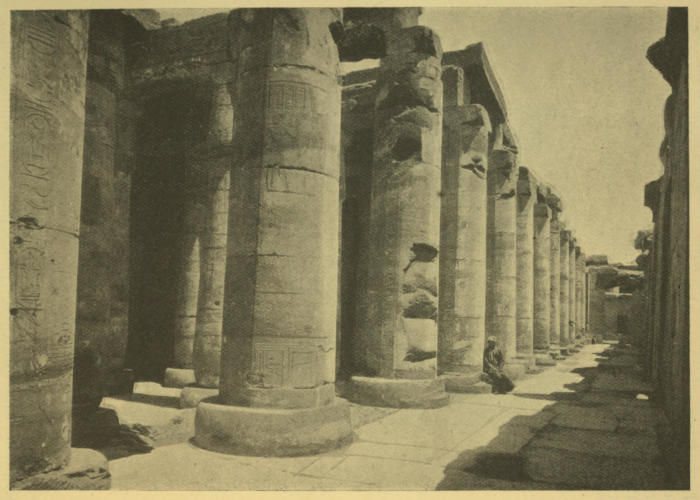
Plate XI.
Columns in the Temple of Seti I, B.C. 1370, at Abydos.
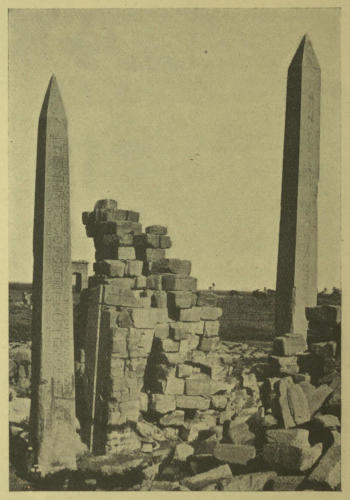
Granite obelisks at Karnak. That on the right bears the name of Queen Ḥātshepset, and that on the left the name of Thothmes I.
XVIIIth dynasty, B.C. 1550.
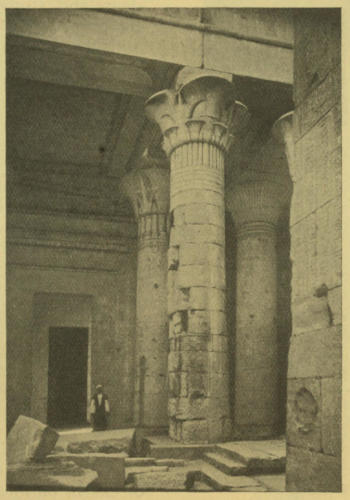
Pillars with ornamental capitals in the Temple of Isis at Philae.
Ptolemaïc Period.
The temples of Egypt from the XVIIIth dynasty to the Roman Period vary greatly in detail, but the general plan is always the same. The great temples of Karnak (see Plate XXX), Luxor, Abydos (see Plate XI), etc., awe the spectator by their size and majestic dignity; the smaller temples of the Ptolemaïc and Roman Periods are less grand, but are much more graceful buildings. The severity of the interiors of the older buildings is moderated by the reliefs and inscriptions with which walls, pillars, pilasters, architraves, etc., are covered profusely, and the bright colours, reds, blues, greens, and yellows, in which many of the painted scenes were executed, added greatly to their general effect. The massive square pillars were replaced in later times by pillars with[108] eight sides, and the whole character of the simple round column was changed when its shaft was made to resemble a papyrus or lotus stalk, and its upper part was sculptured in the form of the flower of either plant. Both pillars and pilasters were sometimes decorated with figures of Osiris, cut on the front face in high relief, as at Abû-Simbel, and the capitals were often sculptured in the form of the head of Hathor (the Cow-goddess), surmounted by a sistrum. The pillar with the Hathor-headed capital was suggested by the pole, or small tree trunk, surmounted by the head of a bull, ox, or cow, which the primitive Egyptians set up over the graves of their chiefs, a custom which survives to the present day among certain of the tribes of Central Africa. Every temple had a sacred lake within its precincts, just as every large house possessed[109] a garden with an ornamental lake in it. Each temple also was surrounded by a girdle wall, which was usually made exceedingly strong and was provided with fortified gateways. The space between the temple buildings and this wall was occupied by gardens and storehouses for the property of the priests, and also by the dwellings of private folk. Thus the girdle wall of the temple actually enclosed a small city, which in cases of popular panic or invasion became a city of refuge.
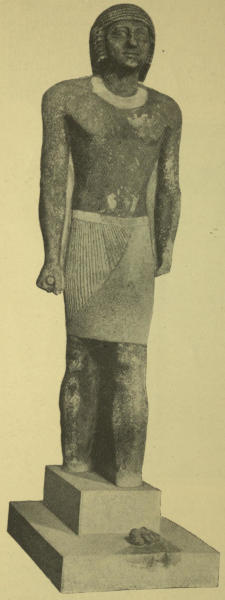
Painted portrait statue of Ȧn-kheft-ka, a royal kinsman.
IVth dynasty, about B.C. 3700.
[Northern Egyptian Gallery, Bay 1, No. 33.]
Painting and sculpture.—The Egyptians, from the IVth dynasty downwards, were in the habit of painting the bas-reliefs in their temples and tombs, and also their statues, and they seemed to have relied greatly upon paintings in bright colours to enhance the effect of the work of the sculptor. The earliest wall decoration consists of series of figures of men, animals, etc., traced or cut in outline, or sculptured in low relief, on tolerably smooth slabs of limestone; sometimes the surfaces of the slabs were prepared with a sort of limewash, and the paintings painted upon it. The skill of the painter, even in the remote period of the IVth dynasty, is marvellous, and the accuracy with[110] which he represented every detail and characteristic of animate and inanimate objects is beyond praise. At all periods, however, general scenes are more or less hard, a fact due to want of perspective. The Egyptians loved colour, and they used it wherever it could possibly be employed. A striking instance of this is afforded by the elaborately painted papyri of the Book of the Dead, which when once buried in the tomb were intended to be seen by no other eye than that of the spirit of the deceased!
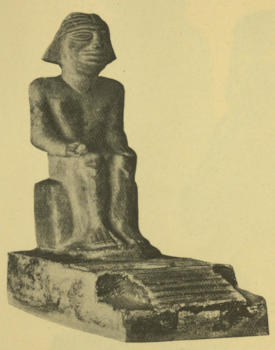
Alabaster figure of a priest seated on a throne with steps.
IVth-VIth dynasty.
[No. 156, Wall-case 99, Third Egyptian Room.]
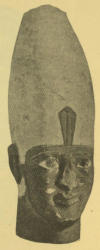
Head of a painted statue of Neb-ḥap-Rā Men-thu-ḥetep.
XIth dynasty.
[Northern Egyptian Gallery, Bay 3, No. 104.]
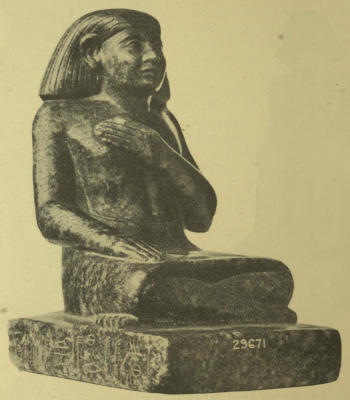
Diorite statue of Sebek-nekht.
XIIth dynasty.
[No. 164, Wall-case 100, Third Egyptian Room.]
The wall sculptures were of two kinds, the bas-relief and the sunk relief. In the bas-relief the sculpture is raised a little above the surface of the slab, and in the sunk relief it is a little below. The sunk relief is one of the most characteristic features of Egyptian sculpture. Of the first kind there are many examples in the Egyptian Galleries of the British Museum, especially in the Vestibule at the north end of the Northern Gallery, where the slab from the tomb[111] of Rā-ḥetep at Mêdûm (Egyptian Vestibule, No. 40), of the IVth dynasty may be specially noted. Several portions of fine and delicately painted bas-reliefs from the temple of Neb-ḥap-Rā; Menthu-ḥetep, of the XIth dynasty, at Dêr al-Baḥarî, which are exhibited in Bay 2 of the Northern Gallery, are worthy of careful study. The sepulchral tablet of Sebek-āa, of the XIth dynasty, should be noted (Bay 4, No. 120; see Plate XXIII). Examples of the sunk relief will be found in the Northern Egyptian Gallery, Bay 1. Both paintings and reliefs, however, are unsatisfactory from the modern point of view, for while the head is given in profile, the eye is represented as if the figure were in a full-faced position. A front view is given of the shoulders, but the view of the other portions of the body is a mixture of profile and full face. These facts are calculated to give a false impression of the[112] skill of the painter and sculptor, which, as is admitted on all hands, was very great.
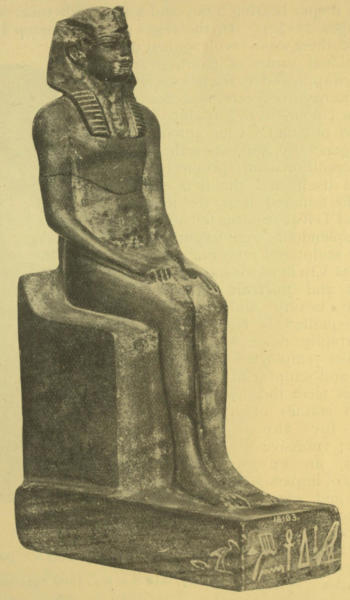
Figure of a king.
XIIIth dynasty.
[No. 178, Wall-case 102, Third Egyptian Room.]
The artist was at a very early period fettered by tradition and conventionality, but sufficient proofs have survived to show that when free to give rein to his fancy he could produce even caricatures and comic pictures of the most amusing character. Thus, in Papyrus No. 10,016, we see the lion and the unicorn[113] playing a game of draughts, a fox playing a double pipe while animals of the gazelle class strut in front of him, a cat driving geese, and a cat presenting a palm branch to a mouse which is seated on a chair and holding a lotus. Behind the chair is another mouse bearing a fan and a bag with toilet requisites (see pages 27-30). In the reign of Ȧmen-ḥetep IV, about B.C. 1420, there was a revolt against the conventional forms of painting and sculpture approved by the priests. For about twenty-five years, new designs and new colours were introduced, but they did not find favour among the people generally, and, when the king died, traditionalism promptly re-asserted itself, and the new capital which he founded near the modern village of Tell al-Amarna fell into ruin, and its splendours were forgotten.

Queen Tetȧ-Kharṭ, about B.C. 1600.
[No. 187, Wall-case 102, Third Egyptian Room.]
The sculptured reliefs of the IVth and Vth dynasties, and the statues and portrait figures were in beauty and fidelity rarely equalled in later times, and certainly never surpassed. The chief employers of both painter and sculptor in the later dynasties were the priests, who required statues of gods and kings for the temples; massive strength, an expression of impassibility, and close adherence to existing models were the traditional characteristics of such works. With private employers the case was different, for they demanded of the sculptor portrait figures which should be representations of their friends at once faithful and pleasing. Among early portrait figures of fine work in the British Museum may be mentioned the ivory figure of a king, wearing a robe of elaborate pattern (Table-case No. 197, in the Third Egyptian Room; see[114] page 24, No. 7); the statue of the official Nefer-hi of the IIIrd dynasty (No. 150, Wall-case 99, Third Egyptian Room); the statue of Betchmes, of the IIIrd dynasty (No. 3, in the Egyptian Vestibule, see page 110), and the statue of Ȧn-kheft-ka, of the IVth dynasty, (Bay 1, No. 33, in the Northern Egyptian Gallery, see page 109).
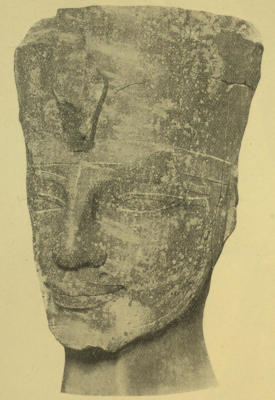
Head of a colossal statue of Ȧmen-ḥetep III, B.C. 1450.
[Northern Egyptian Gallery, Bay 4, No. 416.]
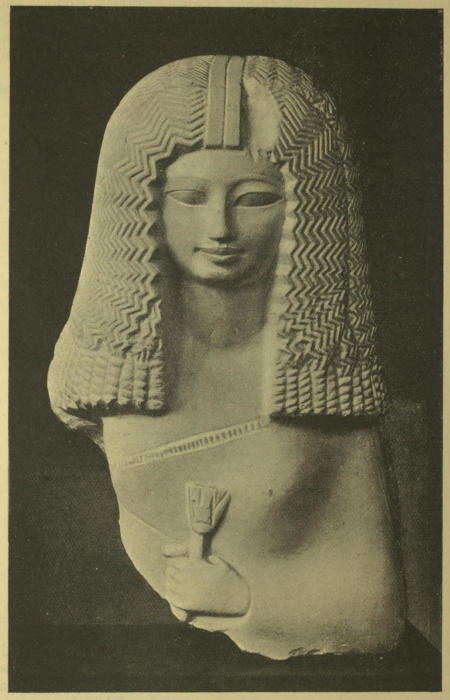
Plate XII.
Head of a stone figure of a priestess of the XVIIIth dynasty.
[From the cast, No. 38,430, Wall-case 102, Third Egyptian Room.]
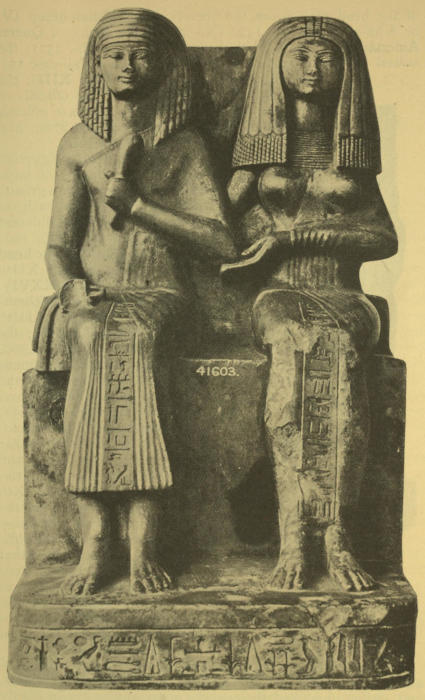
Plate XIII.
Limestone seated figures of Khā-em-Uast and his wife.
XIXth dynasty.
[No. 41,603, Wall-case 105, Third Egyptian Room.]
On the second shelf of Wall-cases 99-109 in the Third Egyptian Room is exhibited a typical series of portrait figures in stone which illustrate the work of the period between the IIIrd dynasty and the Roman Period. Special attention may be given to the head of an official (No. 186) in crystalline limestone; the figure of Queen Tetȧ-Kharṭ, a wife of Ȧāḥmes I, B.C. 1600 (No. 187, see page 113); the portion[115] of the head of a figure, the “heretic king,” Ȧmen-ḥetep IV, or Khu-en-Ȧten, B.C. 1420 (No. 212); the figure of Queen Ȧmenȧrṭās, of the XXVth dynasty, B.C. 700 (No. 232); the seated figures of Khā-em-Uast and his wife (Wall-case 105, Third Egyptian Room; see Plate XIII); the seated figure of Ḥarua, one of the officials of Ȧmenȧrṭās (No. 234); the two figures of officials of the Roman Period (Nos. 269 and 270); and the head of a priestess (see Plate XII).
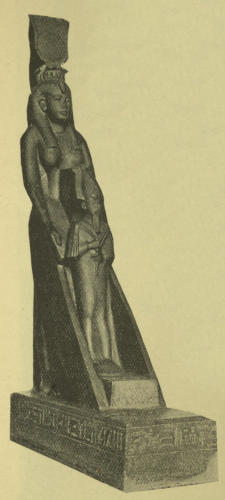
Statue of Isis, holding a figure of Osiris. Dedicated by Shashanq, a high official.
Ptolemaïc Period.
[Southern Egyptian Gallery, Bay 28, No. 964.]
In the Northern and Southern Egyptian Galleries among the finest examples of large statues may be mentioned the three grey granite statues of Usertsen III, B.C. 2330, each of which represents the king at a different period of his life (Nos. 158, 159, 160; see Plate XXV); the dark granite head of Ȧmen-em-ḥāt III, of the XIIth dynasty (No. 774; see Plate XXVI); the red granite statue of Sekhem-uatch-taui-Rā, a king of the XIIIth dynasty (No. 276, Plate XXVII); the head of Thothmes III, B.C. 1550 (No. 360; Plate XXXI); the heads of Ȧmen-ḥetep III, B.C. 1450 (Nos. 416, 417); the white limestone statues of an official and his wife, of very fine work (No. 565); and the granite statue of Isis holding a figure of Osiris between her wings (No. 964). The statues and portrait figures of the latter part of the XVIIIth, XIXth and XXth dynasties lack the fidelity to nature of those of the Ancient and Middle Empires, and it is clear that about B.C. 1200 both statues and figures were kept in stock by funerary masons, who merely added the names of deceased persons to them after they were sold.
Under the Saïte kings of the XXVIth dynasty a Renaissance took place, and for a short time painters, sculptors, and scribes modelled their works on examples drawn chiefly from the monuments of the Ancient Empire.
The King of Egypt was absolute master of the country, which had been given to him by the gods, and of every man, woman, and child, and of everything in it from one end to the other. He was the son of Ḥeru-ur, i.e., Horus the Great, the oldest of all the gods of Egypt, whose attributes were, at a later period, usurped by Rā, the Sun-god, and was declared to be of the very substance and essence of the god. He was believed to be a god, and was worshipped as a god, and his statues and figures were placed among the statues of the gods, and with them received the adoration of men. His word on any subject was final, his authority limitless, in his person he united the intelligence and strength of all beings in heaven and on earth; men lived by his grace only, and at a word from him they were slain. In short, the Egyptians were serfs and bondmen of the king, the counterpart, image and symbol of the god of heaven.
He possessed five great names or titles: 1. A Horus name, as the descendant of Horus. 2. A Nebti name, as representative of Nekhebit and Uatchit, the great goddesses of the South and North. 3. A Horus of gold name. The blood of the sun-god was supposed to be made of gold, and as the divine blood ran in the king’s veins, a “name of gold” was given to him. 4. A Suten Bȧt name, as king of the South (Suten) and King of the North (Bȧt). 5. A Son of Rā name, or personal name of the king. Thus, the five names of Usertsen III were:
Horus name, Neter Kheperu. This was placed in a serekh thus:—

𓅃𓇴𓋹
𓉘𓊹𓆣𓅱𓊂
The Horus name is sometimes called the “banner name”; the serekh, however, is not a banner, but a representation of a building of a funerary character.
Nebti name, Neter Mestu 𓅒𓊹𓄠𓅱𓏏.
Horus of gold name, Ānkh Kheper 𓅉𓋹𓆣.
Suten Bȧt name, Khā-kau-Rā 𓆥𓍹𓇳𓈍𓂓𓂓𓂓𓍺.
Son of Rā name, Usertsen 𓅭𓇳𓍹𓄊𓋴𓂋𓏏𓊃𓈖𓍺.
The oval in which the fourth and fifth names are placed, 𓍷, is called in Egyptian Shennu, and is commonly known as the “cartouche.” It was originally circular in form, 𓍶, like a signet ring, and Besh, a king of the IInd dynasty, appears to have been the first to use the cartouche. Another common title of the king was Per-āa 𓉐𓉻, i.e., “Great House,” meaning the “house in which all men live,” or the “Asylum of the Universe,” “Sublime Porte,” etc., which we find in the Bible under the form of “Pharaoh.” The king being god never died, and he owed the property of immortality which he possessed to the “fluid of life” 𓎃𓈖𓋹, sa en ānkh, which he obtained from Rā before his birth, for the god was believed to become incarnate from time to time, and to consort with queen after queen, so that his son might always sit on the throne of Egypt. The statues of Rā, being inhabited by his doubles, were endowed with the “fluid of life,” and this they transmitted to their human counterpart, the king, by resting their hands upon his head, or by drawing them over the back of his head and down his back. The king performed the ceremonies of the “divine cult” daily, and as a result he drew from the god each day a new supply of the “fluid of life,” which justified him in adopting the title “Endowed with life, like Rā, for ever,” 𓏙𓋹𓇳𓏤𓏇𓆓𓏏𓇾.
The Queen was called either the “woman of the god,” 𓊹𓈞𓏏, or the “woman of the king,” 𓇓𓈞𓏏, but she possessed several other titles.

Seated figure of Qen-nefer, a prince and overseer of the palace, about B.C. 1450.
[Central Saloon, No. 556.]
The official to whom the king entrusted the administration of the country was called Erpā 𓂋𓊪𓂝, and of almost equal authority was the Tchat 𓅷𓏏𓏤, whose equivalent in modern times is the Ḳâḍî, or Judge.[118] Other high offices were Chief Councillor, 𓃥𓉪, the Town Governor, 𓄓𓊖𓏏𓏤, the Chancellor, 𓆤𓏏𓋩, and, of course, the chiefs of the nomes, the officers of the Treasury, Army, Works Department, Police and Law Courts, and Temples, each of whom had his own staff. Titles often bestowed by the king were Ḥā 𓄂𓂝, Prince, and Smer 𓋴𓍋, Smer-uāt 𓋴𓍋𓌡𓏏𓏤, which mean something like “friend,” and “only friend.” Picturesque titles appear occasionally; thus one official calls[119] himself “the eyes of the king in the South, and his ears in the North,” “the eyes of the king in Thebes,” etc. In the priesthood were the following grades: 1. The neter ḥen, or servant of the god 𓊹𓍛; 2. The tef neter, father of the god 𓊹𓏏𓆑𓀀; 3. The āb, libationer 𓃂𓈗𓀀; 4. The Kher ḥeb, or “Lector,” or “precentor” 𓌨𓂋𓎛𓃀𓎱𓀀, etc. There were several kinds of minor priests, e.g., the ḥen ka, or priest of the Ka, the sem, or setem, the ȧmm ȧs, the ȧmm khent, and the ministrants in general. The title of the high priest of Memphis was “Ur-kherp-ḥem,” i.e., “Great Chief of the hammer,” in allusion to his being priest of Ptaḥ, the Blacksmith-god of Memphis; that of the high priest of Heliopolis was “Ur-maau,” i.e., “great seer”; and that of the high priest of Thebes was “Chief prophet of Ȧmen-Rā.” Among the civilians the Scribes played the most prominent part in the administration of the country, and in all periods both “royal scribes” and “scribes” held many high offices, especially in connection with the Treasury, and with institutions which possessed large properties, such as the great temples of Heliopolis, Memphis, Saïs, Bubastis, Abydos and Thebes.
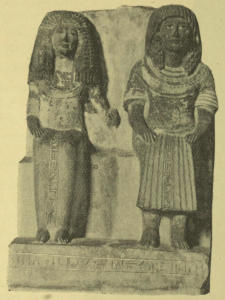
Statues of Māḥu, a director of Works, and Sebta, a priestess of Hathor, B.C. 1350.
[Central Saloon, No. 637.]
Military service.—The Egyptian was neither a fighting man nor a soldier by nature, and except for a few comparatively short periods in her history, Egypt never had an Army in the sense in which the word is used by Western Nations. The Egyptian hated military service, and in any conflict which resembled war he generally ran away. When a hostile force threatened the country, the head of each nome[120] collected a number of men from his district, and armed them as well as he could, and then sent his contingent to some place appointed by the king. Individual nobles also, no doubt, sent companies of men more or less armed from their estates to fight the king’s battles. The peasant, or fellaḥ, was then, as now, a formidable opponent in a fight, when armed with a stout stick, or club, especially when he could fight under cover or behind a wall; but anything like organized resistance terrified him, and rendered him useless. On the other hand, the native of the Sûdân was a very fine fighter, and whenever it was possible Pharaoh stiffened his troops with regiments of Blacks. Thus, if we may believe the account of Unȧ, the commander-in-chief of Pepi, a king of the VIth dynasty, his army contained Blacks from every great province of the Sûdân, and numbered “many times ten thousand.” In the Asiatic campaigns, which produced such great spoil for Egypt, the organizers of these wars, which are better termed “military raids,” and the finest fighters in them were either Blacks, or of Sûdânî origin. Egypt had only need of soldiers in the strict sense of the word when it was necessary to suppress sudden rebellions in the provinces, or to compel tributary kings to pay what was due from them, or to provide escorts to Government trading expeditions. In times of peace the troops of the militia laid down their clubs, bows, daggers, and spears, and worked at their trades or cultivated the fields. Military exercises, drillings, manœuvres, etc., there were none.
The Predynastic Egyptian warrior armed himself with a short, stout stick; later it was weighted at one end with a piece of flint or stone, and so became a kind of club. A flat piece of flint, or stone, with a roughly-formed cutting edge, bound to a stick by thongs of leather, served as an axe. Double-headed axes were also known, and knives, spear-heads, arrow-heads, etc., were commonly used.
The equipment of the soldier of the Ancient Empire was simple. He wore a sort of skull cap, of leather(?), with a feather or two stuck in the top; he fought with a club 𓌉, or mace, and a bow 𓌔, carrying his flint-tipped arrows in a leather quiver slung over his back, and he caught the blows and arrows of his foe on a large leathern shield, which was sometimes ornamented with the badge of his master or his family. At a later period he wore a leathern shirt to protect his body, and he added to his arms a long spear, a knife, or dagger, with a curved blade 𓌛𓑀, and sometimes[121] a battle-axe. The equipment of the mercenaries of a still later period differed in many details from that of the native Egyptian. (For examples of bows, arrows, daggers, spears, etc., see Table-case B in the Third Egyptian Room.)
The horse and chariot were unused in Egypt before the kings of the XVIIIth dynasty began to make conquests in Western Asia. At a comparatively early period the Egyptians began to fortify their towns with walls and strong gates, and in the XIIth dynasty King Usertsen III erected a series of forts in the Second Cataract to prevent the Nubians from descending the river and laying Egypt waste. One strong fort was built near Buhen (Wâdî Ḥalfah), another on the island now called Jazîrat al-Malik, one at Semnah, and another exactly opposite at Kummah. The walls were built of mud bricks, many feet thick, and long slopes cased with stone were built against them. Within each enclosure were series of chambers for storehouses and barracks, and at one corner a small temple, dedicated to the chief god of the district. Another series of forts was built on the frontier between the north-east line of the Delta and Syria, generally of great strength.
The geographical position of Egypt made it unnecessary for her to possess a navy, and, moreover, the peasants were as little fitted to become sailors as soldiers. The most important sea-fight in which the Egyptians took part was the engagement in which Rameses III (B.C. 1200, or later) vanquished the confederation of Libyan tribes. This king built war-ships, and manned them with crews from the seafaring peoples of the Mediterranean, and he succeeded in gaining a signal victory by sea and land over his enemies.
Egyptian Religion. Early belief in Spirits, Fetishes, Companies of Gods. The Word for God and “god.” List of gods. Polytheism. Oneness of God. Legends of the gods. Osiris and the Resurrection. The Judgment. The Other World. Doctrine of Retribution. Amulets.
Predynastic Religion.—From the evidence derived from a number of Predynastic graves it is perfectly clear that the Predynastic Egyptians believed in a future life; for otherwise they never would have buried with the dead food and flint weapons, etc., for the chase in the Other World. Whether they believed that the future life would be eternal cannot be said; but they certainly hoped that it would resemble the life on this earth.
Dynastic.—The religion of the ancient Egyptians was of African origin, and in the earliest times had much in common with that of many of the peoples and tribes who live in Equatorial Africa at the present day. Earth, air, sea and sky were believed to be filled with spirits, some of whom were occupied in carrying on the works of nature, and others in aiding or injuring man upon earth. Every object, both animate and inanimate, was inhabited by a spirit, which could assume any form it pleased, and occupy the body of any man, woman, quadruped, bird, fish, insect, reptile, tree, etc. The incarnations of certain of these spirits became gods at a very early period, e.g., the hippopotamus,[19] crocodile, lion, bull, ram, dog-headed ape, dog, wolf, jackal, ichneumon, hawk, vulture, ibis, swallow, dove, and heron, certain kinds of snakes, uraeus, frog, beetle, grasshopper, mantis, and several kinds of fish. All the above were regarded as powers of good from the earliest to the latest times. On the other hand, certain animals, e.g., gazelle, the animal which is the symbol of Set, 𓃩, or 𓃫, the hyaena, the lynx, the scorpion, the turtle, were incarnations of powers of evil. The heavenly bodies were regarded as powers of good, probably, in the[123] earliest times; but the scorching heat of the sun, lightning, hurricanes, storms, flood, darkness, mist and fog were regarded as manifestations of spirits hostile to man.
In addition, the primitive Egyptians fashioned symbols of spirits, much in the same way as the native of Central Africa makes “fetishes.”[20] All these they worshipped because they admired some quality or attribute in them, or because they feared them; and the religion of the earliest period consisted of the performance of rites and ceremonies which had for their object the propitiation of them. Men gave gifts to the incarnations of the spirits to persuade them to withhold the evils which they might inflict upon them, and to protect them from every calamity; moreover, they appealed to them as possessing the same feelings and passions as human beings. The dead were assumed to enjoy a renewed existence in the Other World, probably with benevolent spirits; it is quite certain that this belief was current among the primitive Egyptians, at least among those who lived during the latter half of the Neolithic Period. Every district and every large city or town had its own spirit or object of worship, and most of the gods of Egypt of the Dynastic Period were selected from them; often, no doubt, their names were changed, and their attributes added to.
At a very early period an attempt was made to group the gods into families containing husband, wife, and son; these are usually called triads, examples of which are: Ȧmen-Rā, Mut and Khensu at Thebes; Ba-neb-Ṭeṭ, Ḥāt-meḥit and Ḥeru-pa-kharṭ at Mendes; Ptaḥ, Sekhet and I-em-ḥetep at Memphis. Another attempt to group the gods resulted in the Ennead or Company of nine or more gods.

Ȧmen-Rā. Ȧmsu or Menu. Ȧmset. Anubis. Ȧsȧr (Osiris). Ȧsȧr (Osiris).
Ȧsȧr-Ḥāp (Serapis). Ȧtmu. Bennu. Bes. Ḥāpi (Nile-god).
Ḥāpi. Horus. Ḥeru-pa-kharṭ (Harpokrates). Kheperȧ. Khnemu. Khensu.
Menthu-Rā. Nefer-Tem. Ptaḥ. Ptaḥ-Seker. Qebḥsennuf.
Rā-Ḥeru-Khu (Rā-Harmakhis). Reshpu. Reshpu. Seb (Ḳeb). Sebek.
Seker. Set. Ṭeṭ. Teḥuti (Thoth). Ṭuamutef.
Ȧnit. Ānthȧt. Ānqet. Ȧst (Isis). Ḥet-Ḥeru (Hathor).
Ḥet-Ḥeru (Hathor). Ḥet-Ḥeru (Hathor). Qeṭesh. Maāt. Menḥet.
Mert. Mut. Nebt-ḥet (Nephthys). Nebt-ḥet (Nephthys). Nekhebit.
Net (Neith). Nut. Renenet. Satet. Sesheta (Sefekh-ābui).
Sekhet. Serqet. Taurt (Thoueris). Uatchit. Urt-Ḥekau.
At Heliopolis, the On of the Bible, the priests proclaimed the existence of three Companies of the gods. The first Company was called the “Great” 𓊹𓊹𓊹𓊹𓊹𓊹𓊹𓊹𓊹𓉻𓏏, the second the “Little” 𓊹𓊹𓊹𓊹𓊹𓊹𓊹𓊹𓊹𓅪𓏏, and the third had no special title; these Companies represented the gods of heaven, earth, and the Other World respectively. When all three companies were invoked they were represented thus: 𓊹𓊹𓊹𓊹𓊹𓊹𓊹𓊹𓊹𓊹𓊹𓊹𓊹𓊹𓊹𓊹𓊹𓊹𓊹𓊹𓊹𓊹𓊹𓊹𓊹𓊹𓊹. The gods of the Great Company were: Temu, Shu, Tefnut, Seb, Nut, Osiris, Isis, Set, Nephthys; Khenti-Ȧmenti, Rā, Horus, and Uatchit were sometimes added. The gods of the Little Company were: Rā, Ȧm-Ȧnnu, Ȧm-Āntchet, Ȧm-Ḥet-Serqet, Ȧm-neter-ḥet, Ȧm-ḥetch-paār, Ȧm-Saḥ, Ȧm-Ṭep, Ȧm-Ḥet-ur-Rā, Ȧm-Unnu-resu, and Ȧm-Unnu-meḥt.
The common Egyptian word for God and god is NETER 𓈖𓏏𓂋, which is symbolized by the sign 𓊹; goddess is[127] NETERT 𓈖𓏏𓂋𓏏𓆇; the plurals are NETERU 𓊹𓊹𓊹 or 𓈖𓏏𓂋𓅱𓀭𓏪 “gods,” and NETERIT 𓈖𓏏𓂋𓇌𓏏𓆗𓏪 “goddesses.” The original meaning of the word NETER is unknown, but in the Dynastic Period it probably meant “high, exalted, sublime, divine, godlike,” etc.
The following are some of the principal gods and goddesses, and the visitor will find an unrivalled series of figures of most of them in bronze, wood, stone, etc., exhibited in Wall-cases 119-132 in the Third Egyptian Room. Full descriptions will be found in the Guide to the Third and Fourth Egyptian Rooms, pp. 116-168:—
Ȧsȧr, Osiris, 𓁹𓊨𓀭, the man-god who rose from the dead, was deified, and became the king of the Other World and judge of the Dead.
Ȧst, Isis, 𓊨𓏏𓆇, the sister-wife of Osiris.
Set 𓋴𓏏𓈜𓁣, the principle of Evil, and opponent of Osiris.
Nebt-ḥet, Nephthys, 𓏏𓆇𓁐, the wife of Set.
Ȧnpu, Anubis, 𓇋𓈖𓊪𓅱, the Dog-god, or Jackal-god, son of Set.
Ȧp-uat 𓄋𓊪𓏴𓈐𓏏𓏦, the Wolf-god, a friend and companion of Osiris.
Ḥeru, Horus, 𓅃𓏤𓀭, existed in several forms, e.g., Horus the Elder (Arouëris), Horus the Blind, Horus the Child (Harpokrates), Horus, son of Osiris, Horus, son of Isis, etc.
Nu 𓏍𓇯𓀭, god of the primeval watery mass out of which the world was made.
Ḥāpi 𓎛𓂝𓊪𓏭𓈘𓈗𓀭, the Nile-god.
Kheperȧ 𓐍𓊪𓆣𓂋𓇋𓀭, the creator of the universe whose dwelling was Nu.
Teḥuti, Thoth, 𓅝𓏏𓏭𓀭, who created the world and all things in it by a word.
Khnemu 𓎸𓅓𓅱𓀭, who assisted in carrying out the work of creation.
Ptaḥ 𓊪𓏏𓎛𓀭, who assisted Khnemu in the work of creation.
Rā 𓂋𓂝𓇳𓏤𓀭, the Sun-god.
Seb (Ḳeb) 𓅬𓃀, the Earth-god.
Shu 𓆄𓅱𓀭, the god of the air.
Ḥet-Ḥeru, Hathor, 𓉡, a sky-goddess, who existed in seven forms.
Nut 𓏌𓏏𓇯𓁐, a sky-goddess.
Tefnut 𓏏𓆑𓏌𓏏𓁐, a rain-goddess.
Nekhebit 𓇑𓏌𓏏𓁐, the great goddess of the South.
Uatchit 𓇅𓇌𓏏𓆇𓁐, the great goddess of the North.
Net, Neith, 𓋋𓏏𓆇𓁐, the self-created goddess of Saïs, who existed in four forms.
Bast 𓎰𓏏𓆇𓁐, the great goddess of Bubastis.
Menu, or Ȧmsu 𓋉𓊾𓀭, god of virility and generation.
| Bes 𓃀𓋴𓁲, | ⎫ | gods of the Sûdân. |
| Ānqet 𓂝𓈖𓈎𓏏𓆇𓆗, | ⎪ | |
| Satit 𓄝𓏏𓏭𓆗, | ⎪ | |
| Ṭeṭun 𓂧𓂧𓃹𓈖𓀭, | ⎪ | |
| Merul 𓌻𓅱𓏩𓃭, or Menruil 𓈘𓈖𓂋𓏲𓏭𓊹. | ⎭ |
Temu 𓏏𓍃𓅓𓅱, the Man-god, who always appears in human form.
| Ḥāp 𓎛𓐑𓊪𓀭, | ⎫ | The divine sons of Horus, son of Osiris, who assisted their father in performing the ceremonies connected with the mummifying and burial of Osiris. |
| Mesthȧ 𓐝𓊃𓍘𓇋𓀭, | ⎪ | |
| Qebḥsennuf 𓏁𓌣𓏪𓆑𓀭, | ⎪ | |
| Ṭuamutef 𓇼𓄿𓅐𓏏𓆑𓀭, | ⎭ |
Ȧmen 𓇋𓏠𓈖𓀭, or Ȧmen-Rā 𓇋𓏠𓈖𓂋𓂝𓇳𓏤𓀭, the great god of Thebes.
Mut 𓅐𓏏𓆇𓁐, the female counterpart of Ȧmen-Rā.
Khensu 𓐍𓈖𓇓𓅱𓀭, the son of Ȧmen and Mut. Like Horus he had seven forms.
Iusāaset 𓂻𓏲𓊃𓂝𓄿𓋴𓏏𓆇𓁐, a goddess of Heliopolis.
I-em-ḥetep (Imouthis) 𓇍𓅓𓊵𓏏𓊪𓀭, a deified physician of Memphis.
Seker 𓊃𓎡𓂋𓀭, god of the dead of Memphis.
Nefer-Tem 𓄤𓆑𓂋𓏏𓍃𓅓𓀭, a god of Memphis. The lotus was his symbol.
Maāt 𓌷𓂝𓏏𓆇𓁦, goddess of wisdom, right, truth, law, order, etc.
Sesheta 𓋇𓏏𓆇𓁐, goddess of literature.
Meskhenit 𓄠𓋴𓐍𓈖𓏏𓈜𓁐, goddess of birth.
Renenit 𓂋𓈖𓈖𓏏𓆇𓁐, goddess of fertility, the harvest, etc.
Meḥ-urit 𓎖𓎛𓅨𓂋𓏏, a very ancient sky-goddess.
Sekhet 𓋴𓐍𓏏𓌂𓁐, a fire-goddess, the female counterpart of Ptaḥ.
Ta-tenen 𓇾𓏤𓏏𓈇𓇑𓇑𓈖𓈖, a very ancient earth-god.
Menthu 𓏠𓈖𓍿𓅱𓀭, an ancient war-god.
Ȧten 𓇋𓏏𓈖𓇳, the god of the solar disk.
FOREIGN GODS AND GODDESSES.
Ānthȧt 𓂝𓈖𓍘𓇋𓏏𓆇𓆗, a goddess of Syrian origin.
Ānthrethȧ 𓂝𓈖𓍿𓂋𓏤𓍘𓇋𓆗, goddess of the Kheta.
Āsthȧrethit 𓂝𓊃𓍿𓇋𓂋𓍿𓏏𓆇𓆗, Ashtoreth, a goddess of Syrian origin.
Qeṭesh 𓊧𓂧𓈚𓆗, goddess of Syrian origin.
Kent 𓎡𓈖𓏏𓆇𓆗, a goddess of Syrian origin.
Āasith 𓉻𓂝𓏛𓋴𓏭𓍘𓆗, a goddess of the Eastern Desert.
Bāirthȧ 𓃀𓂝𓏭𓂋𓏤𓍘𓇋, i.e., Beltis, counterpart of Ba’al Sephôn.
Bār 𓃀𓂝𓂋𓃩, i.e., “Baal,” a Syrian war-god.
Reshpu 𓂋𓈚𓊪𓅱𓀭, god of the lightning and thunderbolt.
Sutekh 𓇓𓅱𓏏𓐍, one of the chief gods of the Kheta and Syrians.
ANIMAL-GODS AND GODDESSES, ETC.
Ḥāp 𓐑𓊪𓃒, the Apis Bull.
Mer-ur 𓅨𓂋𓉕𓃒, the Mnevis Bull.
Bakha 𓃀𓄡, the Bachis Bull.
Ba 𓃝, the Ram-god.
Sebek 𓋴𓃀𓎡𓆋, the Crocodile god.
| Ta-urt 𓏏𓄿𓅨𓂋𓏏𓆗 | ⎫ | The Hippopotamus-goddesses. |
| Rerit 𓂋𓂋𓏏𓏲𓄛 | ⎪ | |
| Ȧpit 𓇋𓊪𓏏𓄛 | ⎪ | |
| Shepuit 𓈚𓊪𓏲𓏏𓆇 | ⎭ |
Ma-ḥes 𓌳𓎛𓎿𓋴𓁻, the Lion-god; lion-goddesses were numerous, e.g., Sekhet, Pekhth, Tefnut, etc.
Mafṭet 𓌳𓄿𓆑𓂧𓏏, the Lynx-goddess.
Bast 𓎯𓏏𓆇, the Cat-goddess; the word for “cat” was Mȧu 𓏇𓇋𓅱𓃠.
Ȧnpu 𓇋𓈖𓊪𓅱, the Dog, or Jackal-god.
Apuat 𓄋𓈐, the Wolf-god.
Khatru 𓆼𓄿𓏏𓂋𓅱, the Ichneumon-god.
The following birds were sacred: The phoenix, Bennu 𓃀𓈖𓏌𓅱𓅣; the vulture, Nerȧu 𓈖𓂋𓇋𓅱𓅐; the hawk, Bȧk 𓃀𓇋𓎡𓅄; the hawk of gold, Bȧk en nub 𓃀𓇋𓎡𓅄𓈖𓋞𓈒𓏦; the divine hawk, Bȧk netri, 𓃀𓇋𓎡𓅄𓊹𓏏𓂋𓏭𓏜; the ibis, Habû 𓉔𓄿𓃀𓅱𓅝; the swallow, Ment 𓏠𓈖𓏏𓅨; the goose, 𓅬, of which there were several kinds; etc.
The following reptiles and insects were sacred: the turtle, Āpesh 𓂝𓊪𓈚𓆉, or Sheta 𓈚𓏏𓄿𓆉; the snake, Sa-ta 𓅭𓇾𓏤𓈇; the scorpion, Serk 𓋴𓂋𓎡; the Āpshait beetle, 𓂝𓊪𓆷𓄿𓇌𓆤; the “praying mantis”, Ābit 𓍋𓃀𓇋𓇋𓏏𓅬; the grasshopper, Saneḥemu, 𓅭𓈖𓈞𓅓𓅱𓆧; Kheprerȧ the beetle, Scarabaeus sacer, 𓆣𓂋𓂋𓇋𓅬.
The following fish were sacred: The Ȧbṭu 𓋁𓃀𓂧𓅱𓆟; the Ȧnt 𓇋𓆛𓈖𓏏𓆟, which announced the rise of the Nile; the Āḥa 𓂚𓄿𓆟; the Āṭ 𓂝𓂧𓆟; the Utu 𓎘𓅱𓆟; the Meḥit 𓎖𓎛𓇌𓏏𓆟; the Nār 𓈖𓂝𓂋𓆟; etc. Classical writers mention the Oxyrhynchus, the Phagrus, the Latus, the Lepidotus, the Silurus, the Maeotes, etc., but authorities differ in their identifications.
Number of the gods.—As every district, city, town, and village possessed a god, with a female counterpart and a son, and also a being of evil, or devil, to say nothing of the creatures who, in modern times, would be called vaguely “spirits,” or “fairies,” it follows that the “gods” of the Egyptians must have been very numerous. The names of a great many have been lost, but about 200 gods are mentioned in the Pyramid Texts, about 480 in the Theban Recension of the Book of the Dead, and about 1,200 in the various works which deal with the Other World; a total of about 2,200 names has been noted. The Egyptians tried to reduce the large number of their gods by declaring that their gods were merely forms of the great Sun-god Rā, who was said to have “created the names of his members, which became the gods who are in the following of Rā” (Book of the Dead, xvii, 11). The Egyptian system of Polytheism (not Pantheism) appears to have been well suited to the early conditions of the country, but several facts make it certain that attempts were made by the priests to give their religion a distinctly monotheistic character. The results of their endeavours in this respect find expression in many texts. Under the Ancient Empire we read in the Pyramid Texts of a God who was the lord of heaven, who gave life to the dead, and who was entirely different in every way from the “gods.” In Moral Precepts we have such phrases as: “The things which God doeth cannot be known.” “The eating of bread is according to the plan of God,” i.e., a man’s food comes to him through the Providence of God. “Labour in the field which God hath given thee.” “God loveth obedience and hateth disobedience.” “Verily a good son is the gift of God.” “God is the righteous judge.”[21] “Wrong not thy mother lest she lift up her hands to God, and He hear her[134] complaints (and punish thee).” “The multiplying of words is an abomination to the sanctuary of God.” And the official Paḥeri says in his Biography (line 42): “I never told lies to another man, for I knew that God dwelt among men, and I recognised Him”:—
𓂜𓆓𓂧𓇋𓎼𓂋𓍅𓅪𓏥𓂋𓎡𓇌𓀀𓂋𓐍𓏛𓎡𓅱𓀀𓊹𓏤𓇋𓏶𓏭𓂋𓍿𓀀𓁐𓏪𓋷𓄿𓀁𓇋𓇓𓅱
In funerary texts the god referred to may possibly be Osiris, god and judge of the dead, but in the Moral Precepts quoted above this is impossible, and it follows that the Egyptians believed in a God Who was wholly apart from the “Companies of Gods,” and in His wise, inscrutable, and kindly Providence.
The doctrine of Oneness, or Unity, we find in connection with the great God who created the universe and all that is in it, by whatsoever name he be called, Rā, or Tem, or Kheperȧ, or Ptaḥ, or Khnemu, or Ȧten. Thus Rā is the “Lord of heaven, lord of earth, maker of beings celestial, and of beings terrestrial, the One God, who came into being in primeval time, maker of the world, creator of men, maker of the sky, creator of the Nile, fashioner of whatsoever is in the waters, and creator of their life, maker of mountains, creator of men, and women, and beasts, and cattle, and the heavens and the earth” (Book of the Dead, Chapter CLXXII). In another passage it is said of this same god: “He is the divine matter which produced the Two Companies of Gods, every god came into being through him, God One alone, 𓌡𓏤𓂝𓌡𓏤𓂝𓏲𓏭𓀭. He made what is when the earth began in primeval time, his births are hidden, his transformations are multitudinous, and his similitude cannot be known.” It has been argued that the Egyptian idea of the Oneness of a god is a totally different thing from Monotheism, but, taking the facts as they stand, we are justified in saying that when the Egyptian declared that his god was One, neter uā 𓊹𓀭𓌡𓏤𓂝, his meaning was identical with that expressed by the Hebrew in the words, “The Lord our God is one” (Deuteronomy vi, 4), and by the Arab in his declaration, “God, He is one” (Kur’ân, Surah cxii).
The principal religious beliefs of the Egyptians may be summarized thus: The Creation.—In the beginning there[135] existed an immense mass of water wherein lived the god Nu. He felt the desire to create this universe, and his heart, or intelligence, who was called Thoth, spake a word expressing this desire, and the world came into being. The first act of creation was the appearance of the sun from out of the water; the light separated the heavens from the earth, and the sky was placed upon four pillars 𓉽𓉽𓉽𓉽, which marked the cardinal points.
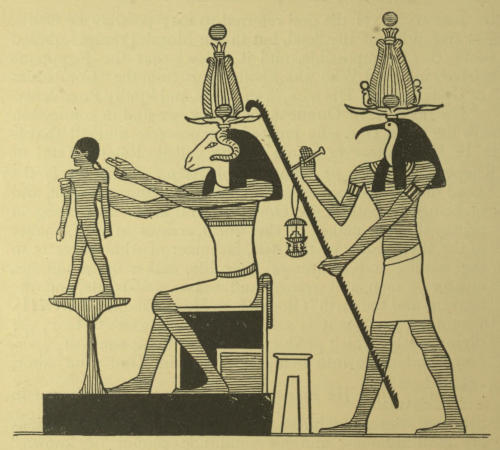
The god Khnemu fashioning a man on a potter’s wheel which he works with his foot. Behind stands Thoth, marking the years of his life on a notched palm branch.
Creation of gods.—According to the priests of On, the god Kheperȧ, a form of Rā, who was self-begotten and self-produced, fashioned a god and a goddess out of the matter of his own body, and these became the parents of a number of other gods and goddesses, e.g., Osiris and Isis, Set and Nephthys, Horus and Anubis, etc. The priests of Hermopolis declared that Thoth was the primeval god, and that the gods he created were Nu and Nut, Ḥeḥu[136] and Ḥeḥut, Kekui and Kekuit, Ḳerḥ and Ḳerḥit. The first pair represent the watery mass out of which everything came; the second, indefinite time, or eternity; the third, darkness; and the fourth, night. The priests of Saïs taught that their goddess Net (Neith) was self-begotten and self-produced, that she was the mother of Rā, the Sun-god, and at the same time a virgin-goddess.
Creation of men.—According to a very old legend, mankind was divided into four races: 1. Reth, or Remt, i.e., “Men,” 𓂋𓍿𓀀𓁐𓏪; these were the Egyptians. 2. Āamu 𓌙𓅓𓅱𓏪, or the peoples of the Eastern Desert. 3. Themeḥu 𓍿𓎖𓅱𓏪, i.e., the Libyans. 4. Neḥesu 𓅘𓎛𓋴𓅱𓏪, i.e., the black and brown peoples, and Negroes and Negroids, of the Sûdân. The Egyptians or “Men,” were formed out of the tears which fell from the Eye of Rā; these dropped upon the members of his body and then turned into men and women. The Libyans came into being through some act of the Sun-god in connection with his Eye, and the Āamu and the Neḥesu were descended irregularly from Rā. Another legend declared that man was made out of potters’ mud on a wheel by Khnemu, the ram-headed god of Philae.
Destruction of mankind.—After Rā had been reigning for a considerable time, men and women began to speak contemptuously of him, and to blaspheme him. Rā assembled the gods and took counsel with them, and, as the result, he sent forth his Eye among mankind in the form of the goddess Hathor, who destroyed men from off the earth with the exception of a small company. The goddess Sekhet assisted in the slaughter, and for several days wandered about Egypt wading in pools of men’s blood. At length Rā was appeased, and he stopped the work of slaughter; but he was weary of man, and determined to withdraw himself from the management of his affairs. After taking further counsel with the gods he retreated to a newly-constituted portion of heaven, and created there the Sekhet-ḥetepet, or Elysian Fields.
According to another legend preserved in the CLXXVth Chapter of the Book of the Dead (Papyrus of Ani, No. 10,470), a general destruction of mankind was caused by the Flood, which was brought upon the world by the god Temu, who announced his intention of destroying everything in it, and of[137] covering the earth with the waters of the primeval ocean Nu. The flood appears to have begun at Ḥenensu, in Upper Egypt, the Khânês of Isaiah xxx, 4, and the Herakleopolis of the Greeks, and to have submerged all Egypt. All life was destroyed, and the only beings who survived were those who were in the “Boat of Millions of Years,” i.e., the Ark of the Sun-god, with the god Temu. The mutilated state of a large portion of the text makes it impossible to piece the details together, but it seems that, after the earth was covered by the Flood, Temu sailed over the waters to the Island of Flame, and took up his abode there. Subsequently he was succeeded by Osiris, whose authority was disputed by Set, the god of evil; but eventually Set was overthrown, and Osiris ruled triumphantly.
The Legend of Horus and Set.—In very early times legends were current concerning the great fight which took place between Horus the Great, the Sun-god, the god of day, light, life, and of all physical and moral good, and Set, the god of night, darkness, death, and of all physical and moral evil. Set succeeded in carrying off the Eye of Horus, i.e., the Sun, and tried to devour it, but the Eye of Horus inflicted a deadly wound on Set, and cut off and carried away one of his thighs. At length Thoth, the intelligence of Rā, interfered, and made an arrangement between the two combatant gods, whereby the day (Horus) was to be a certain length, and the night (Set) likewise, and neither was to destroy the other. Because of this decision Thoth was called “Ȧp reḥui,” or “Judge of the Combatants.” Now the moon was the second, or left, eye of Horus the Great, and it was much persecuted by Set during fourteen nights of every month. Each night Set succeeded in cutting off a piece from it, and at length no moon was left. Thoth, however, made new moons, which he placed in the sky month by month, and thus frustrated the evil deeds of Set. On one occasion Set was wandering about the sky in the evening and found there the crescent, or new moon, which he immediately swallowed, but he was eventually made to disgorge it by Thoth, who was watching over it. At a later period, when the moon was identified with Osiris, the enmity of Set was transferred to Osiris, and the legend entered upon a new phase; Osiris became the symbol of moral good, and Set of moral evil and wickedness.
The views held by the Egyptians about Osiris from about B.C. 3800 to the Roman Period may be thus summarized:—Legend of Osiris.—Osiris, in Egyptian Ȧsȧr[138] 𓁹𓊨, was once a king who reigned in the south of Egypt; his sister-wife was called Isis, in Egyptian Ȧst 𓊨𓏏, and their son Horus, in Egyptian Ḥeru 𓅃. He did great good to all his people, and taught them the arts of agriculture, and made good laws for them, and ruled them justly. Now Osiris had a twin brother called Set 𓊃𓏏𓈜, the Sêth of Plutarch, who was very jealous of him, and who lost no opportunity of undermining his authority and reviling him, for he wished to see Osiris removed from his path, so that he might seize his brother’s throne and wife. At length, by a stratagem, he managed to kill Osiris, by drowning him in the Nile. The river, however, carried the dead body of Osiris to the papyrus swamps in the Delta, where the waters deposited it on the lower branches of an acacia tree, which grew up round it and concealed it. Isis discovered, by magical means, where her husband’s body was, and went to the place and took possession of it. Wishing to visit her son Horus, so that she might urge him to take vengeance on Set, she hid the body in a secret spot, and went off to the city of Buto to Horus. During her absence, Set found the body one night when he was out hunting, and recognizing it, he tore it into fourteen pieces, which he scattered about the country. Isis, having heard what Set had done, set out and collected the portions of the body of Osiris, and wherever she found one of them she buried it, and built a shrine over it.

Osiris rising from the sarcophagus with “life” in each hand. On each side are two of the children of Horus.
Now Isis was a great enchantress, and she learned from Thoth the knowledge of magical ceremonies and of most potent words of power. She was able to transform herself into any kind of creature, and to travel through earth, air, fire, or water with equal ease. Instructed by his mother, Horus, with the assistance of a number of his “followers,” performed a series of ceremonies connected with the burial of his father, which had the effect of raising Osiris from the dead, and of establishing him as king in Ȧmenti, i.e., the “Hidden Place,” or the Other World. When this was done, Osiris appeared to Horus and urged him to avenge him on Set, and shortly afterwards a great fight between Horus and Set took place. Set was defeated and, according to the XVIIth Chapter of the Book of the Dead, mutilated by Horus, who suffered no injury whatsoever. The great fight took place near the modern city of Asyûṭ, and lasted three days; each god fought in the form of a wolf or bear. (Fourth Sallier Papyrus in the British Museum.)
The cult of Osiris is as old as Dynastic Egyptian civilization, and, from the earliest to the latest times, he was regarded as the god-man who suffered, died, rose again, and reigned eternally in heaven. He was the “King of eternity, lord of the everlastingness, the prince of gods and men, the god of gods, king of kings, lord of lords, prince of princes, the governor of the world, whose existence is everlasting” (Papyrus of Ani, Plate I). To the Egyptians Osiris was the god who “made men and women to be born again,” 𓄠𓋴𓏏𓍃𓅱𓀀𓁐𓏪𓄙, who made them to rise from the dead, and bestowed upon them everlasting life; he was, in all times, the cause of their resurrection, and was also the resurrection itself. He was both god and man, and could sympathize with them in sickness and death, and the idea of his human personality brought them comfort. The confidence with which men looked to him as a being who knew neither decay nor corruption is best expressed in the words of a text on coffin No. 22,940 (Wall-case No. 40, First Egyptian Room). “Homage to thee, O my father Osiris! Thy flesh suffered no decay, worms touched thee not, thou didst not moulder away, withering came not on thee, and thou didst not suffer corruption; and I shall possess my flesh for ever and ever, I shall not crumble away, I shall not wither, I shall not become corruption.”
The Kingdom of Osiris was situated in Sekhet-ḥetep 𓇏𓏏𓏭𓈇𓏤𓊵𓏏𓊪𓊖, i.e., the “Field of Peace,” a division of Sekhet-Ȧaru, or the “Field of Reeds.” From the pictures of this region given in papyri we see that it was surrounded by a stream of water, and intersected by numerous canals, and, judging by the descriptions given in these pictures, it must have been considered to be a very fertile place. The wheat and the barley there grew to a great height, and plants, vegetables, and fruit trees abounded. The idea of the Sekhet-ḥetep was no doubt suggested by the fertile regions of the Delta and the Oases in the Western Desert.
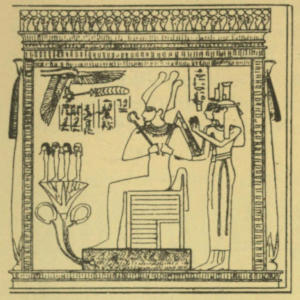
Osiris in his shrine.
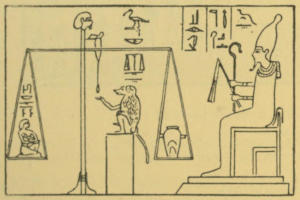
Thoth in the form of an ape weighing the heart in the presence of Osiris.
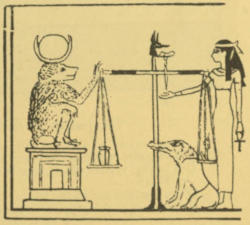
The goddess Maāt weighing the heart in the presence of the ape of Thoth. By her side is the Eater of the Dead.
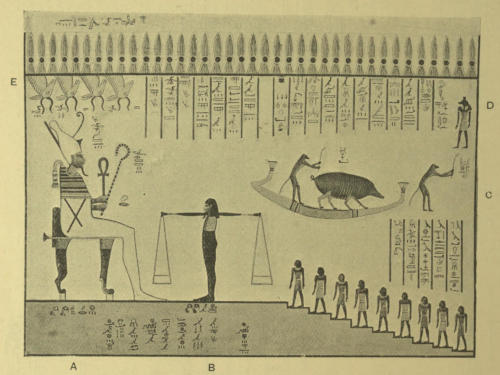
The Judgment of Osiris, from the Book of Gates.
A Osiris seated on a throne with nine steps.
B The scales in which the hearts of the dead were weighed.
C The pig, symbol of evil, in a boat under the charge of an ape, the companion of Thoth.
D Anubis, the god of the tomb.
E Heads of gazelle, typical of the enemies of Osiris.
In one part of this kingdom was placed the Judgment Hall of Osiris, and there sat the great judge of the dead. The soul of every man was brought there and weighed in the “Great Balance” in his presence, by Thoth, the scribe of the gods. The soul was represented by the heart 𓄣, and was weighed against the feather 𓆄, symbolic of righteousness (maāt). If the heart failed to counterbalance the feather it was cast to an animal monster called Ām-mit, i.e., “Eater of the Dead,” which was part crocodile, part lion, and part hippopotamus. When the heart and the feather balanced exactly Thoth announced the[141] fact to the gods of his company, and then the soul of the deceased was taken by Horus into the presence of Osiris, who rewarded him according to his deserts. Before the weighing of the heart took place the deceased was obliged, presumably, to pass along the Hall of Osiris, and to make the Negative Confession before the Two and Forty Assessors of the Dead, “who tried sinners, and fed upon their blood, on the day when the lives of men are reckoned up in the presence of the Good Being” (Osiris). Apparently each of these beings asked him the question: “Hast thou committed such and such a sin”? For his answers, as given in the Book of the Dead (Chapter CXXV), take these forms:—
“Hail, Long-strider, coming from Ȧnnu, I have not committed iniquity.
“Hail, Eater of shades, coming from Qerti, I have not stolen.
“Hail, Bad-face, coming from Re-stau, I have killed neither man nor woman.
“Hail, Flame, advancing and retreating, I have not robbed God.
“Hail, Uamemti, coming from the house of slaughter, I have not committed adultery.
“Hail, Two-horns, coming from Saïs, I have not multiplied words overmuch.”
The forty-two sins enumerated in the Negative Confession represent the chief sins abominated by the Egyptians under the XVIIIth dynasty.
The texts connected with the examination of the dead show that the Egyptian idea of sin was different from that of Western nations. With the Egyptian the commission of sin was regarded merely as a breach of the ritual law, or of the law of the community, and could be atoned for by the payment of goods or possessions; this payment once made, the law-breaker considered that he was free from all obligation, real or moral. The idea of repentance finds no expression in Egyptian texts, and, curiously enough, there is no word in Coptic for “repentance.” The translators of the New Testament from Greek into Coptic were obliged to use the Greek word μετάνοια. From the earliest times the Egyptians appear to have believed firmly that the righteous would be rewarded in the Other World, and the wicked punished, but there is no definite statement on this point in the texts until the XIXth dynasty, when the doctrine of retribution is clearly expressed. In the Second Part of the “Book of Gates” a number of beings are described as “those who worshipped Rā upon earth, who spake words of power against the Evil One (Āpep), who made offerings to Rā, and burnt incense to their own gods.” Other beings are described as “those who spake truth upon earth, and who did not approach false gods” 𓈖𓏏𓂋𓇌𓅪𓏥. In return for this Rā gave to them food and drink which should never fail, and decreed that their souls should never be hacked in pieces. Close by, in the same section of the work, are mentioned the “rebels against Rā, who blasphemed the god when they were upon earth, who thrust aside right, and cursed the god of the horizon.” As punishment for these deeds Rā decreed that they should be bound in chains, that their bodies should be cut in pieces, and their souls destroyed.
The rewards of the righteous were, moreover, graduated, for when Osiris decreed that such and such a soul was to receive an estate in his kingdom, the land measurers of[143] heaven took their measuring ropes with them, and going into the Elysian Fields measured out for those who were deemed righteous plots, which varied in size according to their merits. According to another view the blessed lived always with the Sun-god in his boat, and travelled with him across the sky day by day. The “gods” in heaven spent their lives in ministering to their god Osiris, or Rā, and in performing his commands, and the duty of a certain number of them consisted in singing to him and praising him at dawn and at sunset. The spirits and souls of the righteous, in their glorified bodies, became “beings and messengers” of God, and they sat on the great throne by his side. They wore the finest raiment, and white linen garments and sandals, they ate of the “tree of life” 𓆱𓐍𓏤𓆱𓈖𓋹𓈖𓐍, and sat with the great gods by the side of the Great Lake in the Field of Peace, their bread and drink never grew stale, they neither thirsted nor hungered, and they enjoyed celestial figs and wine. In one portion of the kingdom of Osiris the blessed cultivated the divine plant Maāt, whereon both they and Osiris lived, and eating the same food they became one with him, and shared with him his attributes of divinity, incorruptibility, and immortality.
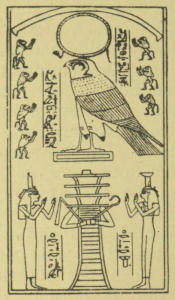
The holy Ape-gods singing hymns of praise to Rā at sunrise.
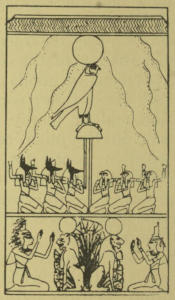
The Jackal-gods and the Hawk-gods singing hymns of praise to Rā at sunset.
The wicked who were in the Other World consisted of two classes: 1. The enemies of Rā, the Sun-god. 2. The[144] enemies of Osiris, i.e., the souls of sinful men and women. The former were gathered together each night and did their utmost to prevent the sun rising morning by morning, but they were always seized by the angels of Rā and dragged by them to the eastern portion of the sky, where they were cast into the fiery caldrons of the god and consumed in their flames. The heavy mists and clouds of the morning represented the smoke of these caldrons, and the red glare of dawn was the reflection of their flames. Opinions differed as to the way in which the enemies of Osiris were disposed of. According to some, those who were condemned in the Judgment were devoured by the monster Ām-mit, the “Eater of the Dead”; but others held that they were dragged to the divine block of doom 𓌩, where they were beheaded by the headsman of Osiris, called Shesmu 𓈚𓊃𓅓𓅱𓀭. Sometimes their bodies were hacked limb from limb by him, and sometimes they were seized upon by the “Watchers,” who “carry slaughtering knives, and have cruel fingers,” and cut the dead into pieces, which were thrown down into pits of fire, or into the great Lake of Fire. Here at one corner sat a monster who swallowed hearts and ate up the dead, himself remaining invisible; his name was “Devourer for millions of years.”
The judgment of souls took place at midnight, and the righteous were rewarded, and the condemned punished before a new day began. The souls of all those who had died during the day were judged that day, and their cases disposed of finally; eternal happiness was decreed for the blessed, and annihilation, not everlasting punishment, for the wicked. In late times there are passages in the texts which suggest that certain souls who set out from this world for the kingdom of Osiris failed to reach it, either because the amulets which were buried with their bodies were not sufficiently powerful, or because their offerings to the gods were too few when they were on earth. There is no evidence that such souls were believed to suffer, or that the portion of the Other World beyond which they had been unable to proceed was a sort of purgatory. They dwelt in darkness during the greater part of each day, but the Sun-god passed among them each night, and spake words on which they lived until the next night; when he departed they wept as the doors of their abode closed on them, and shut him from their sight.
The views of the Egyptians about the position of heaven PET 𓊪𓏏𓇯, and the Other World changed in different periods.
In the earliest times heaven was believed to be situated above
the large, flat rectangular slab of iron (or alabaster?) which
formed the sky. This slab was supported on four pillars,
which were kept in position and presided over by the four
sons of Horus, Mesthȧ, Ḥāpi, Ṭuamutef, and Qebḥsennuf.
These four gods sat on pillars, which, subsequently, were
regarded as the four cardinal points. The stars were
believed to be hung from the slab by hooks through holes,
, like lamps from a ceiling. The righteous ascended to
this heaven by means of a ladder. Osiris himself was
obliged to use a ladder, and Horus and Set held each one
side of the ladder ![[glyph not in Unicode]](images/glyph12.jpg) , and assisted him to mount with their
fingers. The models of ladders and of the two forefingers
which are found in tombs commemorate this event.
, and assisted him to mount with their
fingers. The models of ladders and of the two forefingers
which are found in tombs commemorate this event.
The name given to the Other World was Ṭuat 𓇼𓄿𓏏𓉐. This region was not under the earth, or deep in it, but ran parallel with Egypt, which formed one side of it. A river flowed through the whole length of it. On the other side of the river was a range of mountains, and outside this was the great celestial ocean which surrounded the world. The Ṭuat was a valley which in the XIXth dynasty was believed to begin near Thebes, at Manu, the Mountain of Sunset, and, stretching northwards as far as Saïs, bent round towards the east until it reached the region of Ȧnnu (On), when it turned to the south and continued until it ended at Bakhet, the Mountain of Sunrise. The Ṭuat was divided into ten sections, and had a vestibule at each end of it, and in the XIXth dynasty it included the local kingdoms of the dead of Thebes, Abydos, Herakleopolis, Memphis, Saïs, Bubastis, and Ȧnnu. Each section was guarded by a massive gate, with battlements, but its door flew open before the Sun-god as he traversed the Ṭuat nightly in his boat. According to one legend there was a small passage at Abydos called “Peka,” i.e., the Gap, which connected this world with the Ṭuat; and according to another there was a similar passage at Thebes. Be this as it may, the souls of all those who had died during the day assembled in the passage each evening and endeavoured to obtain a seat in the solar bark as the god passed by. In its passage the boat passed the kingdom of Osiris; those who preferred a[146] material heaven disembarked at that spot, and those who desired to become like Rā and to be with him remained in their places in the boat. For all souls, however, there was an examination of their credentials, and those who were not provided with amulets, and with formulas and words of power, were ejected.
Recognition of Friends.—From the statements made in papyri and on coffins there is no doubt that the Egyptians believed that they would know and recognize each other in the Other World, and would enjoy intercourse with their relatives and friends. In the Papyrus of Ȧnhai (B.C. 1040), we see this lady meeting her father and mother in the Sekhet-ḥetep, or Elysian Fields, and sailing with her husband in a boat on one of the canals; in the Papyrus of Ani (B.C. 1500) we see the deceased seated with his wife Thuthu playing draughts; and the scribe Nebseni (B.C. 1550) says: “I have seen the Osiris (i.e., his father), and I have recognized my mother.” In the Book of the Dead (Chapter LII) the deceased prays: “May my ancestors, and my father and mother be given unto me as guardians of my door, and for the ordering of my territory,” and in Chapter LXVIII he declares that he shall have authority over his workmen and workwomen just as he had upon earth. On a coffin of the XIth dynasty (B.C. 2600) at Cairo the gods Rā, Tem, Seb, and Nut are implored to grant the “gathering together of the ancestors and kinsfolk of Sepȧ in the Other World,” in the following words: “Let him traverse heaven, and earth, and the waters, let him meet his ancestors, and his father, and his mother, and his sons and daughters, and his brethren and his sisters, and his friends both male and female, and those who have been as parents to him (i.e., uncles and aunts), and his kinsfolk (i.e., cousins or connexions), and those who have worked for him on earth, both male and female, and the woman whom he hath loved and known.”[22] In the second[147] portion of the text it is declared that all these shall come forth to meet Sepȧ on his arrival in the Other World, and that they shall bear in their hands their staves, and their mattocks, and their ploughshares, and their clubs, so that in the event of any attack being made upon him by any hostile god, they may deliver their kinsman forthwith.
The use of amulets played a very large part in the Egyptian religion. They were generally made of stones and other materials believed to possess magical properties, which their wearers were supposed to acquire. A fine collection of Egyptian amulets is exhibited in the Fourth Egyptian Room (Table-case F), where examples of every authorized shape and kind will be found. In connexion with these the unrivalled collection of scarabs should be examined (Table-cases D, E, G, I).
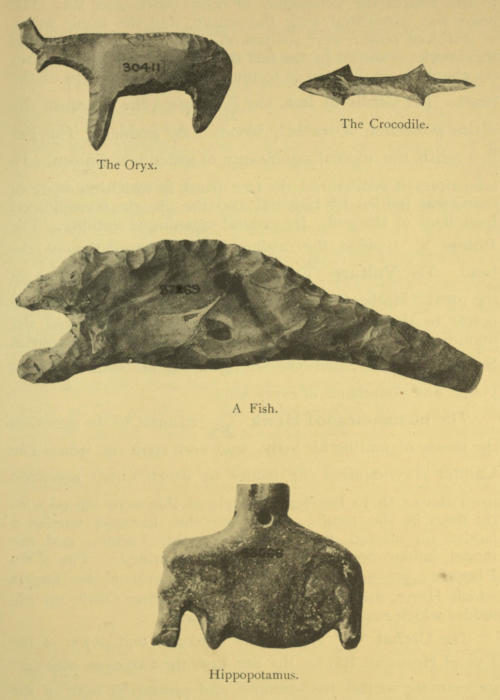
Flint amulets of the Predynastic Period.
The Oryx. The Crocodile. A Fish. Hippopotamus.
[See Table-case M, Third Egyptian Room.]
The following are the principal amulets mentioned in funerary texts or found in tombs with, or on, the bodies of the dead: The scarab, or beetle, kheprer 𓆣𓂋𓂋𓅬, was the symbol of the god Kheperȧ, and represented generation, new life, virility, and resurrection. The Heart, ȧb 𓄣, symbol of the seat of life in the bodies of gods,[149] animals, and men, and emblem of the conscience; it brought to the wearer the protection of both Osiris and Rā. The heart was associated with the scarab, and the same ḥekau, or words of power, were written on both. The importance of this amulet is shown by the fact that in the Book of the Dead six chapters are devoted to formulas for the protection of the heart. The Girdle of Isis, thet 𓎬, assured the wearer of the divine protection of the holy blood of the goddess. The Ṭeṭ 𓊽, a fetish, the original significance of which is unknown. In later times it symbolized the tree trunk in which the body of Osiris was hidden by Isis, and also the upright, consolidated back-bone of the god. Its general meaning is stability. The Pillow 𓊫 typified the raising up and preservation of the head. The Vulture 𓅐 brought with it the protection of the great “Mother” Isis. The Collar gave strength and power to the breast, heart, and lungs, and symbolized the dominion of the wearer over all Egypt. The Papyrus Sceptre 𓇅 represented the strength, vigour, and virility of youth, and abundance of every kind.
The human-headed Hawk ensured to the deceased
the power of uniting his body, soul and spirit at will. The
Ladder ![[glyph not in Unicode]](images/glyph13.jpg) symbolized the ladder by which Osiris ascended
from the earth to heaven. Models of this were buried with
the dead in the tombs, and when the deceased needed a
ladder he uttered the Chapter of the Ladder, and the
model ladder became as long as he wanted. The Two
Fingers
symbolized the ladder by which Osiris ascended
from the earth to heaven. Models of this were buried with
the dead in the tombs, and when the deceased needed a
ladder he uttered the Chapter of the Ladder, and the
model ladder became as long as he wanted. The Two
Fingers ![[glyph not in Unicode]](images/glyph14.jpg) index and medius, represent the fingers
which Horus used when he helped his father Osiris up the
ladder which reached from earth to heaven.
index and medius, represent the fingers
which Horus used when he helped his father Osiris up the
ladder which reached from earth to heaven.
The Utchat 𓂀 typified the strength and power of the Eye of Horus, or Rā, i.e., the Sun-god, the two eyes 𓂀𓑀𓂀 gave to the wearer the strength and protection both of the Sun and Moon. The Ānkh 𓋹, or symbol of “life.” What object this amulet represented is unknown. The Nefer 𓄤, or lute, signified “happiness, good luck,” etc. The[150] Serpent’s Head protected its wearer when alive against snake bite, and when dead against the attacks of worms and serpents in the tomb. The Menȧt 𓋧 represented nutrition, and the union of the male and female powers of nature, generation, etc. The Sma 𓄥 symbolized animal pleasure. The Shen 𓍶 was the emblem of the orbit of the sun in heaven. King Besh, of the IInd dynasty, wrote his name within this circle, which in an elongated form 𓍷 became the cartouche of the later kings. The shen was the symbol of the eternal protection of the name by Rā.
The Steps 𓊍 symbolized the throne of Osiris, and procured for the wearer “exaltation” to and in heaven. The Plumes symbolized Isis and Nephthys, who had their seat on the forehead of Rā, and the Maāti goddesses, or goddesses of Right and Truth. The Frog 𓆏 was typical of teeming life and the resurrection. It was the symbol of the goddess Ḥeqt, the wife of Khnemu, who made the first man on a potter’s wheel, and when laid on a dead person transferred to him the new life which was in the body of the goddess. The Pesesh-Kef suggests the idea of second birth in connexion with the ceremonies of Opening the Mouth. The mouth of the mummy, or of a statue, was touched with this amulet, or instrument, whilst the priest recited words of power; as a result of that the mouth was “opened,” i.e., the deceased could henceforth talk, think, walk, eat, drink, etc., in the Other World. A fine example of this amulet in flint (Table-case M, Third Egyptian Room) of the Neolithic Period proves that the idea of “opening the mouth” is older than the dynasties of Egypt. The Solar Disk on the horizon 𓈌 symbolizes life which renews itself, resurrection, virility, strength, etc. The Neterui 𓊋𓑀𓊋𓑀, or 𓊹𓊹, represent the two iron instruments used in the ceremony of “opening the mouth”; their presence among the swathings of the mummy, or in the tomb, secured for the deceased the protection of the gods of the South and the North.
On rare occasions all the amulets mentioned above have been found in one tomb, or on a single body. A good example of a collection of amulets found on a single body is No. 4 (Table-case K, Fourth Egyptian Room). Here will[151] be seen uraei, the menȧt, the utchat, the scarab, the shen, the triad of Isis, Nephthys, and Harpokrates: the papyrus sceptre, the heart, the plumes, the two fingers, ṭeṭs, etc.; the places on the body on which they were found are indicated by the labels. Another class of amulets is represented by the figures of gods, goddesses, and sacred animals, which were either worn as pendants to necklaces, etc., during life, or placed among the swathings of the mummified body. Of these the British Museum possesses very large collections, and the finest examples of them will be found in Wall-cases Nos. 119-132, in the Third Egyptian Room. A very remarkable group of amulets or objects, which were intended to give protection to the tomb of the priestess for whom they were made, is exhibited in the Second Egyptian Room (Wall-case No. 73). It consists of a Ṭeṭ 𓊽, a human figure 𓀾, a jackal 𓃣, and a reed, and each object stands on a small inscribed brick of Nile mud. The ceremony in which these were used is described in the Book of the Dead (Chapter CXXXVII). The text is only found in the Papyrus of Nu (No. 10,477), and the group of objects which illustrates it appears to be unique.
In connexion with the numerous ceremonies which found a prominent place in the cult of Osiris must be mentioned two classes of magical figures. It has already been said that the righteous who lived in the kingdom of Osiris were employed in the cultivation of the Maāt wheat, on which both they and Osiris lived. Now, before this wheat could be grown, it was assumed that the land of the celestial fields had to be prepared and watered, and renewed with top-dressing, just like the fields on earth. These laborious agricultural works were performed by a celestial corvée, which was under the general control of the “Ḥenbiu,” or gods of the Celestial Domain Lands. These gods provided estates for the blessed, and carefully watched the land measurers to see that they carried out their orders. They also provided gangs of beings to work these fields, and set taskmasters (Tchatchaiu) and time-keepers (Kheru āḥāu) over them, so that they might make them toil their appointed time. Why these beings were condemned to forced labour cannot be explained, for not a word is said which would suggest that they were sinners, and that their work was a punishment. The Egyptian theologians appear to have been incapable of conceiving a heaven in which there was no corvée to perform menial tasks, and equally[152] incapable of imagining the existence of a corvée which did not need the constant supervision of time-keepers and gangers.
Be this as it may, the Egyptians, as a people, hated forced labour, and the priests found a way for them to escape from it. The means chosen was the Shabti, or Ushabti figure.[23] The meaning of the word Ushabti is unknown. Some associate the name with that of the persea tree (shab, or shabt), but others connect it with the word ushab, “to answer,” and think the figure was called Ushabti, because in the text cut upon it the figure “answers” and says: “Verily I am there,” etc. The Ushabti figure was a figure made of wood, stone, porcelain, metal, etc., which was intended to represent the person on whose behalf it was fashioned, and it was supposed to carry a digging tool and a basket in which to remove earth or sand from one place to another. In short, the Ushabti figure is a model of a farm labourer or fallâḥ. On the figure it was customary to cut a formula which was supposed to be said by the deceased in the Other World, to this effect: “In the event of my being condemned to spread dust (i.e., sebakh or top-dressing) on the fields in the Ṭuat, or to fill the water-courses with water from the river, or to reap the harvest, such work shall be performed for me by thee, and no obstacle shall be put in thy way.” Below this formula were cut the words with which the figure was supposed to answer: “Verily I am there, wheresoever thou mayest speak” (or call me). When the deceased found himself in the Other World, and condemned to work in the celestial corvée, he was supposed to utter the words rendered above, and if they had been spoken in a correct tone of voice, the figure would change into a full-grown man, who was provided with a digging tool and basket, and who was capable of performing field labours.
The dread of forced labour in the minds of the Egyptians resulted in the production of the immense numbers of Ushabti figures which are seen in all great museums. The number found in some tombs is very large; thus, Seti I caused 700 to be buried with him, and, at the present time, there are 149 figures in the Ushabti-box of Ānkh-f-en-Khensu in Wall-case 116, in the Third Egyptian Room. The collection of Ushabti figures in the[153] British Museum (Second Egyptian Room) is unrivalled, and contains fine specimens of every period from about B.C. 2600 to B.C. 600. Worthy of note are the limestone figure of Ȧāḥmes I, the fine diorite figure of king Ȧmen-ḥetep II, the granite figure of Ȧmen-ḥetep III, the porcelain and wooden figures of Seti I, and the figures of Rameses III, Rameses V, Psammetichus I, and Uaḥ-ȧb-Rā (Pharaoh Ḥophra).
Other figures which were highly esteemed as possessing magical powers were those to which the name of Ptaḥ-Seker-Ȧsȧr, or Ptaḥ-Socharis-Osiris, has been given (see Second Egyptian Room, Wall-cases 89-92). Ptaḥ was the creator of the world, according to the doctrine of Memphis; Seker was the god of the Other World of Memphis; and Ȧsȧr, or Osiris, has already been discussed; these three gods were united in the later theology, and the resultant god was regarded as the lord of Heaven, Earth, and the Other World. Figures of this triune god were made of wood, painted or gilded, and fixed on a rectangular stand, in which two cavities were usually hollowed out, one in front of the figure and one at one side. In the cavity in front a little piece of the body of the deceased was placed, and a cover was fitted over it, with a figure of the hawk of Seker 𓅌 upon it; in the cavity in the side of the pedestal a small roll of papyrus inscribed with prayers was inserted. The figure and pedestal were often inscribed with formulas in which the triune god Ptaḥ-Seker-Ȧsȧr was invoked, and it was believed that so long as the portion of the dead body that was in the pedestal of the figure was preserved, the body in the tomb would be kept in its integrity and everlasting life would be assured for the soul. Typical examples of these figures are Nos. 9870 and 9736 (Wall-cases 90 and 91, Second Egyptian Room). Originally the figure on the pedestal was that of Osiris himself, standing upon the symbol of Maāt, or Truth 𓐙; a good example is No. 20,868, which is hollow; it contained the fine copy of the Book of the Dead of the priestess Ȧnhai, which is in the British Museum (No. 10,472, Wall-case 90, Second Egyptian Room).
We have already seen that, after the murder and mutilation of the body of Osiris, the Man-god of the primitive Egyptians, by Set, the god of evil, Horus the son of Osiris, assisted by a number of beings who are called the Followers of Horus, performed a number of magical ceremonies, whereby the rejoining of the limbs of the god was effected, and the preservation of his body was secured for ever. The Egyptians[154] argued: Certain ceremonies were performed by Horus on the dead body of Osiris, and he was mummified, and as a result he rose from the dead; we therefore will have the ceremonies which were performed over Osiris performed over our dead bodies, which shall be mummified, as was the body of Osiris, and we also shall rise from the dead. Every Egyptian from the time of the IVth dynasty, about B.C. 3600, believed that his existence in the Other World depended upon the mummification of his body in this world, and during his lifetime he made provision for his embalmment, and, when his means permitted, prepared a tomb in which his mummified body should be placed. Now the Egyptian had several reasons for mummifying the dead: 1. He wished the souls of the dead to enjoy everlasting life. 2. He wished to maintain dwelling places for the Kau or “doubles” of the dead, so that they might not be obliged to wander about in the deserts in search of food. 3. He wished the dead to form a bond of union between the gods and himself. 4. He believed that the soul came back to the body from time to time. 5. He believed in the resurrection of the material body itself, and that at some future time it would be united to its soul for all eternity. This last was the chief reason why he preserved the body with spices, unguents, bitumen, etc., and, in spite of the very high state of civilization to which the Egyptians attained, the belief in the supreme importance of mummification was never wholly eradicated from the minds of ordinary folk, even after they had embraced Christianity.
In the most primitive times the dead were mutilated to prevent their returning to their native places to live upon the food needed for the living, but in the Dynastic Period the utmost care was taken to prevent the mutilation of the body, and to preserve it from destruction caused by damp, dry rot, or worms. The texts state plainly that after the resurrection the body was to live upon earth, whilst the soul dwelt in heaven. In the Vth dynasty it was written: “The soul belongeth to heaven, and the body to earth,” and in the VIth dynasty it is said to king Pepi: “Thy essence belongeth to heaven, and thy body belongeth to earth.” The same idea occurs in all dynasties down to the Ptolemaïc Period, when we find in the “Lamentations of Isis” the words addressed to the deceased, who is identified with Osiris: “Heaven hath thy soul, and earth hath thy body.”
Before an account of the process of mummification is given, it will be well to note briefly the views[155] which the Egyptians held as to the relationship of the component parts of the material and spiritual man. Most peoples have divided man into three parts, body, soul, and spirit; but the Egyptian system of the human economy was more complex. The material part of a man was the khat 𓏏𓐎, or body. Through mummification, and the prayers which were recited over it after that process, the body obtained a degree of knowledge, and power, and glory, whereby it became henceforth lasting and incorruptible. This glorified body was called a Sāḥu 𓊃𓂝𓎛𓅱𓋩. When a man was born into the world there was also born with him an abstract individuality, or personality, which remained with him all the days of his life, and could only be separated permanently from him by death. To this personality is given the name Ka 𓂓𓏤, a word which has been translated by “double, genius, image, character, person, self,” etc.
When the Ka left the body at death it was necessary for the living to find a habitation, and to provide meat, and drink, and shelter for it. Otherwise it would be obliged to wander about in search of food, and if it failed to find it, would return and wreak vengeance on the living. Provision was therefore made for the Ka in the tomb of the dead person of whom it had once formed a part. First a statue was made in stone, or wood, and fashioned to represent the deceased. Over this a long series of ceremonies was performed, and at the end of them the deceased was declared to have obtained the powers of talking, thinking, walking, etc., and the statue was supposed to be in a fit state to receive the Ka should it be pleased to enter into it and dwell there. A special chamber was set apart in the tomb for the statue, and through an opening in one of the walls which communicated with the hall of the tomb wherein the offerings were made, the Ka inhabiting this statue was able to enjoy the smell of the incense, meat, wine, and other offerings. It had power to leave the statue and to wander about at will on earth and in the Other World; and there are suggestions in the texts that it might take up its abode in the body of a living man from which his Ka had temporarily gone forth for some purpose of its own.
With the Ka was closely connected the Ȧb 𓄣𓏤, or heart, which was regarded as the seat of life and the source of the[156] emotions; it possessed two phases, one material and the other spiritual. It corresponds with the “dual soul” of many tribes in the Sûdân at the present day. The spiritual heart could be stolen from a man by the exercise of magical powers; and this belief survives among certain peoples in Central Africa at the present day. Another attribute of a man was the Sekhem 𓋴𓐍𓅓𓌂, or vital power, which was intimately connected with the Ka, and seems to have possessed a form similar to it. The mental and spiritual attributes of man were grouped in the Khu 𓐍𓅜𓅱, the exact meaning of which it is very hard to define. The Khu seems to have been a shining, translucent, transparent, intangible essence of a man, and the word is on the whole perhaps best rendered by spirit. The Khu escaped from the tomb and made its way to heaven, where it joined the “imperishable spirits” who lived with Rā. It is probable that the Sāḥu, Ȧb, Sekhem, and Khu were all attributes of the Ka.
That part of a man which was, beyond all doubt, believed to be everlasting and to enjoy eternal existence in heaven in a state of glory, was the Ba 𓅡𓏤, or soul; it was associated with the Ka, and, like the heart, appears to have possessed a dual nature. It could live in a state of invisibility, and yet could take form at pleasure; it is often depicted as a human-headed hawk, 𓏤. The object of all the ceremonies which were performed over the mummy or the statue in the tomb was to bring back the soul from heaven to the body in which it dwelt on earth, and when the priest told the kinsfolk of the deceased that “Horus had recovered his eye,” i.e., that the soul had returned to the body, they felt that everlasting life and happiness were secured for him. The souls of the blessed lived with the “spirits” in the heaven of Rā, and when they appeared in the sky they did so under the form of stars.
The soul was usually accompanied by the Khaibit 𓋼𓏤𓏏, or shadow, which may be compared with the σκία of the Greeks, and the umbra of the Romans. It had an independent existence, and was able to separate itself from the body at will, but hostile fiends might attack it, and therefore the deceased prays in the Book of the Dead[157] (Chapter XCII): “Let not be shut in my soul, let not be fettered my shadow, let a way be opened for my soul and for my shadow, and let them see the Great God.” It is very difficult to know where the functions of each of these parts of a man began and ended, for even the Egyptians became confused in dealing with them, and the texts often contradict each other. The main facts are, however, quite clear. The Egyptians believed in the existence of body, double, spirit, soul, and shadow, at all periods, and the views which they held about each are best understood by reference to the religious beliefs which exist at the present time among the A-Zandê, or Nyam-Nyam, the Bantu, the Mañbattu, and cognate tribes in Central Africa. Under the influence of foreigners the primitive views became modified as time went on, but in all essentials the Egyptians who served under the Romans believed what their ancestors believed 5,000 years before.
Mummy is the name given to the body of a human being, or creature, which has been preserved from decay by means of spices, gums, natron, bitumen, etc.; strictly speaking it should only be given to the body preserved by bitumen, for “mummy” is derived from a word which appears in Arabic under the form mûmîâ, and means “bitumen.” The oldest preserved bodies known were prepared with salt and soda, and bitumen was certainly not used on a large scale for embalming purposes before the XXIInd dynasty, about B.C. 900. The embalmed body, swathed in linen, was called by the Egyptians qes 𓈎𓊃𓀾, 𓈎𓊃𓌟𓍱, or qesȧu 𓈎𓊃𓇋𓅱𓀿𓑀𓍱, which has passed into Coptic under the form kôs. The word “mummy” is not of Egyptian origin.
In the latter part of the Neolithic Period the Egyptians, in some places at least, decapitated and dismembered the dead, but subsequently, probably as a result of change in religious thought, they took steps to preserve them. At first bodies were merely dried in the sun, and then placed in a hole in the ground, in a sitting position, just as they are to this day by the A-Zandê; later they were laid on one side, with the legs bent upwards, and their knees near the chin. Evisceration of some kind appears to have been practised, but not of a very elaborate character. The finest and most complete example of the class of preserved bodies which were buried in a crouching position is exhibited in the First Egyptian Room, Case A. Here we see, lying on his left side, a Predynastic Egyptian, with hair of a reddish tint; the knees are bent to a level with the top of the breast, and the hands are placed before the face. He was dolichocephalic, or long-headed, and he was both physically and mentally entirely different from the Dynastic Egyptians, whose skulls, in respect of measurements, occupy a middle position between the dolichocephalic and the brachycephalic, or[159] short-headed. Round about the body are vessels which held food, flint weapons, etc. At this period the body was sometimes wrapped in the skin of some animal, or rolled up in a reed mat.
Soon after the beginning of the Dynastic Period, probably as the result of the growth and development of the cult of Osiris, the Egyptians began to devote more care to the preservation of the bodies of the dead, and the earliest known examples prove that the brain and viscerae were removed, and that the placing of bodies in a crouching position in graves was abandoned, at all events among the ruling classes. The doctrine of Osiris taught that the human body was a precious thing, and men took care to embalm it and swathe it in linen, so that it might be ready for the return of the soul to it, when it would begin a new life in the kingdom of Osiris.
The Egyptian texts supply no details of the methods employed in embalmment, but classical writers describe the processes at some length, and the mummies which have been unrolled and examined prove that their statements are on the whole correct. According to Herodotus (ii, 85) there were three methods of embalming in use in his time. In the first or most expensive way, the brains and viscerae were removed from the body, which was carefully washed with palm wine, and then sprinkled with powdered spices. The cavities in the head and body were next filled with pounded myrrh, cassia, etc., and the opening in the abdomen through which the viscerae were taken out was sewed up. A tank containing a solution of salt, or soda, was prepared, and the body was steeped in it for seventy days. At the end of this period it was taken out of the solution, dried, and anointed with sweet-smelling unguents; then the swathing with linen strips was begun. Sometimes, in the case of women, the cheeks and lips were painted, the eye-lids smeared with eye-paint, and other attempts made to give to the face the semblance of life before swathing. The fingers and toes were each swathed separately, then the legs and arms, and finally, when pads and wads of linen had been fixed in various places to keep the swathings in position, and to give to the mummy the traditional form of the mummy of Osiris, the body and head were wrapped up in large sheets of linen, which were held in place by stout bands. As each swathing was placed on the body, a priest who was specially appointed said the formula which applied to it, and in cases where a large number of amulets were used, these objects, which were[160] intended to give to the mummy the protection of the various gods, were inserted, under his directions, in their proper places between the swathings. When the swathing of the body was ended, the name of the deceased was usually written in ink on one of the outer coverings.
In the second method of embalming, the viscerae were removed by means of oil of cedar, and the flesh was dissolved off the bones by a preparation of soda; mummies which were prepared by this process consist of nothing but skin and bone. The third method was used almost exclusively for the poor; the body was steeped in a preparation of soda for a period of seventy days, and then handed over to the relatives for burial. The period which elapsed between death and burial varied in length. From the inscriptions we learn that in one case the embalming lasted 16 days, the swathing in linen 35 days, and the burial 70 days, i.e., 121 days in all. In another, the embalming occupied 66 days, the preparations for burial 4 days, and the burial 26 days, in all 96 days. According to the Bible (Genesis l, 3), the embalming of Jacob occupied 40 days, but the period of mourning was 70 days. Certain stelae in the British Museum[24] mention 70 days, and we may assume that this period was commonly observed, at all events, in Graeco-Roman times.
Cost of embalming.—According to Diodorus, who lived about B.C. 40, the methods of embalming were three in number; the first cost one talent of silver, about £250; the second, twenty minae, about £60; and the third very little indeed. In the description of the first method given both by Herodotus and Diodorus, it is said that the intestines were removed from the body previous to embalming, but neither writer says what was done with them afterwards. We know, however, that they were cleansed, and wrapped in linen with powdered spices, salt, etc., and placed in a series of four jars, or vases, to which modern writers have given the name Canopic Jars. They were thus named by the early Egyptologists, who believed that in them they saw some confirmation of the legend handed down by certain ancient writers to the effect that Canopus, the pilot of Menelaus, who is said to have been buried at Canopus, in Egypt, was worshipped there under the form of a jar with small feet, a thin neck, a swollen body, and a round back. Each “Canopic” jar was dedicated to one of the four sons of Horus, or sons of Osiris, who were also the gods of the[161] four cardinal points; and each jar was provided with a lid made in the shape of the head of the deity to whom it was dedicated. The names of the four gods were:—
1. Mesthȧ 𓅓𓋴𓍘𓇋𓀭, or Ȧmset 𓇋𓅓𓋴𓏏𓀭; he was man-headed.
2. Ḥāpi 𓐑𓊪𓇌𓀭; he was dog-headed.
3. Ṭuamutef 𓇼𓅐𓏏𓆑𓀭; he was jackal-headed.
4. Qebḥsennuf 𓈎𓃀𓎛𓏁𓈗𓌣𓌣𓌣𓆑𓀭; he was hawk-headed.
These gods represented the south, north, east, and west respectively, and the goddesses with whom they were associated were Isis, Nephthys, Neith, and Serqet. Mesthȧ protected the stomach and large intestines; Ḥāpi, the small intestines; Ṭuamutef the lungs and heart; and Qebḥsennuf the liver and gall bladder. The custom of mummifying the intestines separately is as old as the VIth dynasty at least, and the gods of the cardinal points who presided over them are mentioned several times in the texts of Unȧs, Pepi, and other kings of the Vth and VIth dynasties. The four jars were usually placed in a coffer, or chest, specially prepared for the purpose; and this is frequently depicted in representations of funeral processions. The Ani Papyrus shows the four sons of Horus standing by the coffer containing the mummified intestines of the deceased, and his renewed body rising through the cover of it, holding “life” 𓋹 in each hand (see page 138). Among the fine collection of “Canopic” jars in the British Museum may be specially mentioned the set made for Ḳua-ṭep, XIth dynasty, No. 30,838 (Third Egyptian Room, Wall-case No. 112), and the sets Nos. 22,374-7, and 9562-5, of the later period, in Wall-cases Nos. 74 and 75 (Second Egyptian Room).
The custom of mummifying the dead appears to have been unknown in the Predynastic Period. In the earliest attempts made to preserve the body, the plan followed was to remove the intestines, and then to dry it in the sun, or to rub it with salt. The skulls found in the tombs are usually empty, a fact which proves that the embalmers were able to remove the brain and membranes without injury to the bridge of the[162] nose; sometimes they contain bitumen, or some kind of resin, which must have been introduced into them by the way through which the brains were extracted, i.e., through the nostrils. Mummies cured with unguents and spices do not last long when unrolled; the skin of those cured with natron, i.e., a mixture of carbonate, sulphate, and muriate of soda, is hard, and comparatively durable, but it hangs loosely from the bones, which are white and somewhat friable; bodies from which the intestines have been removed, and which have been preserved by being filled with bitumen, are quite black and hard, and practically speaking, last for ever. The dead poor were sometimes merely salted and laid in a common pit or cave. At one period the dead were embalmed in honey: the treatment of the child who was found in a sealed jar of honey, mentioned by the Muḥammadan writer ʿAbd al-Laṭîf, and the body of Alexander the Great being well-known instances of the custom.
Under, or soon after the XXVIth dynasty, the Egyptians began to place their mummified dead in brightly painted cartonnage cases, decorated with inscriptions containing the pedigree of the deceased, religious texts, figures of gods, etc., and to set them upright in the halls of their houses. The faces were painted to resemble those of the dead, and attempts were made to reproduce the natural colour of their skins, hair, and eyes, and even to represent small physical peculiarities. A man’s immediate ancestors formed a part of his household.
About the beginning of the Graeco-Roman Period, or in the first century after Christ, it became the custom among the ruling class in Egypt to insert painted portraits of the dead in the linen swathings over their faces. Specimens of such portraits may be seen in Case Y in the Second Egyptian Room, and in Wall-cases Nos. 70 and 71. A century or two later further attempts were made to abolish from mummies the funerary swathings, etc., and the dead were placed in papyrus cases, which were moulded to their forms, and were painted with coloured representations of their clothes and ornaments. Very fine examples of such painted papyrus cases are exhibited in Wall-cases 64 and 65 in the First Egyptian Room, and they are of special interest as showing what kinds of garments and jewellery were worn by the Graeco-Egyptian ladies of Egypt, and how they were decorated. In the case of men, painted portraits were inserted over the faces, and the rest of the mummy was covered with plaster, usually coloured pink or[163] red, and ornamented with faulty imitations of the scenes found on the old cartonnage cases. The best example of this kind of mummy is that of Artemidorus, exhibited in Wall-case 63 in the First Egyptian Room. The figures of the gods, etc., are painted in gold, and the mistakes in them prove that the artist did not understand the signification of the scenes which he was copying. The old theology of Egypt was forgotten, the meanings of the old funerary texts and scenes were lost, and the artist found himself obliged to use the form of address to the dead customary among the Greeks, i.e., “O Artemidorus, farewell!”
The Egyptians, even after their conversion to Christianity, continued for a time to mummify their dead, and to bury them with the old ceremonies; but before the end of the third century A.D. the art of embalmment had fallen into general disuse. The pagan Egyptian embalmed his dead because he believed that the “perfect soul” would return to the body after death, and that it would enter upon a new life in it; he therefore took pains to preserve the body against the corruption of the grave. The Christian Egyptian believed that at the Resurrection he would receive back his body, changed and incorruptible, and that it was unnecessary for him to preserve by means of spices and unguents that which he would obtain, without any trouble on his part, by faith through Christ. Little by little, as a result of this belief, the observance of the old pagan ceremonies ceased, and with them embalmment in the Egyptian fashion. The views which Anthony the “Father of the Monks of the Egyptian desert” (A.D. 250-355), held on this matter are of importance. According to Athanasius: “The Egyptians were in the habit of taking the dead bodies of righteous men, and especially those of the blessed martyrs, and of embalming them and placing them, not in graves, but on biers in their houses, for they thought that by so doing they were paying honour to them.” Anthony besought the Bishops to preach to the people, and to command them to cease from this habit, and he showed “That it was a transgression of a command for a man not to hide in the ground the bodies of those who were dead, even though they were righteous men. Therefore many hearkened and were persuaded not to do so, and they laid their dead in the ground, and buried them therein.” When he was dying he entreated his monks, saying: “Permit no man to take my body and carry it into Egypt, lest according to the custom which they have, they embalm me and lay me up in their houses.... And ye know that I[164] have continually made exhortation concerning this thing and begged that it should not be done, and ye well know how much I have blamed those who observed this custom. Dig a grave then, and bury me therein, and hide my body under the earth, and let these my words be observed carefully by you, and tell ye no man where ye lay me until the Resurrection of the Dead, when I shall receive this body without corruption from the Saviour.” (See The Life of Anthony, by Athanasius, in Migne Patrologiae, Ser. Graec., tom. XXVI, col. 972.)
The linen mummy swathings must now be mentioned. These were made from flax, and were of various thicknesses. Surviving examples vary in length from a few inches to about 15 feet, and in width from 2 to 10 inches; some are made with fringe at each end. Mummies are often found wrapped in linen sheets, several feet square, and the outside covering of all is sometimes of a purple or salmon colour. Under the Ancient Empire, mummy swathings were quite plain, but under the Middle Empire, blue stripes occasionally appear at the ends, and the sheets in which the mummies of kings were wrapped, e.g., Ȧmenḥetep III and Thothmes III, were covered with hieroglyphic texts from the Book of the Dead. At a later period texts in the hieratic character appear on the swathings, accompanied by vignettes drawn in outline. The principal seat of the linen industry in Egypt was Panopolis, the modern Akhmîm, and, at a very early period, the weavers attained to such skill, that in a square inch 540 threads may be counted in the warp and 110 in the woof. About the third century of our era, the mummies of wealthy people were wrapped in “royal cloth” made wholly of silk and decorated with figures of gods, animals, etc. The visitor will find a large collection of mummy swathings and sheets exhibited in Table-case E, in the Third Egyptian Room. Here are the fringed linen winding-sheet of Teḥuti-sat, a singing woman of Queen Ȧāḥmes-nefert-ȧri, B.C. 1550 (No. 1); two swathings inscribed with texts from the Book of the Dead (Nos. 11, 12); a roll of linen inscribed with the names of Piānkhi Seneferef-Rā, B.C. 700 (No. 13); grave shirts from Akhmîm (Nos. 18-27); and specimens of embroidered linen, with figures of saints, etc. (No. 39 ff.); a portion of a Coptic stole embroidered with scenes from the life of Christ, and squares of linen worked with coloured figures of birds (doves?), and the Cross and symbol of “life” 𓋹 within wreaths (Nos. 40-51).
In the same case is a good general collection of reels, spindles and spindle whorls, and carding instruments, etc., used by workers in linen. In Table-case J is a fine collection of pieces of linen ornamented with patterns and designs woven in coloured threads, or worked in wools, from the tombs of Egyptian Christians, dating from A.D. 300 to 900. Of special interest are the squares with figures of Adam and Eve (No. 4), St. George slaying the Dragon (No. 18), and God the Father among the Seraphim (Nos. 21-24). The fine pieces of yellow silk, one with arabesque designs and an Arabic inscription in the Kûfî character, are remarkable (Nos. 25-27). Of bier-cloths, the finest example in Europe is probably that seen in Wall-cases 70 and 71, in the Second Egyptian Room. This cloth is embroidered in coloured wools, with a frieze of cherubs holding necklaces, baskets of fruit, flowers, etc. In the centre two cherubs are supporting a crown, within which is worked a cross, and the rest of the cloth is ornamented with doves, vases of fruit and flowers, rosettes, etc. It belongs to the period after A.D. 350.
The Egyptian Tomb.—The care taken by the Egyptians to preserve the bodies of their dead would have been in vain if they had not provided secure hiding places for their mummies. The mummy had to be guarded against the attacks of thieves and of wild animals, and placed beyond the reach of the waters of the Inundation. In primitive times the dead of all classes were buried in graves which were dug on the skirts of the desert, in the sandy or rocky soil; this custom was dictated by economical considerations, for the mud soil of the country, every yard of which was cultivated, was too valuable to the living to be devoted to the dead. The graves were usually oval in shape, and comparatively shallow, and they were covered over with slabs and layers of sand (see Case A, First Egyptian Room); it is probable that they were marked by some kind of stone or stake driven into the ground near the head of the grave. The graves, in which bodies were buried in a sitting position, were, of course, deeper than those in which they were laid on their sides. Over the graves of chiefs, huts made of reeds and grass were built, and offerings of food and drink were probably placed in them, as well as in the graves. At a later period mud houses took the place of the reed huts, and, still later, such houses were built of stone. In the Archaïc Period the buildings over the graves of the kings were rectangular in form, and they contained many chambers, wherein, no doubt, the ceremonies connected with the burial[166] of kings were performed, and stores of provisions of all kinds for the use of the deceased were placed. At this time men and women of lower rank were buried in shallow graves, the sides of which were protected with crude bricks, and the poorest folk of all were buried together in pits, which belonged to the community.
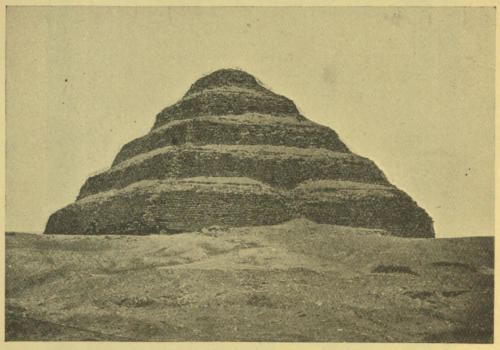
The Step Pyramid at Ṣaḳḳârah.
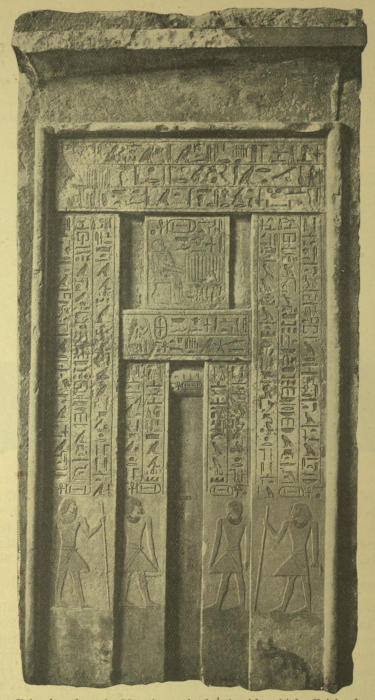
Plate XIV.
False door from the Maṣṭaba tomb of Ȧsȧ-ānkh, a high official, who flourished in the reign of King Ȧssȧ, about B.C. 3400.
[Vestibule, South Wall, No. 53.]
In the IIIrd dynasty, king Tcheser 𓍹𓂋𓍺, whose name a late tradition coupled with a very severe Seven Years’ Famine, built himself, at Ṣaḳḳârah, a magnificent tomb in the form of an oblong pyramidal building with six steps, to which the name of Step Pyramid has been given. Its total height is about 197 feet, and the length of its sides at the base is: south and north 352 feet, east and west 396 feet. A common name for the tomb is Pa tchetta 𓉐𓏤𓆓𓏏𓇾, “House of eternity,” and tombs were endowed with estates by wealthy folk in perpetuity. The commonest form of tomb made for royal personages and nobles at this time, and for several centuries afterwards, was the heavy, massive building of rectangular oblong shape, the four sides of which were four walls symmetrically inclined towards their common centre. To this building the name of maṣṭaba, i.e., “bench,” has been given.[167] It was thus called by the Arabs, because all the examples with which they were familiar, being more than half buried in sand, resembled the long low seats which are common in oriental houses. The exterior surfaces of the maṣṭaba are not flat, for the face of each course of masonry, formed of stones laid vertically, is a little behind the one beneath it, and if these recesses were a little deeper, the external appearance of each side of the building would resemble a flight of steps. The height of the maṣṭaba varies from 13 feet to 30 feet, the length from 26 feet to 170 feet, and the width from 20 feet to 86 feet. The plan of the maṣṭaba is an oblong rectangle, and the greater axis of the rectangle is usually in the direction from south to north. Maṣṭabas were arranged in rows symmetrically on all sides of the Pyramids at Gîzah. The maṣṭabas at Ṣaḳḳârah are built of stone and brick. The entrance to the maṣṭaba is usually on the east side. Near the north-east corner is sometimes found a series of long vertical grooves, or a “false door” (see Plate XIV), which is sometimes called the stele. Near the south-east corner is generally another opening, but larger and more carefully made; in this is sometimes found a fine inscribed limestone false door, and sometimes a small architectural façade, in the centre of which is a door. The top of the maṣṭaba is quite flat.
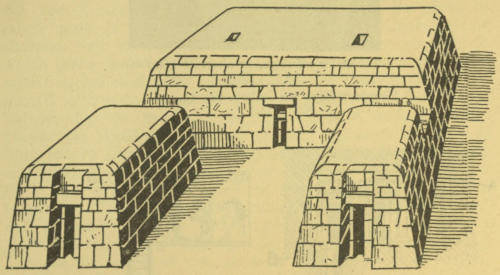
A group of Maṣṭaba tombs at Ṣaḳḳârah.
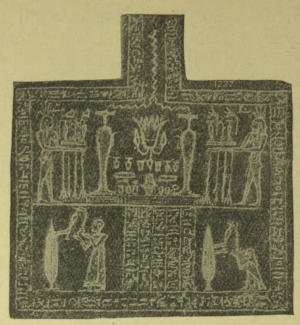
Tablet for offerings, or altar, of Ḥeru-sa-Ȧst, a scribe.
[Southern Egyptian Gallery, Bay 14, No. 1034.]
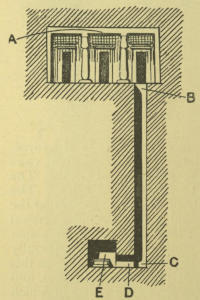
An Egyptian tomb of the maṣṭaba class.
A.—The hall of the tomb in which offerings were made.
B, C.—The pit, or shaft, leading to the mummy chamber.
D.—A small corridor.
E.—The mummy chamber.
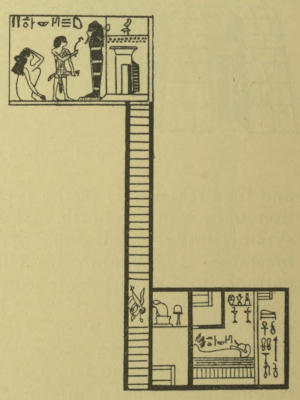
The soul, in the form of a human-headed bird, descending the pit of the tomb to visit the mummy in the mummy chamber.
The interior of the complete maṣṭaba consists of: 1. A chamber. 2. The Serdâb. 3. A pit. 4. A mummy-chamber. The walls of the maṣṭaba chamber may be ornamented with sculptures or not. In it, facing the east, is a false door, which is usually inscribed. At the foot of the false door, on the bare ground, is often seen a tablet for offerings, made of granite, alabaster, limestone, etc., on which are sculptured figures of meat and drink offerings—cakes, loaves of bread, geese, a haunch of beef, vases of unguents, fruit, vegetables, flowers, etc. In many tablets for offerings small tanks, or hollows, with channels, are cut, and in these libations of wine were supposed to be poured. A large collection of such tablets for offerings of all periods, from the IVth dynasty to the Roman Period, is exhibited in the Egyptian Gallery, Bays 14 and 16. Sometimes a pair of stands for offerings, made of stone, is found by the stele; examples of these are exhibited in Wall-case No. 200, in the Fourth Egyptian Room. In the south or north wall of the maṣṭaba chamber is usually a narrow chamber built of large stones, partly hidden in the masonry, to which the name of Serdâb[25] has been given. Sometimes the serdâb is isolated from the chamber, but usually it is connected with it by means of a rectangular passage, or slit, so narrow that the hand can be inserted in it with difficulty. Inside the serdâb the statue of the deceased, which was intended to serve as a dwelling-place for the Ka, or double, was placed, and the passage was made in order to conduct to it the smoke and smell of the burning incense and offerings. The serdâb is sometimes called the “Ka-chapel,” and persons of means and position generally appointed a “priest of the Ka” to offer up offerings morning and evening. The pit, or shaft, of the maṣṭaba was rectangular, square, or oblong, but never round, and it varied in depth from 40 to 80 feet. It led to the chamber below the ground where the mummy was laid. At the bottom of the pit, on the south side, was an opening into a passage from 4 to 5 feet high; this passage led obliquely to the south-east, in the same direction as the upper chamber, and then expanded on all sides and became the sarcophagus chamber, or mummy chamber. When the dried or mummified body had been placed in the sarcophagus, and the cover of the sarcophagus had been sealed, the pit was filled with stones, mud, and sand, and the deceased was thus preserved from all ordinary chances of disturbance.
The ornamentation of the maṣṭaba consisted of sculptured scenes of three classes: 1. Biographical. 2. Sepulchral. 3. Those referring to the cult of the dead and funerary gifts. In them we see the deceased hunting, fishing, making pleasure[170] excursions by water, listening to music and watching women dance, overseeing building operations, or the work of ploughing, sowing and reaping on his estate, the management of cattle, the bringing of offerings to his tomb, etc. The reader will gain a good idea of the general arrangement of the false doors inside the maṣṭaba chamber, and the painted decorations and sculptures of an ordinary maṣṭaba, by examining the complete monument exhibited in the Assyrian Saloon. This was built originally on the side of a small spur of the mountain near Ṣaḳḳârah for Ur-ȧri-en-Ptaḥ, a royal scribe and councillor who flourished in the reign of Pepi II Nefer-ka-Rā, about B.C. 3100. It is interesting to note that two “false doors” are found on the south wall of this maṣṭaba, one for Ur-ȧri-en-Ptaḥ and one for his wife Khent-kaut-s, and that the former contains a list of names of about ninety canonical offerings. The decorations of maṣṭabas never include figures of gods, or the emblems which at a later period were considered sacred.
The next form of the tomb was the pyramid,[26] which is to all intents and purposes merely a maṣṭaba built on a square base, with the greater part of it above the surface of the ground. It contained a long passage, with a sarcophagus chamber, or mummy chamber, at the end of it. The place of the maṣṭaba chamber was taken by a small temple, or chapel, built outside the pyramid, in which funerary gifts and offerings were made; the pit of the maṣṭaba was represented by a long passage, which sloped either upwards or downwards; and the mummy-chamber in each case was substantially the same. The principal pyramids of Egypt are those of Abû Roâsh, Gîzah, Zâwyet al-ʿAryân, Abû-Ṣîr, Ṣaḳḳârah, Lisht, Dahshûr, Al-Lâhûn, Ḥawârah, and Kulla. In the Egyptian Sûdân there are pyramids at Kurrû, Zûma, Tanḳâsi, Gebel Barkal, Nûrî, and Bagrawîr, but all these are inferior in design and construction to the pyramids of Egypt. The latest of the pyramid tombs in the Sûdân were built probably during the first or second century A.D. by a series of native queens, each of whom bore the name of “Candace.” A great many theories, chiefly of an astronomical character, have been formulated about the Pyramids of Gîzah: but it is now generally thought that they were tombs and nothing else, and there is no evidence to justify us in believing that they[171] were built by any of the Hebrew patriarchs, or that they were the “Granaries of Joseph,” or that they contain chambers filled with gold and precious stones, which have not yet been discovered or cleared out. The kings of the XIIth dynasty followed the example of their predecessors of the Vth and VIth dynasties, and built pyramids for their tombs, but they were on a much smaller scale. The pyramids of Ȧmenemḥāt I and Usertsen I were at Lisht, those of Ȧmenemḥāt II and Usertsen III were at Dahshûr, the pyramid of Usertsen II was at Al-Lâhûn, and that of Ȧmenemḥāt III was at Ḥawârah. Nobles and high officials built pyramidal tombs, usually about 30 feet high, which were supposed to contain the three essential parts of the tomb, the upper chamber, the pit, or shaft, and the mummy chamber; but as a matter of fact, the body was buried in the brickwork which formed the base of such a pyramid; there was no pit, and the pyramid itself represented the upper chamber.
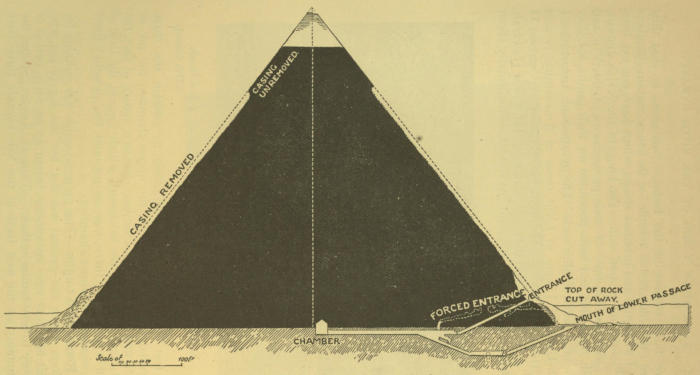
A section of the Second Pyramid of Gîzah, built by Khāfrā (Chephren), showing a piece of the original casing at the top, underground passage, and mummy chamber.
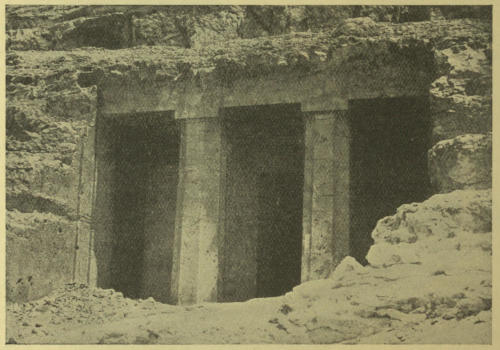
Entrance to the tomb of Khnemu-ḥetep, an official, at Beni Hasan.
XIIth dynasty.

Plate XV.
View of a painted chamber in the tomb of the scribe Nekht.
XVIIIth dynasty, about B.C. 1450.
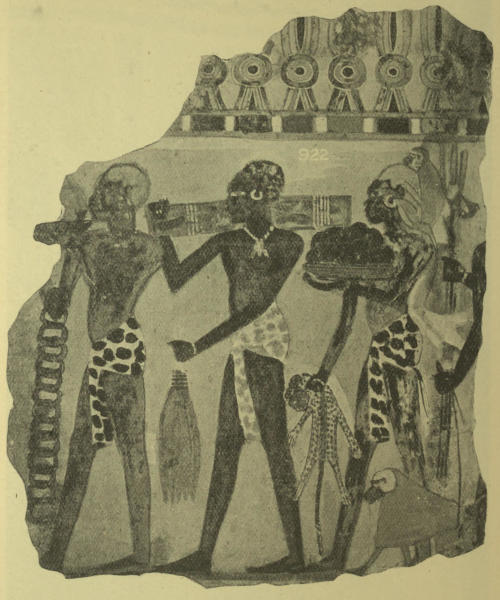
Plate XVI.
Wall-painting from a tomb.
Scene: Payment of tribute. Sûdânî men bearing rings of gold, logs of ebony, panther-skins, apes, etc.
[Northern Egyptian Gallery, Bay 13, No. 520.]
Rock-hewn tombs.—The pyramid tomb was suitable for regions where the ground was flat, but the Egyptians who dwelt in places near mountains began at an early period of history to hew tombs in them. Thus at Aswân (Syene) the mountains on the west bank of the Nile contain three tiers[173] of tombs, the oldest being those of nobles and governors of Elephantine under the VIth and VIIth dynasties. These are approached by means of a staircase cut in the slope of the hill, down the middle of which a smooth path was made for the purpose of drawing up the coffins and sarcophagi of the dead. At the top of the staircase the hill was scarped, and here the chambers of the tombs were hewn. The “false doors” were cut in the solid rock, and were above the mouth of the shaft, or pit, at the bottom of which, in chambers made for the purpose, the mummies were placed. Some of the tombs of the XIIth dynasty on the north side of the hill have long corridors leading to the mouths of the pits, and above these are the “false doors,” before which statues were sometimes placed.
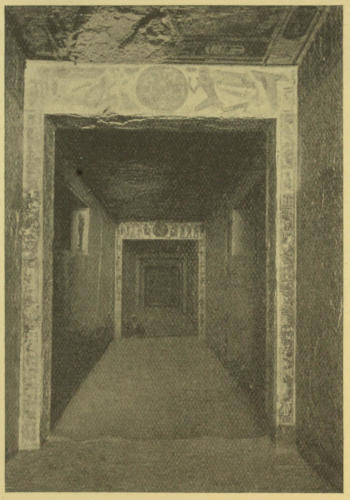
Entrance to a royal tomb in the Valley of the Tombs of the Kings.
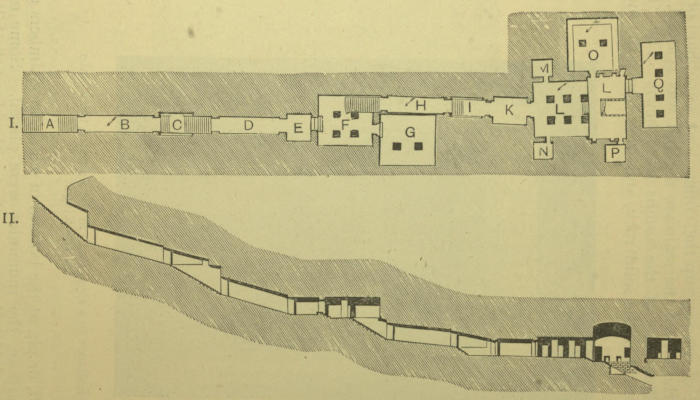
I. Ground Plan of the Tomb of Seti I, B.C. 1366.
II. Section of the Tomb of Seti I.
(From Lepsius, Denkmäler, Abth. I, Bl. 96.)
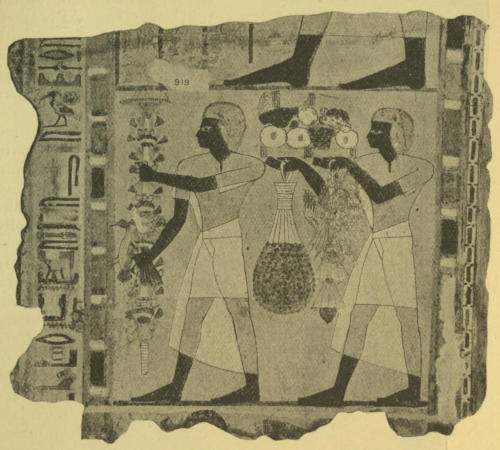
Wall-painting from a tomb.
Scene: Servants of a high official bearing offerings to the tomb.
[Northern Egyptian Gallery, Bay 12, No. 517.]
Under the XVIIIth dynasty rock-hewn tombs of great size were made, and the finest examples of these are undoubtedly the Tombs of the Kings at Thebes. The annexed plan and section of the tomb of Seti I will give an idea of the extent of the largest of them. A is a flight of steps, B a corridor, C a second flight of steps, D a corridor, E, F, and G are rectangular chambers, H and I corridors, K an ante-chamber, L the large six-pillared hall in which stood the king’s sarcophagus and mummy, and M, N, O, P, Q are chambers in which funerary ceremonies were performed. Under the sarcophagus is another staircase, which[175] leads to an unfinished passage, its entrance being about 150 feet below the entrance to the first staircase; the total length of the tomb is about 700 feet. The walls of the corridors and of most of the chambers are decorated with hieroglyphic texts and vignettes which illustrate mythological legends and the funerary ceremonies, all painted in bright colours, and on the roof of the great hall are painted lists of the thirty-six Dekans and other stars, and several figures of solar and stellar gods. The Tombs of the Kings were all built on practically one and the same plan; the modifications which are found in the details are due partly to structural difficulties, and partly to the variation in the length of the time which was devoted to their making. They cover a period of about 550 years, i.e., B.C. 1600-1050. At the entrances to some of the tombs of nobles and high officials gardens were laid out and trees planted, and these were, of course, maintained out of the endowments of the tombs.[176] Under the XXVIth dynasty attempts were made to reproduce tombs after the plans of the XIXth dynasty, and a few very remarkable tombs, e.g., that of Peṭā-Ȧmen-ȧpt at Thebes, were the result. The decoration was, however, inferior, and the scribes who drafted the texts for the walls contented themselves with making extracts from the old funerary compositions, and invented few that were wholly new.

Limestone coffin of Ḥes-Peṭān-Ȧst.
Ptolemaïc Period.
[Southern Egyptian Gallery, Bay 26, No. 968.]
The poor were buried in shallow graves made in the desert, or in caves and hollows in the mountains. Some of the caves in the Theban hills are literally filled with skulls and bones and the remains of badly made mummies, and the same may be said of several “mummy pits,” in many parts of Egypt, which were the common property of the neighbouring towns. Among such remains are found cheap porcelain scarabs and poorly moulded figures of the gods, and sometimes coarse papyrus sandals, which prove that the equipment of the poor for their journey to the Other World was cheap and meagre.
Tomb Equipment.—To describe here in detail all the varieties of objects which may be fittingly grouped under this head is[177] impossible, but the principal requirements of the dead of well-to-do folk may be thus enumerated: 1. Coffin, or coffins, painted and decorated according to the means of the relatives. A fine collection of coffins, which illustrates all the important varieties between B.C. 2600 and A.D. 300 is exhibited in the First and Second Egyptian Rooms. Fine sarcophagi in wood and stone will be found in the Second Egyptian Room and in the Southern Egyptian Gallery (see Plates XVII and XVIII). 2. A stele, or sepulchral tablet, recording the name and pedigree of the deceased, and containing usually a prayer to certain gods for sepulchral offerings (see Plate XIX). Examples of almost every kind of sepulchral tablet in stone will be found on the shelves in the Egyptian Galleries, and brightly painted wooden tablets are exhibited in the Third Egyptian Room (Wall-cases Nos. 99-113). 3. A set of Canopic Jars (see above page 160). 4. A statue, or figure, seated or standing, usually inscribed, which was intended to form a dwelling place for the “double” (Ka) of the deceased, and to receive the offerings of his friends and relatives. (See the double statue of Ka-ṭep and Ḥetep-ḥeres from their maṣṭaba at Gîzah, and Third Egyptian Room, Wall-case 99 ff.) 5. A ushabti figure, i.e., a figure which was supposed to transform itself into a living man in the Other World at the command of the deceased, and to perform any agricultural work which he might be condemned to do. In some tombs scores of ushabtiu have been found, and when a large number was buried in a tomb, a special box to hold them was provided. (For examples see Second Egyptian Room, Wall-cases Nos. 77-82.) 6. A Heart-scarab, i.e., a model of a beetle (of the Goliath species?) usually in hard green stone, which was either inserted in the breast of the deceased, where it was intended to take the place of his heart which had been removed during the process of mummification, or was fastened[178] on the breast over the heart. It was inscribed with the text of Chapter XXXB of the Book of the Dead, in which the deceased prays that his heart may be victorious in the judgment, that no hostile or lying witnesses may appear against him, etc. This prayer is very old, and a Rubric to the LXIVth Chapter proves that it was in existence early in the IVth dynasty. Frequently the heart-scarab was inserted in a rectangular temple-shaped plaque, or pectoral (see Table-case I, in the Fourth Egyptian Room). 7. A copy of some religious text or texts (Book of the Dead), written upon stone, wood, or papyrus. In the Vth dynasty such texts were cut on the walls of pyramid chambers, corridors, etc. In the XIth dynasty they were traced in ink on the stone mummy chambers and on the sides of wooden sarcophagi. (See the coffin of Āmamu in the First Egyptian Room, Case C.) In the XVIIIth-XXVIth dynasties they were written on rolls of papyrus which were placed in the coffin with the mummy, or between the legs of the mummy, or in a niche in the wall of the tomb. Sometimes the mummy was wrapped wholly in inscribed papyrus, and sometimes the texts were written on the linen swathings. 8. A set of vessels (bowls, jars, vases, bottles, etc.) for holding unguents, oils, astringent liquids, etc., for use in the Other World. These were made of granite, diorite, breccia, alabaster, etc., and their shapes are often exceedingly graceful. A very complete collection of them will be seen in the Fourth Egyptian Room; the oldest date from the Archaïc Period, and the series continues to the XXVIth dynasty at least. 9. Royal ladies and priestesses were usually provided with a toilet box containing combs, mirror, hair-pins, hair-tweezers, sandals, tubes of eye-paint, flasks of sweet unguent, etc.; for an example see Standard-case L, in the Fourth Egyptian Room. 10. A Pillow made of wood, ivory, alabaster, etc.
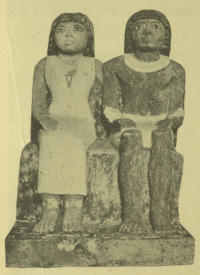
Painted limestone figures of Ka-ṭep and his wife Ḥetep-ḥeres.
IVth dynasty, B.C. 3750.
[Vestibule, East Doorway, No. 14.]
The tombs of the wealthy were provided with chairs, tables, couches, stools, boxes, painted and inlaid to hold jewellery, scents, etc., and many articles which the Egyptians used daily in their professions. The sistrum, cymbals, and bells which the priestess used in the temple were buried with her; the bow and arrows of the hunter, the favourite inscribed staff of authority of the official, the spear, dagger and axe of the warrior, the palette and colour-pots of the artist, the sceptre or symbol of office of the governor, children’s toys and dolls, dice, draughts, and counters used in games—all these things went to form the equipment for the tomb in individual cases, and examples of them are to be seen in the Third and Fourth Egyptian Rooms.
Of personal ornaments of the dead the variety is endless, but a very good general idea of them may be obtained from the collections in the Table-cases in the Fourth Egyptian Room. In Case F, one side is filled with amulets, many of which were worn for decorative purposes during life by their owners, and the other side contains a collection of necklaces and beads belonging to various periods between B.C. 1700 and A.D. 100. The beads are made of gold, amethyst, garnet, carnelian, mother-of-emerald, lapis-lazuli, agate, topaz, glass, etc., all which materials were believed to possess magical properties, and the pendants were intended to bring luck, long life, health, etc., to their wearers. The necklaces of the early period will be found in Case J, some of which belong to the period of the Early Empire; the porcelain beads and necklaces are in Case B. At one period unpierced, round and conical beads were made in Egypt. (See Table-case L, Second Egyptian Room.) They were found placed in semi-circular rows on a layer of clay, which was intended to serve as a necklace or breastplate for a mummy. A fine display of gold rings, pendants, bracelets, etc., will be found in Table-case J in the Fourth Egyptian Room. Worthy of special note are: the gold bracelets of Nemareth (Nos. 134, 135), the gold uraeus (No. 105), the “heart-scarab” in massive gold setting (No. 132), the hawk of gold (No. 133), gold pendant (No. 137), gold pectoral (No. 138), gold bangle with figures in gold and silver alternately (No. 140), gold lion (No. 175), Scarab of Sebekemsaf, a king of the XIVth dynasty (No. 195), gold rings inscribed with the names of Thothmes III, Ḥātshepset, Shishak I, Ȧmen-ḥetep III, and Ptolemy III (Nos. 198, 201, 217, 237, 266), silver rings inscribed with the names of Ȧmen-ḥetep IV, Shishak, and Psammetichus (Nos. 390, 392), and a very fine collection of 64 scarabs in agate, onyx, lapis-lazuli, etc., from the tomb of a princess of the XIIth dynasty, about B.C. 2400 (No. 382).
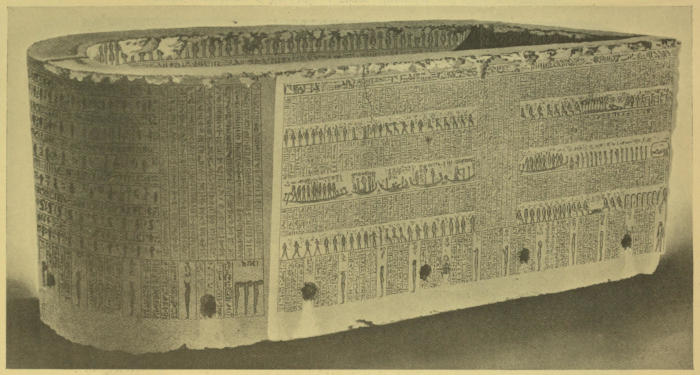
Plate XVII.
General view of the Sarcophagus of King Nekht-Ḥeru-ḥebt, B.C. 378, engraved with scenes and texts from the Book of What is in the Other World, and selections from the Book of the Praises of Rā.
[Southern Egyptian Gallery, Bay 25, No. 923.]
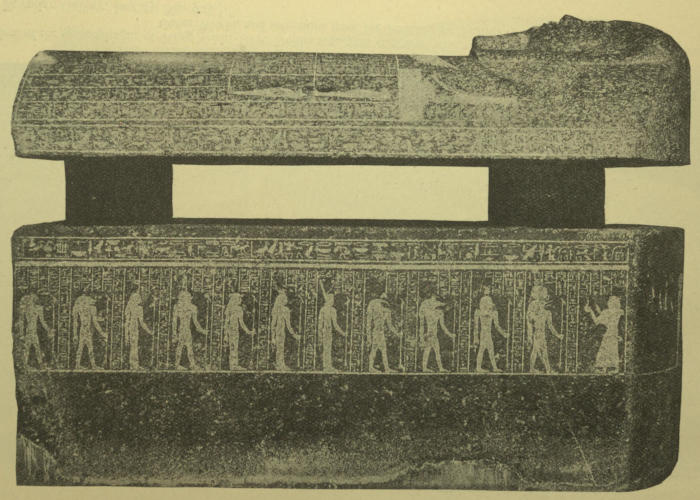
Plate XVIII.
Granite sarcophagus of Nes-Qeṭiu, a prince, chancellor, and scribe of Ȧmen-Rā.
XXVIth dynasty, or later.
[Southern Egyptian Gallery, Bay 26, No. 825.]
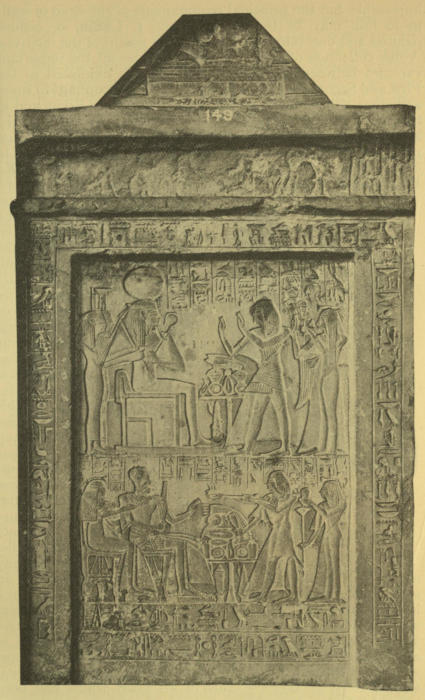
Plate XIX.
Sepulchral tablet of Ban-āa, a scribe.
XVIIIth dynasty.
[Northern Egyptian Gallery, Bay 9, No. 474.]
Numbers Cardinal and Ordinal. Divisions of Time: The Calendar, Sothic Period. Chronology.
Numbers.—The numbers 1 to 9 are expressed by short perpendicular strokes, e.g., 𓏺 = 1, 𓏻 = 2, 𓏼 = 3, 𓏻𓏻 = 4, 𓏾 = 5, 𓏿 = 6, 𓐀 = 7, 𓐁 = 8, and 𓐂 = 9. The number 10 is expressed by 𓎆, 100 by 𓍢, 1,000 by 𓆼, 10,000 by 𓂭, 100,000 by 𓆏, 1,000,000 by 𓁨, and 10,000,000 by 𓍶; tens up to 90 are expressed by repeating the sign for ten, 𓎆, so many times; hundreds up to 900 by repeating the sign for hundred, 𓍢, so many times; thousands up to 9,000 by repeating the sign for thousand, 𓆼, so many times; and so on. The following extract will illustrate the use of these signs:—
I.
II.
| 𓅧𓈎𓏥𓉻𓏛 | 𓆏𓆏𓆏𓆏𓆏𓆏𓆏𓆏𓆏𓂯𓂯𓂯𓆽𓍧𓍢𓎊 |
| Large loaves | 992,750. |
Fractions 𓂋𓏥 = ⅓, 𓐝 = ½, = ⅔, 𓂋𓎆 = ⅟₁₀, 𓂋𓍢 = ⅟₁₀₀, 𓂋𓆼 = ⅟₁₀₀₀, 𓂋𓎆𓎆𓎆𓎆𓐃 = ⅟₄₅, etc. Ordinal numbers are indicated by 𓎖 placed before the figure, or by 𓏌 placed after it; e.g. 𓎖𓏿 = “sixth,” 𓐀𓏌 = “seventh.”
Divisions of Time.—The smallest fraction was the ȧnt, 𓁻𓈖𓏏𓇳, one third of a second, or “the twinkling of an eye.” Then came the ḥat 𓇉𓄿𓏏𓇳, second; the at 𓄁𓏏𓇳, minute; and the unnut 𓃹𓈖𓏌𓏏𓇳 hour. Twenty-four hours made one day, hru 𓉔𓂋𓅱𓇳𓏤, ten days made one week, and thirty days one calendar month, 𓇺𓂧𓇼𓇳. Twelve months plus the five epagomenal days made one vague or calendar year, renpit 𓂋𓈖𓊪𓏭𓏏𓆳𓇳. Longer periods of time were:—
| Seṭ period | 𓋴𓂧𓈅𓉳 | = | 30 years. |
| Two-Ḥenti period | 𓎨𓎨𓇳𓇳 | = | 120 ” |
| Ḥeḥ | 𓎛𓇳𓎛 | = | An Age. |
| Tchetta | 𓆓𓏏𓇾 | = | Eternity. |
We also have:—
| | = | Millions of years. |
| | = | 10,000,000 years. |
| | = | 1,000,000,000,000 years. |
![[glyph not in Unicode]](images/glyph15.jpg) |
= | 10,000,000,000,000 years. |
![[glyph not in Unicode]](images/glyph16.jpg) |
= | 1,000,000,000,000,000,000 years. |
In late times the Sothic Period and the Phoenix Period were used by the Greeks, but there is no evidence that either was known to the Ancient Egyptians.
Chronology, and the ancient Egyptian Year. The Calendars of Lucky and Unlucky Days indicate that in very early times the Egyptian Year consisted of 12 months each of 30 days, i.e., that the primitive year contained 360 days. Whether the Egyptians ever tried to use the lunar year of 354 days there is no evidence to show. Now the progress of the seasons would, in a few years, soon convince those who used the year of 360 days that their year did not agree with the solar year, and that it was too short, and they would be obliged to add to its days in some way. The inscriptions prove that even at so early a period as the reign of Pepi II of the VIth dynasty, the Egyptians were in the habit of adding five days each year to their year of 360 days, and that before B.C. 3000 the year in common use contained 365 days. These “five days” are known as “the days over the year” 𓆳𓁷𓂋𓅱𓇳𓐃, or 𓇳𓏦𓏾𓁷𓂋𓅱𓇯𓏥𓆳𓏏𓏤, or “the five epagomenal days,” and they were said to be the days on which Osiris, Horus, Set, Isis, and Nephthys respectively were born. The primitive year of 360 days was divided into three seasons. The first season was Shat, or Akhet, 𓆷𓏏𓇳; it began about July 19 and ended about November 15, and corresponded practically with the period of the Inundation. The second season was Pert 𓉐𓂋𓏏𓇳; it began about November 15 and ended about March 15. The third season was Shemu 𓈚𓈗; it began about March 15 and ended about July 13.[183] These seasons to the Egyptians represented roughly Winter, Spring, and Summer. Each season contained four months, which were in early times called the first, second, third, and fourth month of that season; in later times a name was given to each month. The following was the early calendar:—
| Coptic Name.[27] | ||||
|---|---|---|---|---|
| 𓇺𓏺𓆷𓏏𓇳, | 1st Month of sowing | Thoth. | ⎫ | Inundation time and Winter. |
| 𓇺𓏻𓆷𓏏𓇳, | 2nd ” ” | Paophi. | ⎪ | |
| 𓇺𓏼𓆷𓏏𓇳, | 3rd ” ” | Athyr. | ⎪ | |
| 𓇺𓏽𓆷𓏏𓇳, | 4th ” ” | Choiak. | ⎭ | |
| 𓇺𓏺𓉐𓂋𓏏𓇳, | 1st Month of growing | Tybi. | ⎫ | Spring. |
| 𓇺𓏻𓉐𓂋𓏏𓇳, | 2nd ” ” | Mechir. | ⎪ | |
| 𓇺𓏼𓉐𓂋𓏏𓇳, | 3rd ” ” | Phamenoth. | ⎪ | |
| 𓇺𓏽𓉐𓂋𓏏𓇳, | 4th ” ” | Pharmuthi. | ⎭ | |
| 𓇺𓏺𓈚𓈗[28], | 1st Month of inundation | Pachons. | ⎫ | Summer. |
| 𓇺𓏻𓈚𓈗, | 2nd ” ” | Payni. | ⎪ | |
| 𓇺𓏼𓈚𓈗, | 3rd ” ” | Epiphi. | ⎪ | |
| 𓇺𓏽𓈚𓈗, | 4th ” ” | Mesore. | ⎭ |
To these twelve months, as already said, five days were added, and the year thus formed is generally known as the “vague (or wandering) year,” and the “calendar year.” Now it is clear that since this vague year of 365 days was shorter than the true year, or “solar year,” of 365¼, by nearly a quarter of a day, every fourth vague year would be shorter than the true year by nearly a whole day. Moreover, given a sufficient number of years, the vague year would work backward through all the months of the year, until at length the first day of the vague year would coincide with the first day of the solar year. Thus, supposing the first day of the vague and solar years to have coincided on January 1, B.C. 2000, two hundred years later the first day of the vague year would have worked back about 50 days; and five hundred years later, i.e., about B.C. 1300, the first day of the vague year would fall in the height of the summer instead of in the depth of winter. This defect in their year of 365 days would soon become apparent, and we may be sure that they were not long in discovering some means for correcting it. According to some authorities the Egyptians knew the length of the true, or solar, year with considerable exactitude, and if this be so they were well able to plan their farming operations without any reference to the vague year. According to others the Egyptians were ignorant of the solar year, but were acquainted with a Sothic year, which is so called because it began on the day when the star Sepṭ (or Sirius, or Sothis, or the Dog Star) rose heliacally, that is to say, with the sun. This happened on July 19 or 20, and as this date was very near the time when the Inundation began, the Egyptians considered it most convenient for their year and the Inundation to begin at the same time. The Sothic year contained practically 365¼ days, i.e., a few minutes more than the true, or solar, year; and the Sothic Period, i.e., the length of the time which must elapse between two risings of Sothis heliacally, contained 1,460 Sothic years, or 1,461 vague, or calendar, years.
It has now to be considered how the above facts bear upon Egyptian chronology. To make a complete scheme of Egyptian chronology we need a complete list of the kings of Egypt, and to know the order in which each succeeded, and the number of years which each reigned. Now, such a list does not exist, for the lists we have only contain selections of kings’ names; and of many a king neither the order of his succession nor the length of his reign is known. The facts at[185] present available do not permit the making of a complete detailed scheme of chronology, but one which is approximately correct in many parts of it can be framed. As authorities for the names of the kings there are:—1. The Royal Papyrus of Turin, which, when complete, contained over 300 royal names. 2. The Tablet of Abydos,[29] made for Seti I, containing seventy-six names. 3. The Tablet of Ṣaḳḳârah, containing fifty names. 4. The Egyptian monuments of all periods. 5. The King List of Manetho.[30] The Turin Papyrus, which was compiled about B.C. 1500, gave the lengths of the reigns of the kings, but unfortunately most of them are broken. Manetho compiled his King List, it is said for Ptolemy II Philadelphus, in the first half of the third century B.C., but, as the work in which it appeared is lost, we only know it by the copies which have come down to us in the Chronicle of Julius Africanus (third century A.D.), in the Chronicle of Eusebius, Bishop of Caesarea, who died about A.D. 340, and in the Chronography of George the Monk (eighth century A.D.). Eusebius himself also compiled a King List, but his results differ materially from those of Manetho as given by Africanus. Manetho divided the kings of Egypt into thirty dynasties, which he arranged in three groups: Dynasties I-XI, XII-XIX, and XX-XXX. He also gave the lengths of the reigns of the kings, and the cities of their origin, Memphis, Elephantine, Thebes, etc.
Now, although a great many credible facts are to be gathered from the above authorities from which we are justified in making the general deduction that the period of dynastic civilization lasted between four and five thousand years, they none of them help to fix an exact date for the reign of the first dynastic king of Egypt, who, by general consent, is said to have been Menȧ or Menes. If Manetho’s List were trustworthy, the difficulty would be settled, but unfortunately one version of it makes 561 kings reign in 5,524 years, whilst another gives the number of the kings as 361, and their total reigns as 4,480 or 4,780 years. Many Egyptologists have accepted Manetho’s statements with modifications, but others have tried to work out more accurate results, astronomically, by the use of the Sothic Period. It has already been said that the Sothic Period of 1,460 years is[186] equal to 1,461 vague, or calendar, years, and it is argued that, if we can find mentions of the risings of Sothis (Sirius, or the Dog-star) expressed in terms of the vague year, and if we can also fix a date for the beginning or end of a Sothic Period, it will be possible to arrive at fixed points in Egyptian chronology. Fortunately some three or four mentions of the rising of Sothis are known in the inscriptions, and thanks to Censorinus, who wrote his work (De Die Natali) A.D. 238, it is known that a Sothic Period came to an end A.D. 139.[31] If this be so, it is clear that the Sothic Period to which he refers began in B.C. 1321, the one before that in B.C. 2781, the one previous in B.C. 4241, and so on. The next step is to work out the mentions of the risings of Sothis which are expressed in terms of the vague, or calendar, year, and, provided that the statement of Censorinus be trustworthy and the calculations of modern investigators be correct, it is possible to assign a date in ordinary Julian years to such risings of Sirius.
Want of space renders it impossible to discuss here the various systems of chronology which have been formulated by Egyptologists and others, but the dates proposed by the principal authorities for some of the dynasties may be thus grouped:—
| Dynasty. | Dates proposed. | |||||
|---|---|---|---|---|---|---|
| 1. | 2. | 3. | 4. | 5. | 6. | |
| I | 5869 | 5702 | 5613 | 5004 | 4400 | 3315 |
| III | 5318 | 5147 | 5058 | 4449 | 3966 | 2895 |
| VI | 4426 | 4402 | 4310 | 3703 | 3300 | 2540 |
| XII | 3703 | 3404 | 3315 | 2851 | 2466 | 2000 |
| XVIII | 1822 | 1655 | 1796 | 1703 | 1700 | 1580 |
| XIX | 1473 | 1326 | 1404 | 1462 | 1400 | 1320 |
| XX | 1279 | 1183 | 1195 | 1288 | 1200 | 1200 |
Of these systems the one proposed by the late Dr. H. Brugsch (No. 5) agrees best with the general evidence of the monuments as to the length of the period of Dynastic[187] civilization; it is therefore used, with some modification of the dates of the XVIIIth dynasty, in this book. It has been declared that the intervals which he placed between the VIth and the XIIth, and the XIIth and the XVIIIth dynasties are too long, but, on the other hand, many objections can be urged against the reductions recently suggested. It is proposed to reduce the date given by Brugsch for Menes, B.C. 4400, to B.C. 3315; but there is no evidence in support of the reduction. The view has been steadily growing for years that some of the dates proposed by Brugsch for the kings of the XVIIIth dynasty must be reduced, and as this view is supported by the evidence derived from the recently published Babylonian Chronicles, and the general testimony of recently excavated monuments, the dates of the reigns of the early kings of that dynasty may well be brought down nearly one hundred years. The other evidence on the point, being of an astronomical character, can only be dealt with by experts. Egyptian chronology is a difficult subject, chiefly because of an insufficiency of facts about the reigns of the kings of the VIIth-XIth, and the XIIIth-XVIIth dynasties. Every year, however, witnesses the removal of a certain number of difficulties, and as long as excavations are made in Egypt a steady increase in the knowledge of the subject may reasonably be hoped for.
The only remains of this Period in the British Museum are flint axes, borers, scrapers, etc., typical examples of which are exhibited in Table-case M in the Third Egyptian Room.
Towards the end of this Period Egypt was divided into two kingdoms, of the South and of the North; of the kings of the latter a few names are known from the Palermo Stele, e.g., Seka, Khaȧu, Tȧu, Thesh Neheb, Uatch-nār or Uatch-ȧnt, Mekha, etc. No date can be assigned to the rule of these kings, but they probably all reigned before B.C. 4500. Whilst Egypt was divided into two kingdoms the country was invaded, probably more than once, by a people who made their way thither from the East, or South-East, and settled as conquerors in the Nile Valley and Delta. They brought with them a civilization superior to the African, and appear to have introduced wheat, barley, the sheep, the art of writing, a superior kind of brickmaking, etc. After a time, length unknown, there arose a king who succeeded in uniting the Kingdoms of the North and South under his sway; that king was Menȧ or Menes.
About B.C. 4400.
Menȧ, the Menes of the Greeks, was the first dynastic king of Egypt, and has been identified by some with king Āḥa 𓂚, whose tomb was discovered in 1897 at Abydos.[189] Nothing is known of his reign from the monuments, but a tradition preserved by Greek writers declared that he altered the course of the Nile, and so redeemed from the river a large tract upon which he built the first city of Memphis. Among the objects in the British Museum bearing the name of Āḥa may be mentioned some clay sealings for small wine-jars, a portion of an ivory box, and parts of two ebony tablets. (Table-case L in the Third Egyptian Room.)
𓅃𓉘𓂚𓊂 Āḥa.
𓅃𓉘𓆢𓍋𓊂 Nār-mer.
Tetȧ, or Ȧtet, was the successor of Menȧ, according to the King Lists. In recent years this king has been identified by some with a king whose name is provisionally read Nār-mer; others, however, take the view that Nār-mer is one of the names of Betchau, a king of the IInd dynasty.
𓅃𓉘𓏄𓊂 Khent.
𓅃𓉘𓆓𓊂 Tcha.
The next two kings were Ȧteth and Ȧta, but of their reigns nothing is known; according to some authorities we are to identify King Khent with the former, and King Tcha with the latter. There are several small objects in the British Museum inscribed with the name of Tcha (Table-case L), and several jar-sealings (Wall-case on Landing).
𓅃𓉘𓂧𓈖𓊂 Ṭen.
The reign of the next king Semti 𓈉𓈉, or Ṭen, formerly known as Ḥesepti 𓈈𓈈, was important. A legend preserved in the Book of the Dead states that the short form of the LXIVth Chapter of that work was “found” during his reign; and on the tablet exhibited in Table-case L, Third Egyptian Room (No. 124), the king is represented dancing before a god, who wears the White Crown and is seated within a shrine placed on the top of a flight of steps. As in later texts Osiris is called “the god on the steps,” and the White Crown is one of his most characteristic emblems, we are probably justified in identifying the figure in the shrine with that of Osiris. It is probable that the worship of Osiris assumed an importance in the reign of Semti hitherto unknown, and that it was at this period that the cult of this god began to displace the worship of ancestors, which, up to[190] that time, appears to have been general. It is clear that tradition assigned to his reign a period of literary activity. The name of Semti also occurs in connexion with a recipe in a book of medicine for driving the disease ukhedu out of the body. (For objects bearing his name see Table-case L, and for wine-jar sealings see Wall-cases on Landing.)
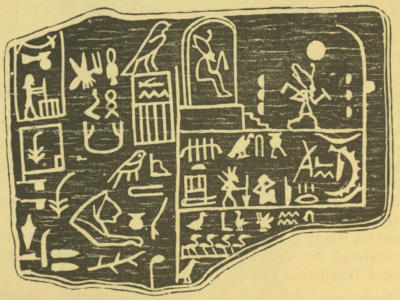
King Semti dancing before the god who wears the White Crown.
The sixth king of this dynasty was Āṭȧb, or Ātchȧb, otherwise known as Merpeba, or Merbapen. (For a number of objects bearing his names see Table-case L and Wall-cases on Landing.)
The next king, according to the King Lists, was called Semerkha, or Ḥu, or Nekht, or Semsu, the Semempses of Manetho. (For objects bearing his name see Table-case L and Wall-cases on Landing.)
𓅃𓉘𓈎𓂝𓊂 Qā.
This dynasty was brought to a close by the reign of a king called Qebḥ in the later Lists; the correct form of his name is, however, Sen, and his Horus name is Qā. (For objects bearing his name see Table-case L and Wall-cases on Landing.)
About B.C. 4133.
The first king of the IInd dynasty was Khā-Sekhemui, 𓈍𓌂𓌂 other names of whom were Betchau, Neter-baiu, and[191] Besh. From the reliefs on the statues of this king which were recovered from his tomb at Abydos, we may assume that Besh fought many battles, and conquered his enemies. From a design on one of his vases we learn that he was probably the first to enclose his personal name within the Shennu sign 𓍶, which was afterwards elongated into the cartouche 𓍷 when royal names became longer. In this design we see the vulture-goddess Nekhebit uniting the South and the North, and holding in one claw the sign 𓍶, with the name Besh written within it thus 𓃀𓈚. Betchau, or Besh, has been identified by some with Nār-mer. There are no objects bearing the name of Nār-mer in the British Museum, but a good cast of a green slate shield of Betchau is exhibited in Wall-case 10 on the Landing of the North-West Staircase. The designs on this remarkable object are reproduced in the Guide to the First and Second Egyptian Rooms, p. 40 ff. The objects found in the tomb of Besh prove that the Egyptians were, even at this early period, skilled in stone-cutting, statue-making, and working in metals, and that their religious and social institutions must have been established for many generations. (See the copper vases and wine-jar sealings on the Landing, and the interesting group of objects, fragments of vases, etc., in Table-case L.)
Besh was followed by Ḥetep-Sekhemui 𓊵𓌂𓌂, of whom we have a fragment of a stone vase (Table-case L, No. 162); and by Rā-neb and En-neter (see the fragment of a bowl in Table-case L, No. 163). During the reign of Rā-neb, who was also called Ka-kau, the worship of the Apis Bull of Memphis, the Mnevis Bull of Heliopolis, and the Ram of Mendes was either reconstituted, or additional shrines were founded or old ones repaired. (For typical figures of these gods see Table-case H, Third Egyptian Room.) After Uatchnes, of whom nothing is known, came a king who as the representative of Horus was called Sekhem-ȧb, and as the representative of Set, Perȧbsen. In Table-case L are a jar-sealing and a fragment of a stone vase, and in the Wall-case on the Landing a fine, hard grey granite stele, inscribed with his Set name.
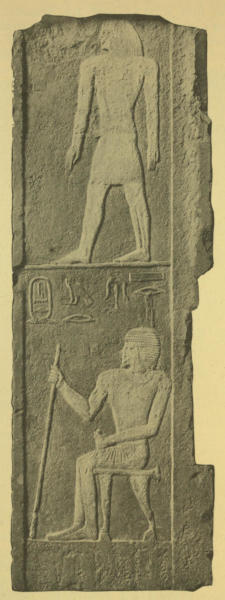
Slab from the tomb of Sherȧ, a Priest of the Ka of Senṭ, a king of the IInd dynasty, B.C. 4000.
[Vestibule, South Wall, No. 1.]
Senṭ or Senṭȧ is mentioned in connexion with a certain medical work which was either written or edited in the reign of Semti, the fifth king of the Ist dynasty. Nothing is known of Senṭ’s reign, but we find from the tomb of Sherȧ, a priest, that services were performed on behalf of his Ka or “Double” and that of his predecessor Perȧbsen. Sherȧ the priest probably lived at the end of the IInd, or at the beginning of the IIIrd, dynasty. A fine slab from his tomb is exhibited in the Egyptian Vestibule, No. 1.
Of the remaining kings of the IInd dynasty, Neferkarā, Neferkaseker, Ḥetchefa, and Bebi, or Tchatchai, their names only have survived.
About B.C. 3966.
The greatest of the kings of this dynasty was Tcheser, or Tcheser-sa, who is renowned as the builder of the famous Step Pyramid at Ṣaḳḳârah. This pyramid is about 200 feet high, and has six “steps,” 38, 36, 34½, 33, 31, and 29½ feet high respectively; the lengths of its sides at the base are: north and south, 352 feet, east and west 396 feet. A tomb of Tcheser, who has been identified with this king, was discovered at Bêt Khallâf in 1901. Details of his reign are wanting, but, according to a legend preserved on a rock stele on the Island of Sâḥal in the First Cataract, a Seven Years’ Famine came upon Egypt in his time, and want and misery were universal. Greek tradition ascribed to Tcheser great medical knowledge, and he is said to have been a patron of literature. Among the objects of this king in the British Museum may be mentioned the fragment of a slate vase (Table-case L, No. 169), and the very interesting small glazed tiles (Nos. 208, 209, in the same case; and see Table-case K in the Fourth Egyptian Room, Nos. 863-869), which were found inlaid in the wall of the doorway in the pyramid of King Tcheser.
The other kings of this dynasty, Ḥen-Nekhtor, Sa-Nekht, Tcheser-Tetȧ, Setches, and Nefer-ka-Rā Ḥuni were unimportant; the last named is mentioned in the famous Book of Moral Precepts known as the Prisse Papyrus, where he is said to have been the predecessor of the great king Seneferu. With the ending of the IIIrd dynasty the period of Egyptian History called the Archaïc Period closes. During these dynasties civilization had advanced greatly in Egypt. The habitations of the living were now built of brick, with wooden roofs supported on pillars; and the dead were provided with[194] stone-built tombs, called maṣṭabas, in which they were laid at full length, instead of in contracted positions. The art of writing had been introduced, and the beginning of the hieroglyphic system invented. Sculptors and metal workers had attained considerable skill, and potters had learned how to apply glaze. The progress made during the Archaïc Period can be successfully studied by the visitor from the valuable collection of objects exhibited in Table-case L in the Second Egyptian[195] Room, and in the Wall-cases on the Landing of the North-West Staircase. Special attention should be given to the green slate shields, sculptured in relief with hunting scenes, and to the fine display of vases and bowls, in diorite, granite, porphyry, jasper, breccia, limestone, alabaster, etc., in Wall-cases 137-142, 194-204, in the Fourth Egyptian Room. To the same period probably belong:—1. The portion of a sculptured stele, with the Horus name of a king, which was found at Wâdî Maghârah in the Peninsula of Sinai (Egyptian Vestibule, No. 2). 2. The very interesting red granite statue, of a most archaïc character, of Betchmes, a royal kinsman and axeman who was attached to the body-guard of the king (Egyptian Vestibule, No. 3). 3. The text on a limestone slab in which the hieroglyphics are not divided by lines (Egyptian Vestibule, No. 4). 4. Relief from the tomb of Suten-ȧbu (Egyptian Vestibule, No. 5).
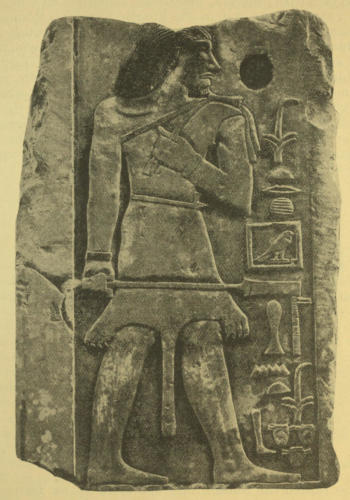
Relief from the tomb of Suten-ȧbu.
IIIrd or IVth dynasty, B.C. 3700.
[Vestibule, South Wall, No. 5.]
About B.C. 3733.
With the accession of Seneferu one of the most important periods in the history of Egypt opened, and it was marked by the conquest of the Sûdân and the Sinaitic Peninsula, by the building of the Pyramids, and by the production of bas-reliefs, sculptures, wall-paintings, etc., which for fidelity to nature and delicacy of execution were never surpassed. Several of the earlier kings of Egypt had trade relations with the natives of Sinai who worked the famous copper and turquoise mines of Wâdî Maghârah; but Seneferu invaded the country and conquered it, and cut reliefs on the rocks in which he is represented clubbing the rebellious natives. He was the first to group four of the royal titles within a cartouche thus: 𓍹𓆥𓅒𓎟𓌷𓏏𓅉𓋴𓄤𓂋𓅱𓍺. He also raided the Sûdân, and captured, as we learn from the Palermo Stele, 7,000 men, i.e., slaves, and 200,000 animals, i.e., oxen, cows, goats, etc. The men were, no doubt, brought to Egypt and made to labour there on the king’s works. During the reign of Seneferu, Egypt was invaded by certain Eastern tribes by way of the desert; and the country seems to have suffered from a famine. Seneferu was probably buried in the Pyramid of Mêdûm, which is called the “False Pyramid,” and is of an unusual shape; it is about 115 feet[196] high, and consists of three stages, which are 70, 20, and 25 feet high respectively. He also built a pyramid at Dahshûr. His queen was Mert-tefs 𓌻𓂋𓏏𓏏𓆑𓋴, who survived him and was living during the reigns of Khufu and Khāfrā; a limestone false door from her tomb is exhibited in the Egyptian Vestibule, No. 7. The governor of Seneferu’s pyramid at Mêdûm was Ka-nefer (for his sepulchral stele see the Egyptian Vestibule, No. 8), to whose memory a pious son set up the memorial tablet No. 9.
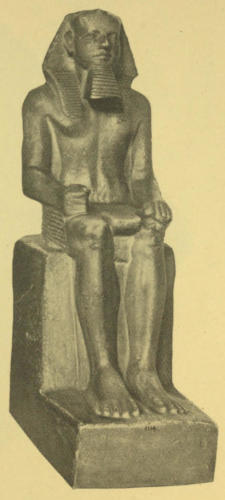
King Khufu (Cheops).
[Vestibule, South Wall, No. 13.]
Seneferu was succeeded by Khufu, the Cheops of the Greeks, the son of Shaȧru 𓍹𓈚𓄿𓁹𓂋𓅱𓍺, the greatest king of the dynasty; he is said to have reigned sixty-three years. He may have been a great warrior, like Seneferu; and a relief on the rocks at Wâdî Maghârah in the Sinaitic Peninsula represents him in the act of clubbing a typical foe in the presence of the ibis-headed god Thoth. He was, however, a far greater builder, and he has been known to fame for some thousands of years as the builder of the Great Pyramid (see Plate XX). This wonderful building, which the Egyptians called “Khut,” 𓅜𓐍𓏏𓉴, stands on the edge of a ledge of rock forming the “skirt” (hence the name Gîzah) of the desert, on the western bank of the Nile, about 5 miles from the river, near the village of Al-Gîzah. It covers an area of 12½ acres. It is 451 feet high, and the flat space at the top is about 30 feet square. The length of each side at the base is 755 feet; but before the outer layers of stone were removed and used in Cairo for building material each side was 20 feet longer, and the pyramid itself was about 30 feet higher. It was originally[197] covered with inscribed slabs of smooth limestone or polished granite, and it is calculated that it at present contains 85,000,000 cubic feet of masonry. The illustration on page 197 illustrates the general arrangement of the chambers and corridors inside the pyramid, and the corridor and mummy chamber beneath it. The stone used in building was quarried at Ṭura, on the eastern bank of the Nile, about 8 or 9 miles from the pyramid site. It was rolled down to the river on a made road, and ferried across in barges, and then rolled up the embanked road and causeway to the rock. According to Diodorus (i, 63), the building occupied at least twenty years, and some 300,000 men were employed in the work. Herodotus says (ii, 64) that ten years were consumed in the quarrying of the stone, and ten more in building, and that the men worked in gangs of ten thousand, each gang working three months at a time. A group of three casing stones from the Great Pyramid are exhibited in the Egyptian Vestibule, Nos. 10-12, and also a plaster cast of a statue of Khufu (No. 13). Attached to the Great Pyramid was a funerary temple in which commemorative services were performed; and either towards the end of the king’s reign, or soon after his death, one of the chief priests in it was Ka-ṭep, who held the office of “Prefect of the sa” 𓌂𓅓𓎂, i.e., of the “fluid of life.” Ka-ṭep was a “royal kinsman,” and his wife Ḥetep-ḥeres was a “royal kinswoman.” For the statues of Ka-ṭep and his wife, see page 177, and for “false doors” from his maṣṭaba tomb, see Egyptian Vestibule, Nos. 14-17, and for his censers, see Wall-case 200 in the Fourth Egyptian Room, Nos. 52, 53. Another official who flourished about this period was Sheshȧ, from whose tomb came the limestone stele in the Egyptian Vestibule, No. 18.
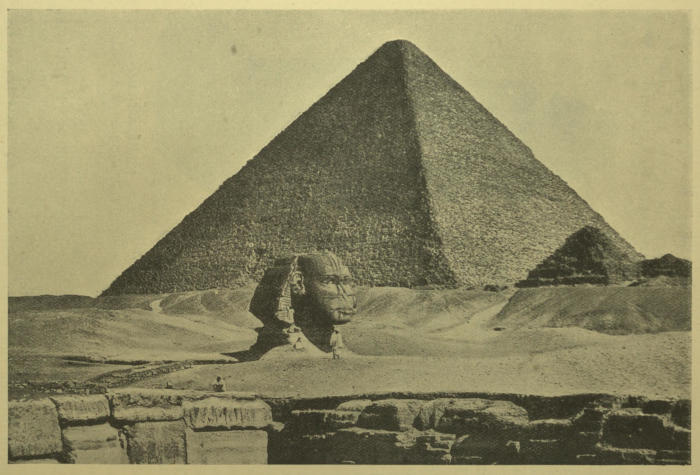
Plate XX.
The Great Pyramid and Sphinx.
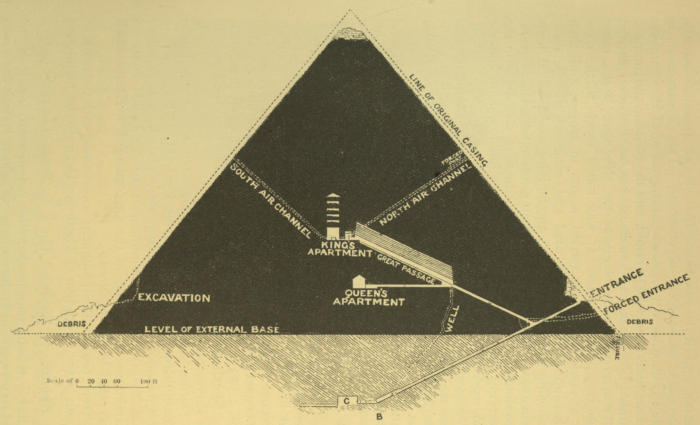
Section of the Great Pyramid of Gîzah, built by Khufu (Cheops), showing the internal passages and chambers, and the underground corridor and sarcophagus chamber.
During the reign of Khufu a large number of fine tombs were built round about the Great Pyramid, and in some of them fine monolithic sarcophagi were placed. An excellent idea of this class of monument may be gained from an examination of the cast of the sarcophagus of Khufu-ānkh (Egyptian Vestibule, No. 19).
Here, because the monument is associated with the name of Khufu in the inscription of Thothmes IV, must be mentioned the Sphinx, in Egyptian Ḥu 𓎛𓅱. The early history of this wonderful man-headed lion is unknown, but it seems that some work upon the rock out of which it was fashioned was undertaken by Khufu. Under the XIIth dynasty the[199] headdress, called nemmes, was cut, and it is possible that an attempt was made to give the face some resemblance to that of Ȧmen-em-ḥāt III, or one of his predecessors, about the same time. At a later period the Sphinx was identified with Rā-Harmachis, probably under the influence of an ancient tradition which connected it with the Sun-god. It is 150 feet long and 70 feet high; the head is 30 feet long and the face 14 feet wide. Originally the face was painted a bright red, and traces of the colour are still visible. Traditions and superstitions have gathered about it in all ages, and it is probable that the rock out of which it was made was regarded with veneration in primitive times. In the Middle Ages the natives believed that the Sphinx kept the sands of the Western Desert from swallowing up the village of Gîzah. A portion of the painted limestone uraeus, or asp, from the forehead and a portion of the beard of the Sphinx are exhibited in the Egyptian Vestibule, Nos. 20 and 21.
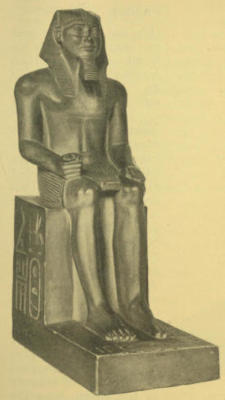
King Khāfrā (Chephren).
Khufu was succeeded by Ṭeṭ-f-Rā, of whom nothing is known; and he again was succeeded by Khā-f-Rā, the Chephren of the Greek writers, who is famous chiefly as the builder of the Second Pyramid at Gîzah, called in Egyptian “Ur” 𓅨𓉴, i.e., the “Great.” Its height is about 450 feet, the length of each side at the base is 700 feet, and it is said to contain about 60,000,000 cubic feet of masonry, weighing some 4,883,000 tons. It was first opened by Belzoni (born 1778,[200] died 1823) in 1816. It was originally cased with polished stone, but only towards the top has the casing been preserved. The illustration on page 171 shows the arrangement of the corridor and sarcophagus chamber, which is very different from that of the Great Pyramid. A funerary chapel was attached to the pyramid; and among those who ministered in it was Rutchek, the chief of the libationer priests, who calls himself a “friend of Pharaoh” 𓋴𓍋𓈖𓉐𓉻. (For an architrave and an inscription from his tomb see Egyptian Vestibule, Nos. 22 and 23.) The Pyramid itself was in charge of the “royal kinsman” Thethȧ, who was the royal steward, and “overseer of the throne of Pharaoh,” and priest of Hathor and Neith. Two fine doors from the maṣṭaba tomb of Thethȧ are exhibited in the Northern Egyptian Gallery (Bay 1, Nos. 24 and 25), together with a short inscription referring to the burial of his father and mother (No. 26). The perfection to which the sculptor’s art had attained at this period is well illustrated by the casts of statues of Chephren, from the hard stone originals in the Museum in Cairo, exhibited in the Egyptian Vestibule, Nos. 27 and 28. A fragment of an alabaster vessel from the king’s tomb, bearing his name, is in Wall-case 138 in the Fourth Egyptian Room, No. 56.
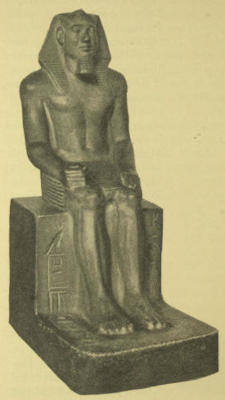
King Menkaurā (Mykerinos).
[Vestibule, South Wall, No. 30.]
Men-kau-Rā, the Mykerinos of Greek writers, reigned, it is said, about sixty-three years; no details of his reign are[201] known, and he is chiefly famous as the builder of the Third Pyramid at Gîzah, which the Egyptians called “Ḥer” 𓁷𓂋𓉴. This pyramid is between 210 and 215 feet high, and the length of each side at the base is about 350 feet. The illustration on page 202 shows the position of the corridors and the mummy chamber, which is 60 feet below the surface of the ground, and also indicates the damage which was done to the pyramid by the Khalîfa Al-Mâmûn, who, believing that it was full of gold and precious stones, tried to demolish it. The pyramid was originally cased with slabs of granite, many of which still remain in position. In the mummy chamber were discovered a stone sarcophagus, a wooden coffin, the cover of which was inscribed with the king’s names and titles and an extract from a religious text, and the remains of a mummy wrapped in a cloth. These were despatched by ship to England in 1838, but the ship was wrecked, and the sarcophagus was lost; the fragments of the coffin and the mummy were recovered, and are now exhibited in Case B in the First Egyptian Room. In the reign of Men-kau-Rā certain Chapters of the Book of the Dead were revised or composed by Ḥeruṭāṭāf, a son of Khufu, or Cheops, who was renowned for his learning. A cast of a statue of Men-kau-Rā, and a sepulchral stele of Khennu, a “royal kinsman” and councillor of the king, are exhibited in the Egyptian Vestibule, Nos. 30 and 31.
In the reign of Men-kau-Rā was born a child to whom the name of Ptaḥ-Shepses was given, and who was a playfellow of the princes and princesses in the palace. In the reign of the next king, Shepseskaf, he married the royal princess Maāt-khā 𓌷𓂝𓏏𓈍𓂝, and lived on through the reigns of Userkaf, Saḥu-Rā, Nefer-ȧri-ka-Rā, and two or three other kings of the Vth dynasty. Under each king he filled a number of important offices, and at his death was probably considerably more than 100 years old. He was buried in a fine large maṣṭaba tomb at Ṣaḳḳârah, from which the great door in the Egyptian Vestibule, No. 32, was taken. The façade is inscribed in fine bold hieroglyphics, and the sculptured decorations on the sides are good examples of the best funerary reliefs of the period. The upper parts of each of the main perpendicular lines of text contained the name of a king, but of these only two now remain.
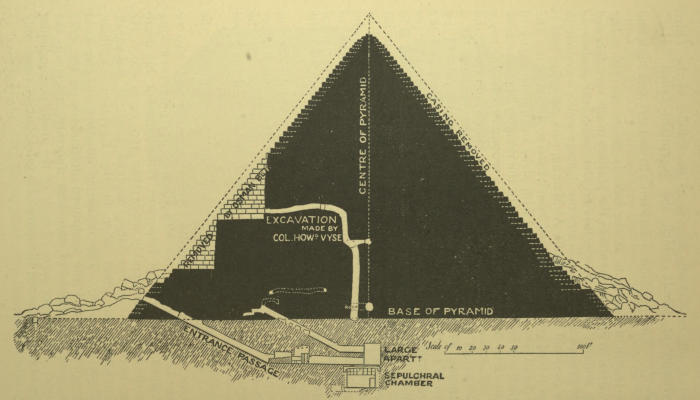
Section of the Third Pyramid of Gîzah, built by Menkaurā (Mykerinos), showing the extent of the portions removed.
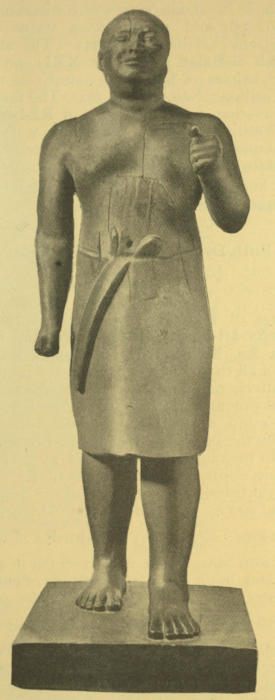
Plate XXI.
An Egyptian official of the IVth dynasty. Cast of the wooden statue of the Shêkh al-Balad, or “Shêkh of the Village.”
[Egyptian Vestibule, No. 35.]
The beauty of the statues of the IVth dynasty is well illustrated by the painted limestone portrait statue of Ȧn-kheft-ka, a royal kinsman, which was found at Dahshûr (Bay 1, No. 33), and the headless statue of an official found at Gîzah (Vestibule, No. 34). The standing figures of the Shêkh al-Balad (see Plate XXI) and the Scribe are wonderful examples of fidelity to nature (see the casts in the Egyptian Vestibule, Nos. 35 and 36). The finest bas-relief of the period is that from the tomb of Rā-ḥetep at Mêdûm (Egyptian Vestibule, No. 40); and the wall decorations of the ordinary maṣṭaba tomb of this time are illustrated by the sculptured slabs from the tombs of Ȧri (Egyptian Vestibule, Nos. 41-43), and Ȧfȧ, a steward and head-gardener (No. 44), and Ānkh-ḥaf, the scribe (No. 45), etc.
About B.C. 3566.
The kings of this dynasty are: Userkaf, Saḥu-Rā, Kakaȧ, Nefer-ȧri-ka-Rā, Shepses-ka-Rā, Khā-nefer-Rā, User-en-Rā Ȧn, Men-kau-Ḥeru, Ṭeṭ-ka-Rā Ȧssȧ, Unȧs. The reigns of all these kings, from a historical point of view, are comparatively unimportant. During the reign of Userkaf a great development of the cult of Rā took place in Egypt, and the worship of the Sun-god, according to the form established by the priests of Heliopolis, became dominant in the land. In the reign of Userkaf, or in that of one of his immediate successors, the title of “son of Rā” was added to the other royal titles, and, as the son of the Sun-god, the king took a special name. Userkaf built at Abû-Ṣîr the pyramid called “Āb-ȧst” 𓀆𓊨𓊨𓊨𓉴. Saḥu-Rā appears to have made a raid into Sinai, for he is represented in a rock-relief at Wâdî Maghârah in the traditional attitude of clubbing a native of the country. He built, at Abû-Ṣîr, the pyramid called “Khā-ba” 𓈍𓅡𓉴. For an alabaster vase inscribed with the Horus name of this king, Neb-khāu, see Wall-case 138, No. 58; and there is in the British Museum also a cylinder seal inscribed with his name (No. 48,023). The next important king of this dynasty is User-en-Rā, whose name, as son of Rā, was Ȧn. He carried on mining operations in Sinai, and probably suppressed[204] revolts there among the natives; but details are wanting. He built at Abû-Ṣîr the pyramid called “Men-ȧst” 𓏠𓈖𓊨𓊨𓊨𓉴. From this, probably, came the fine grey granite funerary vase inscribed with his name 𓆥𓍹𓇳𓈖𓄊𓋴𓂋𓍺. (See Fourth Egyptian Room, Wall-case 194, No. 51.) Usertsen I, a king of the XIIth dynasty, wishing for some reason to commemorate User-en-Rā, dedicated to him a black granite statue, the lower portion of which is in the Egyptian Vestibule, No. 48. On one side of the throne is the royal prenomen, and on the other the nomen, which is repeated on the king’s belt. A plaster cast of a stone statue of User-en-Rā is also exhibited in the Vestibule, No. 49.
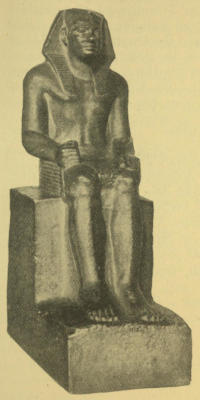
King User-en-Rā Ȧn, B.C. 3433.
[Vestibule, South Wall, No. 49.]
Ȧssȧ, the next king of importance, worked the quarries in Wâdî Ḥammâmât, near the old high road which ran from Ḳena on the Nile, in Upper Egypt, to a place near the modern Ḳuṣêr (Cosseir) on the Red Sea, and the copper and turquoise mines in the Peninsula of Sinai. He built at Abû-Ṣîr the pyramid called “Nefer” 𓄤𓉴. During the reign of Ȧssȧ a development of trade between Egypt and the Sûdân ensued, and an Egyptian official called Ba-ur-ṭeṭ succeeded in reaching the “Land of the Spirits” and bringing thence a pygmy ṭenḳ 𓂧𓈖𓎼𓄔𓁌, whom he gave to the king. The pygmy actually came from the land of Punt, which tradition declares was the original home of the Egyptians. He was employed to dance the “dance of the gods” before the king. It seems to have been[205] the custom in still earlier times to import pygmies from the Sûdân, for skeletons of two were found near the tomb of Semempses, a king of the Ist dynasty, at Abydos.
Unȧs, the last king of the Vth dynasty, the Onnos of Manetho, carried on the usual mining operations, and, it is said, built a temple to Hathor at Memphis. He is chiefly famous as the builder of the first of a very remarkable series of pyramids at Ṣaḳḳârah, the corridors and chamber walls of which were covered with series of formulae of the greatest value for the study of the Egyptian Religion. The pyramid of Unȧs was about 60 feet high, and the length of each side at the base was 220 feet; in front of its door stood a portico which rested on granite columns with palm-leaf capitals. One of these columns now stands in the Egyptian Vestibule, No. 50. (For an alabaster vase from his mummy chamber, inscribed with his name and titles 𓍹𓅭𓇳𓃹𓈖𓇋𓋴𓍺, see Wall-case 138 in the Fourth Egyptian Room, No. 57.)
The funerary reliefs of the Vth dynasty are very fine. Those worthy of note are: a “false door,” from the tomb of Khnemu-ḥetep, a councillor and libationer and an officer of the palace of Userkaf (Egyptian Vestibule, No. 51); a portion of the façade of the tomb of Neka-ānkh, a priest who ministered in the tomb of Userkaf (No. 52); a massive “false door” from the tomb of Ȧsȧ-ānkh, from Ṣaḳḳârah (No. 53); a slab sculptured in low relief with a figure of the royal kinswoman Thethȧ (No. 60); and a slab from the tomb of Khnemu-ḥetep, a chief of Nekheb (No. 61).
About B.C. 3300.
The kings of this dynasty were:—
Tetȧ, the first king of this dynasty, was neither a warrior nor a great builder; and details of his reign are wanting. He built a pyramid at Ṣaḳḳârah, the interior of the chambers and corridors of which are covered with inscriptions of a religious[206] character; it is commonly known as the “Prison Pyramid.” Of the monuments of this king in the British Museum may be mentioned a grant of land to the god Khenti Ȧmenti of Abydos (Egyptian Vestibule, No. 74); an alabaster vase from his pyramid, inscribed with his name and titles (Wall-case 138 in the Fourth Egyptian Room, Nos. 59 and 60); and a fine breccia bull, to which the royal names and titles have been added in recent times (No. 61).
Rā-meri, or Pepi I, was probably the greatest king of this dynasty. He worked the granite quarries at Elephantine, or Syene, and in the Wâdî Ḥammâmât, and he established his power in the Peninsula of Sinai, where he ruled the local tribes with a strong hand. His reign was one of industrial progress; and trade and handicrafts flourished throughout the country under his fostering care. Under the leadership of a favourite official named Unȧ, he despatched a very large army composed of men drawn from all parts of the Sûdân, to put down a wide-spread revolt which had broken out among the dwellers in the Eastern Desert called “the Āamu, who lived on the sand.” Unȧ gained a decisive victory, and was promoted to very high honours. Pepi I built a pyramid at Ṣaḳḳârah, the walls of the chambers and corridors of which were covered with inscriptions of a religious character; from this comes the fine alabaster vase, inscribed with his name and titles, in Wall-case 138 in the Fourth Egyptian Room, No. 66. (For two fine “false doors” from the tomb of Qarta, a high official of Pepi I, see Egyptian Vestibule, Nos. 75, 76.)
Pepi I was succeeded by Mer-en-Rā I Tchefau(?)-em-sa-f, who carried on the works begun by his father, and built a pyramid at Ṣaḳḳârah, from which came the fine alabaster vase in Wall-case 138 in the Fourth Egyptian Room, No. 66. He was succeeded by Nefer-ka-Rā Pepi II, who according to tradition lived to the age of 100 years. During his reign Egypt was in a state of prosperity, and there was great activity in trade and handicrafts. At this time flourished the famous official Ḥer-Khuf, who was the master of a caravan which traded between Egypt and the Sûdân, which country he visited four times. On the last occasion he brought back a pygmy from “the land of the Spirits,” which King Pepi II bade him bring to Memphis. Detailed orders were sent to the effect that the pygmy was to be watched during the day so that he might not fall into the water, and his sleeping place was to be visited ten times each night by properly qualified people, for, said the king: “I wish to see him more than all the tributes of Sinai and Punt.” Other[207] prominent traders in the Sûdân on behalf of the king at this time were Pepi-nekht, Mekhu, who died there, and whose body was brought back to Egypt by his son Sabben, etc.
Among the objects of the time of Pepi II may be mentioned a portion of a doorway made by him at Abydos, and a sepulchral stele of Nefer-Sennȧ, from his tomb at Denderah (Egyptian Vestibule, Nos. 77 and 78). Among the priests who ministered in the chapel attached to the pyramid of Pepi II was Heb-peri, whose stele is exhibited in the Egyptian Vestibule, No. 79. The most important monument of his reign is the maṣṭaba tomb of Ur-ȧri-en-Ptaḥ, a royal kinsman and scribe, libationer, and councillor, from Ṣaḳḳârah, which has been re-built in the Assyrian Saloon (No. 80). It is a good typical example of the tomb of noblemen and high officials of the period. The painted reliefs are interesting, and are typical of the wall decorations of tombs towards the close of the VIth dynasty. The inscriptions show that both Ur-ȧri-en-Ptaḥ and his wife were buried in the chamber beneath the maṣṭaba; the list of offerings, some 90 in number, is exceptionally long.
Of the last king of the VIth dynasty, Mer-en-Rā II Tchefa-em-sa-f, nothing is known.
The funerary art of this period is well illustrated by the stelae and “false doors” of: Sennu (Bay 1, No. 81), Ptaḥ-ḥetep, a priest (No. 82), Erṭā-en-ānkh, a royal kinsman and councillor (No. 83), Uthenȧa, whose “good name” was Penȧ (a very interesting relief, No. 84), Ȧṭu, a scribe and superintendent of the “Great House of the Six” (No. 85), Behenu, a priestess of Hathor (No. 88), and a portion of a slab from the roof of a tomb, with flutings, which are probably intended to represent tree trunks (No. 90). All these, with the exception of No. 81, are in the Egyptian Vestibule. To this period also probably belong the libation tanks, and tablet for offerings of Ȧntḳes, Khart-en-Khennu, and Senb (Bay 14, Nos. 93-95).
Besides the larger remains of this period, the scarabs in the Table-cases in the Fourth Egyptian Room should be examined. Several of them are inscribed with names of the kings of the first six dynasties, but it is not certain how many, or if any, of such scarabs are contemporaneous, and for this reason they have not been described in the preceding paragraphs. On the other hand, of the fine collection of scarabs of officials, inscribed with their titles, scores certainly belong to the period of the first half of the[208] Ancient Empire, and are of the greatest interest and historical value.
The monuments prove that between the IVth and VIth dynasties the Egyptians lived in a state of serfdom, and that they regarded their king as the owner of both their souls and bodies. He was the very essence of God in human form upon earth, and his power was absolute; even in the Other World his authority was held to be equal to that of the great gods of the dead. The Pharaohs of this period were masters of the Peninsula of Sinai, and of the Eastern Desert between Egypt and the Red Sea; and the memory of the raid which Seneferu made in the Sûdân probably induced the warlike tribes of that country to permit Egyptian caravans to pass from Syene to the Blue and White Niles unmolested.
At the close of the VIth dynasty a period of general disorder appears to have set in, the chiefs of cities such as Suten-ḥenen (Herakleopolis), Asyûṭ and Thebes contending among themselves for supremacy. Of the history of this period nothing is known. According to Manetho (version of Africanus) we have:—
Seventy kings in seventy days.
Twenty-seven kings in 146 years.
The Tablet of Abydos supplies after Neter-ka-Rā, the name of the last king of the VIth dynasty, the following sixteen names, which represent, presumably, the kings of the VIIIth dynasty:—
Under the rule of these kings the princes of Herakleopolis succeeded in gaining their independence, and thus the seat of the government of Egypt was removed from Memphis up the river to Suten-ḥenen, the modern Ahnâs, about 60 miles south of Cairo.
Nineteen kings in 409 years.
Nineteen kings in 185 years.
The Turin Papyrus contains a series of fragmentary names, which may represent those of the kings of one or the other of these dynasties; the fourth of these is Khati, whose name is also found on a rock in the First Cataract, and on a bronze bowl in the Museum of the Louvre in Paris.
Among the kings of the Tenth Dynasty may be placed king Ka-meri-Rā in whose reign lived Khati, prince of Siut, or Asyûṭ. About this time war appears to have been going on between the princes of Herakleopolis and the princes of Thebes, and the prince of Siut sent troops to support the Herakleopolitans against the Thebans. For a time the Thebans were beaten, but at length they gained the mastery over the princes of the North, and founded a new dynasty.
Of the period represented by dynasties VII-X there are no monuments in the British Museum, with perhaps the exception of a few scarabs.
About B.C. 2600.
The founder of this dynasty was, most probably, Ȧntefȧ, a local chief of the Thebaïd, whose titles were Erpā 𓂋𓊪𓂝 and Ḥā 𓄂, and “great prince of the nome of the Thebaïd, the satisfier of the heart of the king, the controller of the Gates of the Cataract, the support of the South, making the two banks of the Nile to live, chief of the Priests, the loyal servant of the Great God, the Lord of Heaven.” He was probably succeeded by two or three chiefs of similar[210] name who made no claim to the sovereignty of the Northern Kingdom, which was then in the hands of the princes of Herakleopolis. The first of Ȧntefȧ’s successors who claimed to be “King of the South and of the North,” and “Lord of the two Lands,” i.e., all Egypt, was Uaḥ-ānkh Ȧntef-āa, who was succeeded by Nekht-neb-ṭep-nefer Ȧntef, and he was followed by Sānkh-ȧb-taui Menthu-ḥetep I. These facts are derived from the important stele of Ȧntef, a priestly official, which is exhibited in the Northern Egyptian Gallery, Bay 4, No. 99 (see Plate XXII). Among the officials who flourished in the reign of Uaḥ-Ȧntef and his son was Thethȧ, whose sepulchral stele, inscribed with a biographical notice, is exhibited in the same Bay (No. 100). From his tomb also came the inscription which formed the façade (No. 101), and the reliefs (Nos. 102, 103), on which are represented members of the family of the deceased bearing offerings. The order of the remaining kings of the dynasty is doubtful. Several of them were called Menthu-ḥetep, and they may be distinguished by their prenomens thus:—
The first of these kings, Neb-ḥapt-Rā Menthu-ḥetep, probably Menthu-ḥetep II, appears to have been an able ruler, who reigned for about 46 years. He was a great warrior, and established his authority from one end of Egypt to the other. Among his other achievements was the pacifying of the Āamu, or the tribes of the Eastern Desert and Sinai. He built a fine temple at Dêr al-Baḥarî, the remains of which have been recently discovered and excavated. This building is unique in being associated with a pyramid-tomb. The fragments of the painted limestone reliefs which have been found among its ruins lack nothing in finish, fidelity to nature, and execution, whilst in design and general treatment they may be compared with some of the best funerary reliefs of the Vth dynasty. In the Northern Gallery, Bay 3, an interesting collection of such fragments is exhibited, and worthy of note are: Head of a painted limestone statue of Neb-ḥapt-Rā Menthu-ḥetep, wearing the crown of the South (No. 104); portion of a painted relief, with a figure of the king being embraced by[211] Rā (No. 105); relief, with a seated figure of the king and his prenomen 𓍹𓇳𓎟𓊤𓍺 (No. 106); relief, with a figure of a king grasping an Āamu foe by one leg (No. 108); relief, with a figure of a hippopotamus (No. 110); relief, with a figure of a prince called Menthu-ḥetep (No. 111); slab, inscribed Sma-taui, the Horus name of the king (No. 117); and a portion of an inscription referring to the overthrow of the Āamu by the king (No. 118).
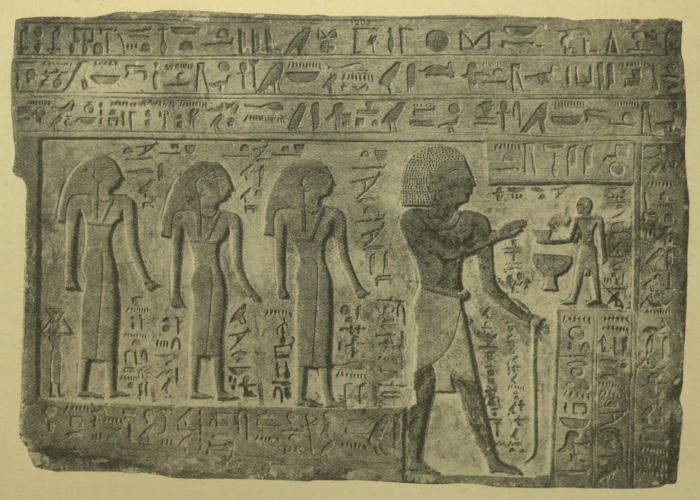
Plate XXII.
Tablet of Ȧntet, an official who flourished in the reigns of three kings of the XIth dynasty, about B.C. 2600. Scene: A priest making offering to the deceased and his three wives.
[Southern Egyptian Gallery, Bay 4, No. 99.]
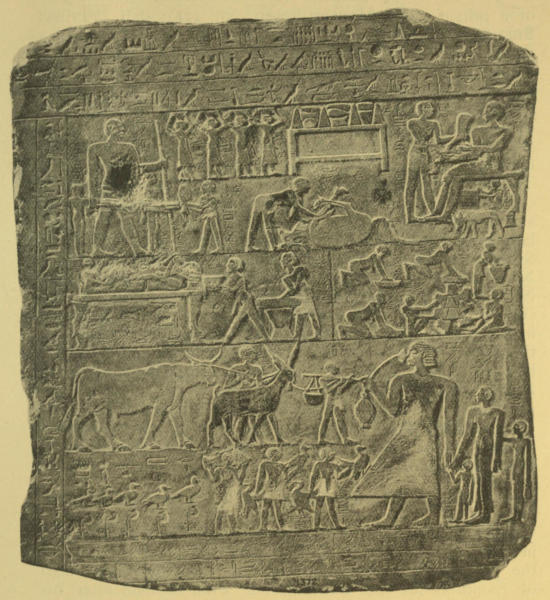
Plate XXIII.
Sepulchral tablet of Sebek-āa, an overseer of transport, sculptured with scenes representing the presentation of offerings, etc.
XIth dynasty, B.C. 2600.
[Northern Egyptian Gallery, Bay 4, No. 120.]
To the period of the XIth dynasty may be attributed the following interesting tablets and reliefs: Relief, from the tomb of Sebek-āa at Ḳurnah (see Plate XXIII), on which are represented the preparations for a funeral feast, the figure of the deceased lying on his bier, etc. (Bay 4, No. 120). The cutting of the figures and design is of a most unusual character; and for the general treatment of the subject this stele is probably unique. Other tablets, probably somewhat later in date, are: Tablet of Khensu-user, set up by his son Seḥetep-ȧb (Bay 3, No. 121), tablet of Sa-Menthu (Bay 2, No. 122), tablet of Menthu-ḥetep (Vestibule, North Wall, No. 123), and tablet of Mer-shesu-Ḥeru and his friends (Bay 2, No. 124). The portion of a wooden coffin inscribed in hieratic with part of the XVIIth Chapter of the Book of the Dead, in Wall-case 87 in the Second Egyptian Room, belongs to this period; the text was written for one of the Menthu-ḥetep kings.
During the reign of Sānkh-ka-Rā Menthu-ḥetep, who was probably the last king of the dynasty, an expedition, under the command of a general, Ḥennu, was despatched to Punt, by way of the Red Sea. The object of the expedition was to obtain a supply of ānti 𓂝𓈖𓅂𓈒𓏦, or myrrh, which was largely used for purposes of embalming. Ḥennu succeeded in reaching Punt, and in bringing back large quantities of all the products of that remote country. Details of the reign of Sānkh-ka-Rā are wanting, but with, or soon after, his death the XIth dynasty and the Ancient Empire came to an end. The length of the period which elapsed between the close of the VIth and the close of the XIth dynasty is unknown. Some authorities make the interval between the VIth and the XIIth dynasty to be about 650 years, others less than 500 years, and others less still.
The following monuments probably belong to the period which immediately preceded the rise to supreme power of[212] Ȧmenemḥāt I, the first king of the XIIth dynasty: Black granite seated statue of Menthu-āa, or Āa-Menthu, an Erpā and Ḥā Prince, son of the lady Mert (Vestibule, No. 127); tablet of the lady Nefert-tu, set up in her honour by her son Menthu-ḥetep (Bay 1, No. 128), and the tablets of User (Bay 1, No. 129), and Ȧqer (Bay 1, No. 130). The tablet of Ȧntef, son of the lady Qeḥet, or Ḥeqt, and overseer of the king’s cattle and preserves of water fowl (Vestibule, No. 133), and the important inscription of Ȧntef, the son of the lady Mait (Bay 4, No. 134), and the Prayer of N-Ȧntef-ȧqer to Ȧnpu, lord of Sepau (Vestibule, No. 135), are all interesting, and are characteristic productions of this period.
About B.C. 2466.
Ȧmenemḥāt I, the first king of the XIIth dynasty, appears to have ascended the throne after a period of anarchy, and, even after his accession, the members of his own household conspired against him. The king tells us, in his Instructions, how one night, after he had composed himself to sleep, a number of armed men burst into his chamber and tried to murder him. Leaping from his couch he attacked his assailants, and put them to flight. (See Sallier Papyri I and III, and the slice of stone No. 41 in Table-case C in the Third Egyptian Room.) Ȧmenemḥāt drew up a survey of the country, and set boundaries to each nome, or province, and he framed a set of regulations for the supply of water for irrigation to the different towns. Work went on in the quarries of Ḥammâmât and Ṭura, and the king restored the temples at Tanis, Bubastis, Abydos, etc., and founded a temple to Ȧmen at Karnak. He built the fortified palace of Thet-taui 𓎁𓇾𓇾𓏏𓊖, near Memphis, and a pyramid tomb called “Qā” 𓈎𓀠𓉴, at Lisht. He invaded the Sûdân, conquered the four great tribes there, viz., the Mātchaiu, the Uauaiu, the Satiu, and the Ḥeriu-shā, and made himself master of their country as far as the modern Korosko or Ibrîm (Primis). His reign was prosperous, and in his time “no man went hungry or thirsty.” He associated his son Usertsen I with him in the rule of the kingdom in the 20th year of his reign.
Usertsen I was a great builder, and he rebuilt, or re-founded, the famous temple of Ȧnnu, the On of the Bible and the Heliopolis of classical writers, the sanctuary of the Bull Mer-ur (Mnevis). Before the temple[214] he set up two obelisks, the pyramidions of which were cased in copper; the one now standing is 65 feet high. He set up an obelisk at Begig in the Fayyûm, and carried on the works of restoration of the temples which his father had begun. In the 43rd year of his reign he invaded Nubia, and compelled the tribes to pay him tribute, which the official Ȧmeni collected and brought safely to Egypt. Ȧmeni was despatched twice subsequently to Nubia to bring back gold and other products of the Sûdân. The name given to Nubia in the inscription which records these facts is Kash 𓎡𓄿𓈚𓈉, hence the Biblical Cush, which does not, however, mean Ethiopia in the modern sense of the term, but Nubia. Usertsen I built a fort and a temple at Behen, the modern Wâdî Ḥalfah, and appointed a “Governor of the South” to rule over Nubia, or the Northern Sûdân. The old copper mines in the Wâdî Maghârah were reopened, and new ones at Ṣarâbît al-Khâdim were also worked; the king built his pyramid tomb at Lisht, and associated his son with him in the rule of the kingdom a year before he died.
Among the monuments of his reign may be mentioned: A fine red granite stele on which are sculptured figures of Khnemu and Sati, gods of the First Cataract, and his Horus name, from Philae (Bay 5, No. 136); head of a colossal granite statue of Usertsen I, wearing the Crown of the South (Bay 1, No. 137); and a fragment of a chalcedony vase inscribed with the king’s prenomen 𓍹𓇳𓆣𓂓𓍺 (No. 67, Wall-case 138, Fourth Egyptian Room). Of his officials there are the painted stele of Ȧthi, who died in the 14th year of the king’s reign (Bay 3, No. 138); the stele of Neferu, the overseer of the royal water-transport at Behen, or Wâdî Ḥalfah (Bay 3, No. 139), and two stelae and a statue of Ȧntef, the son of Sebek-unnu and the lady Sent. Ȧntef was a confidential servant of the king and superintended the royal private apartments in the palace; he died four years before his master, i.e., in the 39th year of the reign of Usertsen I. (See Bay 1, No. 140; Bay 3, Nos. 141 and 142.)
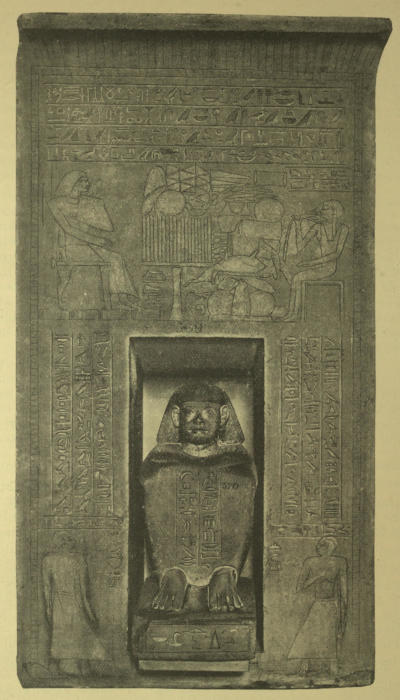
Plate XXIV.
Sepulchral tablet and seated portrait figure of Sa-Hathor, a mining inspector in the Sûdân, in the reign of Ȧmenemḥāt II, B.C. 2400.
[Southern Egyptian Gallery, Bay 1, No. 143.]
The reign of Ȧmenemḥāt II was prosperous, but uneventful; and no military expeditions of importance were necessary either in the Peninsula of Sinai or in Nubia. There was a large colony of Egyptians at Sarâbît al-Khâdim, and a temple was built there in this reign to Hathor, the goddess “of the land of[215] the turquoise.” The search for gold was carried on actively in the Sûdân, under the direction of Sa-Hathor, who tells us on his stele (Bay 1, No. 143; see Plate XXIV) that he worked in the mining districts when he was a young man, and that he made the chiefs wash out the gold; he brought back turquoises and went to the Land of the Blacks, or Sûdân, and collected the products of the country for his master. His knowledge of stone working induced the king to send him to superintend the hewing of the ten royal statues which he placed before his pyramid tomb. An interesting event of this period was the despatch of an expedition to Punt under the direction of Khent-khat-ur, who returned safely with his men in the 28th year of the king’s reign. In the third year of Ȧmenemḥāt II died the Erpā Sa-Menthu, a royal scribe and overseer of works. He was born in the reign of Ȧmenemḥāt I, and was appointed scribe, etc., by Usertsen I. His sepulchral stele is a fine example of its class (Bay 6, No. 145). Another interesting stele of this reign is that of Khenti-em-semti, a royal official, and confidential servant and treasurer to the king; he visited Elephantine and Abydos (Bay 1, No. 146). The official Khenti-em-semt-ur was a libationer priest who ministered in the chapel attached to the royal pyramid called “Kherp” 𓌂𓉴𓊖𓏏𓏤 (Bay 1, No. 147). The door socket (Bay 5, No. 148), dated in the 30th year of the reign of Ȧmenemḥāt II, comes from a royal building in Lower Egypt, and the seated figure of Hathor (Bay 1, No. 149), dedicated to the goddess by Seneferu, the overseer of the boats, from Ṣarâbît al-Khâdim, dates from the time of the opening of the new mines in the Peninsula of Sinai. The three dated stelae of Ȧmenemḥāt (13th year), Seḥetepȧb (19th year), and Menu-Nefer (29th year) are valuable examples of the funerary stelae of this reign (Bay 1, No. 150; Bay 7, No. 151; and Bay 5, No. 152), and the stelae of Seneferu (Bay 3, No. 153), and Sen-ȧtef (Bay 1, No. 154).
The reign of Usertsen II was long and prosperous, but uneventful. Active labour went on in the turquoise and gold mines, and the quarries at Elephantine were worked under the direction of Sa-Renput, the Governor of Nubia. Usertsen II built a pyramid tomb at Al-Lâhûn, of wonderful design and construction. It seems that he developed trade in the Red Sea, and took care to keep in check the tribes of the Eastern Desert. Classical writers call him “Sesostris” and describe him as a great[216] conqueror and traveller, but up to the present the Egyptian monuments have not justified these assertions. Among the monuments of his reign may be mentioned the stele of Sebek-ḥetep, the boat-builder, and Tchaa, a palace official (Bay 9, No. 155, and Bay 1, No. 156), each of which is dated in the 6th year of Usertsen II, and the lower portion of a black granite figure of Sa-Renput, the “Great Chief in Ta-Kenset” (i.e., Nubia), the “great father of the King of the South, and the great one of the King of the North.” Sa-Renput held many high offices at Elephantine and was one of the greatest of the feudal chiefs of his time (Vestibule, No. 157).
Usertsen III, who was associated with his father in the rule of the kingdom, was probably the greatest king of the XIIth dynasty. The principal events of his reign were the conquest and occupation of all the Northern Sûdân. As a preparation for this work, he made, or cleared out, a canal about 250 feet long, 34½ feet wide, and 26 feet deep, in the First Cataract, so that he might pass boats through it to the south. In the 8th year of his reign he sailed up to Wâdî Ḥalfah, and, passing on to one of the great “Gates” in the Second Cataract, he built two forts, one on each bank, at the places now called Semnah (west bank) and Kummah (east bank). He also built a fort to the north, on the Island Gazîrat al-Malik, and others probably on the islands in the Nile to the south. In fact, he occupied the whole of the gold-producing country of the Northern Sûdân. He set up a stele at Semnah to mark the limit of his kingdom on the south, and caused to be inscribed on it a decree in which the Blacks were prohibited from entering Egyptian territory without permission. Eight years later he set up two inscribed stelae in which he vaunted his own boldness, prompt action, and invincibility, and abused the Blacks, calling them cowards, runaways, etc. He says: “I have seen them, I made no mistake about them. I seized their women, I carried off their men and women when I came to their wells, I slew their bulls, I destroyed their grain, and set fire [to their houses].” Usertsen III established a line of forts at regular intervals along the River Nile between Elephantine and the famous rock called Gebel Dôsha, and garrisoned them with Egyptian troops; and was thus able to ensure the safe transport of gold into Egypt, where the precious metal was required in ever-increasing quantities. He repaired and added to many of the great temples of Egypt, e.g., Tanis, Bubastis, Abydos, Herakleopolis, Thebes, Elephantine, etc., and he built a pyramid tomb for[217] himself at Dahshûr. Among the monuments of this king and his reign may be mentioned: Three grey granite statues of Usertsen III (Nos. 158, 159, 160) which were found in the South Court of the temple of Neb-ḥap-Rā Menthu-ḥetep at Dêr al-Baḥarî. These fine statues appear to represent the king at different periods of his life, and in finish and execution they stand unrivalled among the monuments of the period. On the plinth of No. 158 (Bay 1) are cut the king’s Horus name Neter Kheperu, and his name as king of the South and North (see above, page 116) 𓍹𓇳𓈍𓂓𓂓𓂓𓍺 (see Plate XXV). Head of a colossal granite statue of Usertsen III (Bay 1, No. 161); a portion of a seated figure of the king from Ṣarâbît al-Khâdim (Bay 1, No. 162); and the lower portions of two quartzite statues of the king (Vestibule, Nos. 163, 164). No. 164 was usurped by Uasarken II, of the XXIInd dynasty, who cut his cartouches upon the pedestal. The building activity of the king at Bubastis is marked by the granite slabs from that site in Bay 23 (Nos. 166 and 167) on which is cut the royal prenomen. No. 167 is of interest, for here we see part of the prenomen of Rameses II cut over that of Usertsen III. Of the prominent officials who flourished in this reign we have the stele of Ȧn-ḥer-nekht, the overseer of the granaries, dated in the 7th year (Bay 1, No. 168); the stele of Ȧmeni, who carried out certain works at Elephantine in connexion with the king’s expedition into Nubia, dated in the 8th year (Bay 3, No. 169); and the stele of Sebek-ḥetep, a warder of a temple, dated in the 13th year (Bay 5, No. 170).
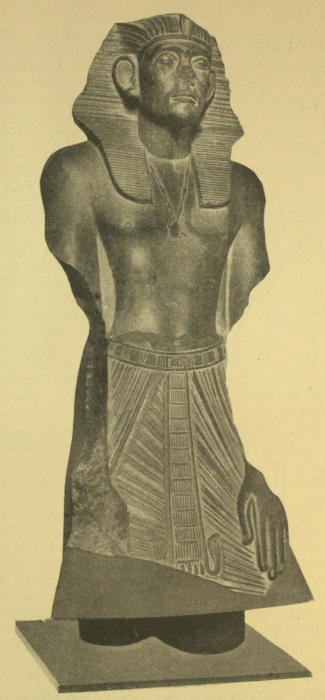
Plate XXV.
Granite statue of Usertsen III, B.C. 2330.
XIIth dynasty.
[Northern Egyptian Gallery, Bay 1, No. 159.]
Ȧmenemḥāt III reigned about fifty years, and devoted all his energies to improving the prosperity of his kingdom. Art, sculpture, architecture, and trade of all kinds flourished under his fostering care; and the remains of his buildings and inscribed monuments bear witness to the activity which must have prevailed among all classes of handicraftsmen during his reign. The mines of Sinai, the Wâdî Ḥammâmât, Ṭura, and elsewhere were diligently worked, and the king carried out large irrigation works in connexion with the great natural reservoir in the Fayyûm, which is commonly known by the name of Lake Moeris (from the Egyptian Mu-ur, or Ma-ur) 𓈗𓅨𓂋, 𓈘𓅨𓂋𓈗. The circumference of this reservoir was 150 miles, and its area 750 square miles; its average level was 80 feet above the Mediterranean. In Nubia also he appears to have undertaken irrigation works, for several[218] “levels” are cut on the rocks near the Forts of Usertsen III at Semnah and Kummah, with the years of the king’s reign in which they were cut. They show that the level of the river during the inundation was about 26 feet higher than it is at the present time. Ȧmenemḥāt III is also thought to have built the Labyrinth, which Herodotus says (ii, 148) contained twelve courts, and 3,000 chambers, 1,500 above ground and 1,500 under ground, and covered an area about 1,000 feet long and 800 feet broad. It was dedicated to the crocodile-god Sebek; and many sacred crocodiles were buried in a place specially set apart for them. Ȧmenemḥāt III built a pyramid at Ḥawârah, and he and his daughter Ptaḥ-Nefert were buried in it. From the ruins of the chapel at the entrance to this pyramid came the limestone slab inscribed with the king’s names and titles exhibited in Bay 5 (No. 171).
Foremost among the monuments of this reign must be mentioned the colossal grey granite seated statue, and the head, which probably belongs to it, exhibited in the Southern Egyptian Gallery (Bay 22, Nos. 774, 775; see Plate XXVI). The inscription on the pedestal of the throne was cut there by order of Uasarken II, a king of the XXIInd dynasty; but it is certain that an earlier inscription existed, which was erased to make room for the new one. The features of the face and the general treatment of the head resemble those of all other extant inscribed statues and figures of Ȧmenemḥāt III; compare the cast of the statue in the Hermitage at St. Petersburg (Bay 2, No. 172), and the cast of a head from a statue of the king (No. 172, in Wall-case 101, in the Third Egyptian Room). To his reign also belong the famous sphinxes which were found at Ṣân (Tanis) in 1861, and were for many years attributed to the Hyksos, because the name of Ȧpepȧ was cut on a shoulder of one of them. On the cast of one of these exhibited in the Central Saloon (No. 173) are inscribed cartouches of Rameses II, Mer-en-Ptaḥ II, and Pasebkhānut. Of officials who flourished in this reign we have the fine white limestone shrine of Pa-suten-sa, from Mêdûm, surmounted by the figure of a hawk (Bay 1, No. 174); the stele of Nebpu-Usertsen, one of the king’s personal attendants (Bay 2, No. 175); the stele of Usertsen-senbu 𓄊𓋴𓂋𓏏𓊃𓈖𓋴𓈖𓃀𓋴𓈖𓃀𓋴𓈖𓃀, a veritable royal kinsman, and a commissioner of the revenue, dated in the 25th year of the king’s reign (Bay 1, No. 177); and the stele and altar of Sebek-ḥer-ḥeb and Kemen, dated in the 44th year of the[219] king’s reign[32] (Bay 3, Nos. 179, 180). The stele of Tati-ānkef (Bay 5, No. 181), the son of Tenȧuit, is of peculiar interest, for it was found in Malta (see page 220).

Plate XXVI.
Head of a colossal seated statue of Ȧmenemḥāt III (?), B.C. 2300.
[Southern Egyptian Gallery, Bay 22, No. 774.]
The reign of Ȧmenemḥāt IV was short, and monuments of his reign are few. His name is found on the rocks in the copper mines in Sinai, and on a rock at Kummah in Nubia, but details of his reign are wanting. An interesting glazed steatite plaque, bearing his name and that of Prince Ȧmeni, will be found in Wall-case 150 in the Fourth Egyptian Room, No. 1.
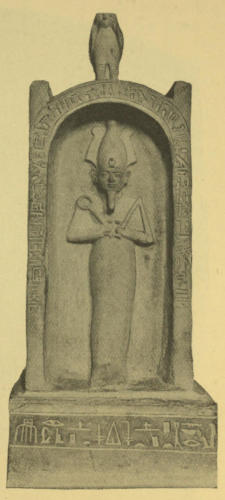
Shrine dedicated to Osiris by Pa-suten-sa, scribe, who flourished in the reign of Ȧmenemḥāt III, B.C. 2300.
[Northern Egyptian Gallery, Bay 1, No. 174.]
The last ruler of this dynasty was Sebek-neferut-Rā, the Skemiophris of Manetho, and sister of Ȧmenemḥāt IV; her reign was short, and her monuments are few. The most important is the glazed cylinder-seal inscribed with four of her royal names, exhibited in Table-case D, Fourth Egyptian Room, No. 134.
In connexion with the XIIth dynasty must be mentioned King Ḥer, who may have been a son of Ȧmenemḥāt III, or of Usertsen III (see his scarab, No. 37,652), and an Usertsen with the prenomen of Seneferȧb-Rā, who is sometimes called Usertsen IV.
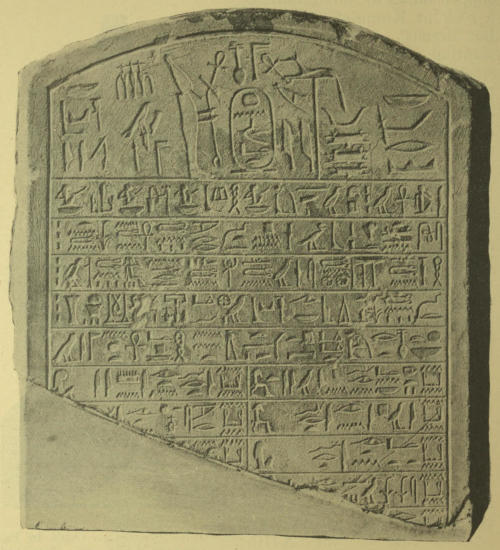
Sepulchral stele of Tatiankef, the son of Tenȧuit. Found in Malta.
XIIth dynasty.
[Northern Egyptian Gallery, Bay 5, No. 181.]
The rule of the XIIth dynasty was long and prosperous; and art, and sculpture, and literature flourished. The art of the period is developed directly out of that of the Ancient Empire, but one of the most prominent characteristics is an increased tendency towards realism which is especially seen in the designs and workmanship of small[220] objects. The Scarabs of the XIIth dynasty are particularly interesting and beautiful, and a splendid set of examples is exhibited in the Fourth Egyptian Room. The sepulchral stelae of the period are also very interesting, and many of them exhibit clearly the transition stages between the “false door” of the maṣṭaba tomb of the Ancient Empire and the stele, or tablet, which stood by itself in the tomb. The British Museum Collection is rich in XIIth dynasty stelae, comprising examples of every important variety. The inscriptions upon them usually open with the formula suten-ṭā-ḥetep, 𓇓𓏙𓊵𓏏𓊪 which is followed by a prayer to one or[221] more gods for sepulchral offerings and for “glory in heaven, strength upon earth, and triumph in the Other World.” Opinions differ as to the meaning of the formula suten ṭā ḥetep. Some think that it is a prayer to “the king to give an offering”; and others that it is a prayer for “an offering like that of a king”; and many different renderings have been proposed by Egyptologists. It is of course possible that, under the IVth dynasty, the formula may have been a prayer that an offering might be given by the king, for the king was regarded as the equal of Anubis and Osiris and other gods of the dead; but it is manifestly impossible that every man throughout Egypt could expect the king to send him an offering at his death, and we are therefore driven to conclude that the original meaning of the formula was forgotten at a very early period, and that it was only prefixed to funerary texts at the dictates of custom or tradition. If it had any meaning at all in the later dynasties, it would probably be that of a petition to one or more gods for the gift of an offering like unto that made for a king after his death. Sepulchral stelae are also valuable because they give the titles of the offices held by deceased persons, and because they often supply biographies of men who played important parts in the history of their country.
Among stelae and other monuments of historical value of this period may be mentioned: Stele from the tomb of Khnemu-ḥetep at Beni-Hasan (Vestibule, No. 182); statue of Ȧmenemḥāt, a veritable royal kinsman,[33] and master of the robes (Bay 1, No. 183); seated figure of Ȧmeni, inscribed with a prayer for offerings (Bay 1, No. 184); stele of Nekhtȧ, a Ḥā Prince (Bay 1, No. 185); stele of Ȧnḥer-nekht, chief clerk of grain supply (Bay 1, No. 186); stele of Ȧntef, an overseer of priests (Bay 1, No. 187); stele of Sa-Ȧnḥer, a deputy keeper of the seal, with figures of eighteen of his children and relatives bearing offerings (Bay 1, No. 189); stele of the lady Khu, with figures of her two husbands and twelve children (Bay 1, No. 190); stele set up to the memory of sixteen persons and their mothers (Bay 2, No. 191); stele of Sebek-āāiu, with hieroglyphics inlaid with blue paste (Bay 2, No. 193); stele of Ȧmeni, of unusual style (Bay 2, No. 194); stele of Erṭā-Ȧntef-Ṭāṭāu, a governor of the Sûdân (Bay 4,[222] No. 196); and stele of Ȧntef, with an inscription of twenty lines in which the deceased describes his virtues and abilities (Bay 7, No. 197). As examples of the wall-paintings on the tombs of this period may be mentioned the slabs from the tomb of Teḥuti-ḥetep, a high official who flourished during the reign of Ȧmenemḥāt II (Bay 2, Nos. 198-200; Bay 7, No. 201). To the same period, or a little later, belongs the sandstone obelisk which was set up to the memory of an Egyptian official of the copper mines at Ṣarâbît al-Khâdim in the Peninsula of Sinai (Bay 1, No. 202).
The other monuments of the XIIth dynasty consist of altars, or tablets for offerings, of which a considerable number are exhibited in Bays 14, 16, and 17. Among the altars of the XIIth dynasty may be noted that of the Ḥā prince Usertsen, a superintendent of the prophets, sculptured with figures of vases and two tanks, and inscribed with an address to the living (Bay 17, No. 269). The altar is a rectangular, flat slab of stone, with a projection which was intended to serve as a spout, from which the drink offerings were supposed to run off into a vessel placed to receive them. In the altar small rectangular tanks were sometimes cut, but usually the surface was sculptured with figures of haunches of meat, bread-cakes, fruit, flowers, unguent vases, libation jars, etc., and on the edges and sides were inscribed prayers for funerary offerings of meat and drink and for things which were deemed necessary for the dead. The Egyptians believed that the material things placed on such altars possessed, like animated creatures, two bodies and spirits; their bodies were consumed by the priests and others, and their spirits by the gods. Some believed in the transmutation of offerings.
We now come to a period, i.e., that of the XIIIth, XIVth, XVth, XVIth, and XVIIth dynasties, which is full of difficulties. Not only is the order of the succession of the kings of these dynasties unknown, but authorities differ greatly in their estimate of the length of the period of their rule. Some say that the interval between the XIIth and the XVIIIth dynasties consisted of more than 500 years, and others that it was less than 200 years. The figures given by Manetho are as follows:—
| XIIIth | dynasty. | From Thebes. | 60 | kings | in 453 years. |
| XIVth | ” | ” Xoïs. | 76 | ” | in 184 (or 484 years). |
| XVth | ” | Shepherds. | 6 | ” | in 284 years. |
| XVIth | ” | Shepherds. | 32 | ” | in 518 years. |
| XVIIth | ” | Shepherds. | 5 | (?) kings | in 151 years. |
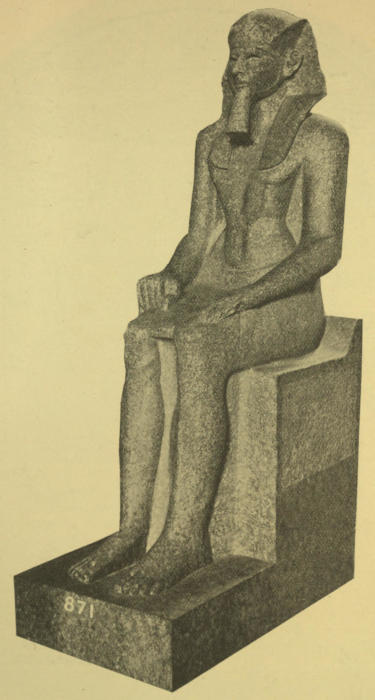
Plate XXVII.
Granite statue of King Sekhem-uatch-taui-Rā.
XIIIth or XIVth dynasty, B.C. 2000.
[Northern Egyptian Gallery, Bay 1, No. 276.]
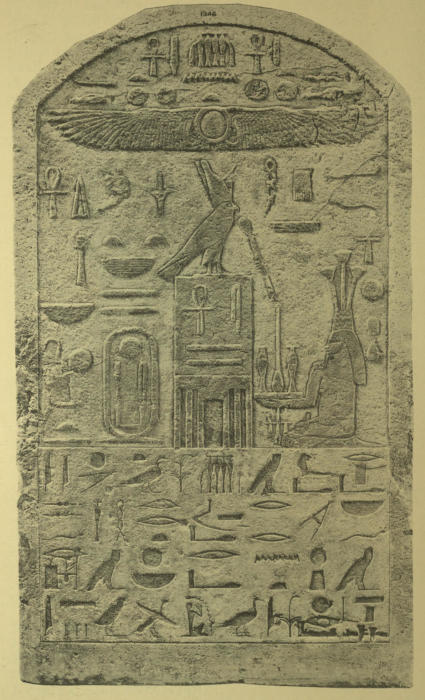
Plate XXVIII.
Stele of the reign of Sekhem-ka-Rā, a king of the XIIIth dynasty, about B.C. 2000.
[Northern Egyptian Gallery, Bay 2, No. 277.]
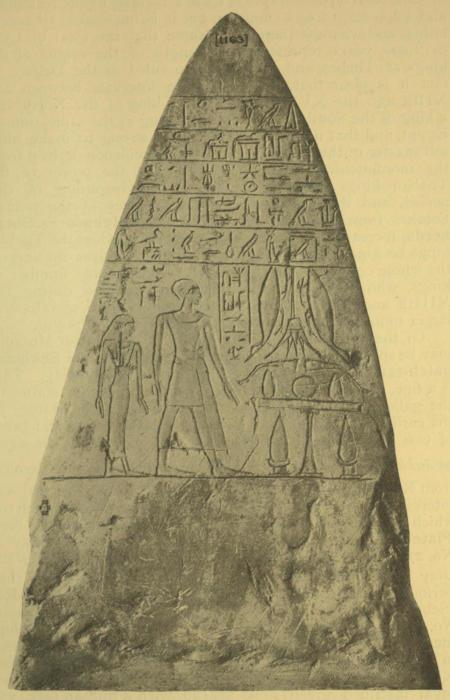
Plate XXIX.
Memorial cone of Sebek-ḥetep, a scribe, who flourished in the reign of Sebek-em-sa-f, B.C. 2000.
XIIIth dynasty.
[Northern Egyptian Gallery, Bay 1, No. 280.]
The total of these years is 1,590 according to one reckoning and 1,290 according to another, but it is impossible to accept either, and we must therefore assume that the total of 1,590 or 1,290 years represents the length of the reigns of the kings at Thebes, and of those who ruled in the Delta. In fact it is clear that, except at rare intervals, between the XIIth and the XVIIIth dynasties a king of the North and a king of the South were always reigning at the same time in Egypt, and that neither was sufficiently strong to make himself master of the whole country. The evidence derived from the monuments seems to indicate that the power of the Theban kings declined steadily at the beginning of this period, and that, as it declined, the power of the nomad Semites from the east, who are known as Hyksos or Shepherds, increased until the end of the period, when the Theban kings became strong enough to make themselves masters of the whole country. The names of a considerable number of kings, who may be assumed to have reigned during the XIIIth and XIVth dynasties, are known from scarabs and larger monuments, but nothing is known of their reigns.
Of the monuments of the period in the British Museum may be specially noted: Red granite seated figure of Sekhem-uatch-taui-Rā, a king of the XIIIth or XIVth dynasty. This is a fine piece of sculpture, and is unlike any other statue in the gallery. The body lacks the heaviness of the statues of the earlier period. On the throne are cut, in outline, figures of two lions placed back to back. Above them are the signs sa ānkh 𓎂𓋹, i.e., the “fluid of life,” which the king derived from Rā, the Sun-god (see Plate XXVII; Bay 1, No. 276). Of interest also are three stelae of private individuals, each of which mentions the name of a king, viz., Sekhem-ka-Rā (see Plate XXVIII), with the Horus name of Sānkh-taui (Bay 2, No. 277), Sebek-ḥetep, with the prenomen of Khā-nefer-Rā (Bay 5, No. 278), and Ȧb-ȧā (Bay 5, No. 279). To this period belongs the axe handle of Sekhem-uatch-taui-Rā (Sebek-ḥetep) a king (Table-case E, Third Egyptian Room, No. 104). To a somewhat later period belong the interesting memorial cone of the scribe Sebek-ḥetep, who flourished in the reign of Sebek-em-sa-f (see Plate XXIX), of the XIVth dynasty, a unique object (Bay 1, No. 280), and the royal inscribed green stone scarab, with a human face, set in a gold plinth, which probably came from the tomb of this king at Thebes (Table-case J, Fourth Egyptian Room, No. 195). Of interest, too, are the royal stele of the little-known[224] king Ȧp-uat-em-sau-f (Bay 3, No. 281); the stele of Ḥetep-neteru and Teḥuti-āa, which mentions another hitherto unknown king (Bay 4, No. 282); the stele of Ptaḥ-sānkh, mentioning king Rā-Ḥetep (Bay 5, No. 283); and the slab from the temple of Osorkon II at Bubastis, inscribed with the name of Sekhem-khu-taui-Rā (Bay 23, No. 284).
To a great many stelae of private individuals, who flourished between the XIIth and the XVIIIth dynasties, it is difficult to assign exact dates, for very few of them mention royal names, and the inscriptions cut on them afford no clue. Fine examples of the transition period of funerary sculpture, stelae, etc., are: Stele of Nebȧ, an inspector (Bay 1, No. 285); grey granite portrait figure of an official of Athribis (Bay 2, No. 288); granite figure of Nefer-ȧri, from Bubastis (Bay 2, No. 289); stele of Pai-neḥsi, the store keeper of the gold which came from the Sûdân (Bay 7, No. 299); stele of Ȧntef-Ȧqer-ānkh-khu (Bay 7, No. 301); stele of Queen Mer-seḳer (Bay 9, No. 330).
The Hyksos.—Comparatively soon after the downfall of the XIIIth dynasty, the Delta and northern parts of Egypt were little by little occupied by a confederation of Semitic nomad tribes to whose leaders, on the authority of Flavius Josephus, the historian (who died about A.D. 100), the name of Hyksos or Shepherd Kings has been given. The word Hyksos is derived from two Egyptian words Ḥequ-Shasu 𓋾𓈎𓀀𓏪𓆷𓄿𓇓𓅱𓏪, i.e., the Shêkhs or Governors of the Shasu,[34] or nomadic tribes of the Eastern Desert, Syria, etc. It is extremely unlikely that they fought for the possession of Egypt; and we may assume that they migrated into the Delta, and that, after a few generations, they found that their power and numbers were sufficiently great to enable them to assume the mastery of the whole country of Lower Egypt. The Hyksos, who had settled in the Delta, adopted, little by little, the manners and customs of the Egyptians; and at length their chiefs adopted the Egyptian language and religion, and assumed the titles of the old Pharaohs, and became to all intents and purposes Egyptian kings. They apparently worshipped several gods, the chief[225] of whom was Sutekh 𓇓𓏲𓏏𓐍𓀭, and him they identified with Set 𓋴𓏏𓈜𓃩, or Suti 𓇓𓅱𓏏𓏭𓃩, the old Egyptian god of darkness and evil.
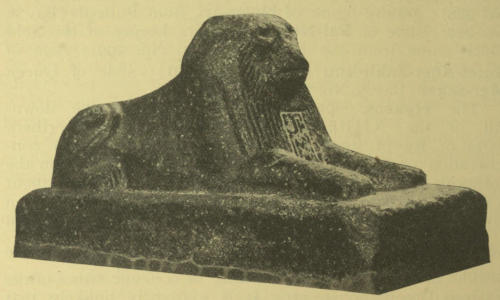
Granite lion inscribed with the name of Khian, a Hyksos king, about B.C. 1800.
[Northern Egyptian Gallery, Bay 5, No. 340.]
According to Josephus the chief kings of the Hyksos were: Salatis, who reigned at Memphis, and fortified the city of Avaris, near Tanis, and garrisoned it with 250,000 men; he reigned 13 years. He was succeeded by Beon, who reigned 44 years, and Apachnas, who reigned 36 years and 7 months, and Apophis, who reigned 61 years, and Jonias who reigned 50 years and 1 month, and Assis, who reigned 49 years and 2 months. Of the objects in the British Museum which belong to the Hyksos Period may be mentioned: 1. The famous Mathematical Papyrus (No. 10,058), which was written in the reign of Āa-user-Rā 𓍹𓇳𓉻𓂝𓄊𓋴𓍺, or Ȧpepȧ I; 2. A red granite slab from the temple of Bubastis, inscribed with the name of Ȧpepȧ 𓍹𓇋𓀁𓊪𓊪𓇋𓍺 (Bay 23, No. 339); 3. A scarab inscribed Āa-peḥ, the prenomen of Nubti, a king whose cartouches appear on the famous Stele of 400 years[35] (No. 32,368); 4. The granite[226] lion (Bay 5, No. 340) on the breast of which is cut the cartouche 𓊹𓄤𓍹𓇳𓋴𓈖𓍺 Suser-en-Rā, i.e., the prenomen of King Khian 𓍹𓐍𓇌𓄿𓈖𓍺. This lion was purchased at Baghdad, but its provenance is unknown. Besides these the British Museum possesses a large number of scarabs of the Hyksos Period inscribed with the names of kings and royal personages.
Another Hyksos king, Āa-qenen-Rā Ȧpepȧ II, is made known to us by Sallier Papyrus II (No. 10,185), which shows that he was a contemporary of one of the Theban kings called Seqenen-Rā. According to this document there was enmity between Ȧpepȧ II and Seqenen-Rā, his vassal, but as the papyrus is mutilated the result of their enmity is unknown.
During one portion of the Hyksos Period a group of petty kings, or chiefs, each of whom was called Ȧntef-āa, ruled either at Thebes or Coptos, and a few of their monuments have come down to us. In the British Museum are: 1. Stone memorial pyramid of Ȧntef-āa Ȧp-Maāt (Vestibule, South wall, No. 341); 2. Slab sculptured with a figure of Ȧntef Nub-kheper-Rā (Bay 4, No. 342); 3. Gilded coffin of Ȧntef-āa (Wall-case 2, First Egyptian Room).
It has been said above that there was enmity between Ȧpepȧ II and Seqenen-Rā, but the monuments prove that there were three kings who bore the Seqenen-Rā prenomen, and it seems that all three waged war against the Hyksos in the north; their full names were Seqenen-Rā (I), Tau-āa, Seqenen-Rā (II), Tau-āa-āa, Seqenen-Rā (III), Tau-āa-qen. The greatest warrior of the three was undoubtedly the last named, and it was he who determined to throw off the yoke of the foreigner. He was supported by all classes of Egyptians, for the Hyksos were hated, and especially by the priests of Ȧmen-Rā at Thebes, who regarded the demand of the Hyksos king that Seqenen-Rā III should worship the god Sutekh as a grave insult to their god Ȧmen-Rā. Seqenen-Rā III refused to worship Sutekh, and proclaimed his independence. Of the battles which were fought during the war that followed nothing is known, but it is clear that in one of them the brave leader in the struggle for national independence was slain. When his mummy was unrolled at Cairo, in 1886, it was seen that the lower jaw-bone was broken and the skull split; there were also large wounds in the side of the[227] head and over the eye, and one ear had been hacked away. Tau-āa-qen was succeeded by his son (?) Ka-mes, whose reign was, however, short. To him belonged the fine bronze axe-head inscribed with his names and titles exhibited in Table-case B in the Third Egyptian Room (No. 5), and the spear head, similarly inscribed, of which see a cast in the same case (No. 191). Ka-mes had several children by his wife Ȧāḥ-ḥetep, and some of their sons may have ruled for a short time; but the country was very unsettled, and the first to succeed in restoring law and order was Ȧāḥmes, or Amāsis I, the founder of the XVIIIth dynasty.
About B.C. 1600.
Under this dynasty Egypt formed her empire in Western Asia, and conquered and occupied the Egyptian Sûdân, probably so far south as the Baḥr al-Ghazâl. The Hyksos were expelled from Egypt by the first kings of the dynasty, and the peoples in the Eastern and Western Deserts were held in check with a firm hand. King after king made frequent raids on a large scale into Syria and the Sûdân, and on each occasion brought back untold spoils, a considerable proportion of which was expended on the building of great temples like those of Karnak, Luxor, and Dêr al-Baḥarî. Trade developed to an unprecedented extent, and riches increased; and the king and his priests and nobles were able to gratify their love of splendid temples, colossal statues, lofty obelisks, large palaces, fine houses and gardens, decorated furniture, elaborate jewellery, costly tombs, etc. Under the patronage of the priesthood and the temple-schools education prospered, literature, art, painting and sculpture flourished, and the vast works which were undertaken by the Government encouraged handicraftsmen of every kind in the production of the best work. Among the kings of this dynasty were the greatest and most powerful sovereigns that ever ruled Egypt, viz., Thothmes III and Ȧmen-ḥetep III.
The first king of the dynasty was Ȧāḥmes, or Amāsis I, who carried on the war against the Hyksos which Seqenen-Rā had begun. He captured the city of Avaris, the stronghold of the Hyksos, and turned the enemy out of the country, and in the fifth year of his reign he captured the city of Sharuhen (mentioned in Joshua xix, 6), in Syria. He subsequently invaded Nubia and compelled the tribes to pay tribute. Among the monuments of his reign are the massive granite altar inscribed with his name (Bay 16, No. 343); the head of a seated[229] figure of Nefert-ȧri, his wife (Bay 12, No. 344); the ushabti figure of the king (Wall-case 84, Second Egyptian Room, No. 129); and the portrait of the Queen (Case 1, Third Egyptian Room, No. 3).

Statue of Ȧmen-ḥetep I, B.C. 1600, in the form of Osiris, wearing the Crown of the South.
[Northern Egyptian Gallery, Bay 3, No. 346.]
Ȧmen-ḥetep I, the son of Amāsis I, continued the war in Nubia, and the rebuilding of the temple of Ȧmen and other sanctuaries; he was the founder of the great brotherhood of the Priests of Ȧmen. From a building made by him at Dêr al-Baḥarî came the magnificent painted limestone statue of the king, in the mummied form and with the White Crown of Osiris, exhibited in the Northern Egyptian Gallery (No. 346), and the stele on which are sculptured figures of Neb-Ḥapt-Rā Menthu-ḥetep and Ȧmen-ḥetep I (Bay 9, No. 347). Other interesting monuments of this reign are: the stele of Pa-sheṭ, a judge, who is seen adoring the king and queen (Bay 7, No. 348); and a stele with figures of the king and queen (Bay 9, No. 349). The inscriptions and scenes on several stelae show that Ȧmen-ḥetep I and his queens were included among the gods; see the stelae of Ḥui (Bay 8, No. 352), Pa-ren-nefer (Bay 8, No. 353), Ȧmen-em-Ȧpt (Bay 10, No. 354), Ȧmen-men (Bay 10, No. 355), and Ḥui, son of Nefert-ithȧ (Bay 11, No. 357).
Teḥuti-mes I, or Thothmes I, the son of Ȧmen-ḥetep I, made Napata, at the foot of the Fourth Cataract, the border of his kingdom to the south; and he waged war in Northern Syria. He added to the temple of[230] Ȧmen, and set up obelisks at Karnak. Among objects bearing his name are two bricks and a steatite vase inscribed with his prenomen and name (Wall-cases 150 and 175 in the Fourth Egyptian Room).
Thothmes II, the son of Thothmes I and Mut-Nefert, married his half-sister Ḥātshepset; during his short reign, war was carried on in Syria and Nubia, and many temples in Egypt and forts in Nubia were repaired or rebuilt. Among the monuments of this reign may be mentioned the scarabs in Table-case D (Fourth Egyptian Room) and a portion of a slab inscribed with his Horus name (Third Egyptian Room, Wall-case 103, No. 937).
After the death of Thothmes II, his widow Ḥātshepset reigned alone for some years, and she built the famous temple of Dêr al-Baḥarî, the walls of which she decorated with reliefs illustrating her Expedition to Punt. The temple was called “Tcheser-Tcheseru,” i.e., “Holy of Holies,” and the architect was Senmut; it was built close to the temple of Menthu-ḥetep Neb-ḥap-Rā, and was ranged in three terraces. It was enclosed by a wall, and was approached by an avenue of sphinxes, which led to the pylon at the entrance, where stood two obelisks. She also set up two great granite obelisks in honour of her father Thothmes I. About twenty years before her death she associated her nephew Thothmes III with her in the rule of the kingdom. Many scarabs, a gold ring, a wooden cartouche, and an alabaster vase, inscribed with her names and titles, are exhibited in the Fourth Egyptian Room (Table-cases P and J and Wall-case 139).
Thothmes III, the son of Thothmes II and the lady Ȧset, was the greatest of all the kings of Egypt; he reigned for about 53 years, 21 years as co-regent with Ḥātshepset, and 32 years alone. Soon after he became sole ruler of Egypt he began a series of campaigns in Palestine, Syria and other countries of Western Asia, and his arms were everywhere victorious. In the first campaign he captured the city of Megiddo, in Syria, and brought back an immense quantity of spoil. Subsequently he undertook some fifteen campaigns into different parts of Western Asia; and towards the close of his reign he appears to have raided the Sûdân. The vast wealth which he drew from Asia enabled him to be a generous friend of the priesthood, and to repair, rebuild and enlarge and found sanctuaries for the great gods of Egypt. He carried on extensive building operations at Heliopolis, Memphis, Abydos, Denderah, Coptos, Dêr al-Baḥarî, Madînat Habû, Hermonthis, Esna, Edfû, etc.; but his greatest work was the colonnade[231] which he built in the temple of Ȧmen at Karnak, 150 feet long, 50 feet wide, with 50 columns and 32 rectangular pillars (see Plate XXX). He founded the temple of Ṣulb (Soleb) near the Third Cataract, and dedicated a temple at Semnah to Usertsen III. At Karnak and elsewhere he set up magnificent granite obelisks, one of which, commonly called Cleopatra’s Needle, now stands on the Thames Embankment. He was buried in the valley of the Tombs of the Kings at Thebes; and his mummy was wrapped in a linen sheet inscribed with the text of the CLIVth Chapter of the Book of the Dead, and extracts from the Litany of Rā.
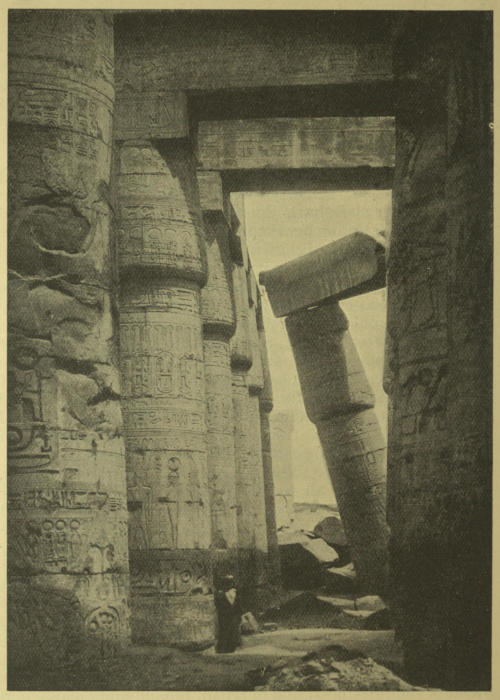
Plate XXX.
The Hall of Columns in the great temple of Ȧmen-Rā, at Karnak.
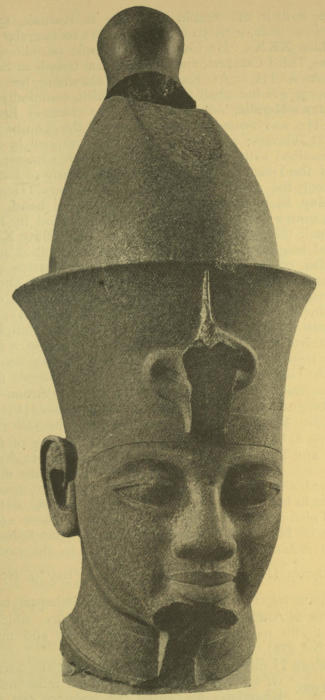
Plate XXXI.
Head from a colossal granite statue of Thothmes III, B.C. 1550.
[Northern Egyptian Gallery, Bay 2, No. 360.]
Among the many monuments of Thothmes III and his reign may be mentioned: 1. The magnificent head, in red granite, from a colossal statue of the king, found by Belzoni at Karnak (No. 360, Northern Gallery; see Plate XXXI); the total height of the head and crown is 9 ft. 5 in., and the width of the face is 2 ft. 7½ in. 2. Massive granite monument with figures of the god Menthu-Rā and Thothmes III in relief (Bay 2, No. 363). 3. Fragment of the obelisk set up by the king at Heliopolis (Bay 12, No. 364); and a door jamb from a temple of Thothmes III at Wâdî Ḥalfah (Bay 10, No. 365). Of interest, too, are the cast of a granite sphinx bearing the name of Thothmes III on its breast (Northern Gallery, No. 366); the cast of the famous granite stele inscribed with an address to the king by Ȧmen-Rā, in which the god describes the exploits of Thothmes III (Central Saloon, No. 367); portion of a stele dated in the 35th year of Thothmes III (Bay 11, No. 368); slab with scenes of Ȧmen-ḥetep I and Thothmes III adoring the gods (Bay 12, No. 369). Among smaller objects inscribed with his name may be mentioned the glass jug, gold rings, razor (?), tools and weapons in bronze, and bricks made of Nile mud, exhibited in the Third and Fourth Egyptian Rooms. There are also the stele of Messnȧu, a priest in his temple (Bay 8, No. 372), and the statue of Netchem, who prayed to the royal Ka of Thothmes III 𓇓𓏏𓈖𓂔𓍹𓇳𓏠𓆣𓍺 (Bay 9, No. 373). To the joint reign of Thothmes III and Ḥātshepset belongs the statue of Ȧnebni, the master of the armoury, which was set up to his memory by his august master and mistress (Bay 9, No. 374).
Ȧmen-ḥetep II fought in Syria, and penetrated the Sûdân as far as Wâd Bâ-Nagaa, about 80 miles north of Kharṭûm; he caused the body of one of the[232] chiefs whom he had slain in Syria to be sent to Napata (Gebel Barkal), and hung upon the city walls to strike terror into the Nubians. Of monuments of his reign may be noted: The royal ushabti figure in diorite (Wall-case 84, Second Egyptian Room, No. 7); the glass and alabaster vessels (Table-case H in the Third Egyptian Room), and the axe-head in Table-case B in the Fourth Egyptian Room; the stele of Ȧthu, second priest of the king (Bay 4, No. 375); and the portion of the bowl dedicated by the scribe Teḥutimes (Bay 12, No. 376).
The reign of Thothmes IV was short and unimportant. He made one or more raids into Nubia, an expedition into Syria; and in the first year of his reign he set up a tablet between the paws of the Sphinx stating that the god of the Sphinx, Ḥerukhuti-Kheperȧ-Rā-Temu, appeared to him one day before he was king, and bade him remove the sand which had closed him in on all sides, and promised him that he should become king if he obeyed. Thothmes undertook the work, and in due course became king. His inscription mentions king Khāf-Rā (Chephren) in connexion with some work (probably a clearing of the sand) performed for the Sphinx. Among the monuments of his reign may be noted the stele of Ȧmen-ḥetep, an officer who accompanied the king into Western Asia and the Sûdân (Bay 11, No. 377); and the stele of Nefer-ḥāt, overseer of the works in the Temple of Abydos (Bay 8, No. 378). Thothmes IV married a lady named Mut-em-uȧa, who became the mother of Ȧmen-ḥetep III. The granite boat which was dedicated to the queen as the counterpart of the goddess Mut, is exhibited in the Northern Gallery (Bay 7, No. 379). For a portion of the head of her seated figure from the boat see Bay 7, No. 380. Some think that Mut-em-uȧa is to be identified with the daughter of Artatama, king of Mitani.[36]
Ȧmen-ḥetep III, the Memnon of the Greeks, declared himself to be an incarnation of the god Ȧmen-Rā; he reigned about 36 years. In the fifth year of his reign he marched into the Sûdân and crushed a rebellion at Abhat, taking 750 prisoners. He subsequently travelled in many parts of that country, and built a magnificent temple there, near the modern village of Ṣulb (Soleb), which he dedicated to himself as the god of the Sûdân. He made many expeditions into Western Asia, and whilst there he enjoyed lion-hunting on a large scale; on the[233] large scarabs exhibited in Table-case D (Fourth Egyptian Room) he states that he shot with his own hand one hundred and two fierce lions during the first ten years of his reign. His frequent visits to Western Asia enabled him to continue the friendly personal relations with the kings and rulers which his father inaugurated; and he married several of their daughters, e.g., a daughter of Kadashman-Bêl, king of Karaduniyash; a daughter of Shutarna, king of Mitani; and a daughter of Tushratta, king of Mitani. He also married a sister of Tushratta called Gilukhipa, who arrived in Egypt with three hundred and seventeen of her principal women. The greatest and best beloved of his wives, however, was Thi, who must also have been of foreign extraction. Judging by the appearance of the mummies of her father, Iuȧa and her mother Thuȧa, which have recently been found, it seems that the former was not an Egyptian, but a native of some part of the Eastern Desert or Southern Syria, while the latter was a native Egyptian woman. Their daughter Thi was a very remarkable woman in every way, and it seems beyond question that her son Ȧmen-ḥetep IV derived from her the monotheistic views which he held.
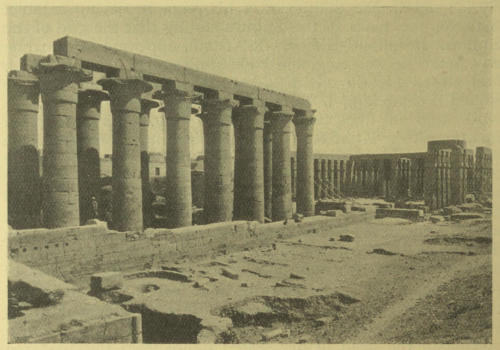
The Temple of Luxor, built by Ȧmen-ḥetep III, B.C. 1450.
The building operations of Ȧmen-ḥetep III were on a very large scale, and extended from one end of Egypt and[234] Nubia to the other. He built the Apis chapels at Ṣaḳḳârah; at Thebes he built a pylon; at Karnak the temple dedicated to the Theban triad, Ȧmen-Rā, Mut and Khensu; in the Southern Ȧpt (i.e., Luxor), a temple to Menthu, and a temple to the goddess Mut, from which come the series of statues of Sekhet, a fire-goddess, exhibited in the Northern Egyptian Gallery, Nos. 381-410. All these buildings were on the east bank of the Nile. On the west bank he erected a great temple, the Memnonium, and in front of it set up two huge statues of himself which are generally known as the Colossi of Memnon (see Plate XXXIII). The northern statue was said to emit a sweet, sad note daily at sunrise, and for this reason was known as the “vocal statue of Memnon”; the sound was never heard after the statue was repaired by the Emperor Septimius Severus (A.D. 193-211). Ȧmen-ḥetep III also built a temple at Al-Kâb, and another to the god Khnemu at Elephantine, and at Saddênga in the Sûdân he built a temple in honour of his wife Thi, who was also probably worshipped there, as the king himself was worshipped in his temple at Ṣulb, which has already been mentioned.
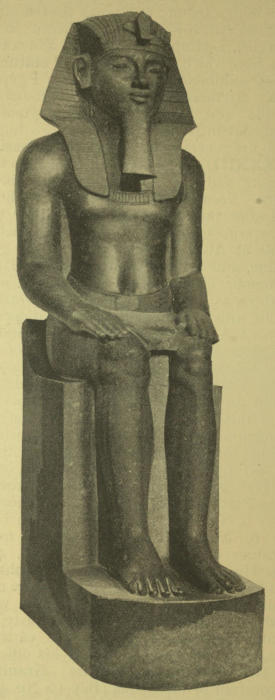
Plate XXXII.
Colossal seated statue of Ȧmen-ḥetep III, B.C. 1450.
[Northern Egyptian Gallery, Bay 8, No. 412.]
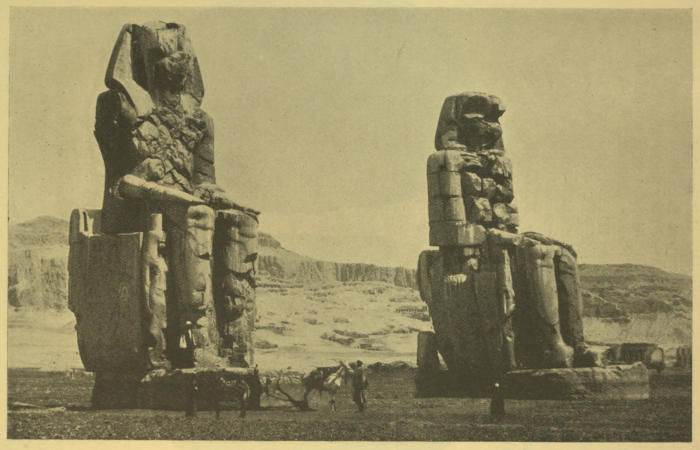
Plate XXXIII.
The statues of Ȧmen-ḥetep III, B.C. 1450, commonly known as “The Colossi.” The statue on the right is the famous “Colossus of Memnon,” from which a sound was said to issue at dawn.
The reign of Ȧmen-ḥetep III was long and prosperous, and his kingdom extended from the city of Nî, on the Euphrates, to Karei, in the Sûdân. He developed the gold mines of the Sûdân to an unprecedented extent, and exported gold to the countries of Western Asia. The monuments of this reign are numerous; among them may be specially mentioned: 1. A tablet inscribed with an account of the crushing of the revolt in Nubia in the fifth year of his reign, set up by Meri-mes, governor of the Sûdân (Bay 6, No. 411). 2. Two colossal seated statues of Ȧmen-ḥetep III (see Plate XXXII), from the Memnonium (Bay 8, No. 412; Bay 9, No. 413). 3. Upper portion of a colossal statue (Bay 6, No. 415), and two heads from colossal sandstone statues of the king (Bay 4, No. 416; Bay 5, No. 417). 4. Head from the granite sarcophagus of the king (Central Saloon, No. 418). 5. Grey granite column from a temple built by him at Memphis (?). It was repaired by Menephthah I under the XIXth dynasty, and about 100 years later Set-nekht inscribed his cartouches upon it (Bay 7, No. 419). The monuments of his officials are also numerous. The most interesting are: Granite coffin of Meri-mes, governor of the Sûdân (Bay 12, No. 420); stele of Sururu, a high official (Bay 7, No. 422), seated figure of Kames, a king’s messenger (Bay 5, No. 423); a slab, with cornice, from the tomb of Pa-ȧri, an overseer of the granaries[235] of Ȧmen-Rā at Thebes (Bay 10, No. 424); stele of Ȧpni, a master of transport (Bay 11, No. 425); painted statue of Pa-ser, an Erpā, from Dêr al-Baḥarî (Bay 13, No. 427); granite statue of Ȧmen-ḥetep, an Erpā, from Bubastis (Bay 12, No. 428), etc. Of special interest are the two fine red granite lions, which were found in the ruins of a temple at Gebel Barkal, at the foot of the Fourth Cataract. No. 430 dates from the reign of Ȧmen-ḥetep III, and appears to have been made by him for the temple of Ṣulb; No. 431 was, according to the inscription, made by Tut-ānkh-Ȧmen, a later king of the XVIIIth dynasty, who “repaired the monuments of his father Ȧmen-ḥetep” (see Plate XXXVI). The name of a late Nubian king, Ȧmen-Ȧsru, is found on each lion, and it is possible that he may have brought both lions to Napata from Ṣulb, and placed them in his own temple. Stelae Nos. 432 (Bay 10) and 433 (Bay 9) are of a most unusual character. No. 432 is a late (Ptolemaïc) copy, written in hieratic, of the deed of endowment of the funerary chapel of Ȧmen-ḥetep, the son of Ḥāp, the famous architect who built the[236] Colossi, dated in the thirty-first year of the reign of Ȧmen-ḥetep III. No. 433 is inscribed with a series of addresses which can be read both perpendicularly and horizontally. Among smaller objects inscribed with the names of Ȧmen-ḥetep III and Queen Thi may be noted the bronze menȧt amulet, stamp, vase, brick, stibium pot, plaque, scarabs, etc., which are exhibited in the Third and Fourth Egyptian Rooms.
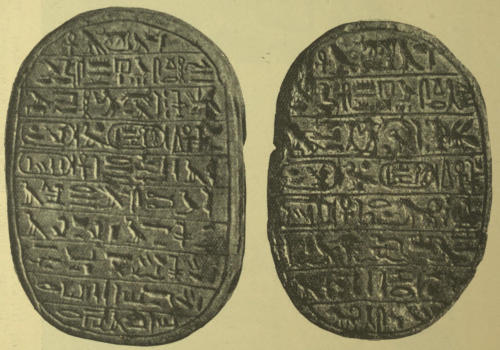
Scarab of Ȧmen-ḥetep III, recording the names of the parents of Queen Thi.
[No. 29,437.]
Scarab of Ȧmen-ḥetep III, recording the slaughter of 102 lions by the king in the first ten years of his reign.
[No. 12,520.]
Of the greatest importance for the history of this reign are the Tell al-Amarna Tablets, a fine collection of which is exhibited in Table-case F in the Babylonian Room. They consist of a series of letters and despatches, etc., written chiefly to Ȧmen-ḥetep III and his son Ȧmen-ḥetep IV, by kings and governors of countries, provinces, and towns in Western Asia. Nearly all are written in a Semitic dialect, and in the cuneiform character. They were found in a chamber to the east of the palace of Ȧmen-ḥetep IV, in the city of Khut-Ȧten, near the modern Tell al-Amarna. Among the royal letters in the British Museum are: Draft of a letter from Ȧmen-ḥetep III to Kadashman-Bêl, king of Karaduniyash (No. 29,784); a letter from Kadashman-Bêl to Ȧmen-ḥetep III (No. 29,787); letters from Tushratta, king of Mitani, to Ȧmen-ḥetep III (Nos. 29,792, 29,791); letter from Burraburiyash to Ȧmen-ḥetep IV (No. 29,785); letter from Tushratta to Thi, queen of Egypt (No. 29,794); etc.[37] (see Plates XXXIV, XXXV).
Ȧmen-ḥetep IV was the son of Ȧmen-ḥetep III and Queen Thi, and reigned about 20 years. In his youth he became a warm devotee of the god Ȧten, whose visible symbol was the solar disc, and rejected the cult of Ȧmen, or Ȧmen-Rā, the king of the gods. During the first few years of his reign he lived at Thebes, and built there a Benben 𓃀𓈖𓃀𓈖𓉐, or shrine, dedicated to Harmachis; and it seems that this was regarded by the priests with disfavour. The pretensions of the priests of Ȧmen were unbearable to him, and he therefore decided to leave Thebes and build a royal capital elsewhere. The site chosen by him[237] was on the east bank of the Nile, near the modern villages of Ḥaggi Ḳandîl and Tell al-Amarna. There he built a temple to Ȧten, a palace for himself, and houses for his officials. As the new capital grew, so the enmity between the king and the priests of Ȧmen increased. This can hardly be wondered at, for he caused the name and representations of the god to be obliterated from the monuments. Having moved to his new city, which he called Khut-Ȧten, he abandoned his name of Ȧmen-ḥetep, because it contained the name of the god he despised, and adopted the new name of Khu-en-Ȧten, i.e., the “Spirit of Ȧten.” In his new capital he established a new form of the ancient cult of Ȧten, as he understood it, in the temple Ḥet-Benben; and the new worship was carried on with the forms and ceremonies which had been in use in Heliopolis for some two thousand years. Incense was burnt on the altars, offerings of all kinds were made, but no bloody sacrifices were offered up; on certain occasions the king himself officiated. The followers of Ȧten declared that their god was almighty; and that he was the sole creator of the universe; they ascribed to him a monotheistic character, or oneness, which denied the existence of any other god. Their god was “One Alone,” and different in nature from any of the other gods of Egypt. It was the intolerance of the followers of the cult of Ȧten as formulated by Ȧmen-ḥetep IV which made them hated by the priests of Ȧmen-Rā at Thebes.
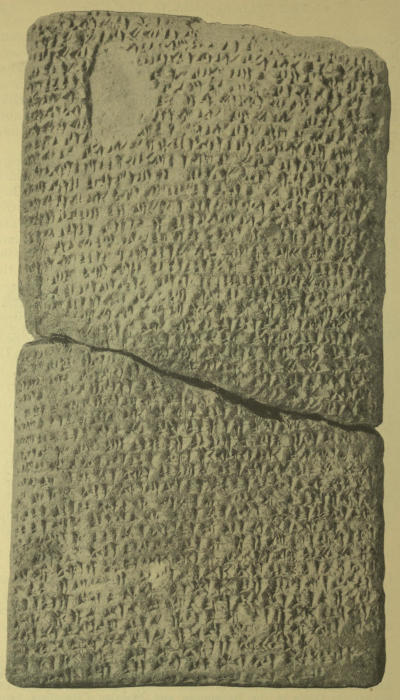
Plate XXXIV.
Letter from Ȧmen-ḥetep III, king of Egypt, to Kadashman-Bêl, king of Karaduniyash.
[No. 1, Table-case F, Babylonian and Assyrian Room.]
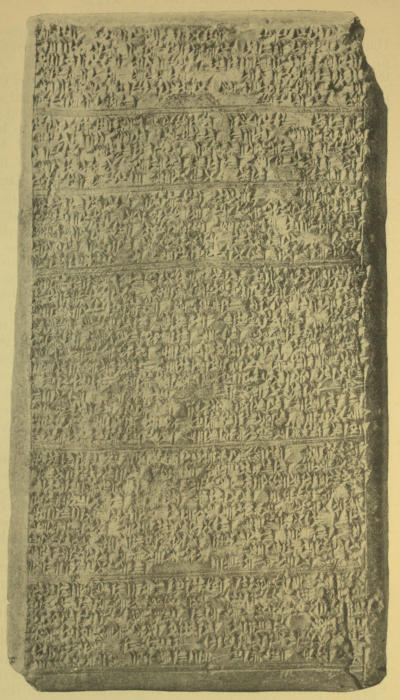
Plate XXXV.
Letter from Tushratta, king of Mitani, to Ȧmen-ḥetep III, king of Egypt.
[No. 8, Table-case F, Babylonian and Assyrian Room.]
The palace and houses of the new city were beautiful, and were richly decorated. Art developed in a new direction, and was characterized by a freedom and a naturalism which are never met with, before or after, in Egyptian history. It sanctioned the use of new colours and new designs. The reliefs and pictures of the king prove that his features were unusual in character. He had a high, narrow, receding forehead, a large aquiline nose, a thin mouth, projecting chin, a slender neck, rounded chest, and his figure in many respects resembled that of a woman (see Wall-case 105, Third Egyptian Room, Nos. 213 and 214). Whilst the king was playing the priest in his new city, and making arrangements for building shrines to Ȧten in the Sûdân, his Asiatic Empire was breaking up. The Tell al-Amarna letters show how rapidly the desert tribes began to harass the Egyptian garrisons in Syria and Palestine, and to hem them in. Ȧmen-ḥetep IV made no attempt to maintain his[238] authority in Asia, or to keep what his fathers had won in battle, and there is no record of any military expedition during his reign. Shortly after his death Egypt had lost her Asiatic Empire, his new city was destroyed, the cult of Ȧten died out, and the shrine of Harmachis which he built at Thebes was pulled down, and the stones rebuilt into the temple of Ȧmen. Ȧmen and his priests had prevailed.
Among the monuments of this reign may be mentioned: 1. Base of a statue of Ȧmen-ḥetep IV, inscribed with the names and titles of Khu-en-Ȧten; his cartouche as Ȧmen-ḥetep IV has been mutilated (Bay 13, No. 435). 2. Base of a statue inscribed with the names of Khu-en-Ȧten and his wife Nefertith (Bay 13, No. 436). 3. Stele of Ptaḥ-māi, inscribed with prayers to Ȧten and Rā (Bay 10, No. 438). The Tell al-Amarna letters to Ȧmen-ḥetep IV will be found in Table-case F in the Babylonian Room; the scarabs, rings, etc., in Table-cases D and J; and a fine porcelain boomerang in Wall-case 150, in the Fourth Egyptian Room. (For a rough outline drawing of Queen Nefertith (?) see Table-case C in the Third Egyptian Room, No. 4.)
The last kings of this dynasty were Tut-ānkh-Ȧmen, Ȧi, and Ḥeru-em-ḥeb; the first two of these married members of the family of Ȧmen-ḥetep IV. Ḥeru-em-ḥeb was a wise and just king, and his reign was long and prosperous. Of the monuments of these reigns may be mentioned: the red granite lion inscribed with the name of Tut-ānkh-Ȧmen (Bay 10, No. 431; see Plate XXXVI); the stele of Thuthu, a steward of Ȧi (Bay 12, No. 439); the granite statue of Ḥeru-em-ḥeb (Bay 13, No. 441), and the statues of Ḥeru-em-ḥeb and the god Menu, or Ȧmsu (Bay 12, No. 442); the stibium tube of Tut-ānkh-Ȧmen and his wife Queen Ānkh-sen-Ȧmen (Wall-case 183, Fourth Egyptian Room, No. 23).
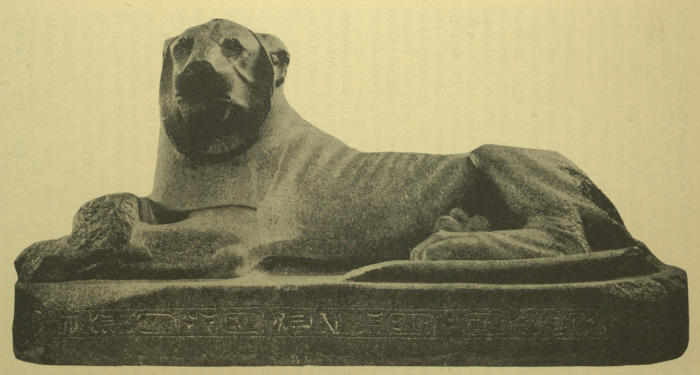
Plate XXXVI.
Granite lion dedicated to Ȧmen-ḥetep III by Tut-ānkh-Ȧmen, about B.C. 1400.
[Northern Egyptian Gallery, Bay 10, No. 431.]
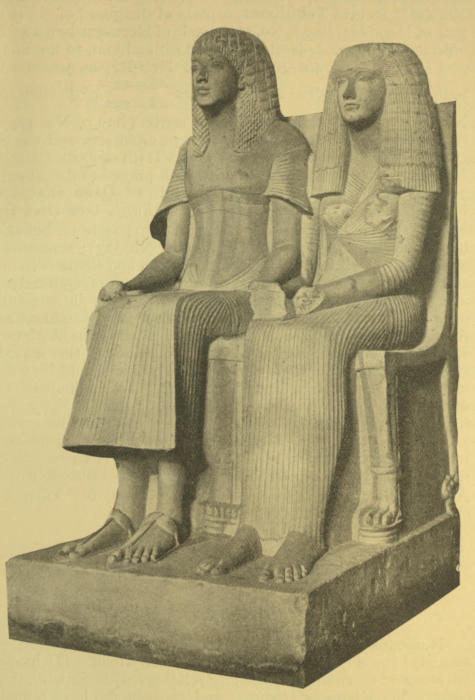
Plate XXXVII.
Seated statues of a priest, or high official, and his wife.
XVIIIth or XIXth dynasty.
[Southern Egyptian Gallery, Bay 18, No. 565.]
The statues, stelae, etc., of the XVIIIth dynasty are numerous, and many of them are of great interest as illustrating the perfection to which art attained under the patronage of wealthy kings and the priests of Ȧmen. Among them may be noted the following: Figure and stele of Nekht-Menu or Nekht-Ȧmsu, holding a stele (Bay 2, No. 443); figures of Ȧri-neferu and his wife Ȧpu (Bay 3, No. 444); stele of Ȧmen-em-ḥāt, inscribed with adorations to Osiris (Bay 5, No 447); granite figure of Kamesu, a scribe (Bay 7, No. 452); stele of Pasheṭ, guardian of the northern lake and northern pillars of Ȧmen[239] (Bay 8, No. 455); stele of Nefer-renpit, sculptured with a scene representing the ceremony of Opening the Mouth (Bay 8, No. 456); stele of Teḥutimes, captain of the guard of the city gate of Memphis (Bay 8, No. 460); stele of Ḥeru-em-ḥeb a high official, and two door-jambs inscribed with a hymn to the Sun-god (Bay 8, Nos. 461-463); stele of Neb-Rā, on which are sculptured four eyes and two ears 𓁻𓁻𓁻𓁻𓄔𓄔 (Bay 9, No. 467); stele of Ban-āa, a royal scribe (Bay 9, No. 474); stele of Ḥeru and Sutui, twin brothers, architects and clerks of the works at Thebes early in the XVIIIth dynasty (Bay 9, No. 475); stele of Pasheṭ inscribed with praises of the Syrian god Reshpu (Bay 10, No. 478); stele of Qaḥa (Bay 10, No. 483); stele of Māḥu, captain of the king’s bow (Bay 10, No. 487); stele of Anna (Bay 11, No. 503); stele of Sebek-ḥetep, scribe of the wine-cellar (Bay 12, No. 513); sepulchral monument of Thuthu, with pyramidal top and libation basin attached (Bay 13, No. 549); granite figure of Qen-nefer, a high court official (Central Saloon, No. 556); three small inscribed pyramids (Bay 18, Nos. 558-560); painted shrine of Ani, a gardener (Bay 18, No. 561), etc. To the period of the XVIIIth dynasty may probably be attributed the seated statues of a priest, or high administrative official, and his wife in Bay 18, No. 565 (see Plate XXXVII). This monument is undoubtedly one of the most beautiful examples of Egyptian sculpture in the British Museum. Here, too, must be noted a very rare object, viz., a complete wooden door, from the tomb of Khensu-ḥetep at Thebes, on which is cut a scene representing the deceased making offerings to Osiris-Khenti-Ȧmenti, in the presence of Hathor, lady of Ȧmentet (Vestibule, North Wall, No. 566).
About B.C. 1370.
Rameses I, the first king of this dynasty, appears to have ascended the throne when he was an elderly man. He made an attempt to enter into friendly relations with Sapalul, the chief of the Kheta, or Hittites; and he seems to have raided the Sûdân. Monuments of his reign are few (see the scarabs inscribed with his name in Table-case D in the Fourth Egyptian Room).
The early years of the reign of Seti I, the son and successor of Rameses I, were spent in fighting. He attacked the Shasu, or nomad tribes of the Eastern Desert and of Palestine and Syria, and defeated them with great slaughter, and advanced to the city of Kadesh, on the Orontes, and conquered it. He returned to Egypt laden with spoil, including cedar wood from Lebanon for making a new barge for Ȧmen-Rā at Thebes. He made raids in the Sûdân, and forced the natives to assist him in reworking the old gold mines and opening up new ones. He reopened the copper mines in Sinai, and all the large quarries, for he needed much stone for his buildings. He began to build a great temple at Abydos, but did not live to finish it: the walls and pillars are ornamented with religious scenes and figures of the gods, and the sculptures and reliefs are among the most beautiful of Egypt. In one of the corridors is the famous King List, or Tablet of Abydos, which contains the names of 76 kings, the first name being that of Menȧ or Menes. At Karnak he added 79 columns to the Hall of Columns (see Plate XXX); at Ḳurnah (Thebes) he finished the temple begun by his father Rameses I; and he built a splendid tomb in the Valley of the Tombs of the Kings (see page 174). From this tomb came his magnificent alabaster sarcophagus which is now preserved in Sir John Soane’s Museum in Lincoln’s Inn Fields. Seti I built a temple at Dulgo, near the Third Cataract, probably in connexion with the gold trade carried on by the government; he opened up roads to the gold deposits in the Wâdî Ulâḳî, in the Eastern Desert; and he built a temple at Radassîyah on the old caravan road which ran from Edfû to the emerald mines of Gebel Zâbarâ, near Berenice, on the Red Sea; and dug wells at many places in the desert. His reign was comparatively short, 10 or 15 years at most, and he was succeeded by his second son Rameses II, whom he had made co-regent. Among the monuments of his reign are: Large wooden Ka-figure of Seti I, found in a chamber in his tomb (Central Saloon, No. 567); three painted slabs from the tomb of Seti I (Central Saloon, Nos. 568-570); and a grey granite clamp from a wall in Seti’s temple at Abydos, inscribed with his prenomen 𓍹𓇳𓏠𓁦𓍺, (Bay 18, No. 572). Among smaller objects may be noted the scarabs, glazed vase, and ushabtiu figures of the king exhibited in the Second and Fourth Egyptian Rooms (Wall-cases 78, 79, 150 and 152). A stele set up by him at Wâdî Ḥalfah in the first year of his reign is in Bay 13[241] (No. 574), and the stele of Rumā, a scribe and priest in his temple at Abydos, is in Bay 11 (No. 573). The beautifully illustrated Papyrus of Hunefer was written in this reign (No. 9901).
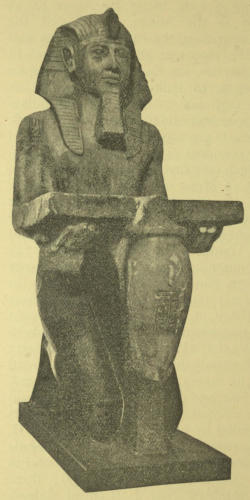
Kneeling statue of Rameses II holding a tablet for offering.
[Southern Egyptian Gallery, Bay 17, No. 584.]
Ramessu, or Rameses II, the Sesostris of the Greek writers, the son of Seti I, was associated with his father in the rule of the kingdom at an early age; he was probably between 20 and 30 years old when he became sole king of Egypt. He reigned 67 years, and died aged about 100 years. He married many wives, among them being some of his own near relatives, and was the father of about 111 sons and 51 daughters. During the first two or three years of his reign he made war on the tribes of the Sûdân, and his victories over them were commemorated by the rock-hewn temple at Bêt al-Walî, near Kalâbshah. Reproductions in plaster of the scenes of the paying of tribute to him are exhibited on the North and South walls of the Fourth Egyptian Room. In the fourth year of his reign Rameses was fighting in Syria, and so began the series of battles with the Kheta and their allies which lasted for fifteen or sixteen years. In the end neither side was victorious, and finally Rameses was obliged to make a treaty with the prince of the Kheta, in which it was agreed that Egypt was not to invade Kheta territory, and that the Kheta were not to invade[242] Egypt. The Kheta admitted the sovereignty of Rameses over all territory south of the Nahr al-Kalb, or Dog River, near Bêrût, in Syria, and the region north of it was to be Kheta territory for ever. The most important among the long series of battles was the Egyptian attack on Kadesh, on the Orontes; it was temporarily successful, but it cost Rameses dear. During the struggle, Rameses had charged among the enemy far ahead of his troops, who had either been killed or had run away. When the king realized his position, he found that he was surrounded by the foe, and was in the greatest danger of being slain. Undaunted, however, he girded on his armour, and in the strength of the gods Menthu and Bāl (Baal, 𓃀𓂝𓂋𓏤) he turned on his foes, and cut his way through them, slaying large numbers as he escaped from their midst. “I was,” said the king, “by myself, for my soldiers and my horsemen had forsaken me, and not one of them was bold enough to come to my aid.” This episode was treated in a highly poetical manner in a composition generally known as the Poem of Pentaurt. As a matter of fact Pentaurt was not the author, but merely the scribe who made the fullest copy of the work known, namely, that in the British Museum Papyrus, Sallier III. Thirteen years after the conclusion of the treaty with the Kheta, i.e., in the thirty-fourth year of his reign, Rameses II married the daughter of the prince of the Kheta, whose Egyptian name was Maā-Rā ur-neferu.
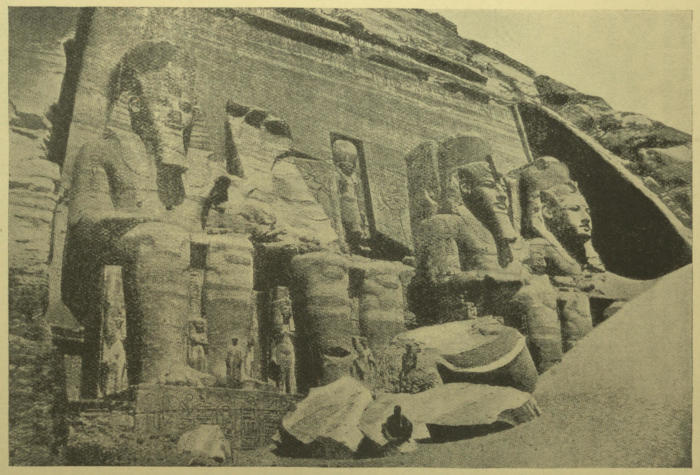
Plate XXXVIII.
Front of the rock-hewn temple built at Abû Simbel by Rameses II, B.C. 1330, to commemorate his victory over the Kheta.
Rameses was a great builder; his name is found everywhere on monuments and buildings in Egypt, and he frequently usurped the works of his predecessors and inscribed his own name on statues, etc., which he did not make. The smallest repair of a sanctuary was sufficient excuse for him to have his name inscribed on pillars, architraves, door-jambs, and every prominent part of the building. His greatest works were: 1. The rock-hewn temple of Abû-Simbel, dedicated to Ȧmen, Rā-Harmachis and Ptaḥ (see Plate XXXVIII); its length is 185 feet, its height 90 feet, and the four colossal statues of the king in front of it are each 60 feet high. In the large hall are eight square pillars, each 30 feet high, each with a colossal figure of Osiris, 17 feet high, standing against it. 2. The rock-hewn temple of Bêt al-Walî at Kalâbshah. 3. The Ramesseum at Thebes, called by Diodorus the “Tomb of Osymandyas,” and by Strabo the “Memnonium.” The granite statue of the king[243] which stood before the second pylon was 60 feet high, and weighed about 900 tons. He completed the Hall of Columns at Karnak; added to the temple of Ȧmen-ḥetep III at Luxor; and set up several statues of himself and two granite obelisks, each about 80 feet high. In the Delta he rebuilt Tanis, which became a city of the first importance, and he built the city of Pa-Temu, the Pithom of Exodus i, II, which is now called Tall al-Maskhûṭah; from the latter place came the statue of the “Recorder of Pithom” (Bay 21, No. 776). At Memphis, Abydos, and every important city of Egypt and Nubia, he carried on building operations; and he dug wells in Wâdî Ulâḳî, in the desert to the east of Dakkah, and worked the gold mines there. His reign was one of great material prosperity, and he lived long enough to carry out every work of importance which he planned. He was not a great soldier like Thothmes III, or a great administrator and diplomatist like Ȧmen-ḥetep III; and the glory and power, and the territory of Egypt were not so great as in the days of those kings. Few of the works carried out by Rameses can be compared with those of the great kings of the XVIIIth dynasty in beauty of design, finish, and solidity.
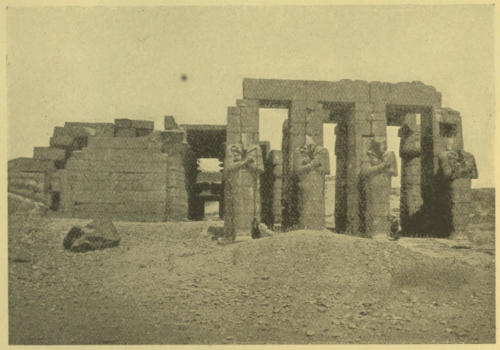
Façade of the Ramesseum in Western Thebes.
About B.C. 1330.

Statue of Rameses II, with the name of Mer-en-Ptaḥ I cut on the shoulders and breast.
[Central Saloon, No. 577.]
Upper part of a statue of Rameses II. Found on the Island of Elephantine.
[Central Saloon, Bay 14, No. 582.]
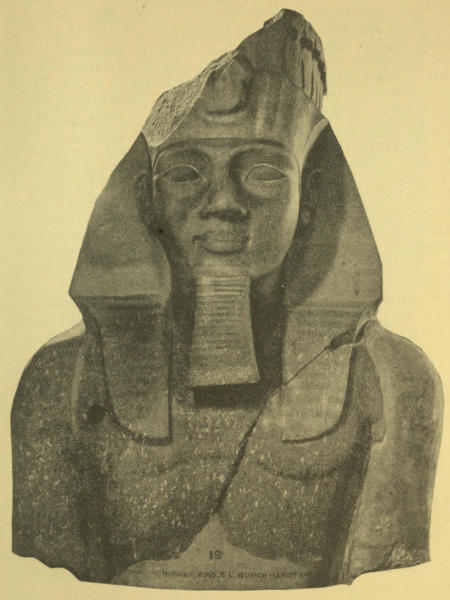
Plate XXXIX.
Upper portions of a colossal statue of Rameses II, B.C. 1330.
[Central Saloon, No. 576.]
The monuments of this reign are very numerous, and among them may be noted the following: Wooden Ka-figure of Rameses II, from his tomb at Thebes (Central Saloon, No. 575). Upper portion of a colossal granite statue of Rameses II, which was originally painted red, and was one of a pair that stood in the Ramesseum in Western[245] Thebes (see Plate XXXIX); weight about 7 tons 5 cwt. (Central Saloon, No. 576). Colossal statue of Rameses II, on the shoulders and breast of which are cut the prenomen and name of Seti Mer-en-Ptaḥ (Central Saloon, No. 577). Statue of Rameses II from Elephantine (Bay 14, No. 582). Kneeling statue of Rameses II, holding before him a tablet of offerings (Bay 17, No. 584). Portion of a statue of Rameses II; on one side of the plinth is sculptured a figure of a favourite wife called Batau-ānth: from Ṣarâbît al-Khâdim in the Peninsula of Sinai (Central Saloon, No. 587). With these should be compared the cast of the head of a colossal statue of the king which was set up before the temple of Ptaḥ at Memphis (Central Saloon, No. 588), and the cast of another colossal statue of the king at Abû-Simbel (Vestibule, No. 589). The width of the face of the latter is 8 feet 9 inches, and the length from brow to chin is 9 feet 8 inches. From the temple built by Rameses at Abydos comes the famous King List, or Second Tablet of Abydos, which, when complete, contained the prenomens of 52 of his predecessors on the throne of Egypt (Bay 6, No. 592); from Athribis (Benha) comes the granite lion (Bay 14, No. 593); from Abû-Simbel the interesting pair of hawk-headed sphinxes (Bay 15, Nos. 594, 595); from Pithom the granite hawk (Central Saloon, No. 596); and from Memphis the fist of a colossal statue (Bay 16, No. 597).
Of considerable interest, too, are the granite columns (Nos. 598, 599). The first is from the temple of Bubastis, and on it, in places, are seen the names of Osorkon II; its total height is 20 feet 8 inches and its weight about 11 tons 5 cwt. The second is monolithic and is from the temple of Ḥeru-shefit, the Arsaphes of the Greeks at Herakleopolis; in places the names of Menephthah I have been added. Its height is 17 feet 2 inches, and its weight about 6 tons 12 cwt. The altar of Rameses II is in Bay 16 (No. 600). In connexion with the colossal statues of this period may be noted the upper portions of two statues of Queens or goddesses, in the Central Saloon, Nos. 601, 602. They were found by Belzoni at Abû-Simbel, and most probably represent wives of Rameses II.
The art of the reign of Rameses II is illustrated by several small objects bearing his name, e.g., the scarabs (Table-case D, Fourth Egyptian Room); gilded vase for eye-paint (Wall-case 143, Fourth Egyptian Room); a scribe’s palette (Table-case C, Third Egyptian Room); a beautiful glazed bowl inscribed with the king’s names and titles (Wall-case 151,[246] Fourth Egyptian Room); model for a relief, with a figure of the goddess Qeṭesh (Table-case C, Third Egyptian Room); glazed boomerang (Wall-case 151, Fourth Egyptian Room); bronze figure of the king (Wall-case 191, same room), etc.
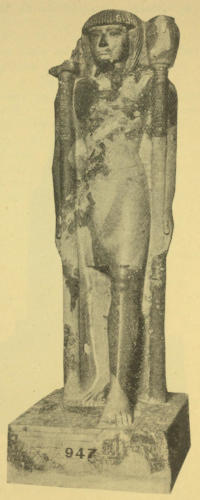
Statue of Khā-em-Uast, son of Rameses II.
[Southern Egyptian Gallery, Bay 18, No. 615.]
The statues and stelae of officials of Rameses II are numerous, and the inscriptions on them supply much information about the works and administration of the country. Thus we have: the statue of Paneḥsi, the scribe and director of the storehouse of gold from the Sûdân (Central Saloon, No. 603); the kneeling figure of Paser, a Governor of the Sûdân (Central Saloon, No. 604); the stele of Ȧmen-em-ȧnt, a scribe of the soldiers, who held several high offices (Bay 11, No. 607); the stele of Setau, another Governor of the Sûdân (Bay 17, No. 608); the stele of Ȧmen-ḥetep, a king’s messenger (Bay 19, No. 610); the stele of Ptaḥ-em-uȧa, keeper of the king’s stables (Bay 20, No. 611); and the stelae of Bakāa and Nefer-ḥrȧ, who died in the thirty-eighth and sixty-second years of the king’s reign respectively (Bay 19, No. 612; Bay 20, No. 613). The inscribed statue of Khā-em-Uast (Bay 18, No. 615), a son of Rameses II, is of great interest, both historically and linguistically. Khā-em-Uast was a Sem priest in the temple of Ptaḥ of Memphis, and a man of great learning, and he was held in high repute as a magician. He managed the affairs of the country for about twenty-five years before his death, which took place in the fifty-fifth year of the reign of his father.
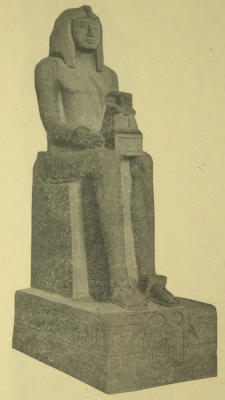
Statue of Seti II Mer-en-Ptaḥ II, king of Egypt, B.C. 1266, holding a shrine surmounted by a head of the ram of Ȧmen.
[Southern Egyptian Gallery, Bay 21, No. 616.]
Mer-en-Ptaḥ, or Menephthah, was associated with his father in the rule of the kingdom for about twelve years before he became sole king. In the fifth year of his reign Egypt was attacked by a confederation of tribes from Libya, and by certain peoples from the northern shores and islands of the Mediterranean. Menephthah fortified his towns and collected an army, and in the fierce battle which followed he was victorious. The Libyan king barely escaped with his life; but six of his brothers and sons and over 6,000 of his soldiers were slain, and 9,000 were taken prisoners. It is probable that the Exodus took place during the early years of this reign. In the year of his victory he caused a Hymn of Triumph to be cut upon the back of a stele of Ȧmen-ḥetep III at Thebes, and among the peoples of Palestine whom he conquered are mentioned the Israelites, 𓇌𓊃𓏭𓂋𓇋𓄿𓂋𓏤𓌙𓀀𓁐𓏪. His mummy was found in the tomb of Ȧmen-ḥetep II at Thebes, and is now in Cairo. Like his father he caused his names to be cut on monuments which he had not made, e.g., the lion of Ȧmenemḥāt III (No. 173), the pillar of Ȧmen-ḥetep III (No. 419), and a statue (No. 577) and pillar of his father (No. 599). Among the monuments of his reign may be mentioned the door-jamb from his temple[248] at Memphis (No. 1169). The remaining kings of the XIXth dynasty were:—
1. Seti II Mer-en-Ptaḥ. See his statue holding a shrine with a head of Ȧmen (Bay 21, No. 616), a slab from his tomb at Thebes (Central Saloon, No. 617), and a plaque and a scarab in the Third and Fourth Egyptian Rooms (Wall-case 124 and Table-case D). The D’Orbiney Papyrus in the British Museum containing the Tale of the Two Brothers was written during the reign of this king. 2. Ȧmen-mes, of whose reign nothing is known. 3. Sa-Ptaḥ, of whom many reliefs are found at various places in Egypt. On his death a period of anarchy followed, and nothing like order prevailed in the country until Set-nekht, a relative of Rameses II, obtained supreme power.
The smaller monuments of the XIXth dynasty in the British Museum are very interesting, and, though the work of the sculptor and engraver is not so good as that of the XVIIIth dynasty, it is important for illustrating the methods employed at a time when quantity was more valued than quality. The inscriptions too are valuable, for they afford much information on minor points of the Egyptian religion. Among the statues and stelae of this period may be noted: a finely sculptured relief from the tomb of Mes, a priest of the Ka (Bay 17, No. 635); the stele of Ȧmen-Rā-mes, a priest of the statue of King Mer-en-Ptaḥ (Bay 20, No. 636); the painted limestone statues of Māḥu and his wife Sebta, fine work (Central Saloon, No. 637); the granite figure of Rui, high-priest of Ȧmen (Central Saloon, No. 638); the stele of Ptaḥ-mes, the comptroller of the grain supply of Egypt (Central Saloon, No. 642); the stele of Pa-ser, the scribe and master mason of all Egypt (Central Saloon, No. 643); the seated figure of Pa-mer-ȧḥau, a commander-in-chief (Central Saloon, No. 644); the stele of the superintendent of all the priests and all the gold workers of the Sûdân, from Wâdî Ḥalfah (Central Saloon, No. 645); the stele of Qaḥa, a master craftsman, on which are sculptured figures of the Syrian deities Kent and Reshpu and Ānthȧt (Ȧnaitis), and the Egyptian god Menu, an important monument (Bay 10, No. 646; see Plate XL); the stele of the god Reshpu (Bay 17, No. 647); stele of Ḥeru, painted with a scene of the worship of Kent, or Qeṭesh, Reshpu and Menu (Bay 17, No. 650); the stele of Ṭāṭā-āa, an overseer of scribes (Bay 12, No. 652); the granite coffin of a high-priest of Memphis (Bay 17, No. 654).
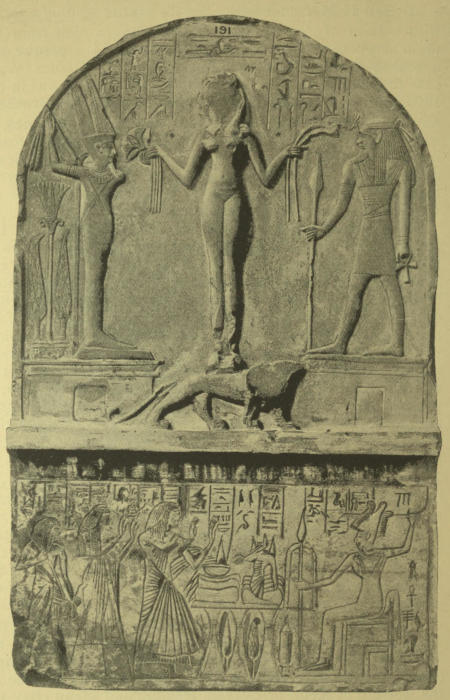
Plate XL.
Sepulchral stele of Qaḥa, sculptured with figures of the foreign deities Kent, Reshpu, and Ānthȧt, and the Egyptian god Menu.
XIXth dynasty.
[Northern Egyptian Gallery, Bay 10, No. 646.]
About B.C. 1200.
We learn from the great papyrus of Rameses III that after the downfall of the XIXth dynasty the land of Egypt fell into a state of anarchy, every man acting according to his own judgment, and no one holding supreme authority for many years. The country was in the hands of the nobles and the governors of the cities who fought against each other. This continued for some years, and then “years of want” succeeded, and a certain Syrian called Ȧrsu 𓇋𓀀𓁹𓂋𓇓𓏲𓌙𓀀, rose to power. Gathering his followers about him, he levied tribute and seized the goods of the people. As he paid no honour to the gods of Egypt and did nothing for their temples, they in due course set him aside and placed on the throne Set-nekht, who brought the country into order, and re-established the worship of the gods, and provided the temples with offerings. His reign was short, and he was succeeded by Rameses III, the chief event of whose reign of 31 years was the victory of the Egyptians over a confederation of peoples from Philistia, Cyprus, Crete, and the northern shores of the Mediterranean, who attacked Egypt by land and sea. Rameses III collected an army and a fleet, and in the battle which followed on the coast of Southern Palestine, his forces were victorious. Multitudes of the enemy were slain on land, and those who succeeded in reaching their ships could not escape, for the fleet of the Egyptians hemmed them in, and a great slaughter ensued. Rameses then marched through Syria, and having collected much spoil, returned to Egypt. Soon afterwards the Libyans attacked Egypt on the west, but they were quickly defeated and spoiled.
Rameses appears to have kept one fleet in the Mediterranean and one in the Red Sea, for trading purposes, and this “sea-power” was probably the source of the great material prosperity of Egypt under his reign. The peace and security of the country were such that he could boast: “I made it possible for an Egyptian woman to walk with a bold and free step whithersoever she pleased, and no man or woman among the people of the land would molest her.” Rameses built the so-called “Pavilion” and the great Temple of Madînat Habû at Thebes, and a small palace at Tell al-Yahûdîyyah (see the glazed tiles, etc., from it in the[250] Fourth Egyptian Room), and he richly endowed the temples of Heliopolis, Memphis, and Thebes, and gave them gifts of an almost incredible amount.[38] Lists of all his benefactions and a valuable summary of his reign are preserved in the great Papyrus of Rameses III, the longest Egyptian papyrus in the world (see page 74). Among the monuments and small objects bearing his name may be mentioned: The base of a pillar from a shrine of Rameses III (Bay 18, No. 716); a slab from one of his buildings at Ṣaḳḳârah (Central Saloon, No. 717); and the royal ushabtiu figures (Wall-case 85, Second Egyptian Room, Nos. 12, 13).
On the death of Rameses III the power of Egypt began rapidly to decline, and the succeeding kings of the dynasty, each of whom bore the name of Rameses, found their authority more and more usurped by the high-priests of Ȧmen, the great god of Thebes. Among the objects inscribed with the name of Rameses IV are scarabs (Table-case D, Fourth Egyptian Room), a fragment of an alabaster vase (Wall-case 137, same room), and the stele of Ḥeru-ȧ, a royal scribe (Bay 24, No. 719).
Under the rule of Rameses V-VIII the people of Thebes became poor, and the living were driven to plunder the tombs of kings and queens for the sake of the gold ornaments on the mummies and in the coffins. Under Rameses IX the government undertook a prosecution of the principal thieves, and appointed a commission to report upon the extent of the robberies of the royal tombs. Part of the statement of the examination of the tombs is preserved in the Abbott Papyrus in the British Museum (No. 10,221). During the course of the enquiry a number of the accused were beaten on the hands and feet, and confessed to breaking into the tombs of Sebek-em-sa-f and queen Nub-khā-s. In the reign of Rameses IX, the high-priest of Ȧmen, called Ȧmen-ḥetep, held great power, and induced the king to authorize him to levy taxes on the people for the maintenance of his temple and priesthood. Under Rameses X further prosecutions of the tomb robbers took place, but the government was powerless to stop the depredations. Rameses XI and Rameses XII were weaker than their predecessors, and allowed the high-priest of Ȧmen to rule the country. On the death of Rameses XII, the[251] high-priest, Ḥer-Ḥeru, seized the supreme power, and assumed all the titles and functions of the king of Egypt. But the priests of Ȧmen were as little able to maintain the power of Egypt as the kings Rameses, and they could not make their authority effective even in the Delta, or Northern Egypt. Thus it fell out that Egypt became once more divided into two kingdoms, viz., the Kingdom of the North, ruled from Tanis by Nessu-ba-neb-Ṭeṭ, whose name was Graecized by Manetho under the form of Smendes, and the Kingdom of the South, ruled from Thebes by Ḥer-Ḥeru, the first of the priest-kings of Egypt. For some years, however, Smendes must have been king of all Egypt, for when repairs of an urgent character were needed for the temples of Thebes, it was he who had the quarries opened, and collected the workmen, and directed the building operations which saved one of the temples from falling down.
The monuments of the XXth dynasty are characterized by coarseness of work and lack of finish, but the inscriptions on them are of considerable value linguistically. Among large objects may be mentioned the granite coffin of Setau, a governor of the Sûdân (Bay 19, No. 720); the libation basin (Bay 19, No. 722); the seated figures of Ȧmen-Rā and Mut (Bay 18, No. 728); the stele of Pai, comptroller of a chief queen (Bay 22, No. 752); and the shrine of Ȧmen-em-ḥeb, a scribe of the king’s bowmen (Bay 17, No. 754).
B.C. 1050 (?)
The reigns of all these kings are historically of little importance. As soon as Ḥer-Ḥeru had proclaimed himself king at Thebes, he assumed a series of titles indicating that he was the temporal as well as spiritual head of Egypt. One of the chief works carried out by the priest-kings was in connexion with the repair and removal of the royal mummies[252] from their tombs to places of safety. The mummies of Seti I and Rameses II were removed from tomb to tomb, but the pillaging continued, and we read that many of the royal mummies required to be repaired, re-swathed, and provided with new coffins. The rule of the priest-kings was not successful, and several serious riots seem to have occurred at Thebes through their neglect of the temporal affairs of the country. One of the most important objects of the reign of Ḥer-Ḥeru is the copy of the Book of the Dead which was written for his wife Queen Netchemet; an important portion of it was presented to the British Museum by His Majesty the King in 1903, and this is exhibited in the Southern Egyptian Gallery, No. 758 (see Plates I and XLI). The vignettes are very fine examples of the work of the period, and the texts contain interesting hymns to Rā and Osiris, and a valuable version of one of the most important sections of the Book of the Dead, viz., Chapter XVII. This papyrus was found at Thebes. A number of ushabtiu figures, inscribed with the names of Nesi-Khensu, Ḥent-taui, the Painetchems, Maāt-ka-Rā, and other members of the families of the priest-kings, will be found in Wall-cases 153, 154, in the Fourth Egyptian Room. The largest monument of this dynasty in the British Museum is a lintel from a temple of Sa-Ȧmen at Memphis (No. 1170). In the First Egyptian Room are exhibited several very fine mummies and coffins belonging to the period of this dynasty, and in the Second Room several typical examples of ushabtiu figures and boxes, which illustrate the funerary art of the period. The monuments of the Tanite kings are few and unimportant.
The history of the next two hundred and fifty years (B.C. 1050-800) is full of difficulty. When the rule of the priest-kings of Thebes came to an end the Kingdom of the South appears to have passed into the hands of a series of weak and incapable men, not one of whom succeeded in making himself “King of the South and North.” On the death of the last Tanite king of the XXIst dynasty (about B.C. 950), the Kingdom of the North was seized by Shashanq, a descendant of a Libyan chief, who established his seat of power at Bubastis. He and his descendants formed the XXIInd dynasty, which lasted till about B.C. 760. About this time the priests of Ȧmen departed from Thebes to Nubia, and soon afterwards the supreme power in the North was seized by local chiefs dwelling at Tanis (XXIIIrd dynasty), who made a league with all the feudal lords in the Delta, with the view of taking possession of the whole country.[253] When news of this reached Piānkhi, king of Nubia, he forthwith invaded Egypt and conquered it. After his return to Nubia, a Nubian dynasty was established at Thebes, and a local chief of Saïs became King of the North, about B.C. 733. He represents the XXIVth dynasty. The kings of the XXVth dynasty (about B.C. 700) were Nubians, and the kings of the XXVIth dynasty were descendants of the chiefs of Saïs who were conquered by the Nubian king Piānkhi, about B.C. 740.
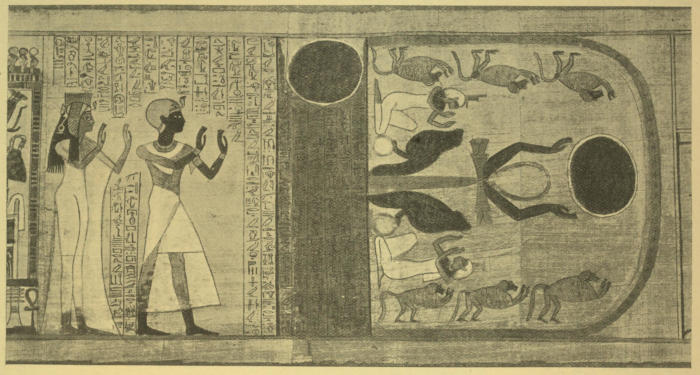
Plate XLI.
Vignettes from the Papyrus of Queen Netchemet.
Ḥer-Ḥeru and Netchemet praying. The rising sun on the horizon. The Ape-gods and Isis and Nephthys adoring the rising sun.
[Southern Egyptian Gallery, No. 758.]
Presented by His Majesty the King, 1903.
About B.C. 950.
The first king of this dynasty was Shashanq I, the Shishak of I Kings xiv, 25; 2 Chronicles xii, 5, 7, 9. He was of Libyan extraction, being descended from Buiu-uaua 𓃀𓅱𓇌𓅱𓍯𓄿𓊕𓏮𓀭 a Libyan prince, who flourished about B.C. 1150, and one of whose descendants married Meḥt-en-usekht, high-priestess of Ȧmen, and became the father of Nemareth, who in his turn became the father of Shashanq. A daughter of Nemareth owned the inlaid gold bracelets exhibited in Table-case J in the Fourth Egyptian Room (Nos. 134, 135). The principal event in the reign of Shashanq was the invasion of Palestine and capture of Jerusalem. He spoiled the Temple, and carried off much gold and silver, and took away the bucklers and shields of Solomon, and also the golden quivers which David had taken from the king of Zobah. He gave Jeroboam, king of Judah, one of his daughters to wife. On his return to Egypt he caused a record of this campaign to be cut upon the second pylon of the Temple of Karnak, and added a list of all the towns and villages which he had conquered in Palestine. Among them are the names of many places familiar from the Bible narrative, but the statement that “the king of Judah” is mentioned is incorrect. Shashanq repaired the Temple of Mut at Thebes, and set up in it a number of seated granite statues of the goddess Sekhet, two fine examples of which, inscribed with the king’s names and titles, are exhibited in the Southern Egyptian Gallery, Nos. 763, 764. A son of Shashanq named Ȧuputh was viceroy of the South, to whom is due the removal of the royal mummies from their tombs to the tomb of Ȧst-em-khebit[254] at Dêr al-Baḥarî, where, together with the coffins and funerary furniture, they were secreted, the pit being filled up with sand, stones, etc., and the entrance carefully walled up. This hiding place remained intact until 1872, when it was discovered accidentally by the Arabs. (For the inscribed base of a statue of Ȧuputh, see Bay 19, No. 765.)

Seated figure of Ānkh-renp-nefer, the “Good Recorder” of the town of Pithom, who flourished in the reign of Osorkon II, about B.C. 900.
[Southern Egyptian Gallery, Bay 21, No. 776.]
Another son of Shashanq I, named Uasarken, or Osorkon I, became king of Egypt, and married Tasheṭ-Khensu, and Maāt-ka-Rā, the daughter of Pasebkhānut II, the last of the Tanite kings of the XXIst dynasty. The son of Osorkon I and Maāt-ka-Rā was called Shashanq, and was made high priest of Ȧmen; he dedicated to the god the fine quartzite statue of Ḥāpi, the Nile-god, exhibited in the Southern Egyptian Gallery, Bay 22, No. 766. Osorkon I was succeeded by Thekeleth I, who was succeeded by Osorkon II, famous for the works which he carried out in the Temple of Bast, the great goddess of Bubastis, the Pibeseth of the Bible. From this site came many important monuments, among which may be mentioned: The massive granite Hathor-headed capital of a pillar (see Plate XLII; Bay 16, No. 768); and the slabs sculptured with figures of Osorkon II and Bast, and figures of Osorkon II and his Queen Karāmā (Bay 23, No. 769). Osorkon II perpetuated the names of the great kings his predecessors, and[255] accordingly we find on granite slabs from his temple the names of Khufu, Khāfrā, etc., and figures of Ȧmen-ḥetep II, Seti I, etc. (Bay 23, Nos. 771-773). Like Rameses II, Mer-en-Ptaḥ, and other kings, Osorkon II caused his name to be cut upon monuments of other kings, e.g., the statue of Usertsen III (Vestibule, No. 163) and the grey granite statue of Ȧmenemḥāt III (Bay 20, No. 775). In his reign flourished the good recorder of Pithom, whose statue (Bay 21, No. 776) was found at Pithom. The reigns of the other kings of this dynasty, Shashanq II, Thekeleth II, Shashanq III, Pamȧi, and Shashanq IV were unimportant.
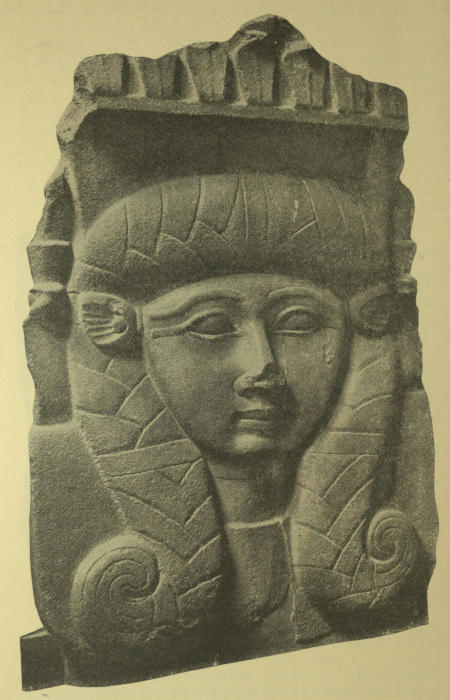
Plate XLII.
Hathor-headed capital from the temple of Osorkon II at Bubastis.
XXIInd dynasty, B.C. 866.
[Central Saloon, No. 768.]
B.C. 766.
The principal kings of this dynasty were Peṭā-Bast and Osorkon III, who reigned in the Delta.
It seems that a short time before the reign of Peṭā-Bast, the priests of Ȧmen had found it impossible to maintain their position at Thebes, and therefore, having hidden the mummies and coffins of the members of their order in a secret place, which was not discovered until 1892, they retreated to the South and settled at Napata, a city at the foot of the Fourth Cataract. (For examples of the coffins of the priests of Ȧmen of this period, see First Egyptian Room, Wall-cases 11-15.) A few years after their arrival, they appear to have persuaded Piānkhi, the king of the Northern Sûdân, to invade Egypt and to seize the kingdom of the South at least, to which, in view of the close relationship of the governing powers at Napata with those at Thebes, he might be assumed to have a just claim. For some time Piānkhi did nothing, but at length, in the twenty-first year of his reign, hearing that all the princes of the Northern Kingdom had united their forces, and were attempting to seize the country, he ordered his army to advance into Egypt. In a very short time great successes were reported. Thereupon he joined his troops, and his progress was victorious and rapid. City after city fell before his attack, and on the capture of Memphis, Egypt lay vanquished at his feet. The governors came in one after another, and at length Tafnekht, their leader, sent in his submission accompanied by gifts. Piānkhi filled his boats with spoil and returned to Napata, where he built a great temple to Ȧmen, and set up a stele recording his victories.[256] (For a cast of the stele see Central Saloon, No. 793.) After Piānkhi’s return to Nubia, Osorkon III, perhaps with Thekeleth III as co-regent, reigned at Thebes. To the latter half of this dynasty probably belongs the stele of Prince Ȧuuaruath, son of Osorkon and high-priest of Ȧmen (Bay 22, No. 777), and the monument mentioning a king with the Horus name of Ka-nekht-khā-em-Uast (Bay 21, No. 778).
The principal king of this dynasty was Bakenrenef, the Bocchoris of the Greeks, the son of Tafnekht of Saïs. His reign was short, but tradition assert that he was one of the six great law-givers of Egypt. About this time a Nubian called Kashta ruled at Thebes, and married Shep-en-Ȧpt, the high-priestess of Ȧmen; their son Shabaka became the first king of the XXVth dynasty. Among the monuments of this period may be mentioned: The altar, stand, and libation bowl, dedicated by Nes-Ȧmsu to Kashta, Shep-en-Ȧpt, and Ȧmenȧrṭās (Bay 20, No. 794); the base of a statue inscribed with the names of Shep-en-Ȧpt I, Shep-en-Ȧpt II, etc. (Bay 20, No. 795); and the alabaster vessel of Kashta and Ȧmenȧrṭās (Wall-case 139, Fourth Egyptian Room, No. 84).
B.C. 700.
Shabaka, or Sabaco, whom some identify with So of 2 Kings xvii, 4, was a contemporary of Sargon and Sennacherib, kings of Assyria. With one or other of these kings he must have had correspondence, for two seals bearing the name of Shabaka were found among the tablets of the Royal Library at Nineveh. (See Nineveh Gallery, Table-case I, No. 32, etc.) Among the objects bearing his name are several scarabs, and an alabaster vase in the Fourth Egyptian Room (Table-case D and Wall-case 139), and a basalt slab (Bay 25, No. 797) inscribed with a copy of a mythological text, copied by the king’s order from an old, half obliterated document. The portion of the text surviving contains legends of Rā, Osiris, Set, Horus, Ptaḥ and other gods; and it seems to[257] imply that all their powers were absorbed by Ptaḥ, in whose temple the slab was set up. Of Shabaka’s sister, the great Princess Ȧmenȧrṭās, may be mentioned the following objects: A fine inscribed statue (Wall-case 107, Third Egyptian Room), her lapis-lazuli scarab (Table-case D, Fourth Egyptian Room), and a steatite cylinder inscribed with her names and titles (Wall-case 193, same room). This princess possessed great power in Thebes, and she repaired portions of some of the great temples of that city, and built a small chapel near the temple of Ȧmen. She re-established the worship of the gods, and devoted a large proportion of her property to the restoration of their statues and the observance of their festivals.
Shabaka was succeeded by Shabataka (see a bronze shrine dedicated by him to Ȧmen-Rā in Wall-case 123 in the Fourth Egyptian Room), of whom little is known. He was followed by Taharqa, the Tirhâḳâh of the Bible, (2 Kings xix, 9), the son of a farmer and the lady Āqleq, who began to reign between B.C. 693 and 691. He was an ally of Hezekiah, king of Judah. About 676, Esarhaddon, king of Assyria, crushed the revolt in Palestine, and six years later he invaded Egypt, defeated Taharqa, captured Memphis, and appointed twenty governors over the various provinces of the country. After the death of Esarhaddon, in 668, Taharqa returned and proclaimed himself king of Egypt at Memphis; but Ashur-bani-pal, the new king of Assyria, marched against him and defeated his forces, which were assembled at Karbaniti, a city probably situated near the north-east frontier of Egypt. Taharqa fled, and Ashur-bani-pal marched into Egypt, crushed the enemy, and re-appointed the governors who had been appointed by his father.
Taharqa repaired several temples at Thebes, and built a large temple to Ȧmen at Napata, and a small one in honour of Usertsen III at Semnah. For a bronze figure of the king, and two plaques and scarabs bearing his name, see Table-case K, Wall-case 193, and Table-case D in the Third and Fourth Egyptian Rooms.
The successor of Taharqa was Tanuath Ȧmen, the Tandamanie of the cuneiform inscriptions, who had been co-regent with him. After the death of Taharqa, as the result of a dream Tanuath Ȧmen invaded Egypt, and captured Heliopolis; he tried to turn the Assyrians out of Memphis, but failed. Hearing that the king of Assyria was coming with a large army, he fled to Thebes, whither he was followed[258] by the Assyrians, who sacked the city. Tanuath-Ȧmen fled once more, and his subsequent history is unknown. A cast of the Stele of the Dream is exhibited in Bay 22, No. 799, and an account of the burning and pillage of Thebes is given on the great cylinder of Ashur-bani-pal (Table-case H, Babylonian Room), and the calamities which came upon the city are described by the prophet Nahum (iii, 10).
About B.C. 666.
Psemthek I, or Psammetichus, was the son of Nekau, governor of Saïs, and married Shep-en-Ȧpt, the daughter of Piānkhi and Ȧmenȧrṭās I. Thus, by marriage, he obtained a claim to the throne of Egypt. He appears to have fought against the Assyrians on every opportunity for many years, and at length by the help of Carian and Ionian mercenaries he succeeded in expelling them, and in making himself master of all Egypt. He established garrisons at Elephantine, Pelusium, Daphnae, and Marea. He protected the Greeks, a colony of whom he settled in the city of Naukratis. He encouraged trade of every kind, and embarked in many commercial enterprises. He rebuilt, or enlarged, the temple of the goddess Neith of Saïs (see bronze figures of her in Wall-case 125, Fourth Egyptian Room), and built a gallery in the Serapeum at Ṣaḳḳârah. Among the monuments of his reign are: An intercolumnar slab sculptured with a scene representing the king making an offering to the gods; from the temple of Temu at Rosetta (Bay 24, No. 800). A shaft of a column, and a portion of a statue, inscribed with his names and titles (Bay 24, Nos. 801, 802). For smaller objects inscribed with his name see the Foundation Deposits and the figure of Isis (Table-cases K and H, Third Egyptian Room), his ushabti figure (Wall-case 78, Second Egyptian Room), and his scarabs (Table-case D, Fourth Egyptian Room).
Nekau, or Necho, maintained an army of Greeks, and two fleets, one in the Mediterranean and one in the Red Sea. He recut and enlarged the old canal which in the time of Seti I joined the Nile and the Red Sea, and is said to have employed 120,000 men in the work. He led an army into Syria, and fought with Josiah, king of Judah, who attempted to bar his progress in the valley of Megiddo; Josiah was struck by an Egyptian arrow which penetrated his disguise, and he died (2 Kings xxiii, 29 ff.; 2 Chron. xxxv, 22).[259] Necho advanced towards the Euphrates, but was met at Karkemish by Nebuchadnezzar II and his army, and in the battle which followed he was defeated. Among the small objects inscribed with his name are: A bronze shrine (Table-case H, Third Egyptian Room), a porcelain vase (Wall-case 157, Fourth Egyptian Room), an alabastron (Wall-case 139, Fourth Egyptian Room), and a limestone draughtsman (Standard-case C, Fourth Egyptian Room).

Head of a colossal statue of Psammetichus II, about B.C. 596.
[Southern Egyptian Gallery, Bay 23, No. 803.]
The reign of Psammetichus II, the son of Necho, was short and unimportant; but he appears to have made a raid into Nubia. He repaired several of the large temples at Heliopolis, Memphis, Karnak, and Elephantine. Among the monuments of his reign is a head from a colossal statue of the king, found near the south end of the Suez Canal (Bay 23, No. 803). For small objects inscribed with his name see the scarabs in Table-case D, and a portion of a sistrum in Wall-case 157, Fourth Egyptian Room. Under Ḥāā-ȧb-Rā Uaḥ-ȧb-Rā, the Pharaoh Ḥophra of Jeremiah xliv, 30 and the Apries of the Greeks, Egypt enjoyed a period of great prosperity, directly due to the encouragement he gave to commerce, and to the business qualities of the Greeks who had settled in Naukratis and elsewhere in Egypt. He made an expedition into Syria. Zedekiah, king of Judah, counted upon his help to repulse Nebuchadnezzar II; but failing to do so, Ḥophra incurred the denunciations of the prophet Jeremiah: “And this shall be a sign to you, saith the Lord, that I will punish you in this place, that ye may know that my words shall surely stand against you for evil: Thus saith the Lord: Behold, I will give Pharaoh-hophra[260] king of Egypt into the hand of his enemies, and into the hand of them that seek his life; as I gave Zedekiah king of Judah into the hand of Nebuchadnezzar king of Babylon his enemy, and that sought his life” (Jeremiah xliv, 29-30). Pharaoh Ḥophra was dethroned by his own soldiers, who made their general Ȧāḥmes (Amāsis II) king in his stead. Among monuments bearing his name are a limestone stele, on which is sculptured the figure of the king (Bay 22, No. 804), and a portion of a statue of Pefā-Net, the king’s chief physician (Central Saloon, No. 805).
Amāsis II treated his former master with kindness, but, as Ḥophra persisted in raiding the country, further fighting ensued. In the end, Ḥophra was slain by his own soldiers on board his boat. During the reign of Amāsis II Nebuchadnezzar II attempted to invade Egypt, with what success is unknown. During this long reign of about 44 years the country in general enjoyed peace and prosperity, and the quarries were re-opened and many temples restored; remains of his building activity are visible on the sites of all the great sanctuaries of Egypt. He was a generous patron of the Greeks, and granted them lands and many privileges. Among the monuments of his reign are: Two granite tablets for offerings, or altars (Bay 16, No. 806; Bay 17, No. 807); a stele, dated in his eighth year, recording the dedication of a building to Neith, goddess of Saïs (Bay 24, No. 808); a weight inscribed with his prenomen (Wall-case 180, Fourth Egyptian Room), and handles of two sistra (Wall-case 187, same room).
Amāsis II married Thent-kheta, by whom he became the father of Psammetichus III. He was also the official husband of the famous high-priestess of Ȧmen, Ānkhnes-neferȧb-Rā, the daughter of Psammetichus II and the Lady Takhauath, and the adopted daughter of Nit-Ȧqert (Nitokris), high priestess of Ȧmen.[39] The magnificent sarcophagus in the Southern Egyptian Gallery was made for her (Bay 24, No. 811). It is undoubtedly one of the finest monuments of the XXVIth dynasty in the British Museum. (See[261] Plates XLIII, XLIV). The reliefs and figures are carefully executed, and the hieroglyphics are well cut. In the Ptolemaïc Period this sarcophagus was used for a royal scribe named Ȧmen-ḥetep, or Pi-Menth, his name being inserted in the cartouches and the feminine suffixes being changed to masculine. Ānkhnes-neferȧb-Rā built a chapel at Thebes, from which came slabs Nos. 812, 813 (Bay 24). Worthy of note also are two fine bronze figures of Harpokrates-Ȧmen and Menu, which were dedicated to Queen Ānkhnes-neferȧb-Rā by priests in her temple (see Table-case H, Third Egyptian Room). Amāsis II had a daughter, Ta-Khart-Ȧst (for a portion of a statue of her see Bay 24, No. 814).
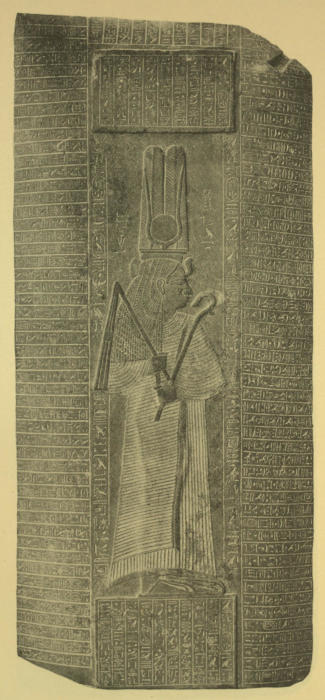
Plate XLIII.
Queen Ānkhnes-neferȧb-Rā, daughter of Psammetichus II and Queen Takhauath, wearing the head-dress of Isis-Hathor. From the cover of the sarcophagus of the queen.
About B.C. 600.
[Southern Egyptian Gallery, Bay 24, No. 811.]
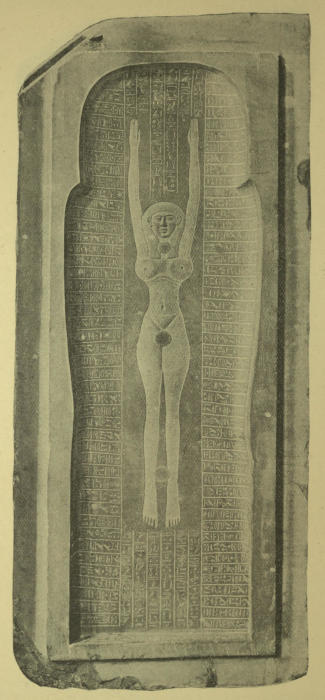
Plate XLIV.
The Sky-goddess Nut. From the inside of the sarcophagus of Queen Ānkhnes-neferȧb-Rā.
[Southern Egyptian Gallery, Bay 24, No. 811.]
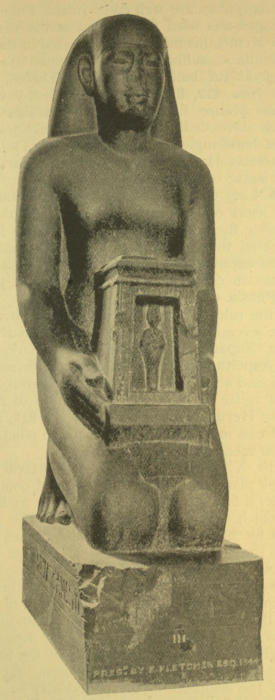
Plate XLV.
Kneeling statue of Uaḥ-ȧb-Rā, a prince, governor, and commander-in-chief, about B.C. 600.
XXVIth dynasty.
[Southern Egyptian Gallery, Bay 21, No. 818.]
The last king of this dynasty was Psammetichus III. During his short reign, which lasted six months only, the Persians under their king Cambyses invaded Egypt, and, having defeated the Egyptians at Pelusium, marched on to Memphis and captured it. After a short time Cambyses put Psammetichus to death, and Egypt became a province, or satrapy, of Persia.
During the rule of the XXVIth dynasty over Egypt, it appears that several native Nubian kings ruled the Northern Sûdân from Napata, the modern Gebel Barkal. Among these were Ȧspelta and Ḥeru-sa-ȧtef, the former of whom probably reigned about B.C. 625 and the latter about B.C. 580. For casts of stelae recording the Coronation of Ȧspelta and the Annals of Ḥeru-sa-ȧtef, see Bay 18, No. 815, and Bay 20, No. 816. A cast of a stele inscribed with an edict against the eaters of raw meat is in Bay 20, No. 817.
Under the XXVIth dynasty a great revival of art and learning took place, due partly to the settled condition of the country under a firm government, and partly to the material prosperity which obtained at that period. The painter and sculptor took for their models the reliefs and statues of the Early Empire, and the funerary masons and scribes cut or wrote on the stelae and tombs texts which were composed under the VIth dynasty, or earlier. The monuments of the period are more often made of dark limestone, dark green or grey schist, and basalt than granite, which was so commonly used for coffins, statues, stelae, etc., under the Middle Empire. These substances give to the large monuments of the Saïte Period a sad and sometimes heavy effect. Among the many fine examples of the sculpture of the period may be mentioned: The black basalt kneeling statue of Uaḥ-ȧb-Rā, a prince and general of the army (see Plate XLV; Bay 21, No. 818); the portion of the kneeling figure of Khnem-ȧb-Rā-Men, prefect[262] of Saïs, holding a shrine of Neith (Bay 23, No. 819); the portion of a figure of Ānkh-p-kharṭ, a priest who had ministered in the temple for eighty years (Bay 24, No. 820); and the libation bowl dedicated to the goddesses Mut and Hathor (Bay 22, Nos. 821, 822). The casts of the Cow of Hathor and the Hippopotamus of Smeṭsmeṭ are also very instructive (Bay 25, No. 823; Bay 26, No. 824). Of the massive stone sarcophagi and coffins, Nos. 825-829 are very fine important examples. On the two granite sarcophagi of Nes-Qeṭiu (No. 825) and Ḥāp-men (No. 826) are cut the figures of all the gods who were believed to protect the dead; but the others (Nos. 827-29) are plainer. The sepulchral stelae are very numerous; interesting examples will be found in Bays 21, 22, etc.
B.C. 527.
The rule of the Persians over Egypt lasted about one hundred and ten years. Cambyses, having established himself as king, set out on an expedition to the Sûdân. On his way thither he despatched an army of 50,000 men to the Oasis of Jupiter Ammon, now known as Sîwah, to secure the submission of the tribes; but, after reaching Khârgah, these troops were never more heard of. Cambyses continued his march into Nubia, where, it seems, he came in touch with a native army somewhere near the Third Cataract. According to the annals of Nȧstasen, king of Nubia, his boats were captured on the river, and all his soldiers slain after a fierce fight. Greek tradition states that Cambyses committed many sacrilegious acts in Egypt; but the inscription of Utcha-ḥer-resenet, the chancellor of Saïs, records that Cambyses cleared out the temple of Neith in that city, restored its revenues, and reinstated its priests. This done he went to the temple in person, and performed acts of worship, like the Pharaohs of old. The money which he gave the chancellor enabled him “to provide with a coffin the man who was too poor to buy one, and he took care of the children.”
Darius I, Hystaspes, was a wise and enlightened king, and he tried to understand the religion and customs of the Egyptians. He established a coinage, encouraged trade, subscribed money for expenses[263] incurred in the discovery of a new Apis Bull, supported religious institutions, and commissioned the chancellor Utcha-ḥer-resenet to found a school for the training of scribes. He was tolerant; and built a temple to Ȧmen-Rā in the Oasis of Al-Khârgah, on the walls of which is cut a remarkable hymn to Ȧmen. He also completed the canal between the Nile and the Red Sea, which Necho began, and so added greatly to the prosperity of the country. In the latter part of his reign the Egyptians, led by Khabbesha, revolted against the Persian rule with some success. Darius determined to set out from Persia to put down the rebellion, but died before he could do so. The triumph of Khabbesha was short-lived, for Xerxes the Great marched against him, defeated his forces, and reduced the country to servitude worse than before. Xerxes did nothing for the gods or people of Egypt, and left few traces of his reign in the country. An alabaster vase inscribed with his name in four languages, Egyptian, Persian, Median and Babylonian, which was found at Halicarnassus, is exhibited in the Gold Room in the British Museum. For fragments of other vases, on which his name appears in Egyptian letters, within a cartouche, and with the additions “Pharaoh, the Great,” as here given, see Wall-cases Nos. 28 and 29, in the Babylonian Room. A cast of a stele, dated in his fourth year, with a bilingual inscription in Egyptian and Aramean, is exhibited in the Semitic Room (Second Northern Gallery, Wall-case 29).
𓍹𓆼𓆷𓇌𓄿𓃭𓆷𓄿𓍺𓉐𓉻𓅮𓉻𓂝
In the reign of Artaxerxes I another revolt, headed by Inarôs, a Libyan, who was assisted by the Athenians, broke out, and at the battle of Papremis, the satrap of Egypt, Akhaemenes, was killed and his forces defeated. Subsequently the Persians defeated the Egyptians, and Inarôs was captured and taken to Persia, where a few years later he was impaled and flayed alive.
Darius II, Nothus, repaired the temple of Ȧmen-Rā at Al-Khârgah, and added his name to its walls. In his reign the Egyptians at length succeeded in throwing off the Persian yoke. Their leader, Amyrtaios, has been thought to be Ȧmen-ruṭ-meri-Ȧmen.
B.C. 420 (?).
According to the King List of Manetho the XXVIIIth dynasty consisted of one king, who was named Amyrtaios; Julius Africanus and the Syncellus state that he reigned six years, and make Saïs the seat of his rule. At one time authorities identified Amyrtaios with the king Ȧmen-ruṭ, whose name 𓊹𓄤𓍹𓇳𓄊𓌷𓏏𓇋𓏠𓈖𓍉𓈖𓍺𓎟𓇾𓇾𓍹𓇋𓏠𓈖𓌗𓇋𓏠𓈖𓌻𓍺 is found on a plank from a coffin preserved at Berlin. The form of the prenomen, however, proves that Ȧmen-ruṭ lived at a period anterior to Amyrtaios, and the identification must, therefore, be abandoned.
B.C. 399.
Of the five kings of this dynasty only three appear to have left remains, viz. Naifaauruṭ (Nepherites), Haḳer (Achoris), and Psamut; their reigns were unimportant, their total length being only about twenty-one years.
B.C. 378.
Nekht-Ḥeru-ḥebt, the Nektanebês and Nektanebus I of classical writers, succeeded in overthrowing the dynasty of Mendes, and made himself king of all Egypt, which he ruled with success for a period of eighteen years. He repaired several of the temples of Memphis and Thebes, and the temple of Darius I at Al-Khârgah, and revived the custom of setting up obelisks. He also founded the temple of Horus at Ḥebt, the modern Behbît-al-Ḥagârah. During his prosperous reign more attention was given to the performance of ceremonies connected with the[265] dead, and, as a result, a considerable number of statues, stelae, etc., which may be attributed to his reign have come down to us.

Plate XLVI.
Obelisk dedicated to Thoth by King Ḥeru-nekht-ḥebt, B.C. 378.
XXXth dynasty.
[Southern Egyptian Gallery, Bay 31, No. 919.]
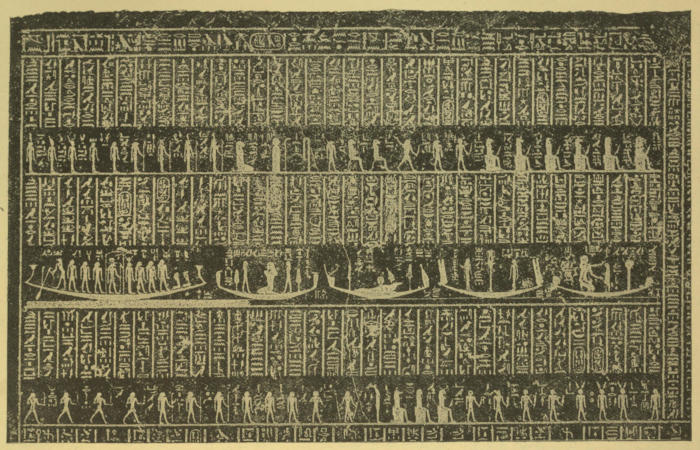
Plate XLVII.
Scenes and texts from the Second Section of the Book of What is in the Other World. From the sarcophagus of King Nekht-Ḥeru-ḥebt, B.C. 378.
[Southern Egyptian Gallery, Bay 25, No. 923.]
Among his monuments worthy of special note are: 1. A pair of obelisks, inscribed with his names and titles, and dedicated to “Thoth, the Twice Great,” before whose temple they were set up. They were taken from a town in the Delta during the eighteenth century, and stood for many years before one of the mosques of Cairo (see Plate XLVI). (Bays 31, 32, Nos. 919, 920.) 2. Portion of a statue of Ȧmen-Rā(?), dedicated to the god by this king. (Bay 30, No. 921.) 3. Sarcophagus of Nectanebus I. (See Plate XLVII.) This most valuable and interesting object is one of the most remarkable monuments of this king. The inside is decorated with figures of the gods, and on the outside are cut the texts and illustrations of a series of sections of the great funerary work entitled the Book of what is in the Ṭuat (i.e., the Other World). The Ṭuat was a long narrow valley which ran parallel with Egypt, and was neither above nor below this earth; a river flowed through its whole length. It was entered on the left bank of the Nile near Thebes, ran due north as far as Saïs, then curved to the east, and finally terminated where the sun rose. This valley was divided into ten sections, and at each end was a sort of ante-chamber or vestibule. Each section was filled with its own peculiar beings, many of whom were hostile to the dead who wished to pass through it in the Boat of the Sun-god, which traversed it nightly. The god himself could only do this by uttering words of power. The Book of what is in the Ṭuat was supposed to contain these words of power; and copies of it were written on papyri, or cut on sarcophagi, so that their possessors or occupants might be able to recite them in case of need. The representations of the gods which accompanied the texts enabled the dead to recognize the several beings of the Other World when they met them, and to recite the appropriate words of power. On the rounded head of the sarcophagus the First Section of the Ṭuat is sculptured, and on the foot the Ninth Section; on the right hand side are the Second and Sixth Sections, and on the left are the Third and Eighth Sections (Bay 25, No. 923). These Sections refer to the kingdoms of the dead of Thebes, Abydos, and Saïs; the other six Sections were probably sculptured on the cover, which was destroyed in the eighteenth century; those relating to Memphis and Heliopolis are omitted.
Nectanebus I was succeeded by his son Tcheḥrȧ (Teôs, or Tachos), in whose reign the Persians led by Artaxerxes II made an attack upon Egypt, but failed to conquer it.
Teôs was succeeded by his son Nekht-neb-f, or Nectanebus II, in whose reign the Persians, under Artaxerxes III, once again obtained possession of the country. The reign of Nectanebus II, who was the last native king of Egypt, was on the whole peaceful and prosperous; he repaired many temples, and his name is found on buildings in all the great sanctuaries from Philae to Sebennytus in the Delta. The statues and stelae of the period are well-cut, and the work is tasteful and delicate. Among them may be mentioned: A granite statue of Nectanebus II (Bay 29, No. 924); the two intercolumnar slabs on which are representations of the king kneeling and making an offering (Bay 27, No. 926; Bay 28, No. 927); and a small gilded door from the model of a shrine, on which the king is represented kneeling and making an offering (Table-case C, Fourth Egyptian Room).
The Persians, having succeeded in obtaining the supreme power once again, held it for a period of about eight years; but their rule was hateful to the Egyptians, and when Alexander the Great (born B.C. 356, died 324), who had defeated Darius III at the Battle of Issus, B.C. 332, arrived at Memphis, he was welcomed as the saviour of the country. He marched to the Oasis of Sîwah (Jupiter Ammon) and entered the temple of Ȧmen-Rā, and worshipped the god, who acknowledged him to be his son and therefore the rightful king of Egypt. Soon after, in B.C. 331, Alexander founded the city of Alexandria.
In the scramble for the provinces of Alexander’s great Empire which took place at his death, Egypt fell to the share of one of his generals, Ptolemy Lagus, who administered the country in the name of Alexander’s sons, Philip Arrhidaeus and Alexander II of Egypt, the former of whom never set foot in the country; the latter was brought thither as a child of six years, and was murdered when he was thirteen years old (B.C. 311); but in spite of these facts Ptolemy Lagus caused buildings to be erected in their names, and ruled the country as their loyal servant. To the period B.C. 332-306 belong the portion of a clepsydra inscribed with the name of Alexander the Great (Bay 29, No. 948); the portion of a clepsydra inscribed with the name of Philip Arrhidaeus (Bay 29, No. 949); and the papyrus of Nes-Ȧmsu, containing the Book of Overthrowing Āpep,[267] which is dated in the twelfth year of “Pharaoh Alexander, the son of Alexander,” i.e., Alexander II (No. 10,188). In the seventh year of his reign Alexander II restored to the temples of the city of Pe-Ṭep (Buto) the property which had been wrested from it by Xerxes the Great: a cast of the stele which commemorates this fact will be found in Bay 28, No. 950.
Under the capable rule of the earlier Ptolemies, Egypt became prosperous and powerful, and in the reign of Philadelphus she was the wealthiest country in the world. Though they and their court were Greeks and spoke Greek, the language of the priesthood and people was Egyptian, and the native religion of the country remained practically unchanged. As time went on, however, Greek became more and more the official language, and Egyptian was only used officially for religious purposes. The Ptolemies worshipped the Egyptian gods, offered up sacrifices to them, and rebuilt and endowed many of their temples, e.g., at Denderah, Edfû, Esna, Philae, Dakkah, etc. They adopted Egyptian names and titles, married their sisters and nieces, and in every way they adopted the habits of Egyptian Pharaohs; many were crowned with all the ancient rites and ceremonies at Memphis. They did not, however, permit the priests to interfere in the government of the country, which was administered on Greek lines, and though at times their power was skilfully disguised, it was nevertheless ubiquitous and effective. The revenues which they drew from Egypt were very large, and no other monarchs in the world at that time possessed such vast wealth as the Ptolemies. This was due to the encouragement which they gave to commercial enterprises of every kind, and to the freedom to trade which was enjoyed by the Jews, who had settled in large numbers not only in Alexandria, but also in the rich provinces of the Fayyûm, and in the Thebaïd, and in Syene.
Ptolemy I, Soter I, B.C. 304, founded the Alexandrian Library and Museum, settled a number of Jews in Alexandria, and introduced the worship of the god Hades, who was henceforth known in Egypt as Serapis, i.e., Ȧsȧr-Ḥāpi, or Osiris-Apis. (See Wall-cases 176-181, Fourth Egyptian Room.) For a relief and an inscription from his buildings at Terenouthis, see Bay 25, Nos. 951, 952.
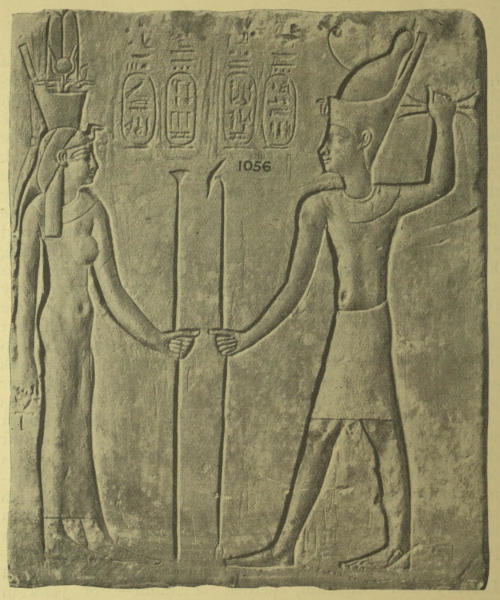
Plate XLVIII.
Relief with figures of Ptolemy II, Philadelphus, and Queen Arsinoë, about B.C. 260.
[Southern Egyptian Gallery, Bay 25, No. 953.]
Ptolemy II, Philadelphus, B.C. 287 or 286, founded the cities of Berenice Troglodytica, on the Red Sea, and Arsinoë[269] in the Fayyûm, and built the famous Pharos, or lighthouse, at Alexandria, one of the seven wonders of the world. In his reign the priest Manetho wrote a History of Egypt, of which only the King List is extant, and the famous Greek version of the Old Testament, known as the Septuagint, was compiled. He added largely to the Alexandrian Library, which is said at that time to have contained 400,000 works. For stelae, sculptured with reliefs in which Ptolemy II and Queen Arsinoë are represented making offerings to the gods, see Bay 25, Nos. 953-955 (see Plate XLVIII); a portion of a royal edict is in Bay 28, No. 956.
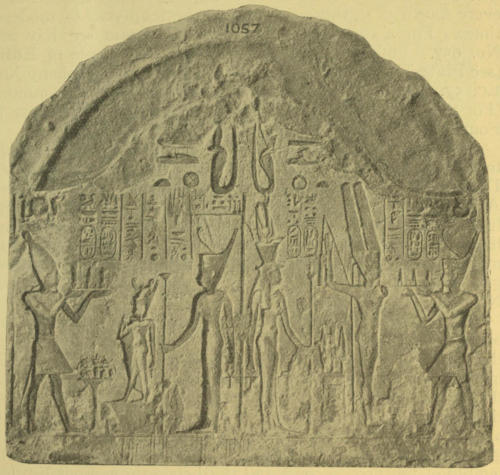
Stele sculptured with a scene representing Ptolemy II, Philadelphus, making offerings to Ȧmsu, or Menu, Uatchet, etc., about B.C. 260.
[Southern Egyptian Gallery, Bay 25, No. 954.]
Ptolemy III, Euergetes I, B.C. 246, conquered the greater portion of Western Asia. He was a patron of the arts and learning, and he repaired and rebuilt many of the ancient temples. To commemorate his victories and the benefits[270] which he conferred on Egypt, the priesthood assembled at Canopus in the ninth year of his reign, and passed a Decree conferring special honours on the king and his queen Berenice. It was ordered that the Decree be cut in the Greek and Egyptian languages on stelae to be set up in the most prominent places in temples of the first, second, and third class throughout Egypt, in order that all men might read of the king’s bounty. The Egyptian version was inscribed in two kinds of writing, viz., in hieroglyphics and in demotic. The Decree also ordered that one day be added to the calendar every fourth year, thus anticipating the leap-year of modern times. For a cast of the Decree of Canopus see Bay 28, No. 957. Ptolemy III began to build the temple of Edfû (see Plate XLIX), B.C. 237, which was finished by Ptolemy XI, B.C. 57. Objects inscribed with his name are not common. (For a gold ring which was made in his reign see Table-case J, Fourth Egyptian Room.)
Ptolemy IV, Philopator I, B.C. 222 or 221, added a hall to the temple which the Nubian king, Ergamenes, built at Dakkah, and dedicated a temple to Homer. He defeated Antiochus the Great at the Battle of Raphia, but did nothing further to break his power. He organized elephant hunts in the Sûdân, and transported the animals by sea to Egypt for military purposes; a Greek inscription set up by Alexandros, general of the elephant hunts of Ptolemy IV, is in Bay 26, No. 958.
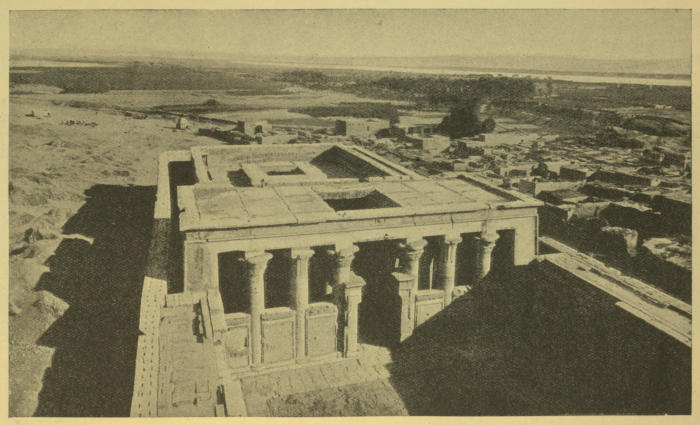
Plate XLIX.
View of the Temple of Edfû, taken from the top of the pylon. The temple was begun B.C. 237 and finished B.C. 57, and its construction occupied 180 years, 3 months, and 14 days.
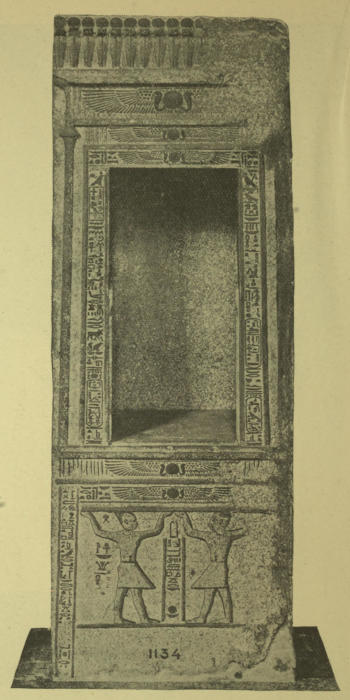
Plate L.
Granite monolithic shrine dedicated to the goddess Isis of Philae by Ptolemy IX (?), Euergetes II, B.C. 147-117.
[Southern Egyptian Gallery, Bay 30, No. 962.]
Ptolemy V, Epiphanes, B.C. 205, was a great benefactor of the temples of Egypt; and to mark their gratitude to him the priests of all Egypt met in solemn assembly at Memphis in the ninth year of his reign, and passed a Decree ordering that increased honours be paid to the king and his ancestors, that a statue of him be set up in each of the temples, and that a copy of the Decree, inscribed upon a stone stele, in hieroglyphic, demotic and Greek writing, be likewise set up in each temple of the first, second, and third class throughout Egypt. This Decree was duly carried out, for portions of three or four stelae, inscribed with the text of it, have been discovered. Most important of all is the stele which was found by M. Boussard in 1798, which, because it was dug up near Rosetta, is commonly known as the Rosetta Stone (see No. 960, Southern Egyptian Gallery). A special interest attaches to this monument, for from it Thomas Young, in 1816-1818, deduced the values of several letters of the Egyptian alphabet, and succeeded in reading the name of Ptolemy. Next with the help of this text and of an obelisk from Philae, the[271] Frenchman Champollion read the name Cleopatra, and formulated a correct system of Egyptian decipherment. (For details see page 41 ff.) During the reign of Ptolemy V, the Egyptians invoked the protection of Rome.
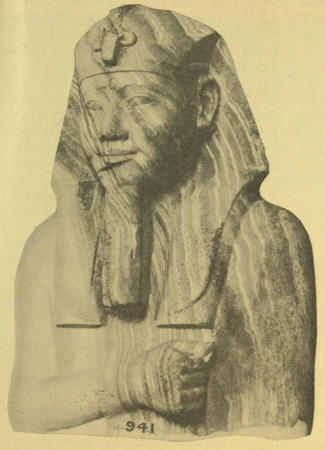
Head of a statue of one of the Ptolemies, about B.C. 300.
[Southern Egyptian Gallery, Bay 27, No. 947.]
Ptolemy VI, Eupator, died the year he became king. During the reign of Ptolemy VII, Philometor (B.C. 173), the Jews were permitted to build a temple at Onion, Onias being high-priest. (For a stele on which are sculptured figures of Ptolemy VII and the two Queens Cleopatra, see Bay 27, No. 961.) Ptolemy VIII was murdered. Ptolemy IX, Euergetes II, B.C. 147-117, finished the temple of Edfû, and repaired many temples both in Egypt and Nubia. From one of these came the fine monolithic granite shrine (see Plate L) in which a sacred bird or animal was kept (Bay 30,[272] No. 962). It was found lying on its side among the ruins of a Coptic church on the Island of Philae; it had been utilized by the builders of the church as the base of a Christian altar. Ptolemy X, B.C. 117, conferred great benefits on the temples of the First Cataract (see Bay 29, No. 963); Ptolemy XI and Ptolemy XII were killed in B.C. 87 and 81 respectively; Ptolemy XIII, B.C. 80-51, began to build the temples of Denderah and Esna; Ptolemy XIV, B.C. 51, and his sister Cleopatra were left by their father, Ptolemy XIII, under the guardianship of the Roman Senate, and Pompey was made their guardian. After the battle of Pharsalia, Pompey fled to Egypt, and was murdered at the instance of Ptolemy XIV, who had banished his wife Cleopatra. In B.C. 48, Julius Caesar landed in Egypt, defeated Ptolemy, who was drowned, and reinstated Cleopatra. Ptolemy XV was appointed co-regent; but he was murdered by Cleopatra’s orders in B.C. 45, and Ptolemy XVI, Caesarion, son of Julius Caesar and Cleopatra, was named co-regent in his stead. After the defeat of Antony by Octavianus and the death of Antony and Cleopatra, Egypt became a Roman Province, B.C. 30.
The Egyptian antiquities of the Ptolemaïc Period in the British Museum consist chiefly of Stelae inscribed with funerary texts; they are comparatively small in size, and are painted in bright colours. The reliefs, in which the figures of the gods are represented, are delicately cut, and the hieroglyphics have the slender form which is one of the chief characteristics of the inscriptions of the period. The texts often contain the ages of the deceased persons, and details concerning the length of time occupied in the process of mummification, which are wholly wanting in the funerary monuments of an earlier period. Among the gods mentioned on the stelae is Serapis, who represents a fusion of the old Egyptian gods, Osiris and Apis. (For figures of this god in terra-cotta see Table-case M in the Fourth Egyptian Room.) The stone coffins of the period are in the form of a mummy, and are usually carefully cut and finished. We have already seen that two important edicts of the priests of Memphis and Canopus were cut on stelae in two forms of Egyptian writing, viz., hieroglyphic and demotic, and in Greek; there are also several examples of funerary monuments in the British Museum in which the hieroglyphic text is followed by a rendering in demotic and Greek. In the case of small objects, e.g., mummy labels, the inscriptions are in demotic and Greek only.
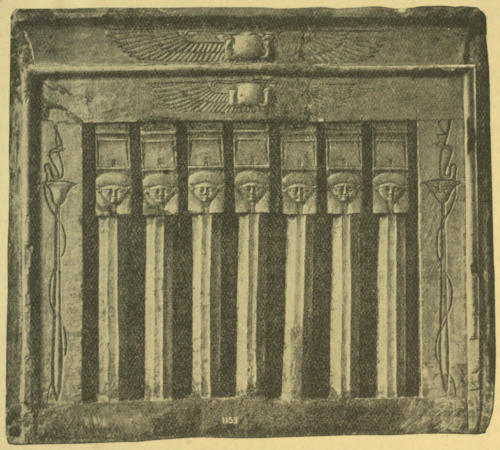
Limestone window with mullions in the form of pillars with Hathor-headed capitals. From the temple at Denderah.
Ptolemaïc Period.
[Southern Egyptian Gallery, Bay 25, No. 972.]
Among the noteworthy monuments of this period are: A statue of the goddess Isis, holding before her a figure of Osiris,[273] whom she protects with her wings, dedicated to the goddess by one Shashanq (Bay 28, No. 964); massive green granite beetle, symbol of Kheperȧ, the self-produced god, the creator of the universe, and the type of resurrection (Central Saloon, No. 965); stone serpent, with the bust of a woman (Bay 32, No. 966); green basalt coffin of the lady Ānkhet (Bay 29, No. 967) and the limestone coffin of Ḥes-Peṭān-Ȧst (Bay 26, No. 968); limestone window from the clerestory of the temple of Denderah (Bay 25, No. 972); and a marble sun-dial from Alexandria (Bay 29, No. 976). An interesting group of stelae, with demotic inscriptions, is exhibited in Bay 27 (Nos. 983-990); and in Bay 29 (No. 994) is the stele of Euonymos, with an inscription in Greek and demotic. Among the stelae which give the ages of deceased persons may be noted those of Ḥer-ȧbu, a priest of king Saḥu-Rā (?), who lived fifty years, seven months, and five days (Bay 30, No. 995); Tashermut,[274] a priestess who died aged ninety-seven years (Bay 27, No. 996); and Berenice (?) who died aged sixty-four years, eight months, and twenty-six days (Bay 29, No. 998).
Of all the stelae of this period the most interesting is that of the lady That-I-em-ḥetep, who belonged to a family that reckoned among its members several princes of Memphis and high priests of Ptaḥ (Bay 29, No. 1027). She was born in the ninth year of the reign of Ptolemy XIII, about B.C. 71, and when fourteen years old she was married to her half-brother, the priest P-shere-en-Ptaḥ (see his stele in Bay 27, No. 1026). During the first twelve years of her married life she gave birth to three daughters, but no son, which caused her husband great grief. She and her husband prayed to the god I-em-ḥetep, the son of Ptaḥ, for a son, and the god, appearing to P-shere-en-Ptaḥ in a dream, promised to grant his prayer if he carried out certain works in connexion with the temple. When the priest awoke he caused the works to be taken in hand, and soon after they were completed his wife gave birth to a son who was named I-em-ḥetep, and surnamed Peṭā-Bast (see his stele in Bay 27, No. 1030). Four years afterwards That-I-em-ḥetep died, and was buried with due ceremony by her husband, whom she addresses thus: “O my brother, my husband, my friend, the Ur-kherp-ḥem (i.e., high priest of Memphis), cease not to drink, to eat, to be drunken, and to marry wives, and to enjoy thyself, and to follow the desire of thy heart by day and by night; and let not sorrow or sadness find a place in thy heart during all the years which thou shalt live upon earth. Ȧmenti (i.e., the land of the dead) is the land of stupor and darkness, and a place of oppression for those who are therein. The august ones sleep in their mummied forms; they cannot awake to see their brethren, they cannot look upon their fathers and mothers, and they are unmindful of wives and children. The living water which the earth hath for its dwellers is stagnant water for me.... I no longer know where I am, now that I have arrived in this valley [of the dead]. Would that I had water to drink from a running stream, and one to say to me, ‘Remove not thy pitcher from the stream’! O that my face were turned towards the north wind on the river bank that the coolness thereof might quiet the anguish which is in my heart!
“He whose name is Universal Death calleth everyone to him; and they come unto him with quaking hearts, and they are terrified through their fear of him. With him is no distinction made between gods and men, and the great are even as the little in his sight. He showeth no favour to those[275] who long for him; for he carrieth away the babe from his mother, as well as the aged man. As he goeth about on his way, all men fear him, and, though all make supplication before him, he turneth not his face towards them. Entreaty reacheth not unto him, for he will not hearken unto him that maketh supplication, and him who presenteth unto him offerings and funerary, he will not regard.”
The ideas expressed in the above extract have their origin in the materialism which found its way into Egypt under the rule of the Ptolemies.
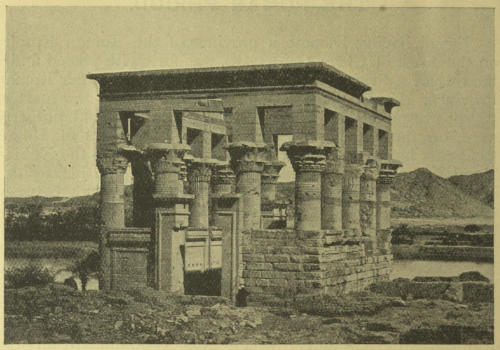
The building at Philae commonly known as “Pharaoh’s Bed.”
Roman Period.
Egypt, having become a province of the Roman Empire on the death of Cleopatra, B.C. 30, was forthwith placed under the rule of a Prefect, and administered like any other Roman Province. Under the strict but just rule of her new masters Egypt prospered, for trade flourished, and life and property were, on the whole, well protected by the laws of Rome. Reference has already been made (see page 255) to the Nubian kingdom founded by Piānkhi, who made Napata his capital; it must also be noted that at the same period, between B.C. 500 and the end of the Ptolemaïc rule, a second Nubian kingdom was founded by some unknown Sûdânî chief on the Island of Meroë, with a capital at Meroë, on the Nile, about 50 miles south of its junction with the Atbara. When the Romans began to rule over Egypt the Meroïtic Kingdom was in a flourishing state, and the authority of its sovereign, who appears to have been Queen Ȧmenṭārit[40] (having also the title Candace, which was common to all the Queens of Meroë), probably extended northwards as far as the First Cataract. In B.C. 29 Candace made a treaty with Cornelius Gallus, the first prefect of Egypt; but, five years later, when Ælius Gallus was prefect, she invaded Egyptian territory and slew the Roman garrisons of Philae and Syene. In revenge the Romans invaded Nubia and marched to[276] Napata, which they sacked and burned; and Candace was forced to submit. From that time onward little is heard of the Kingdom of Meroë; but the pyramids which still stand near Meroë prove that the Nubians observed the old Egyptian customs in connexion with the burial of their dead in chambers under the ground. They offered sacrifices to Osiris, Isis, Nephthys, Anubis, and other gods of the cycle of Osiris, and recited the ancient formulas, which are also written in hieroglyphics on the walls of the funerary chapels; and in some instances they reproduced on the walls whole scenes, e.g., the Weighing of the Heart, and the Pylons of the Other World, from Ptolemaïc copies of the Book of the Dead, as for example, on the sandstone relief from a pyramid chapel at Meroë which is exhibited in Bay 31, No. 1049. On the right Queen Candace is seated, her consort by her side, holding symbols of sovereignty, her feet resting on representatives of conquered tribes. Immediately in front of the large figure of the queen we see her pouring out libations to Osiris, and round about her are vases of wine, beer, unguents, bulls for sacrifice, etc., for the funerary feast. In her company are priests, officials, relatives, and others, who bear offerings, palm branches, etc. This relief was originally coloured red. Also may be mentioned[277] the two altars with Meroïtic Inscriptions exhibited in Bay 30, Nos. 1050, 1051. The Meroïtic character has not yet been deciphered.
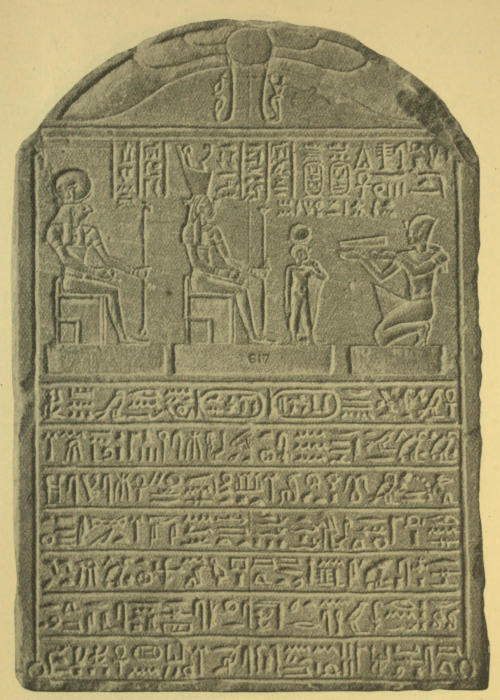
Plate LI.
Tablet recording the restoration of the temple of Mut by the Emperor Tiberius Caesar, about A.D. 20.
[Southern Egyptian Gallery, Bay 27, No. 1052.]
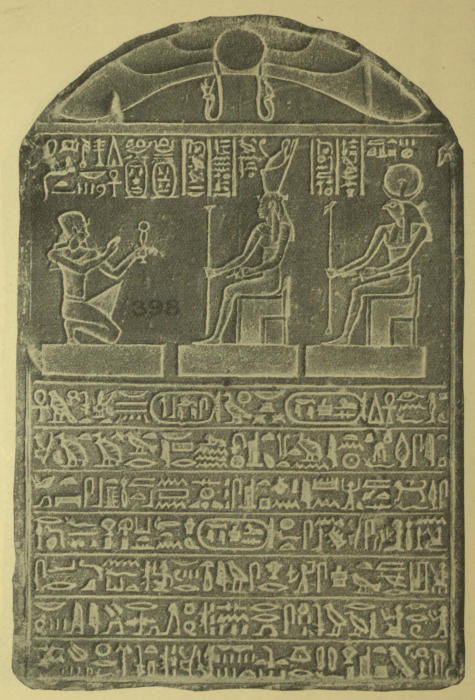
Plate LII.
Tablet recording the setting up of a statue to the goddess Mut, and the restoration of certain buildings by the Emperor Tiberius Caesar, about A.D. 20.
[Southern Egyptian Gallery, Bay 29, No. 1053.]
Nearly all the Roman emperors from Tiberius (A.D. 14) to Decius (A.D. 249) adopted Egyptian names and titles, and caused their names to be written within cartouches like those of the Pharaohs. The stele in Bay 27 (No. 1052) states that Tiberius rebuilt portions of the temple of Mut at Thebes (see Plate LI); and another stele (Bay 29, No. 1053) refers to the setting up by him of a statue of the goddess Mut, and the re-endowment of the portion of the temple wherein it stood (see Plate LII). In the reign of Nero (A.D. 54-69) two centurions sent into the Sûdân to report on the general condition of the country reached the marshes near Shâmbî, about 700 miles south of Kharṭûm. Tradition asserts that Christianity was preached in Alexandria towards the close of his reign, and that St. Mark arrived in that city, A.D. 69. To this period belongs stele No. 1057 (Bay 32), which was set up to mark the gratitude of the Egyptians to Nero for appointing F. Claudius Balbillus, prefect of Egypt. Hadrian visited Egypt twice, and founded the city of Antinoopolis in memory of his friend Antinous who was drowned in the Nile; when at Thebes he went with the Empress Sabina to view the Colossi (see Plate XXXIII). Marcus Aurelius (A.D. 161-180) was a just ruler and favoured Christianity in Egypt; in his reign the walls which surrounded the Sphinx at Gîzah were repaired (see stele, No. 1058, Bay 32). Septimius Severus (A.D. 196) issued an edict against the Christians in Egypt, and his successor, Caracalla (A.D. 211), encouraged the pagan Egyptians and favoured their religion. Decius (A.D. 249) made a systematic attempt to destroy the Christians, and every person was called upon to offer sacrifice to the gods, or suffer death. In the reign of Diocletian (A.D. 284), the Blemmyes, a confederation of tribes who lived in the Eastern Sûdân, became so powerful that they compelled the Roman garrisons to withdraw from the Dodekaschoinos,[41] and the emperor was obliged to hire the Nobadae, or tribes of the Western Desert, to keep them in check. He also agreed to pay the Blemmyes a fixed annual sum to refrain from raiding Roman territory in Egypt, and built a temple at Elephantine wherein representatives of all the peoples concerned might swear to observe the covenant in the presence of their respective gods. Diocletian in fact abandoned[278] the Sûdân. In 304 he issued a savage edict against the Christians in Egypt, and the persecution which followed it was marked with ferocious cruelty. Many thousands of Egyptians fled to the desert monasteries to avoid conscription, and embraced Christianity. From one of his buildings on the Island of Philae comes the stone bearing the names of Diocletian and Constantine (A.D. 324) (No. 1059, Bay 26).
In 378 Theodosius the Great proclaimed Christianity the religion of his Empire, and many temples in Lower Egypt were turned at once into churches; but the ancient Egyptian gods were worshipped as usual in Upper Egypt. Marcianus (A.D. 450-457) invaded Nubia and punished the Blemmyes and Nobadae for raiding Roman territory; they paid a huge fine, gave hostages for their future good behaviour, and made an agreement to keep the peace for one hundred years. In return they stipulated that they should be allowed to make pilgrimages annually to Philae, and to borrow the statue of Isis from time to time, so that they might take it about the country, and give the people the opportunity of invoking the protection and blessing of the goddess. In the first half of the sixth century the Nubians embraced Christianity, and Silko, king of the Nobadae, founded a kingdom having its capital at Dongola. During the reign of Justinian (A.D. 527-565) the hundred years’ truce came to an end, and the Blemmyes and Nobadae again began to give trouble. Justinian, believing that the cause of the revolt was the annual pilgrimage to Philae, sent his officer Narses thither, with strict orders to close the temples of Isis. Narses threw the priests of Isis into prison, confiscated the revenues of the goddess, and carried off the statues of the gods of Philae to Constantinople.
In the reign of Heraclius the Persians, under Chosroës, invaded Egypt (A.D. 619), which they held for ten years. Owing to the desertion from the Persians of the Arab tribes, who had now attached themselves to the victorious troops of Muḥammad the Prophet (born at Mekkah, Aug. 20, A.D. 570, died in June, 632), Heraclius was able to attack the Persians, in Syria, and defeating them became master of Egypt once more. In 640 ʿAmr Ibn al-Âṣî, the general of the Khalîfa Omar, conquered Egypt, and thus the country became a province of the newly-founded Arab Empire.
During the rule of the Romans, which lasted from B.C. 30 to A.D. 640, the Greek language entirely superseded Egyptian for official purposes, and it was also usually employed in the funerary inscriptions. Interesting examples are the stele of[279] Politta, inscribed with a metrical text (Bay 26, No. 1083), and the stele of Artemidorus (Bay 26, No. 1084). On the pillar altar (Bay 31, No. 1086) is a dedication in Greek to the god Serapis of the city of Canopus; and on the square sandstone slab (Bay 26, No. 1087) is a very interesting but difficult text recording the cleansing and restoration of some public building near the town of Kom Ombo in Upper Egypt, whilst Gabriel was Duke of the Thebaïd. Other interesting inscriptions in Greek are found in ostraka, or potsherds, many of which are dated in the reigns of Claudius, Nero, Vespasian, Trajan, Antoninus, Sabinus, Pertinax, etc., will be found exhibited in Table-case C in the Third Egyptian Room. During the early centuries of Roman rule the Egyptians continued to mummify their dead, and to bury them with the ancient rites and ceremonies. The use of the funerary stele or tablet continued down to the fourth century A.D.; but the gods represented on them appeared in different forms, and Greek or demotic took the place of hieroglyphics. In the region about Thebes and to the south of that city the cult of Osiris and Isis continued until about A.D. 560, and a simple system of mummification was practised in connexion with the worship of the dead.
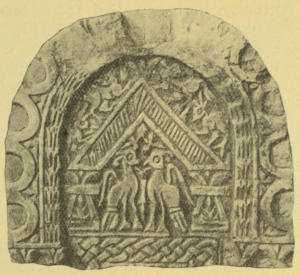
Sepulchral tablet sculptured with figures of doves, pillars, leaf patterns, etc.
[Southern Egyptian Gallery, Bay 30, No. 1156.]
The most important event during the rule of the Romans was the introduction of Christianity by St. Mark the Apostle, who, according to tradition, preached the Gospel[280] in Alexandria about A.D. 69. The knowledge of the new religion spread rapidly, and converts multiplied and, though no direct proof is forthcoming at present, there is reason to think that before the middle of the second century an account of the life of Christ and His words and works existed in the Egyptian tongue. Men who had embraced Christianity retired into the desert to lead a life of austerity and contemplation, among whom may be mentioned Frontonius, who collected seventy disciples, and withdrew to the Nitrian Desert between A.D. 138 and 161, and Paul the Anchorite, who died about A.D. 250, aged 113 years. The life and teaching of Anthony, born 250, died 355, induced thousands to become monks. Pachomius, in 320, systematized monasticism, but he required the recluses to work for their living whilst they cultivated spiritual excellences. Women as well as men flocked to the desert, and nunneries existed in many places in Egypt. The number of such recluses was great; at Nitria alone there were 5,000 monks, and, in addition, 600 lived solitary lives in the neighbouring desert. At Oxyrhynchus there were 10,000 monks, and the bishop had charge of 20,000 nuns. In the monasteries of Nitria and Panopolis, and elsewhere, the Holy Scriptures were translated from Greek into Egyptian (i.e., Coptic, see pages 35-39) and Syriac, and other Oriental languages; and copies of them were carried by monks and fugitive Christians into Nubia, and even into remote Abyssinia, by way of the Blue Nile. In the Oases of the Western Desert were numbers of Christians in the fourth and fifth centuries; wherever the monk went he took Christianity with him. Still, in spite of the spread of the new religion, the beliefs which the Egyptians had received from their pagan ancestors also flourished in Egypt for centuries after the preaching of St. Mark, and people of all classes clung to their amulets, and words of power, and magical ceremonies, even after they had embraced Christianity. For a very long time the Cross was regarded as an amulet possessing the greatest magical power possible, and the Name of Christ was held to be the greatest of all words of power.

Sepulchral tablet of Plêïnôs, a “reader.”
[Southern Egyptian Gallery, Bay 32, No. 1145.]
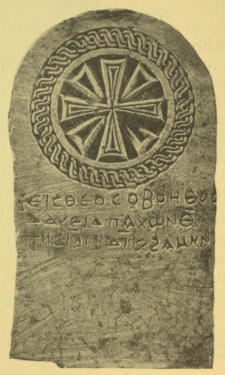
Sepulchral tablet of David, an Egyptian Christian.
[Southern Egyptian Gallery, Bay 30, No. 1160.]
The principal doctrine of the Egyptian Christians, or Copts, is that God the Father and Christ are of one and the Same nature; Arius held that God and Christ are only similar in nature, and was declared a heretic. The Copts are called Monophysites, because they believed, and still believe, that Christ is of one nature only, and Jacobites because their views as to the nature of Christ are identical[281] with those of one Jacob, a famous preacher of the Monophysite doctrine. The head of the Coptic Church is the Patriarch, who is chosen from among the monks of the Monastery of St. Anthony in the Red Sea Desert. The Copts attach great importance to Baptism, they face the East when praying, and they pray seven times a day. They make use of Confession, and keep five Fasts and seven Festivals. The Copts were persecuted severely in the reigns of Hadrian, Decius, Diocletian, and Julian the Apostate (A.D. 361), but the cruellest of the persecutions of the Roman emperors was that of Diocletian in 304. The Copts commemorated the sufferings of their community on this occasion by making the Era of the Martyrs, by which they date their documents, begin with the day of Diocletian’s accession to the throne, i.e., August 29th, A.D. 284. In the reign of Justinian the Copts split up into two great parties, i.e., the Melkites, or Royalists, which included all those who were in the service of the Government, and the Jacobites, or ordinary inhabitants of the country; henceforward each party chose its own Patriarch. The[282] dissensions between them materially aided the Conquest of Egypt by the Arabs.
Side by side with Christianity there also sprang up in
Egypt, under Roman rule, a number of sects to which the
title “Gnostic” has been given. They derived many of their
views and beliefs from the religion of the ancient Egyptians,
and they admitted into their system many of the old gods,
e.g., Khnemu, Ptaḥ, Rā, Ȧmen, Thoth, Osiris, etc. The
founders of Gnosticism, a word derived from the Greek
gnosis, “knowledge,” claimed to possess a superiority of
knowledge in respect of things divine and celestial, and
they regarded the knowledge of God as the truest perfection
of knowledge. The characteristic god of the Gnostics was
Abrasax, or Abraxas, and he represented the One who
embraced All within himself. They attributed magical
properties to stones, which, when cut into certain forms, and
inscribed with legends, or mystic names, words, and letters,
afforded, they thought, protection against moral and physical
evil. An unusually fine collection of Gnostic Gems and
Amulets is exhibited in Table-case N, in the Fourth
Egyptian Room: No. 1 speaks of the “Father of the World,
the God in Three Forms”; No. 18 shows us the lion-headed
serpent Knoumis and the mystic symbol ![[symbol not in Unicode]](images/symbol.jpg) ; No. 25
makes the Osiris-Christ to be Jah of the Hebrews, and
also Alpha and Omega; Nos. 36, 37, and 44 have figures of
Abraxas cut upon them; No. 87 mentions Solomon’s Seal,
No. 110, the six Archangels; and of peculiar interest are
No. 231, engraved with a representation of the Crucifixion,
and No 469, engraved with a representation of the Birth of
Christ.
; No. 25
makes the Osiris-Christ to be Jah of the Hebrews, and
also Alpha and Omega; Nos. 36, 37, and 44 have figures of
Abraxas cut upon them; No. 87 mentions Solomon’s Seal,
No. 110, the six Archangels; and of peculiar interest are
No. 231, engraved with a representation of the Crucifixion,
and No 469, engraved with a representation of the Birth of
Christ.
A.D. 640-1517.
As the Arabs were materially assisted in their conquest of Egypt by the Copts, the new masters of the country treated the latter with great consideration for about 100 years; but, from A.D. 750 onwards, they persecuted their Christian subjects at intervals with great severity. The non-Christian inhabitants of the country embraced Islâm, or the doctrine of Muḥammad the Prophet, and, with the religion of the Muslims, the knowledge of the Arabic language spread throughout Egypt. It gradually superseded Egyptian, or Coptic, and about the end of the twelfth century it became[283] the common language of the country, Coptic ceasing to be spoken except in monasteries and remote villages. In 642 the Arabs, under ʿAbd-Allah bin Sa’ad, occupied the Egyptian Sûdân, and ten years later they marched to Dongola, destroyed the church and the town, and levied an annual tribute, or Baḳṭ, consisting of 360 or 365 men upon the Nubians, which was paid with more or less regularity for nearly 500 years. On several occasions the Arabs invited the Christians of Nubia to embrace Islâm, but the latter steadily rejected the offer, paid their tribute, and continued to worship God according to the teachings of their Jacobite priests, who were appointed to their office by the Patriarch of Alexandria. Many hundreds of churches were built in the Sûdân between A.D. 540, when the Christian religion was established by Silko, king of the Nobadae, and 1450, when the Christian kingdom of Alwa, on the Blue Nile, was destroyed. During the greater part of these 900 years the Liturgy was recited in Greek, and the services were conducted after the manner laid down by the spiritual authorities in Alexandria. Certain Books of the Bible and various Offices were translated into Nûbî, the language of the country; but of these few remains are extant.
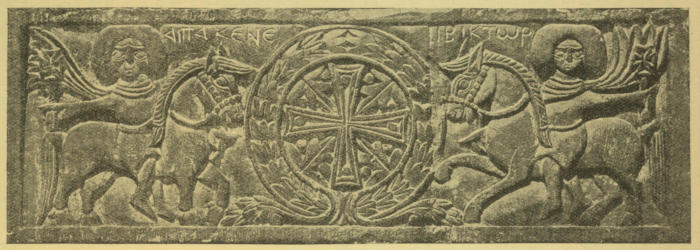
Plate LIII.
Sepulchral tablet set up in memory of Apa Paḥomo, the head of a monastic settlement. On the right is a figure of Saint Victor, and on the left a figure of Saint Apakene.
VIIth to Xth century, A.D.
[Southern Egyptian Gallery, Bay 30, No. 1103.]
In Egypt the Copts founded and maintained many monasteries, and built many churches; and from these come two remarkable series of monuments, inscribed in Greek and Coptic, which are exhibited in Bays 28, 30, and 32 of the Southern Egyptian Gallery. The greater number of them belong to the period between 600 and 1000 A.D., and among them may be noted:—The stele of Isos(?), inscribed in Greek with a prayer to the “God of Spirits” (Bay 26, No. 1094); the stele of Paḥomo (see Plate LIII), the father of a monastic settlement, with figures of the military saints Apakene and Victor (Bay 30, No. 1103); the apse from the shrine of a saint, on which are sculptured vine branches, with doves seated on them, and figures of flowers, shells, fish, etc.: a very interesting object (Bay 32, No. 1104); the stele of John the Deacon, inscribed with a lament on the bitterness of death (Bay 30, No. 1105); an altar slab from a church (Bay 32, No. 1106); three stelae, inscribed with invocations to saints (Bays 30, 32, Nos. 1107-1109); apse from a shrine of a saint from a church at Philae (Bay 30, No. 1113); and a group of stelae commemorating the holy women Hêlenê, daughter of Peter, deacon and steward of the Church of St. John, in Esna, in Upper Egypt (Bay 30, No. 1115), Sara, Rachel, Teucharis, Troïs, and Rebecca[284] (Bay 32, Nos. 1116-1120). Many of the sepulchral stelae are richly sculptured with pediments of shrines, pillars with elaborate carvings, figures of doves, and everywhere are prominent the cross, which is assumed to be identical with the ānkh 𓋹, the old Egyptian symbol of “life,” and the crown. On several of them also are seen Alpha and Omega, Α Ω. The most elaborately decorated stele is that which was set up for the child Mary in the old church at Ṣûhâḳ. The design is good, the cutting excellent, and it is one of the finest examples extant of this class of monument (Bay 32, No. 1123).[42] A very interesting group of Coptic documents, consisting of affidavits, letters, invoices, contracts, extracts from the Scriptures and from liturgies, hymns, etc., is exhibited[285] in Table-case M in the Fourth Egyptian Room. In division 4 of the same case is a good collection of Coptic crosses, pendants with figures of St. George, etc., from Panopolis. Several very fine examples of linenwork from Coptic graves and churches will be found in Table-cases E and J in the Third Egyptian Room, and a handsome bier cloth in Wall-cases 70 and 71, in the Second Egyptian Room.
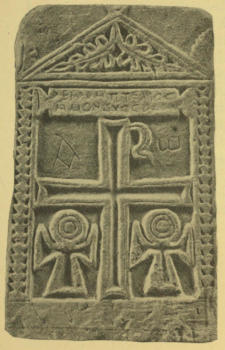
Sepulchral tablet of Abraam, the “perfect monk.”
[Southern Egyptian Gallery, Bay 30, No. 1136.]
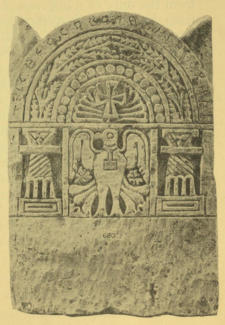
Sepulchral tablet of Rachel, a Christian lady.
[Southern Egyptian Gallery, Bay 32, No. 1117.]
Soon after the Arabs had conquered Egypt, they found it necessary to keep a strong garrison at Syene, the modern Aswân. In order to relieve the soldiers of the garrison from the duty of a pilgrimage to Mekkah, an order was issued from Fosṭâṭ, the first Arab capital in Egypt, near Old Cairo, that a pilgrimage to Aswân counted as a pilgrimage to Mekkah; hence for some two or three hundred years Aswân was regarded as a holy place, and pious Muslims were brought there from all parts to be buried. A collection of gravestones inscribed in Kûfî, or Kufic, a form of Arabic writing, from the old Muḥammadan cemetery at Aswân, is exhibited in the Second Northern Gallery (Wall-cases 52-54). The oldest example is that of Azhar, son of ʿAbd as-Salâm, who died in the year of the Hejira 252 = A.D. 866.
The Arab dynasties which ruled Egypt and the Sûdân between 656 and 1517 are as follows:—
| ʿOmayyad Khalîfas[43] | A.D. | 661-750. |
| ʿAbbâsid Khalîfas | ” | 750-868. |
| Tûlûnid Khalîfas | ” | 868-913. |
| Fâṭimid Khalîfas | ” | 913-1193. |
| Ayyûbid Khalîfas | ” | 1193-1249. |
| Baḥrite Mamlûks | ” | 1249-1382. |
| Circassian Mamlûks[44] | ” | 1382-1517. |
The Arab domination came to an end in 1517, when Selim, sultân of Turkey, conquered the country, and Egypt became a Turkish Province, or Pashalik.
B.C. 4400.
B.C. 4133.
B.C. 3966.
B.C. 3733.
B.C. 3566.
B.C. 3330.
B.C. 2600.
B.C. 2466.
| Ȧāḥmes I | ⎫ | B.C. 1600. |
| Ȧmen-ḥetep I | ⎭ | |
| Thothmes I | ⎫ | B.C. 1550. |
| Thothmes II | ⎪ | |
| Ḥātshepset | ⎪ | |
| Thothmes III | ⎭ | |
| Ȧmen-ḥetep II, | B.C. 1500. | |
| Thothmes IV | ⎫ | B.C. 1450. |
| Ȧmen-ḥetep III | ⎭ | |
| Ȧmen-ḥetep IV (or Khu-en-Ȧten) | ⎫ | B.C. 1400. |
| Tutānkh-Ȧmen | ⎪ | |
| Ȧi | ⎪ | |
| Ḥeruemḥeb | ⎭ |
| Rameses I | ⎫ | B.C. 1350. |
| Seti I | ⎭ | |
| Rameses II, | B.C. 1330. | |
| Meren-Ptaḥ. | ||
| Ȧmenmeses, | B.C. 1250. | |
| Sa-Ptaḥ. | ||
| Seti II. | ||
| Ȧrsu, the Syrian. |
B.C. 1100.
At Tanis.
At Thebes.
B.C. 966.
[Buiu-uaua, the founder.]
B.C. 750.
B.C. 733.
B.C. 700.
B.C. 666.
B.C. 527.
B.C. 399.
B.C. 378.
B.C. 340.
B.C. 305-30.
𓆥𓍹𓏠𓈖𓇋𓍺 Menȧ.
𓆥𓍹𓈉𓈉𓏏𓏭𓍺 Sem-ti.
𓆥𓍹𓌻𓂋𓊸𓏤𓊪𓈖𓍺 Mer-ba-pen. (Mer-p-ba.)
𓆥𓍹𓀘𓍺 Semsu, or 𓆥𓍹𓀜𓍺 Ḥu (or Nekht)?
𓆥𓍹𓈎𓃀𓎛𓍺 or 𓍹𓈎𓃀𓎛𓅱𓏁𓍺 Qebḥ.
𓆥𓍹𓊹𓅢𓍺 Neter-baiu, i.e., 𓍹𓃀𓈚𓍺 Besh, or 𓍹𓃀𓍑𓅱𓍺 Betchau.
𓆥𓍹𓂓𓂺𓂺𓂺𓍺 Ka-kau.
𓆥𓍹𓊸𓃝𓊹𓈖𓍺 Ba-en-neter.
𓆥𓍹𓉐𓂋𓄣𓋴𓈖𓍺 Per-ȧb-sen.
𓆥𓍹𓋴𓈖𓂧𓇋𓍺 Senṭȧ.
𓆥𓍹𓂋𓍺 Tcheser.
𓆥𓍹𓏏𓏏𓇋𓍺 Tetȧ (Ḥen-nekht.) or 𓆥𓍹𓂋𓏏𓏏𓇋𓍺 Tchesertetȧ.
𓆥𓍹𓇳𓄤𓂓𓍺 Nefer-ka-Rā, 𓅭𓇳 son of the Sun, 𓍹𓎛𓀜𓈖𓏭𓂡𓍺 Ḥuni.
𓆥𓍹𓋴𓄤𓆑𓂋𓅱𓍺 Seneferu.
𓆥𓍹𓐍𓅱𓆑𓅱𓍺 Khufu. (Cheops.)
𓆥𓍹𓇳𓊽𓆑𓍺 Ṭeṭ-f-Rā.
𓆥𓍹𓇳𓈍𓆑𓍺 Khā-f-Rā. (Chephren.)
𓆥𓍹𓇳𓏠𓂓𓂓𓂓𓍺 Men-kau-Rā. (Mycerinus.)
𓆥𓍹𓀼𓊃𓊃𓂓𓆑𓍺 Shepses-ka-f.
𓆥𓍹𓇳𓆋𓂓𓍺 Sebek-ka-Rā.
𓆥𓍹𓇍𓅓𓊵𓏏𓊪𓍺 I-em-ḥetep.
𓆥𓍹𓄊𓋴𓂓𓆑𓍺 Usr-ka-f.
𓆥𓍹𓇳𓃅𓅱𓍺 Saḥ-u-Rā.
𓆥𓍹𓇳𓀼𓋴𓋴𓂓𓍺 Shepses-ka-Rā.
𓆥𓍹𓇳𓈖𓄊𓋴𓂋𓍺 Usr-en-Rā, 𓅭𓇳 son of the Sun, 𓍹𓇋𓆛𓈖𓍺 Ȧn.
𓆥𓍹𓅃𓏠𓂓𓂓𓂓𓍺 Men-kau-Ḥeru.
𓆥𓍹𓇳𓊽𓂓𓍺 Ṭeṭ-ka-Rā, 𓅭𓇳 son of the Sun, 𓍹𓇋𓊃𓊃𓇋𓍺 Ȧssȧ.
𓆥𓍹𓃹𓈖𓇋𓋴𓍺 Unȧs.
𓆥𓍹𓏏𓏏𓇋𓍺 Tetȧ, or 𓍹𓏏𓏏𓇋𓌻𓈖𓊪𓏏𓎛𓍺 Tetȧ-mer-en-Ptaḥ. (Tetȧ beloved of Ptaḥ.)
𓆥𓍹𓇳𓌻𓇌𓍺 Meri-Rā, 𓅭𓇳 son of the Sun, 𓍹𓊪𓊪𓇌𓍺 Pepi (I.).
𓆥𓍹𓇳𓌻𓂋𓈖𓍺 Mer-en-Rā, 𓅭𓇳 son of the Sun, 𓍹𓅇𓅓𓎂𓆑𓍺 Tchefau-em-sa-f.
𓆥𓍹𓇳𓄤𓂓𓍺 Nefer-ka-Rā, 𓅭𓇳 son of the Sun, 𓍹𓊪𓊪𓇌𓍺 Pepi (II.).
𓆥𓍹𓇳𓌻𓈖𓅇𓅓𓎂𓆑𓍺 Rā-mer-en-Tchefau-em-sa-f.
𓆥𓍹𓇳𓄣𓌻𓇌𓍺 Rā-meri-ȧb, 𓅭𓇳 son of the Sun, 𓍹𓄡𓏏𓇌𓍺 Khati.
𓆥𓍹𓇳𓂓𓌻𓇌𓍺 Rā-ka-meri.
𓂋𓊪𓂝 Erpā 𓄂𓂝 Ḥā 𓏎𓈖𓏏𓆑𓇋 Ȧntef-Ȧ. The Erpā and Ḥā, Ȧntef-Ȧ.
𓆥𓍹[𓇳]𓎟𓐑𓏏𓍺 Neb-ḥapt-Rā, 𓅭𓇳 son of the Sun, 𓍹𓏠𓈖𓍿𓊵𓏏𓊪𓍺 Menth-ḥetep.
𓆥𓍹𓇳𓎟𓇾𓇾𓍺 Neb-taui-Rā, 𓅭𓇳 son of the Sun, 𓍹𓏠𓈖𓍿𓊵𓏏𓊪𓍺 Menth-ḥetep.
𓆥𓍹𓇳𓎟𓊤𓍺 Neb-ḥap-Rā, 𓅭𓇳 son of the Sun, 𓍹𓏠𓈖𓍿𓊵𓏏𓊪𓍺 Menth-ḥetep.
𓆥𓍹𓇳𓌻𓋹𓍺 Mer-ānkh-Rā, 𓅭𓇳 son of the Sun, 𓍹𓏠𓈖𓍿𓅱𓊵𓏏𓊪𓍺 Menthu-ḥetep.
𓆥𓍹𓇳𓋴𓋹𓂓𓍺 Se-ānkh-ka-Rā, 𓅭𓇳 son of the Sun, 𓍹𓏠𓈖𓍿𓅱𓊵𓏏𓊪𓍺 Menthu-ḥetep.
𓆥𓍹𓇳𓏣𓉔𓂋𓁷𓏤𓐙𓏛𓍺 Rā-seshesh-her-ḥer-maāt, 𓅭𓇳 son of the Sun, 𓍹𓏎𓉼𓈖𓏏𓆑𓍺 Ȧntef-āa (I.).
𓅭𓇳 𓍹𓏎𓈖𓏏𓆑𓉻𓍺 son of the Sun, Ȧntef-āa (II.).
𓆥𓍹𓇳𓏣𓄋𓊪𓏲𓀁𓌷𓏛𓆄𓍺 Rā-seshesh-ȧpu-maāt, 𓅭𓇳 son of the Sun, 𓍹𓏎𓈖𓏏𓆑𓉻𓏛𓍺 Ȧntef-āa (III.).
𓆥𓍹𓅭𓇳𓏎𓈖𓏏𓆑𓉼𓍺 son of the Sun, Ȧntef-āa (IV.).
𓆥𓍹𓇳𓋞𓆣𓍺 Nub-kheper-Rā, 𓅭𓇳 son of the Sun, 𓍹𓏎𓈖𓏏𓆑𓍺 Ȧntef.
𓆥𓍹𓇳𓋴𓊵𓏏𓊪𓄣𓍺 Seḥetep-ȧb-Rā, 𓅭𓇳 son of the Sun, 𓍹𓇋𓏠𓈖𓅓𓄂𓏏𓍺 Ȧmen-em-ḥāt (I.).
𓆥𓍹𓇳𓆣𓂓𓍺 Kheper-ka-Rā, 𓅭𓇳 son of the Sun, 𓍹𓄊𓋴𓂋𓏏𓊃𓈖𓍺 Usertsen (I.). (Sesonchosis.)
𓆥𓍹𓇳𓋞𓂓𓂓𓂓𓍺 Nub-kau-Rā, 𓅭𓇳 son of the Sun, 𓍹𓇋𓏠𓈖𓅓𓄂𓏏𓍺 Ȧmen-em-ḥāt (II.).
𓆥𓍹𓇳𓈍𓆣𓍺 Kheper-khā-Rā, 𓅭𓇳 son of the Sun, 𓍹𓄊𓋴𓂋𓏏𓊃𓈖𓍺 Usertsen (II.).
𓆥𓍹𓇳𓈍𓂓𓂓𓂓𓍺 Khā-kau-Rā, 𓅭𓇳 son of the Sun, 𓍹𓄊𓋴𓂋𓏏𓊃𓈖𓍺 Usertsen (III.).
𓆥𓍹𓇳𓈖𓌷𓂝𓏏𓍺 Maāt-en-Rā, 𓅭𓇳 son of the Sun, 𓍹𓇋𓏠𓈖𓅓𓄂𓏏𓍺 Ȧmen-em-ḥāt (III.).
𓆥𓍹𓇳𓌷𓂝𓊤𓅱𓍺 Maā-kheru-Rā, 𓅭𓇳 son of the Sun, 𓍹𓇋𓏠𓈖𓅓𓄂𓏏𓍺 Ȧmen-em-ḥāt (IV.).
𓆥𓍹𓇳𓄫𓄣𓍺 Rā-ȧu-ȧb, 𓅭𓇳 son of the Sun, 𓍹𓁷𓂋𓈐𓍺 Ḥer.
𓆥𓍹𓇳𓆋𓄤𓄤𓄤𓍺 Sebek-neferu-Rā.
𓆥𓍹𓇳𓐍𓂤𓇾𓇾𓍺 Khu-taui-Rā, 𓅭𓇳 son of the Sun, 𓍹𓅃𓎼𓄑𓄑𓍺 Ḥeru-nest(?)-taui(?).
𓎟𓇾𓇾𓍹𓄣𓏤𓇋𓂝𓈗𓍺 Ȧā-ȧb.
𓊹𓄤 Neter nefer Beautiful God, 𓍹𓇳𓉻𓂝𓄣𓇾𓇾𓍺 Āa-ȧb-taui-Rā, 𓅭𓇳 son of the Sun, 𓍹𓇋𓀁𓊪𓊪𓇋𓍺 Ȧpepȧ.
𓊹𓄤 Neter nefer 𓍹𓇳𓉻𓂝𓈎𓈖𓈖𓍺 Āa-qenen-Rā, 𓅭𓇳 son of the Sun, 𓍹𓇋𓀁𓊪𓊪𓇋𓍺 Ȧpepȧ.
𓆥𓍹𓃩𓉻𓄇𓄇𓍺 Āa-peḥ-ti-Set, 𓅭𓇳 son of the Sun, 𓍹𓋟𓏏𓏭𓃩𓍺 Nubti(?).
𓆥𓍹𓇳𓋴𓈖𓍺 Se-user-en-Rā, 𓅭𓇳 son of the Sun, 𓍹𓐍𓇌𓄿𓈖𓍺 Khian.
𓆥𓍹𓋴𓇳𓈎𓈖𓈖𓂡𓍺 Seqenen-Rā, 𓅭𓇳 son of the Sun, 𓍹𓏏𓆇𓏥𓉻𓏛𓍺 Tau-āa.
𓆥𓍹𓋴𓇳𓈎𓈖𓈖𓂡𓍺 Seqenen-Rā, 𓅭𓇳 son of the Sun, 𓍹𓏏𓆇𓏥𓉻𓏛𓉼𓏜𓍺 Tau-āa-āa.
𓆥𓍹𓇳𓊃𓈎𓈖𓈖𓍺 Seqenen-Rā, 𓅭𓇳 son of the Sun, 𓍹𓏏𓆇𓏥𓉻𓈎𓈖𓂡𓍺 Tau-āa-qen.
𓆥𓍹𓇳𓇅𓆣𓍺 Uatch-kheper-Rā, 𓅭𓇳 son of the Sun, 𓍹𓂓𓏤𓀭𓄠𓋴𓍺 Kames.
𓆥𓍹𓇳𓊃𓏄𓎟𓍺 Rā-sekhent-neb, 𓅭𓇳 son of the Sun, 𓍹𓇳𓊃𓈖𓆱𓐍𓏏𓂡𓈖𓍺 Rā-sekhent-en.
𓆥𓎟𓇾𓇾𓍹𓇳𓎟𓄇𓄇𓍺 Neb-peḥti-Rā, 𓅭𓇳 son of the Sun, 𓍹𓇺𓄠𓋴𓍺 Ȧāḥmes. (Amāsis I.)
𓆥𓍹𓇳𓂓𓍺 Tcheser-ka-Rā, 𓅭𓇳 son of the Sun, 𓍹𓇋𓏠𓈖𓊵𓏏𓊪𓍺 Ȧmen-ḥetep. (Amenophis I.)
𓆥𓍹𓇳𓉻𓆣𓂓𓍺 Āa-kheper-ka-Rā, 𓅭𓇳 son of the Sun, 𓍹𓅝𓏏𓏭𓄠𓋴𓍺 Teḥuti-mes. (Thothmes I.)
𓆥𓍹𓇳𓉻𓆣𓈖𓍺 Āa-kheper-en-Rā, 𓅭𓇳 son of the Sun, 𓍹𓅝𓏏𓏭𓄠𓊃𓄤𓈍𓏥𓍺 Nefer-khāu-Teḥuti-mes. (Thothmes II.)
𓆥𓍹𓇳𓁦𓂓𓍺 Maāt-ka-Rā, 𓅭𓇳 son of the Sun, 𓍹𓇋𓏠𓈖𓎸𓄂𓏏𓏏𓀼𓏪𓍺 Ḥāt-shepset-khnem-Ȧmen. (Queen Hatshepsu.)
𓆥𓍹𓇳𓏠𓆣𓍺 Men-kheper-Rā, 𓅭𓇳 son of the Sun, 𓍹𓅝𓏏𓏭𓄠𓋴𓍺 Teḥuti-mes. (Thothmes III.)
𓆥𓍹𓇳𓉻𓆣𓏪𓍺 Āa-kheperu-Rā, 𓅭𓇳 son of the Sun, 𓍹𓇋𓏠𓈖𓊵𓊹𓋾𓉺𓍺 Ȧmen-ḥetep neter ḥeq Ȧnnu. (Amenophis II.)
𓆥𓍹𓇳𓏠𓆣𓏪𓍺 Men-kheperu-Rā, 𓅭𓇳 son of the Sun, 𓍹𓅝𓏏𓏭𓄠𓋴𓈍𓈍𓏦𓍺 Teḥuti-mes-khā-khāu. (Thothmes IV.)
𓆥𓍹𓇳𓁧𓎟𓍺 Neb-maāt-Rā, 𓅭𓇳 son of the Sun, 𓍹𓇋𓏠𓈖𓊵𓋾𓋆𓍺 Ȧmen-ḥetep ḥeq Uast. (Amenophis III.)
𓇓𓈞𓏏 Suten ḥemt 𓍹𓍘𓇌𓏭𓁗𓍺 Thi. (A Mesopotamian Wife of Amenophis III.)
𓆥𓍹𓄤𓆣𓏪𓇳𓌡𓈖𓍺 Nefer-kheperu-Rā Uā-en-Rā, 𓅭𓇳 son of the Sun, 𓍹𓇋𓏠𓈖𓊵𓊹𓋾𓋆𓍺 Ȧmen-ḥetep neter ḥeq Uast. (Amenophis IV.)
or 𓍹𓇋𓏏𓈖𓇳𓅜𓐍𓈖𓍺 Khu-en-Ȧten.
𓇓𓈞𓏏 Suten ḥemt Royal wife, 𓅨𓏏𓂋 urt great lady. 𓍹𓇋𓏏𓈖𓇳𓄤 𓄤𓄤𓄤 𓄤𓏏𓏭𓇍𓍘𓁗𓍺 Nefer neferu-ȧten Neferti-ith.
𓆥𓍹𓇳𓋹𓆣𓏪𓍺 Ānkh-kheperu-Rā, 𓅭𓇳 son of the Sun, 𓍹𓇳𓊃𓉻𓂓𓃒𓂡𓆣𓏪𓍺 Sāa-ka-nekht-kheperu-Rā.
𓆥𓍹𓇳𓆣𓏪𓎟𓍺 Neb-kheperu-Rā, 𓅭𓇳 son of the Sun, 𓍹𓇋𓏠𓈖𓏏𓏏𓅱𓋹𓋾𓉺𓇓𓍺 Tut-ānkh-Ȧmen ḥeq Ȧnnu Resu.
𓆥𓍹𓇳𓆣𓆣𓏪𓁧𓁹𓍺 Kheper-kheperu-maāt-ȧri-Rā, 𓅭𓇳 son of the Sun, 𓍹𓏐𓊹𓇋𓀁𓇌𓊹𓋾𓋆𓍺 Ȧtf-neter Ȧi neter ḥeq Uast.
𓆥𓍹𓇳𓆣𓏪𓇳𓍉𓈖𓍺 Tcheser-kheperu-Rā-setep-en-Rā, 𓅭𓇳 son of the Sun, 𓍹𓇋𓏠𓈖𓌹𓅃𓋔𓐝𓎱𓍺 Ȧmen-meri-en Ḥeru-em-ḥeb.
𓆥𓍹𓇳𓏠𓄇𓏏𓏏𓍺 Men-peḥtet-Rā, 𓅭𓇳 son of the Sun, 𓍹𓇳𓄠𓋴𓇓𓅱𓍺 Rā-messu. (Rameses I.)
𓆥𓍹𓇳𓁧𓏠𓍺 Men-maāt-Rā, 𓅭𓇳 son of the Sun, 𓍹𓊪𓏏𓎛𓌹𓇌𓈖𓍺 Ptaḥ-meri-en-Seti. (Seti I.)
𓆥𓍹𓇳𓄊𓁧𓇳𓍉𓈖𓍺 Usr-maāt-Rā setep-en-Rā, 𓅭𓇳 son of the Sun, 𓍹𓁩𓈘𓄠𓋴𓇓𓍺 Rā-messu-meri-Ȧmen. (Rameses II.)
or 𓆥𓍹𓄊𓆄𓇳𓏤𓍉𓏌𓇳𓏤𓍺 Usr-maāt-Rā setep-en-Rā, 𓅭𓇳 son of the Sun, 𓍹𓇋𓏠𓈖𓈘𓇳𓏤𓄠𓋴𓋴𓍺 Ȧmen mer-Rā-meses.
𓆥𓍹𓁩𓈘𓈖𓃝𓍺 Ba-Rā-meri-en-Ȧmen, 𓅭𓇳 son of the Sun, 𓍹𓁧𓈘𓈖𓊵𓁷𓏤𓍺 Ptaḥ-meri-en-ḥetep-ḥer-maāt. (Menephthah.)
𓆥𓍹𓄊𓆣𓏪𓇳𓈘𓇋𓏠𓈖𓍺 Usr-kheperu-Rā-meri-Ȧmen, 𓅭𓇳 son of the Sun, 𓍹𓇌𓈘𓈖𓊪𓏏𓎛𓍺 Seti-meri-en-Ptaḥ. (Seti II.)
𓆥𓍹𓇳𓏠𓈖𓏇𓇋𓇳𓍉𓈖𓍺 Men-mȧ-Rā setep-en-Rā, 𓅭𓇳 son of the Sun, 𓍹𓁩𓄠𓋴𓋴𓋾𓈎𓋆𓍺 Ȧmen-meses-ḥeq-Uast. (Ȧmen-meses.)
𓆥𓍹𓐍𓅜𓏜𓇳𓈖𓇳𓍉𓈖𓍺 Khu-en-Rā setep-en-Rā, 𓅭𓇳 son of the Sun, 𓍹𓌹𓈖𓆇𓏤𓍺 Ptaḥ-meri-en-Sa-Ptaḥ. (Menephthah II.)
𓆥𓍹𓄊𓈍𓏦𓇳𓇳𓍉𓈖𓇋𓏠𓈖𓈘𓍺 Usr-khāu-Rā setep-en-Rā-meri-Ȧmen, 𓅭𓇳 son of the Sun, 𓍹𓇳𓁩𓈘𓏏𓂡𓈘𓂋𓂋𓍺 Rā-meri Ȧmen-merer Set-nekht.
𓆥𓍹𓇳𓄊𓁧𓈘𓇋𓏠𓈖𓍺 Usr-maāt-Rā-meri-Ȧmen, 𓅭𓇳 son of the Sun, 𓍹𓁛𓄠𓊃𓊃𓋾𓈎𓉺𓍺 Rā-meses-ḥeq-Ȧnnu. (Rameses III.)
𓆥𓍹𓇳𓄊𓁧𓁩𓋔𓍉𓍺 Usr-maāt-Rā setep-en-Ȧmen, 𓅭𓇳 son of the Sun, 𓍹𓇳𓁩𓈘𓄠𓋾𓆄𓊃𓊃𓍺 Rā-meses-meri-Ȧmen-Rā ḥeq maāt. (Rameses IV.)
𓆥𓍹𓇳𓄊𓁧𓋴𓆣𓈖𓍺 Usr-maāt-Rā s-kheper-en-Rā, 𓅭𓇳 son of the Sun, 𓍹𓇳𓁩𓁩𓈘𓇓𓄠𓋴𓆑𓍺 Rā-mes-meri Ȧmen-Ȧmen suten-f. (Rameses V.)
𓆥𓍹𓇳𓁩𓁧𓈘𓎟𓍺 Rā-Ȧmen-maāt-meri-neb, 𓅭𓇳 son of the Sun, 𓍹𓇳𓁩𓄠𓊃𓊃𓊹𓋾𓉺𓍺 Rā-Ȧmen-meses neter ḥeq Ȧnnu. (Rameses VI.)
𓆥𓍹𓇳𓄊𓁧𓈘𓇳𓍉𓈖𓍺 Rā-usr-maā-Ȧmen-meri-setep-en-Rā, 𓅭𓇳 son of the Sun, 𓍹𓇳𓁩𓄠𓊃𓊃𓏏𓇋𓊹𓋾𓉺𓍺 Rā-Ȧmen-meses-tȧ neter-ḥeq-Ȧnnu. (Rameses VII.)
𓆥𓍹𓇳𓁧𓄊𓁩𓅜𓐍𓈖𓍺 Rā-maāt-usr-khu-en-Ȧmen, 𓅭𓇳 son of the Sun, 𓍹𓇳𓁩𓈘𓄠𓋴𓋴𓍺 Rā-Ȧmen-meses-meri-Ȧmen. (Rameses VIII.)
𓎟𓇾𓈅𓏤 Neb ta Lord of the Land, 𓍹𓋴𓈍𓈖𓇳𓈘𓇋𓏠𓈖𓍺 S-khā-en-Rā meri-Ȧmen, 𓎟𓈍𓏦 neb khāu lord of crowns, 𓍹𓄠𓊃𓊃𓆇𓏤𓊪𓏏𓎛𓍺 Rā-meses-sa-Ptaḥ. (Rameses IX.)
𓆥𓍹𓇳𓄤𓂓𓏦𓇳𓍉𓈖𓍺 Nefer-kau-Rā setep-en-Rā, 𓅭𓇳 son of the Sun, 𓍹𓈍𓁛𓋆𓁩𓄠𓋴𓋴𓌻𓂋𓂋𓍺 Rā-meses-merer-Ȧmen-khā-Uast. (Rameses X.)
𓎟𓇾𓈅𓏤𓍹𓇳𓆣𓁧𓇳𓍉𓈖𓍺 Rā-kheper-maāt setep-en-Rā, 𓅭𓇳 son of the Sun, 𓍹𓁛𓁩𓇓𓄠𓋴𓍺 Rā-mes suten (?) Ȧmen. (Rameses XI.)
𓆥𓍹𓇳𓏠𓁧𓀮𓍉𓈖𓍺 Men-maāt-Rā setep-en-Rā, 𓅭𓇳 son of the Sun, 𓍹𓈍𓁛𓋆𓈘𓂋𓂋𓄠𓊹𓋾𓉺𓊃𓊃𓍺 Rā-meses-merer-Ȧmen Khā Uast neter ḥeq Ȧnnu. (Rameses XII.)
𓊹𓄤𓎟𓇾𓇾𓍹𓇳𓋑𓆣𓇳𓍉𓈖𓍺 Rā-ḥetch-kheper-setep-en-Rā, 𓅭𓇳 son of the Sun, 𓍹𓇋𓏠𓈖𓌻𓄓𓊃𓃝𓎟𓊽𓊽𓏏𓊖𓍺 Ȧmen-mer-Nes-ba-neb-Teṭṭeṭet. (Smendes.)
𓆥𓍹𓇳𓉻𓆣𓍉𓈖𓍺 Rā-āa-kheper setep-en-Mentu, 𓅭𓇳 son of the Sun, 𓍹𓇋𓏠𓈖𓌹𓅮𓇼𓈍𓈖𓊖𓍺 Ȧmen-meri Pa-seb-khā-nu. (Pasebkhānu I.)
𓆥𓍹𓊹𓍛𓁶𓊪𓇋𓈖𓏠𓈖𓍺 Neter-ḥen-ṭep-en-Ȧmen, Prophet first of Ȧmen, 𓅭𓇳 son of the Sun, 𓍹𓇋𓏠𓈖𓆇𓏤𓇯𓅃𓍺 Ḥer-Ḥeru-sa-Ȧmen. (Ḥer-Ḥeru.)
𓆥𓍹𓇳𓋑𓆣𓇳𓍉𓈖𓍺 Kheper-ḥetch-Rā setep-en-Rā 𓅭𓇳 son of the Sun, 𓍹𓇋𓏠𓈖𓈘𓆷𓆷𓈖𓈎𓍺 Ȧmen-meri-Shashanq. (Shishak I.)
𓆥𓍹𓇳𓌂𓆣𓇳𓍉𓈖𓍺 Sekhem-kheper-Rā setep-en-Rā 𓅭𓇳 son of the Sun, 𓍹𓇋𓏠𓈖𓈘𓍯𓐠𓇋𓂋𓎡𓈖𓍺 Ȧmen-meri Uasarken. (Osorkon I.)
𓆥𓍹𓇳𓄊𓆄𓇋𓏠𓈖𓍉𓈖𓍺 Rā-usr-Maāt-Ȧmen-setep-en, 𓅭𓇳 son of the Sun, 𓍹𓇋𓏠𓈖𓈘𓊨𓆇𓏤𓍘𓂋𓎡𓍿𓍺 Ȧmen-meri-sa-Ast. Thekeleth.
𓆥𓍹𓇳𓄊𓁧𓇋𓏠𓈖𓍉𓈖𓍺 Rā-usr-maāt setep-en-Ȧmen, 𓅭𓇳 son of the Sun, 𓍹𓇋𓏠𓈖𓈘𓆇𓏤𓎯𓍯𓐠𓂋𓎡𓈖𓍺 Ȧmen-meri sa-Bast Uasarken. (Osorkon II.)
𓆥𓍹𓇳𓏣𓆣𓇋𓏠𓈖𓍉𓈖𓍺 Seshesh-kheper-Rā setep-en-Ȧmen, 𓅭𓇳 son of the Sun, 𓍹𓇋𓏠𓈖𓇳𓈘𓆷𓆷𓍺 Ȧmen-Rā-meri Shash[anq]. (Shishak II.)
𓆥𓍹𓇳𓋑𓁩𓍉𓈖𓊹𓋾𓋆𓍺 Ḥetch-Rā-setep-en-Ȧmen, neter ḥeq Uast, 𓅭𓇳 son of the Sun, 𓍹𓇋𓏠𓈖𓈘𓊨𓏏𓆇𓍘𓎡𓂋𓍘𓈘𓍺 Ȧmen-meri Ȧset-meri Thekeleth. (Takeleth II.)
𓆥𓍹𓇳𓆄𓄊𓇳𓍉𓈖𓍺 Usr-maāt-Rā setep-en-Rā, 𓅭𓇳 son of the Sun, 𓍹𓇋𓏠𓈖𓌻𓆷𓆷𓈖𓈎𓋾𓊹𓉺𓍺 Ȧmen-meri-Shashanq ḥeq neter Ȧnnu. (Shishak III.)
𓆥𓍹𓇳𓄊𓆄𓍉𓈖𓇋𓏠𓈖𓍺 Usr-maāt-Rā setep-en-Ȧmen, 𓅭𓇳 son of the Sun, 𓍹𓇋𓏠𓈖𓌻𓅮𓏇𓇌𓍺 Ȧmen-meri Pa-mȧi. (Pa-mȧi.)
𓆥𓍹𓇳𓉻𓆣𓍺 Āa-kheper-Rā, 𓅭𓇳 son of the Sun, 𓍹𓆷𓆷𓈖𓈎𓍺 Shashanq. (Shishak IV.)
𓆥𓍹𓇳𓊃𓉔𓂋𓄣𓍺 Se-her-ȧb-Rā, 𓅭𓇳 son of the Sun, 𓍹𓎯𓏏𓆇𓊪𓂞𓆇𓏤𓍺 Peṭā-sa-bast.
𓆥𓍹𓉻𓆣𓁩𓍉𓈖𓍺 Āa-kheper-Rā setep-en-Ȧmen, 𓅭𓇳 son of the Sun, 𓍹𓇋𓏠𓈖𓈘𓍯𓐠𓂋𓎡𓈖𓇋𓍺 Rā-Ȧmen-meri Uasarkenȧ. (Osorkon IV.)
𓆥𓍹𓇳𓎝𓂓𓍺 Uaḥ-ka-Rā, 𓅭𓇳 son of the Sun, 𓍹𓅡𓎡𓈖𓂋𓈖𓆑𓍺 Bakenrenf.
𓇓𓏏𓈖 Suten King 𓍹𓂓𓈚𓇾𓍺 Kashta. Kashta.
𓆥𓍹𓇋𓏠𓈖𓈘𓊪𓋹𓇌𓍺 Ȧmen-meri p-ānkhi, 𓅭𓇳 son of the Sun, 𓍹𓊪𓋹𓇌𓍺 P-ānkhi.
𓆥𓍹𓇳𓏠𓆣𓍺 Men-kheper-Rā, 𓅭𓇳 son of the Sun, 𓍹𓊪𓋹𓇌𓍺 P-ānkhi.
𓆥𓍹𓇳𓄤𓂓𓍺 Nefer-ka-Rā, 𓅭𓇳 son of the Sun, 𓍹𓆷𓃝𓂓𓍺 Shabaka. (Sabaco.)
𓆥𓍹𓇳𓊽𓂓𓂓𓂓𓍺 Ṭeṭ-kau-Rā, 𓅭𓇳 son of the Sun, 𓍹𓆷𓃝𓇾𓂓𓍺 Shabataka.
𓆥𓍹𓇳𓄤𓏏𓍃𓐍𓅱𓍺 Rā-nefer-tem-khu, 𓅭𓇳 son of the Sun, 𓍹𓇾𓉔𓃭𓈎𓍺 Tahrq, or 𓍹𓇾𓉔𓄿𓃭𓈎𓄿𓍺 Taharqa. (Tirhâḳâh.)
𓆥𓎟𓇾𓇾𓍹𓇳𓃝𓂓𓍺 Rā-ba-ka, 𓅭𓇳 son of the Sun, 𓎟𓈍𓏦 lord of Crowns, 𓍹𓇋𓏠𓈖𓇾𓈖𓍯𓍘𓍺 Ȧmen-ta-nuath.
𓆥𓍹𓇳𓎝𓄣𓍺 Uaḥ-ȧb-Rā, 𓅭𓇳 son of the Sun, 𓍹𓊪𓋴𓅓𓍿𓎡𓍺 Psemthek. (Psammetichus I.)
𓆥𓍹𓇳𓄙𓅓𓄣𓍺 Uḥem-ȧb-Rā, 𓅭𓇳 son of the Sun, 𓍹𓈖𓂓𓅱𓍺 Nekau. (Necho II.)
𓆥𓍹𓇳𓄤𓄣𓍺 Nefer-ȧb-Rā, 𓅭𓇳 son of the Sun, 𓍹𓊪𓋴𓅓𓍿𓎡𓍺 Psemthek. (Psammetichus II.)
𓆥𓍹𓇳𓎛𓂝𓂝𓄣𓍺 Ḥāā-ȧb-Rā, 𓅭𓇳 son of the Sun, 𓍹𓇳𓎝𓄣𓍺 Uaḥ-ȧb-Rā. (Apries.)
𓆥𓍹𓇳𓎸𓄣𓍺 Khnem-ȧb-Rā, 𓅭𓇳 son of the Sun, 𓍹𓇺𓄠𓋋︀𓅭𓏤𓍺 Ȧāḥmes-sa-Net. (Amāsis II.)
𓆥𓍹𓇳𓋹𓂓𓈖𓍺 Ānkh-ka-en-Rā, 𓅭𓇳 son of the Sun, 𓍹𓊪𓋴𓅓𓍿𓎡𓍺 Psemthek. (Psammetichus III.)
𓆥𓍹𓇳𓄠𓋴𓅱𓍘𓍺 Mesuth-Rā, 𓅭𓇳 son of the Sun, 𓍹𓎡𓅓𓃀𓇋𓍿𓏏𓍺 Kembȧthet. (Cambyses.)
𓆥𓍹𓇳𓋴𓏏𓏏𓅱𓍺 Settu-Rā, 𓅭𓇳 son of the Sun, 𓍹𓏎𓇾𓃭𓇌𓅱𓆷𓍺 Ȧntariusha. (Darius Hystaspes.)
𓆥𓎟𓇾𓇾 Lord of two lands, 𓍹𓐍𓆷𓇌𓄿𓃭𓏤𓆷𓍺 Khshaiarsha. 𓅮𓉻𓂝 (Xerxes the Great.)
𓆥𓍹𓋴𓇒𓈖𓊪𓏏𓎛𓍉𓍺 Senen-en-Ptaḥ-Tanen-setep, 𓅭𓇳 son of the Sun, 𓍹𓆼𓃀𓃀𓆷𓍺 (Khabbesha.)
𓆥𓍹𓄿𓃭𓇾𓐍𓆷𓆷𓋴𓍺[45] Artakhshashas. (Artaxerxes.)
𓆥𓍹𓁚𓁩𓈘𓇌𓍺 Rā-meri-Ȧmen, 𓅭𓇳 son of the Sun, 𓍹𓏎𓍘𓃭𓇌𓌗𓆷𓍺 Ȧntheriruṭsha. (Darius Nothus.)
𓆥𓍹𓇳𓃝𓈖𓊹𓊹𓊹𓈘𓍺 Ba-en-Rā neteru-meri, 𓅭𓇳 son of the Sun, 𓍹𓈖𓏭𓄿𓆑𓉻𓏲𓏦𓌗𓍺 Naifaauruṭ.
𓆥𓍹𓎸𓁧𓇳𓍺 Khnem-maāt-Rā, 𓅭𓇳 son of the Sun, 𓍹𓉔𓄿𓎼𓃭𓍺 Haḳer.
𓆥𓍹𓇳𓄊𓋴𓊪𓏏𓎛𓍉𓈖𓍺 Rā-usr-setep-en-Ptaḥ, 𓅭𓇳 son of the Sun, 𓍹𓊪𓀔𓏏𓅐𓍺 Psamut.
𓆥𓍹𓁛𓁩𓋴𓇛𓄣𓏤𓍉𓈖𓍺 S-netchem-ȧb-Rā setep-en-Ȧmen, 𓅭𓇳 son of the Sun, 𓍹𓁩𓌻𓂡𓅃𓎳𓏏𓊖𓍺 Nekht-Ḥeru-ḥebt-meri-Ȧmen. (Nektanebês.)
𓆥𓍹𓇳𓁹𓌷𓏏𓂝𓈖𓍺 Rā-ȧri-en-Maāt, 𓅭𓇳 son of the Sun, 𓍹𓏎𓇯𓀭𓆓𓁷𓏤𓍉𓈖𓍺 Tche-ḥrȧ-setep-en-Ȧn-ḥer.
𓆥𓍹𓇳𓆣𓂓𓍺 Kheper-ka-Rā, 𓅭𓇳 son of the Sun, 𓍹𓈖𓆱𓐍𓏏𓂡𓃭𓆑𓍺 Nekht-neb-f. (Nektanebos.)
𓆥𓍹𓁬𓁛𓈖𓍉𓈘𓍺 Setep-en-Rā-meri-Ȧmen, 𓅭𓇳 son of the Sun, 𓍹𓄿𓃭𓎡𓊃𓇋𓈖𓂧𓂋𓊃𓍺 Aleksȧnṭres. (Alexander the Great.)
𓎟𓇿𓇿 Neb taui 𓍹𓁞𓁩𓍉𓈖𓈘𓍺 Setep-en-Rā-meri-Ȧmen, 𓅭𓇳 son of the Sun, 𓍹𓊪𓉔𓇌𓅱𓃭𓇌𓅱𓊪𓍯𓋴𓍺 Phiuliupuas. (Philip Arrhidaeus.)
𓆥𓍹𓇳𓀠𓄣𓍉𓈖𓇋𓏠𓈖𓍺 Rā-qa-ȧb-setep-en-Ȧmen, 𓅭𓇳 son of the Sun, 𓍹𓄿𓃭𓎡𓊃𓇋𓈖𓂧𓂋𓊃𓍺 Aleksȧnṭres. (Alexander II.)
𓆥𓍹𓁞𓁩𓍉𓈖𓈘𓍺 Setep-en-Rā-meri-Ȧmen, 𓅭𓇳 son of the Sun, 𓍹𓊪𓂧𓅱𓃭𓐝𓇌𓋴𓍺 Pṭulmis. (Ptolemy I. Soter I.)
𓆥𓍹𓇳𓄊𓂓𓏤𓇋𓏠𓈖𓈘𓍺 Rā-usr-ka-meri-Ȧmen, 𓅭𓇳 son of the Sun, 𓍹𓊪𓏏𓃭𓏲𓐝𓇌𓋴𓍺 Pṭulmis. (Ptolemy II. Philadelphus.)
𓆥𓍹𓊹𓇶𓊹𓄯𓈖𓊪𓏏𓎛𓍉𓈖𓁹𓐙︂𓁞𓁩𓌂𓋹𓍺 Neterui-perui-āā-en-Ptaḥ-setep-en-Ȧmen-ȧri-Maāt-Rā-sekhem-ānkh, 𓅭𓇳 son of the Sun, 𓍹𓊪𓏏𓍯𓃭𓐝𓇌𓋴𓋹𓆓𓏏𓇾𓊪𓏏𓎛𓈘𓍺 Ptualmis ānkh tchetta Ptaḥ meri. Ptolemy (IX. Euergetes II.), living for ever, beloved of Ptaḥ.
𓎟𓇾𓇾 Nebt taui Lady of two lands, 𓍹𓈎𓃭𓄿𓊪𓂧𓂋𓄿𓏏𓆇𓆓𓂧𓏏𓏲𓏌𓋴𓂧𓂋𓄿𓊪𓏌𓏏𓆇𓍺 Qlapeṭrat tcheṭtu-nes Ṭrapenet. Cleopatra, called Tryphaena.
𓇴𓆇 Rā sa son of the Sun, 𓃭𓈍𓏦 neb khāu lord of diadems, 𓍹𓎡𓇌𓋴𓃭𓊃𓋹𓆓𓏏𓇾𓊪𓏏𓎛𓊨𓏏𓆇𓈘𓍺 Kiseres ānkh tchetta Ptaḥ Ȧset meri Caesar, living for ever, of Ptaḥ and Isis beloved.
[1] The Peninsula of Sinai has been a province of Egypt for about 6,000 years.
[2] To these must now be added the Barrage at Esna.
[3] Names printed in heavy type are Egyptian; those in capitals are Greek, and those in italics are the names by which the places are known by the modern Arabs.
[4] 𓄔𓂋𓎡𓈖𓀀𓂝𓎡𓄤𓆑𓂋𓄔𓅓𓈖𓂋𓍿𓀀𓁐𓏪𓌞𓋴𓂻𓉔𓂋𓅱𓇳𓏤𓄤𓆑𓂋𓋴𓐍𓂜𓎖𓂝𓀁.
[5] 𓂜𓅨𓂧𓀉𓄣𓎡𓄱𓋴𓇋𓅱𓈗𓀁𓏶𓏲𓀁𓏏𓐍𓏲𓄣𓇛𓇛𓇛𓇛𓂺𓁹𓉔𓇳𓄤𓌞𓋴𓄣𓌆𓇳𓐝𓂋𓏏𓂞𓎖𓆇𓅱𓄧𓏏𓀁𓐝𓄣𓏤𓎡𓇋𓐍𓏭𓊃𓆳𓏏𓏦𓇋𓍿𓏤𓁷𓁶𓇾𓏤𓈇.
[6] For the hieratic text see Papyrus Ebers, Plate 56.
[7] Ibid., Plate 87.
[8] These words mean: “If thou wouldst be a perfect man make thou [thy] son well pleasing to God.”
[9] These words mean: “I have given bread to the famishing, water to the thirsty, clothes to the naked, and a boat to him that was shipwrecked.”
[10] A recent view makes “papyrus” to be derived from the conjectural name pa-p-ior “that which is of the river.”
[11] A form of the old Egyptian name Un-nefer 𓃹𓈖𓄤𓆑𓂋𓀀.
[12] Photographs of this Papyrus have been published by the Trustees of the British Museum, £2 2s. per set.
[13] A full coloured facsimile has been published by the Trustees of the British Museum, in 37 plates, portfolio, £1 11s. 6d., half bound £1 16s. The Egyptian Text is also issued with an English translation, etc., 4to., £1 10s.
[14] Also published by the Trustees of the British Museum; “Facsimiles of the Papyri of Hunefer, Ȧnhai, Kerasher and Netchemet, with supplementary text from the Papyrus of Nu,” fol., £2 10s.
[15] See Note 3 on page 59.
[16] 𓅓𓂝𓇌𓀁𓂋𓏲𓂧𓌗𓂋𓈖𓀁𓀀.
[17] The word stele, from the Greek στήλη, means literally an upright stone, or pillar, or column, which was set up over a grave, like our tombstone, or in a public place as a memorial of some public event.
[18] The Muḥammadan speaks of his wife as his “house,” and the determinative to the Egyptian word shows that the ancient Egyptian held the same idea about his wife as the modern Arab.
[19] See the flint hippopotami, crocodile, cow’s head, fish, etc., in Table-case M (Third Egyptian Room).
[20] The word “fetish” is derived from the Portuguese feitiço, “a charm.”
[21] From the Precepts of Ptaḥ-ḥetep and the Maxims of Khensu-ḥetep.
[22] The text of this extract reads:
𓅖𓍿𓈖𓏥𓊃𓊪𓊗𓇋𓊪𓈖𓉔𓄿𓂻𓆑𓂋𓊪𓏏𓇯𓉔𓄿𓂻𓆑𓂋𓇾𓏤𓈇𓉔𓄿𓂻𓆑𓂋𓈗𓊃𓐍𓈖𓂻𓆑𓍋𓃀𓏏𓎙𓀀𓁐𓏥𓆑𓊃𓐍𓈖𓂻𓆑𓇋𓏏𓆑𓆑𓀭𓊃𓐍𓈖𓂻𓆑𓂞𓏏𓆑𓁐𓆑𓊃𓐍𓈖𓂻𓆑𓄠𓅱𓀀𓁐𓏥𓆑𓌣𓈖𓏌𓀀𓁐𓏥𓆑𓊃𓐍𓈖𓂻𓆑𓌻𓂋𓏏𓀀𓁐𓏥𓆑𓊃𓐍𓈖𓂻𓆑𓐍𓈖𓄙𓅓𓋴𓀀𓏥𓆑𓊃𓐍𓈖𓂻𓆑𓄥𓅱𓀀𓏥𓆑𓊃𓐍𓈖𓂻𓆑𓌻𓂋𓏏𓀀𓁐𓏥𓆑𓁹𓅱𓐍𓏏𓏛𓏥𓈖𓊃𓊪𓊗𓇋𓊪𓈖𓁶𓏤𓇾𓏤𓈇𓊃𓐍𓈖𓂻𓆑𓂺𓏏𓎛𓈖𓏏𓁐𓆑𓌻𓂋𓏏𓆑𓂋𓐍𓏏𓏛𓈖𓆑
Grant ye this Sepȧ, he may traverse heaven, he may traverse earth, he may traverse the waters, he may meet his ancestors, he may meet his father, he may meet his mother, he may meet his children and his brothers and sisters, he may meet his friends, he may meet his uncles and aunts, he may meet his connexions, he may meet his friends who did things for this Sepȧ upon earth, he may meet his woman [whom] he loved and knew, etc.
[23] In Egyptian, Shabti 𓆷𓄿𓃀𓏏𓏭𓀾, or Ushebti 𓅱𓈚𓃀𓏏𓏭𓀾, or Shauabti 𓆷𓄿𓍯𓄿𓃀𓏏𓏭𓀾, 𓆷𓍯𓃀𓏏𓏭𓀾; in the plural, Shabtiu, or Ushabtiu.
[24] E.g., No. 1031 (389), Bay 27.
[25] Strictly speaking the serdâb is a lofty, vaulted, subterranean chamber, with a large opening in the north side to admit air in the hot weather.
[26] The word “pyramid” seems to be derived from the Egyptian Peremus 𓉐𓂋𓂻𓅓𓅱𓋴𓉐, which probably means “a building with a sloping side.”
[27] The Coptic names are derived from the ancient Egyptian names; thus “Thoth” is from 𓅝𓏏𓏭𓀭, whose festival was celebrated in that month. “Choiak” is from the name of the festival Ḳaḥrȧka 𓂓𓏤𓁷𓏤𓂓𓏤𓎱𓇳𓏦, and so on.
[28] We should naturally expect 𓈚𓈗 to represent the whole period of the Inundation, and not merely the first two or three weeks of it; and 𓆷𓏏𓇳 cannot originally have referred at all to the period of the Inundation. This subject, however, is one of difficulty.
[29] A second Tablet of Abydos, made for Rameses II, is exhibited in the Northern Egyptian Gallery, Bay 6, No. 592.
[30] To these may be added the fragment of a stele (now preserved at Palermo), from which the names of a few of the Predynastic kings of Lower Egypt have been recovered.
[31] He says: “The Egyptians in the formation of their Great Year had no regard to the moon. In Greece the Egyptian Year is called ‘cynical’ (dog-like), and in Latin ‘canicular’ because it commences with the rising of the Canicular or Dog-star, to which is fixed the first day of the month which the Egyptians called Thoth. Their civil year had but 365 days without any intercalation. Thus with the Egyptians the space of four years is shorter by one day than the space of four natural years, and a complete synchronism is only established at the end of 1,461 years.” (Chapter XVIII.) “But of these [eras] the beginnings always take place on the first day of the month which is called Thoth among the Egyptians, a day which this present year corresponds to the VIIth day of the Kalends of July (June 25), whilst a hundred years ago ... this same day corresponded to the XIIth day of the Kalends of August (July 21), at which time the Dog-star is wont to rise in Egypt.” (Chapter XXI.)
[32] The name of the king is not given, but Ȧmenemḥāt III must be referred to.
[33] 𓇓𓏏𓈖𓂋𓐍𓏛 suten rekh, “royal kinsman.” The title of “royal kinsman” was often bestowed upon officials by kings as a reward for faithful services; Ȧmenemḥāt means that his title was not honorary.
[34] The word Shasu means primarily “robber,” and 𓆷𓇓𓅱𓈉 is the “land of the robber,” i.e., the nomad desert man, who plundered caravans at every opportunity. Later, Shasu 𓆷𓄿𓇓𓅱𓀀𓁐𓏪, means merely “pastoral desert tribes.”
[35] It was discovered at Ṣân (Tanis) by Mariette, who had the inscription copied; the stele was then carefully buried, and it has not since been seen.
[36] Tell al-Amarna Tablet at Berlin, No. 24.
[37] Full descriptions of all the tablets have been published by the Trustees of the British Museum, with summaries of the contents and the texts in The Tell al-Amarna Tablets in the British Museum, Autotype plates, 1892, 8vo. Price 28s.; and see the Guide to the Babylonian and Assyrian Collections, Second Edition, 1908, pp. 177-192.
[38] E.g., 2,756 images of the gods, 113,433 men, 490,386 oxen and cattle, 1,071,780 aruras of land, 514 vineyards, 160 towns, 71,000 bundles of flax, 6,272,431 loaves of bread, 19,130,032 bundles of vegetables, 1,933,766 jars of honey, 5,279,552 bushels of corn, etc.
[39] 𓁹𓊨𓀭𓍹𓋹𓈖𓋴𓇳𓄤𓄣𓍺𓐙𓏏𓂝𓁹𓏏𓈖𓇓𓈞𓏏𓅨𓏏𓁶𓊪𓈖𓍛𓏤𓆑𓍹𓏏𓄿𓆼𓍯𓍿𓍺𓏏𓅐𓋴𓊹𓂧𓏏𓏤𓍹𓋋𓏏𓆇𓇋𓈎𓂋𓍺𓐙︀𓊤.
[40] The hieroglyphic form of her prenomen is 𓍹𓇋𓏠𓈖𓂝𓂋𓇌𓏏𓆇𓍺 and her nomen was Kenthȧḥebit 𓍹𓎡𓈖𓍘𓇋𓎱𓇌𓏏𓆇𓍺, whence, probably, the title Candace is derived. Her tomb is at Meroë (Northern Group of Pyramids, No. 1).
[41] I.e., the portion of the Nile Valley between Syene and Hierasykaminos, which was 12 schoeni (hence the name), or 70 miles, in length.
[42] Copies and translations of most of the Greek and Coptic inscriptions have been published by the Trustees of the British Museum in “Coptic and Greek Texts of the Christian Period from Ostraka, Stelae, etc., in the British Museum.” With 100 plates. 1905. Foolscap. £2.
[43] The word Khalîfa means “successor,” i.e., of the Prophet.
[44] The word Mamlûk means “slave.”
[45] Variants, 𓍹𓆼𓊸𓃝𓆷𓀼𓍺, 𓍹𓆼𓃝𓆷𓈘𓀭𓍺.
Photographs of the Papyrus of Nebseni in the British Museum. 1876. Unmounted 2l. 2s. (Mounted copies and copies in portfolios may be obtained on special terms.)
The Papyrus of Ani, the Book of the Dead. Facsimile. Second edition. 1894. Fol. Portfolio or half bound. 2l. 10s.
The Papyrus of Ani, the Book of the Dead. The Egyptian Text, with interlinear transliteration and translation, a running translation, introduction, etc. By E. A. Wallis Budge, Litt.D. 1895. 4to. 1l. 10s.
Facsimiles of the Papyri of Hunefer, Ȧnhai, Kerasher, and Netchemet, with supplementary text from the Papyrus of Nu. With transcripts, translations, etc. By E. A. Wallis Budge, Litt.D. 1899. Fol. 2l. 10s.
Egyptian Texts of the Earliest Period, from the coffin of Āmamu. 32 coloured plates. 1886. Fol. 2l. 2s.
Facsimile of the Rhind Mathematical Papyrus in the British Museum. 21 plates. 1898. Fol. 18s.
Inscriptions in the Hieratic and Demotic Character. 1868. Fol. 1l. 7s. 6d.
Coptic and Greek Texts of the Christian Period, from Ostraka, Stelae, etc., in the British Museum. By H. R. Hall. 100 plates. 1905. Foolscap. 2l.
Inscriptions in the Cuneiform Character, from Assyrian Monuments discovered by A. H. Layard, D.C.L. 1851. Fol. 1l. 1s.
The Cuneiform Inscriptions of Western Asia, Vol. III. Prepared for publication by Major-General Sir H. C. Rawlinson, K.C.B., assisted by George Smith, Department of Antiquities, British Museum. 1870. Fol. 1l.
The Sculptures and Inscription of Darius the Great on the Rock of Behistûn, in Persia. A new collation of the Persian, Susian, and Babylonian Texts, with English translation, plates, etc. 1907. 8vo. 1l.
Cuneiform Texts From Babylonian Tablets, etc., in the British Museum. Parts I.-V., VII.-XXIII., 50 plates each; Part VI., 49 plates. 1896-1906. Foolscap. 7s. 6d. each part. Part XXIV. 50 plates. 1908. Foolscap. 10s.
Annals of the Kings of Assyria. Cuneiform Texts, with translations, etc. By E. A. Wallis Budge, Litt.D., and L. W. King, M.A. Vol. I. 1903. 4to. 1l.
Photograph of a Babylonian Tablet (Sp. 3, 2). 1895. 1s. 6d.
The Tell el-Amarna Tablets in the British Museum. Autotype Plates. 1892. 8vo. 1l. 8s.
Catalogue of Cuneiform Tablets in the Kouyunjik Collection. By C. Bezold. Vol. I., 8vo, 1889, 15s.; Vol. II., 8vo, 1891, 15s.; Vol. III., 8vo, 1894, 15s.; Vol. IV., 8vo, 1896, 1l.; Vol. V., 8vo, 1899, 1l. 3s.
Guide to the Egyptian Collections. With 53 plates and 180 illustrations. 1909. 8vo. 1s.
Guide to the First and Second Egyptian Rooms. With 32 plates and 28 illustrations. Second edition. 1904. 8vo. 1s.
Guide to the Third and Fourth Egyptian Rooms. With 8 plates and 131 illustrations. 1904. 8vo. 1s. 6d.
Guide to the Babylonian and Assyrian Collections. 2nd edition. With 45 plates and 45 illustrations. 1908. 8vo. 1s.
Inscriptions in the Phoenician Character, discovered on the site of Carthage during researches by Nathan Davis, 1856-58. 1863. Fol. 1l. 5s.
Inscriptions in the Himyaritic Character, discovered chiefly in Southern Arabia. 1863. Fol. 1l. 4s.